Note: This page is a constant work-in-progress, with new information and corrections being made all the time. To search on the “1870-1899 Timeline” for any particular year, person, event, business, shop etc, simply press CTRL+F and type in the thing you are looking for in the small box that will appear on the screen.
1870

In Beechworth during the year there are 41 recorded deaths and 127 recorded births. The population of the township stands at 2,746 (and 400 burgesses) with the total population of the greater Beechworth Shire recorded as 9,581. The annual income of the Beechworth Borough Council stands at around £3,000. There are twenty hotels and the main manufacturers in town are the soap and candle factory, three breweries and soda water and cordial manufactory. The places of public worship embrace the Church of England, Roman Catholic, Presbyterian and Independent churches, and chapels of the Wesleyan, Baptist and Cameronian (Scottish) denominations.
1870 – Mar

Having become a ‘bushranging protégé’ of Harry Power in May 1869, 15-year-old Ned Kelly now reconciles with Power (after being shot at by Dr John Pearson Rowe while trying to steal his horses in Mansfield a few months earlier) and, over the next month, the pair commit a series of armed robberies at Kilfera, Seymour and Lauriston. Police scramble to find them and identify Power’s young accomplice. By the end of April, the press name Ned Kelly as the young culprit, and on May 4th Ned is arrested by police at the Kelly family home in Greta (Harry Power is not captured at this time). The following day Kelly appears at the Benalla Courthouse on a charge of ‘Highway Robbery Under Arms’. Remanded for 7 days at Benalla for police to gather witnesses, he reappears at the Benalla Courthouse on May 12 on three separate robbery charges. The first is ‘Robbery in Company’ at Kilfera, but as the only witness, Mr McBean, cannot identify him, Ned is discharged. The second charge of ‘Highway Robbery Under Arms’ at Seymour is also discharged as, once again, none of the victims can positively identify Ned. However, the third charge – ‘Robbery Under Arms’ at Lauriston – is handled differently. While the victims are once again getting ready to “fail to identify Kelly”, they are refused the chance by Superintendent Charles Hope Nicolson and Superintendent Francis Augustus (Frank) Hare. Instead, Nicolson tells the Magistrate that Kelly fits the description and asks for him to be remanded for trial. The Magistrate agrees and Kelly is sent to Richmond in Melbourne where he spends the weekend in a lock-up before being transferred to Kyneton to face court. After appearing at the Kyneton Courthouse on May 20th and 27th, the case is adjourned while more evidence and witnesses are sought. The case is finally ready to begin on June 3rd, however, when no new evidence is produced, Kelly is released, without charge.
| While Kelly is being remanded for a month in Kyneton, Superintendent Nicolson takes a keen interest in him, believing that young Ned still has a chance to get back on the straight and narrow path and even tries to find him work, away from what he perceives as the negative influences of his family. His efforts are unsuccesful. |
1870

The beautiful home Erindale is built at 1 Victoria Road, on the corner of Victoria Road and Junction Road. It still stands today.
1870 – Apr
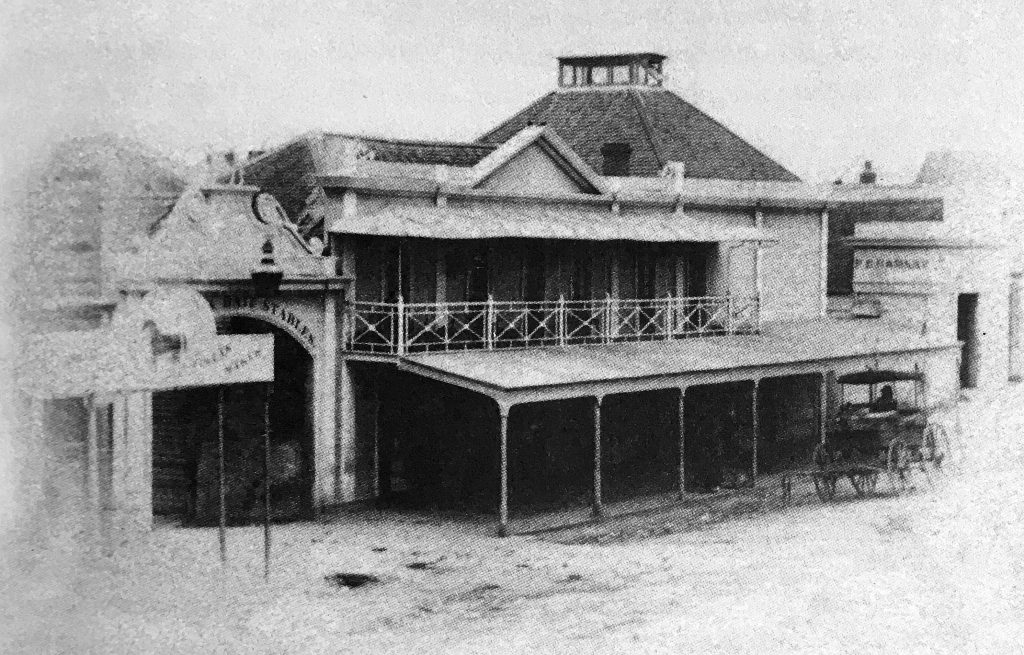
49-year-old John Duncan Fisher sells his popular Commercial Hotel in Ford Street to 40-year-old Thomas Tanswell (former owner of the Empire Hotel in Bright). While Tanswell continues to run the popular hotel, he begins to make plans to demolish the double-storey wooden building and draws up his own design plans for a grand, stone and brick hotel building to replace it. Three years later, on October 1st 1873, the new hotel will be opened (and will remain in the Tanswell family until 1967). The newly built Commercial Hotel will feature French doors, a richly gilded crest on the front window and decorative iron lacework on its verandah (below). As well as buying the Commercial Hotel, Thomas Tanswell will also purchase the adjoining coaching offices, along with Fred Dreyer’s former Freemasons’ Arms hotel building at the rear – which fronts onto High Street – meaning that Tanswell now owns a square block of land in the centre of Beechworth – with frontages to both Ford and High Streets! The old Freemasons’ Arms building on High Street will later be converted into a school, run by Tanswell’s eldest son Thomas Jnr and his wife Margaret. (see entry in 1885)
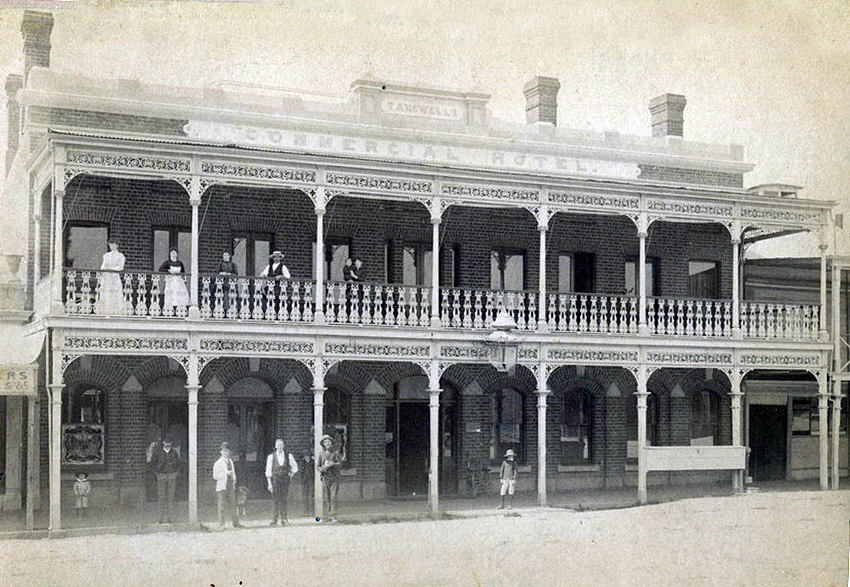
| It would appear that Ned Kelly and members his family and his gang patronised the hotel. Thomas Tanswell was certainly a supporter and is known to have visited Ned Kelly in the ‘Melbourne Gaol’ whilst he awaits execution. ‘Tanswell’s Commercial Hotel’ still stands today and is one of Beechworth’s four remaining central hotels, along with the ‘Hibernian’, the ‘Empire’ and the ‘Nicholas’, as well as the ‘Grand Oaks Resort’, up the hill from central Beechworth at Mayday Hills. |
1870
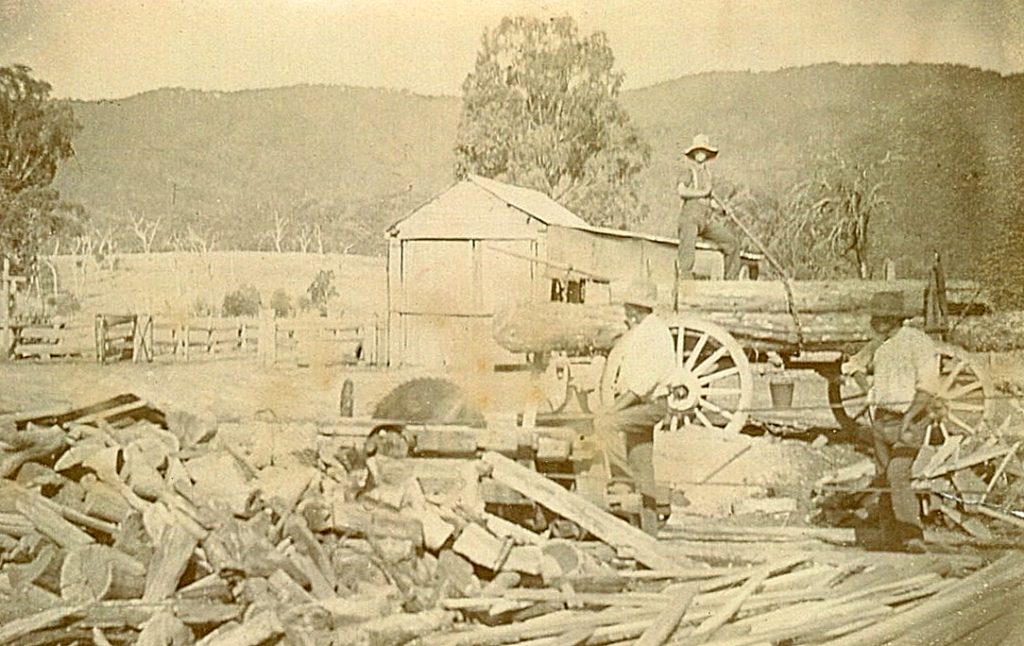
The settlement of Bowmans Forest – 10km south of Beechworth – is now a thriving community, following the establishment of a school in 1865 and local shops along the ‘Ovens Track’ (now the Great Alpine Road). It is at a junction of the traditional track to ‘Fisher’s Crossing’ on the Ovens River (perhaps the same one Hovell and Hume used) since there is no bridge. The Bowmans Forest shops include the Hands and Morris Store, Maria Davis’ Dress Shop, John Balty’s Butcher Shop along with Charlie Williams Blacksmith Shop and the nearby Shannon’s Hotel and Mummery’s Hotel. By 1888 Bowmans Forest is listed in the North-East section of the “Victoria and Its Metropolis” book as one of the “small townships of the ordinary up-country type”.
| Sadly, the decline of school-aged children and the location of the railway line further along the ‘Ovens Track’ will eventually spell the end of the township. Today there is little evidence of the Bowmans Forest settlement because most of the buildings were located on road reserves and therefore had no title, making them impossible to sell as going concerns. And the advent of World War One creates a shortage of building materials and many existing structures are soon pulled apart for construction elsewhere. |
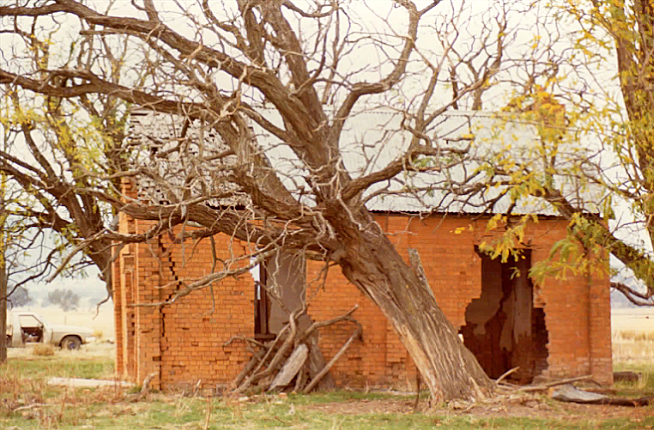
1870
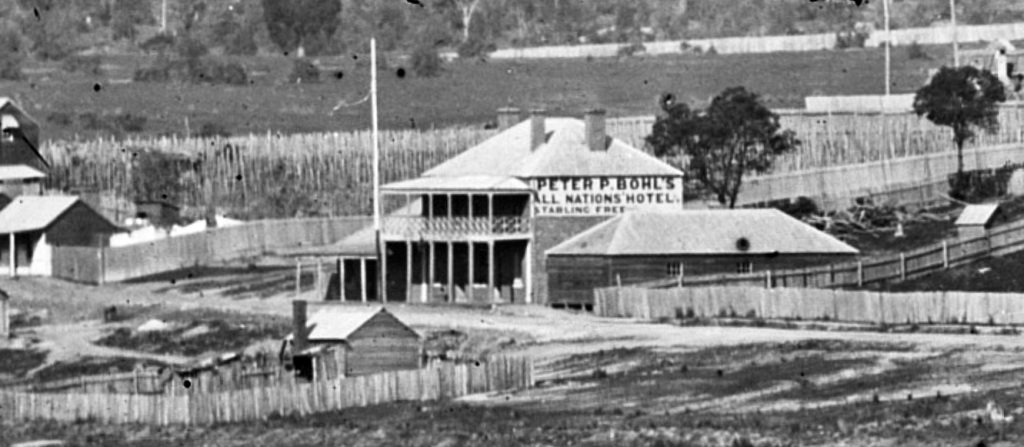
Peter Petersen Bohl establishes the All Nations Hotel on (what is now) the Old Stanley Road at Spring Creek. A fine two-storey building with an attractive verandah, it comprises a bar, two sitting rooms and three bedrooms.
| In March 1872 Peter Bohl is charged with “permitting dancing in a building within the same enclosure as a licenced house without the permission of the licensing bench”. Bohl is let off and the matter is not pursued further. |
1870 – May
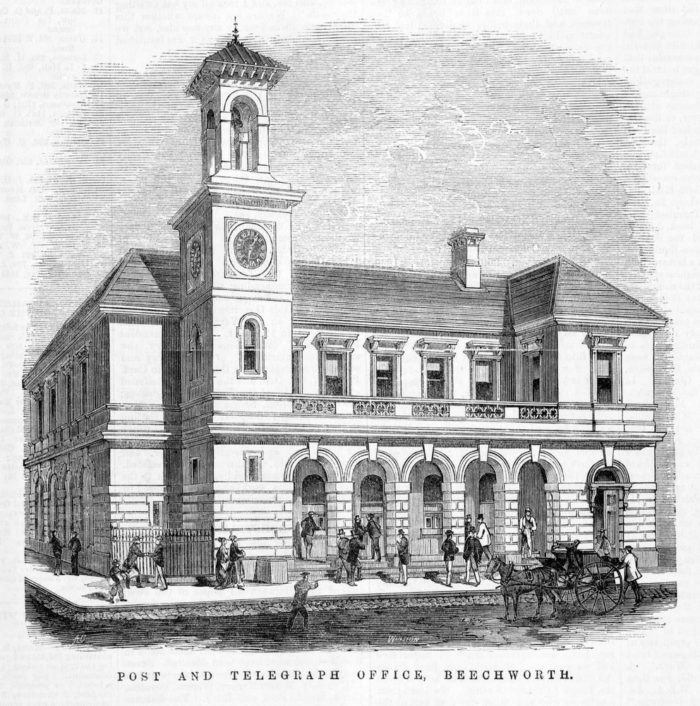
The new Beechworth Post and Telegraph Office is open for business. The new building incorporates the original 1865 granite tower and other materials that are left standing following the ‘Great Beechworth Fire’ of 1867. The new, larger double-story Post Office, an Italianate structure designed by architect Peter Kerr, is unusual in that it consists of a new building being added to an existing tower, rather than the other way around. The new Beechworth Post Office features a private residence on the first floor. A cast iron verandah over the first floor balcony will be added in 1874.

| As well as the existing clock tower, the new Post Office now features a colonnade on the ground floor and a balcony above with slender columns facing Camp Street. In July 1926 a drinking fountain will be installed outside the Post Office in honour of leading Beechworth citizen James Warner. The unique iron drinking fountain (above) features four water spout outlets in the shape of lion’s heads, and is operated by a foot pedal. |
1870 – May

As the new Beechworth Post and Telegraph Office opens (having been rebuilt following the ‘Great Beechworth Fire’ of 1867), a new hotel is also constructed on the site of the destroyed Empire Hotel (two doors down from the Post Office). The new hotel is named The Post Office Hotel with 40-year-old William Thompson Soulby in charge.
1870 – Jun 5
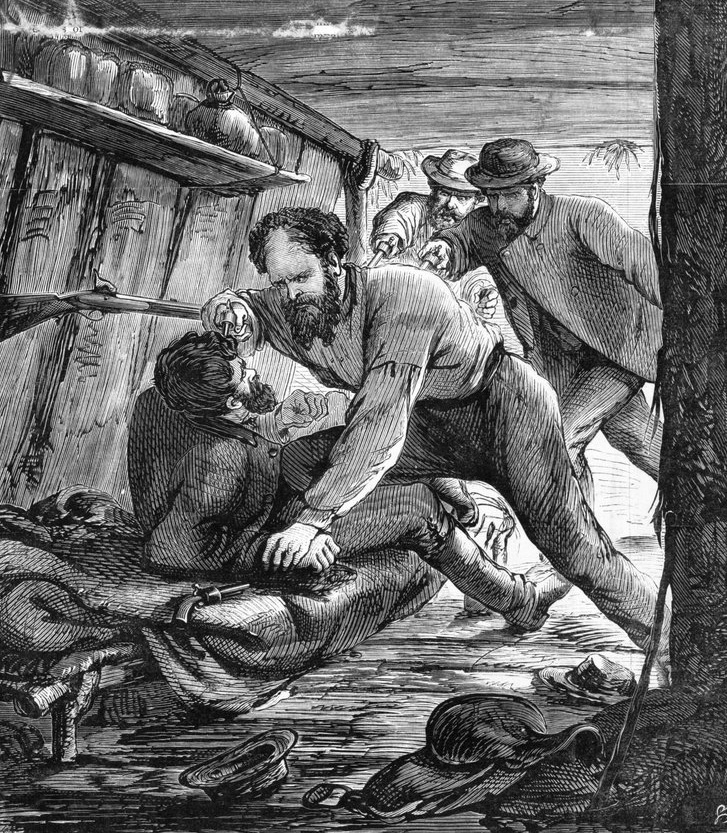
Bushranger Harry Power is captured in the King River Ranges by Superintendents Charles Nicolson and Francis Hare who, with Sergeant William Montford and a black tracker, surprise Power in his hide-out (‘Power’s Lookout’) overlooking the Quinn property on the King River. Power is brought to Beechworth where he is tried at the courthouse and sentenced to 15 years at Pentridge Prison in Melbourne. The cell in which Power is held in Beechworth is open for display to the public today. Power is thought to have been responsible for 80 more armed hold-ups in the area than all the Kelly’s put together!
| After accounts of his ill health behind bars are reported in ‘The Argus’ newspaper in 1877, 57-year-old Harry Power will be released from Pentridge on the application of several women, including Lady Janet Clarke. He works on the Clarke property ‘Rupertswood’ at Sunbury until, in early 1891, he becomes a guide of the former prison hulk ‘Success’ (on which had served an earlier sentence) which is now a museum. On October 11th 1891 his body is found in the Murray River at Swan Hill after apparently drowning while fishing. |
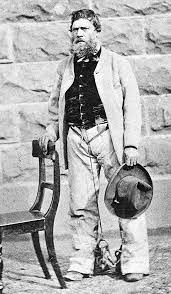
1870 – Sep

Beechworth experiences its heaviest rain and floods since gold was first discovered, with most creek claims washed out. As lots of tailing accumulations are washed away, the tail-races are therefore cleared.
1870

Burnbrae Homestead is built at 13 Pritchard Lane, Sitting on just under one acre of land, it has a clear view onto the Newtown Falls and Newtown Bridge.
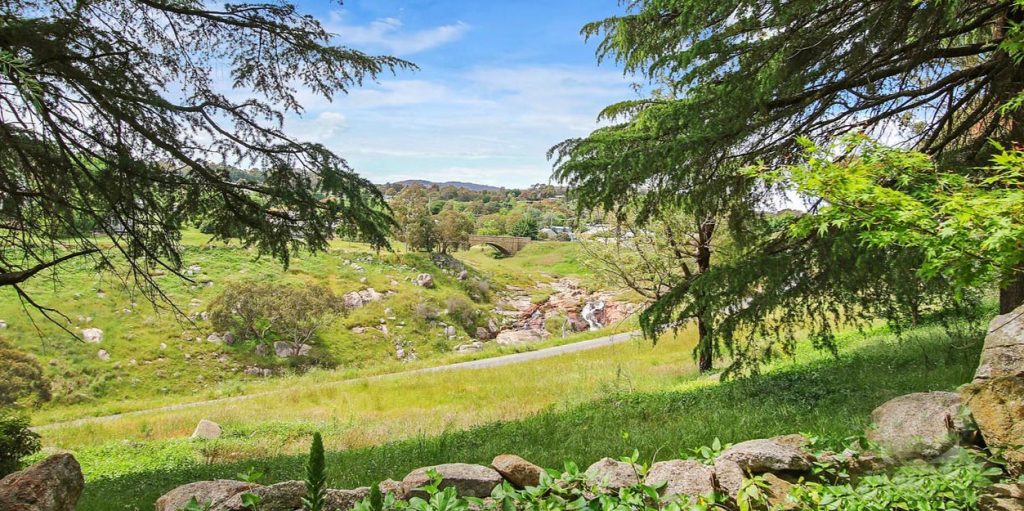
1870 – Sep 15
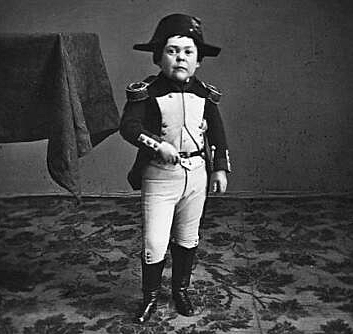
Celebrated American ‘midget’ – ‘General’ Tom Thumb (made famous by P.T. Barnum) – arrives at the Commercial Hotel in Benalla after narrowly escaping flood waters, almost swept away by a flash flood in a swollen creek at Baddaginnie. A few weeks later, 38-year-old Tom returns to North-East Victoria with his touring troupe as part of the Barnum & Bailey Circus “Round the World” tour, with Beechworth hosting the circus for three evening shows and two matinees at the Star Theatre. The performances include sketches with Tom Thumb dressed as different famous historical characters including Napoleon (above). The shows prove immensely popular, with one session performed to a crowd of over 600 people crammed into the theatre.

| By his 30s, Tom Thumb – real name Charles Sherwood Stratton – stands just 2 feet 9 inches tall (90cm). As a child, Stratton appears twice before Queen Victoria and the three-year-old Prince of Wales, the future King Edward VII. Stratton’s fame grows at an astonishing rate, and his popularity and celebrity surpass that of any actor within his lifetime. He amasses a fortune before his sudden death in 1875 at the age of 45. |
1870 – Nov 11

Having escaped a prison sentence at the Kyneton Courthouse on June 3rd for ‘Highway Robbery Under Arms’, 15-year-old Ned Kelly is now incarcerated – for the first time – in Beechworth Gaol after being found guilty of “assault on the person of Jeremiah McCormick and insulting behavior and using obscene language to Jeremiah’s wife Margaret McCormick” that had taken place on the 30th of October. Ned is sentenced to three months gaol for the ‘offensive behavior’ charge and fined £10, in default three months gaol, for the ‘assault’ charge but, as Ned is unable to pay the fine, this means a full six-month gaol term in Beechworth. In addition, he is ‘bound over to keep the peace’. In a startling coincidence, Ned begins his gaol term in Beechworth the day after his November 10th trial in Wangaratta … and 10 years later, to the day, he will be executed on November 11th 1880.
| Released on March 27th 1871 – five weeks early on good behaviour – young Ned returns to the family home in Greta, but is again imprisoned in August that year for three years on a charge of receiving a stolen mare. He spends 18 months doing forced labour in the area before being sent to ‘Pentridge Prison’ after another fracas. |
1870 – Dec 26

‘William’ Tsze Hing passes away at the age of 35. He had run his popular store on Spring Creek for many years, selling beer, wine and Chinese spirits (which include cinnamon and citron). He is often called upon at various courthouses in the region – including the Beechworth Courthouse – to act as a go-between and interpreter for the local Chinese community. Much respected, he is invited to join the Beechworth Oddfellows and the Freemasons. Born in 1835, in Guangdong, China, he marries Kezia Elizabeth Wallis in Beechworth, and they have two sons and a daughter. He is buried at the Beechworth Cemetery (above).
1871
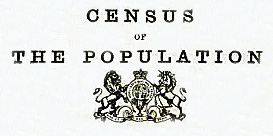
The national government census reveals that the greater Beechworth Shire has 2,192 Catholics, out of a total population of 9,581, just 23 per cent. The census, taken at 10-year intervals, will go on to show the slow and steady decline of Catholics in the district, until 60 years later when both the above figures have been exactly halved.
1871 – Feb
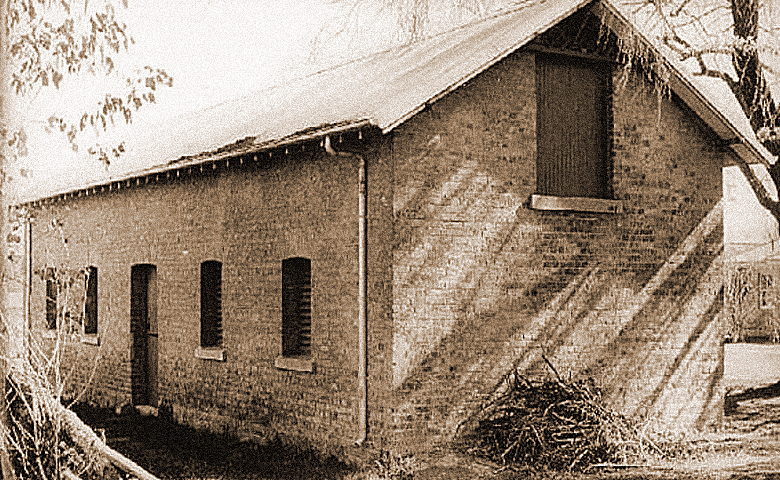
At a final cost of £489 and 7 shillings, construction is completed on the new brick Police Stables on the Police Reserve. Built by Beechworth contractor Lewis Griffiths, the solid building still stands on the reserve today.

| After the building is no longer required for the stabling of police horses, it is used by the Beechworth Police as a storage area. After eventually falling into disrepair, it is restored in 1975 – including the replacement of its slate roof with corrugated and galvanised steel sheeting – and continues being used as storage space for the Beechworth Police Station next door. |
1871

Mulberry Cottage is built at 74 High Street, directly opposite the newly completed Police Stables. The cottage’s terraced rear garden leads directly down to Spring Creek (below).

1871
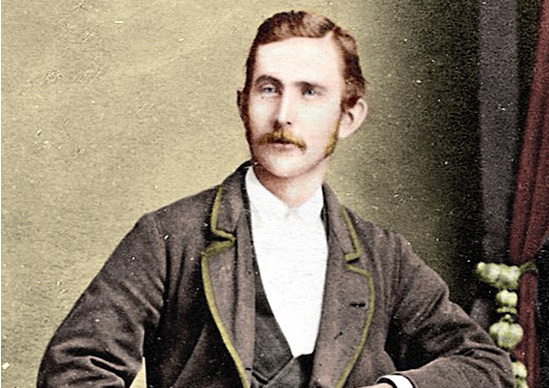
After the death of his father (Patrick ‘Paddy’ Byrne) at the age of 39 from heart disease, 15-year-old Joe Byrne has to spend more time helping to run the Byrne family’s dairy farm in the Woolshed Valley. However, to earn extra income, he also finds work as a ‘cart boy’ with the Ovens Tannery in Beechworth, as well as doing odd jobs for the Chinese in nearby Sebastopol. It is here that teenage Joe Byrne comes across a man called Ah Suey strung up outside a shop screaming for help. Days later, Ah Suey is found murdered due to debts he apparently owes to Chinese mobsters. Although young Joe appears as a witness in the trial of the two Chinese men charged with Ah Suey’s murder, he provides very little information, possibly due to fear of a reprisal, as the accused are apparently members of the ‘Triad’, a Chinese crime syndicate with branches all over the world.
| This will not be the only time Joe ends up in court thanks to his association with the Chinese (see 1873 entry). Joe spends much of his youth around the Chinese and learns Cantonese by ear and eventually speaks it almost fluently. He indulges in Chinese food and other cultural aspects including gambling and opium smoking … of which, for a time, he becomes addicted. |
1871 – Apr
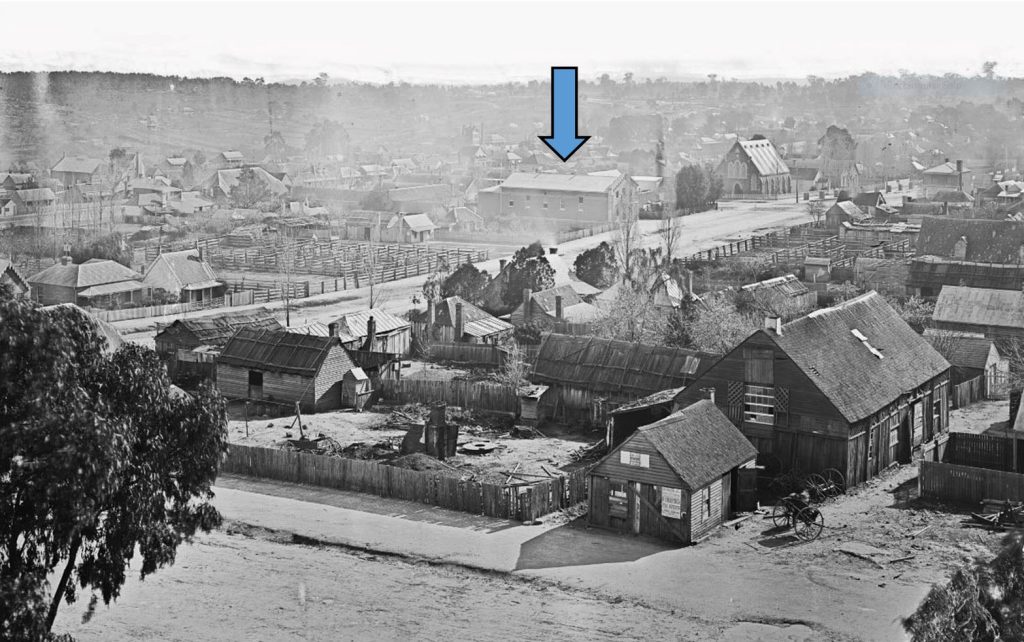
A fire breaks out at Melrose’s Ovens Bedding Factory at 11 Loch Street, next to J.H. Gray’s Cattle Sale Yards and two doors down from the land where the Oddfellows Hall will be built a few months later. Beside the factory is the home of John and Jeanette Melrose and their family. Frantic efforts are made to put out the flames using “pint pots, dilapidated cans, buckets, etc.” Despite this setback, Jeanette Melrose will continue to run the business for some time, even placing an advertisement for Melrose’s famous ‘genuine horsehair’ mattresses.

1871

An ‘airing yard’ (exercise yard) is opened at Beechworth Gaol. It can be viewed from observation towers to enable prisoners in solitary confinement to exercise in complete silence. One guard is able to watch over 12 prisoners during their exercise period.
| In 1957, a swimming pool for prisoners will be built in the ‘airing yard’ in the gaol. (The blue arrow in the image above points to the location of the swimming pool.) |
1871
Fiery Scotsman John Scarlett, secretary of Beechworth Council, is accused of bigamy. Although he is found not guilty, all the evidence seems to point to the fact he was guilty.
1871 – Jun 8

Another Earthquake! An earth tremor rumbles through Beechworth, where crockery and glassware are rattled. This follows short, violent quakes in Beechworth in 1858 and 1868. This tremor is also felt by citizens in Wodonga and Myrtleford, and even as far away as Deniliquin in NSW.
1871 – Jul 11

Another new hall for Beechworth! The Independent Order of Oddfellows open their new hall on Loch Street, near the corner of Camp Street. An inaugural ‘Oddfellows Banquet’ will be held a few weeks later on the first day of August. Built of brick, the Oddfellows Hall will eventually overtake the 1865-built wooden St. George’s Hall on Finch Street to become Beechworth’s centre of entertainment for the next 100 years, with live theatre and general entertainments of the day including Grand Balls and Dances. After Australia’s Federation in 1901 it will be renamed Federal Hall before further name changes in the 1950s and 1960s. The building still stands today (above).

| Established as the ‘Grand United Order of Oddfellows’ in England in the late 18th century, the ‘Australian Grand United Order of Oddfellows’ is established in Australia in 1848, with the first Grand Master of the Order being Brother James Reid (1794-1869). Following the 1851 separation of the Port Phillip District from New South Wales, the ‘Grand United Order of Oddfellows Victoria’ is created in 1854. |
1871

At the little settlement of Black Springs – 3 miles from Beechworth on the road to Wangaratta – 44-year-old James Price (above) purchases a large piece of land for £1 an acre, sinks a well and creates a thriving garden market to service the local inhabitants. Price becomes a popular sight in Beechworth where, every Saturday, he travels to sell his fresh produce in town.
1871
Beechworth’s successful pioneer goldminer, 42-year-old Donald Fletcher, becomes a member of the Beechworth Borough Council and is among the first to represent it after its amalgamation as a United Shire.
| Deeply religious, Scottish-born Fletcher is a member of the Beechworth Presbyterian Church from its foundation and, in his earlier years, officiates as a lay preacher. He will later serve as a deacon of the church and a Sunday School Superintendent. |
1871
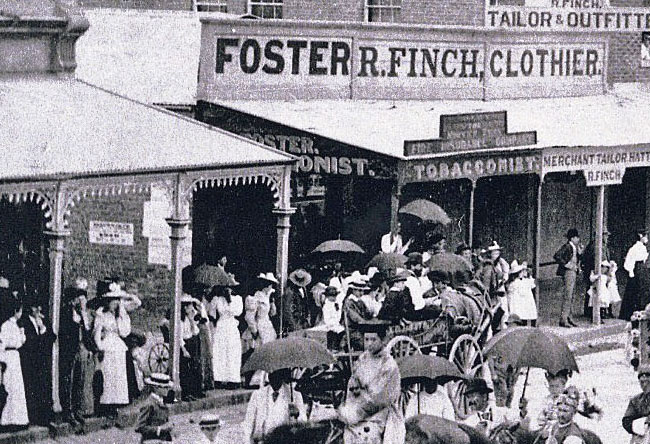
American George Judah Lyon sells his popular tobacconist and newsagency at 74 Ford Street to Alfred ‘Alf’ William Foster and his wife Sarah, daughter of a Jewish draper. In the 1850s Foster’s paternal grandfather, a Yorkshire man, had left his post as a police magistrate in Tasmania to bring his family to the Beechworth gold diggings.
| Foster’s Tobacconist Store stands on the corner of Ford Street and Criterion Lane, named after the ‘Criterion Hotel’ which stands at the other end of the lane on High Street. Later it will be renamed ‘Warren Lane’ after Richard ‘Little Dick’ Warren takes over Foster’s tobacconist store. Today the laneway is partly roofed and known as the ‘Marion Arcade’. |
1871
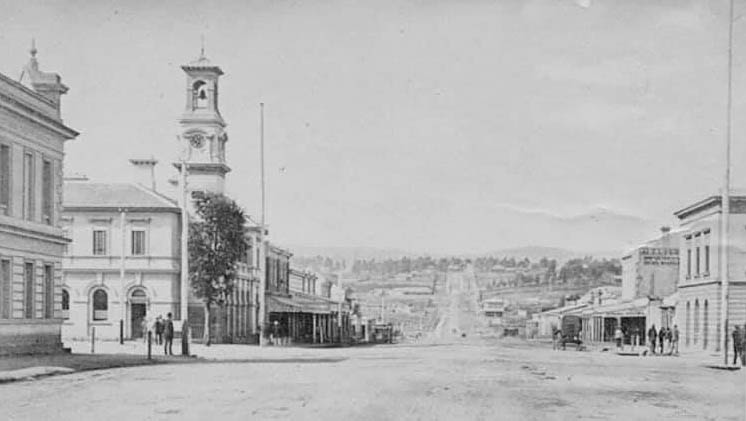
A single gum tree is planted on the corner outside the new Beechworth Post Office, just like the gum tree that had stood there on the corner in the 1850s and 60s.
| Note in the photo above, the gum tree stands alone as the only tree planted in the middle of town. But many more trees will be planted on the streets around town in the 1870s and most still flourish, giving Beechworth its reputation as a town admired for its beautiful trees, particularly in autumn when the golds and yellows of the leaves fill the streets with amazing colours. |
1871

With the opening of the new Beechworth Post and Telegraph Office in 1870, the Beechworth Telegraph Station moves its operations into the new building, and its former building at 92 Ford Street (above) is remodeled to become the District Survey Office of the Lands Department. The work is carried out by contractor James Kyle at a cost of £223. The building’s front verandah is added in 1900.
| In late 1999 the Lands Department relocates within Beechworth and the Telegraph Station will be refurbished to its original look and, in September 2001, is opened to the public as a place of historic significance with the building featuring exhibits of telegraph and surveying equipment. |
1871 – Aug 10
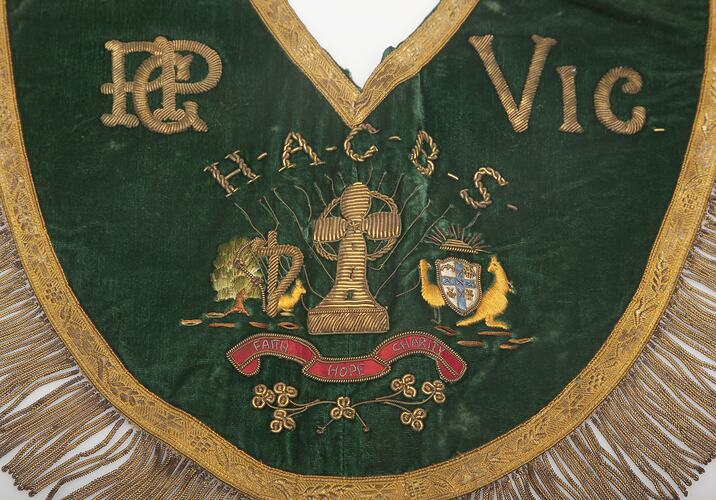
One of the first Hibernian Lodges in the North-East of Victoria is opened in Beechworth. The ‘Ancient Order of Hibernians’, founded in New York in 1936, are a fraternal and church-based benefit society which promotes the welfare of people of Irish birth or descent. The Beechworth Hibernian Lodge is strictly for male Roman Catholics and its chief purpose is to create a pool of money to cover medical and hospital fees incurred by its members.
| The Australian branch of the ‘Hibernian Society’ is founded in 1868 by Mark Young who runs the ‘White Hart Hotel’ in Ballarat. Young is very active in local affairs and assists fellow Irishmen by creating the ‘Ballarat Hibernian Benefit Society’ which later amalgamates with the ‘Australian Catholic Benefit Society’ to form the ‘Hibernian Australasian Catholic Benefit Society’ Like Beechworth’s Hibernian ‘Lodge of St. John’ opposite the Burke Museum, the original ‘Hibernian Lodge’ in Camp Street – strictly for Roman Catholic men – provides fellowship for the Irish in Beechworth who are far from their homes and families. |
1871 – Dec

John Connolly proudly promotes his patented ‘Mulled Ale’ and ‘Mulled Wine’ at his Shamrock Hotel on Camp Street.
1871 – Dec 29
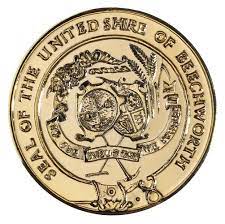
As Beechworth does not surmount the population threshold (to continue its separate municipal status), the ‘Borough of Beechworth’ and the ‘Shire of Beechworth’ are united to become ‘The United Shire of Beechworth’.
| The ‘United Shire of Beechworth’ (or the ‘Beechworth United Shire’) originated as two separate entities: the ‘Municipal District of Beechworth’ – first created on 23 August 1856, becoming the ‘Borough of Beechworth’ on 11 September 1863 – and the ‘Shire of Beechworth’, created on 27 December 1865 as a union of the Stanley (10 December 1862) and Wooragee (30 March 1863) Road Districts. The two entities merge on 29 December 1871, to form the ‘United Shire of Beechworth’. At its dissolution, it is the only local government entity remaining in Victoria which is styled as a ‘United Shire’, although many others are also the result of amalgamations. |
1872 – Jan 9
Following the December merger of the ‘Borough of Beechworth’ and the ‘Shire of Beechworth’, the first meeting of the newly named United Shire of Beechworth is held on this day.
1872 – Jan

Having taken over George Briscoe Kerferd’s Ovens Brewery and Malthouse at 4 Last Street in Beechworth in 1865, George Billson Snr now takes on his eldest son, 28-year-old George Henry Billson as a business partner at the Billson’s Ovens Brewery. Together, G. Billson and Son expand operations, and will soon select a new site for their brewery at 29 Last Street because it sits above a “pure natural mountain spring of exceptional purity that flows all the way from Mount Buffalo”. George Snr and George Jnr employ Chinese gold miners to dig a large round well, from which they can draw the spring water. The specific shape of the well comes from the Chinese superstition that evil spirits hide in the corners of square wells.
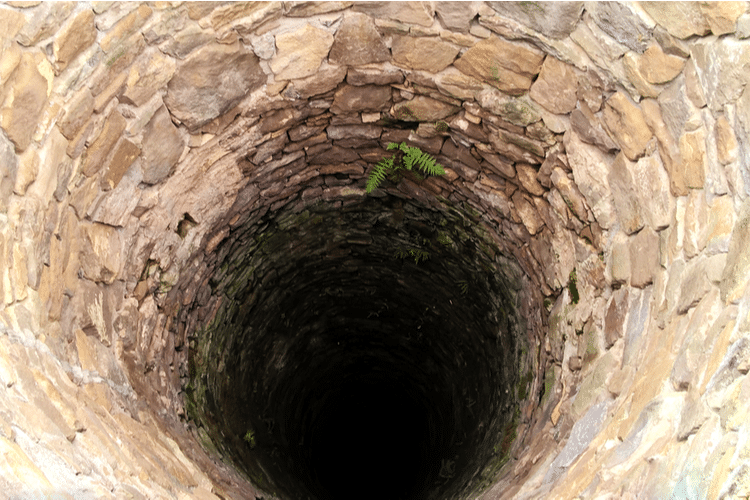
| This “Snowline” spring water has been used in Billson’s drinks ever since. The new site will soon feature a cordial factory, cooperage, and stables for the brewery’s horses. Most importantly, Billson and his son build a four-storey ‘tower brewery,’ a design which has only recently been adopted in Britain. The tower still stands today and is thought to the oldest surviving tower brewery building in Australia. |
1872 – Feb 24
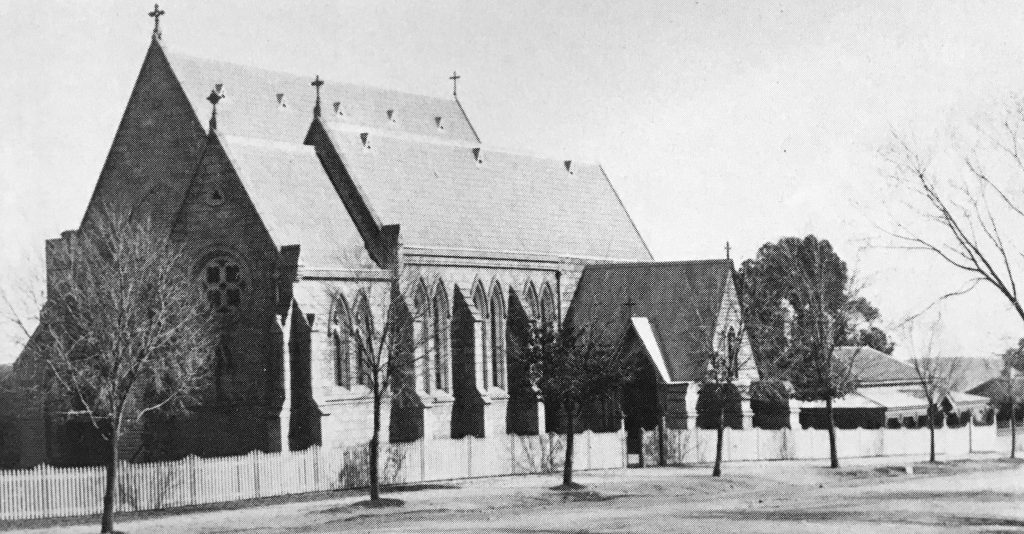
Beechworth’s St. Joseph’s Church at 9 Church Street is inaugurated and blessed by James Alipius Goold, the Bishop of Melbourne, and the following morning Dean Tierney celebrates Mass for a crowded congregation while the Bishop preaches a sermon. A choir, under the direction of Herr Schluter, renders the choral parts of the Mass. After the Mass, Confirmation is administered to nearly 200 children, to whom Bishop Goold speaks at length. The collections for the day amount to £200.
| In 1871 the Beechworth Shire has 2,192 Catholics out of a total population of 9,581 – just 23 per cent. The census, taken at 10-year intervals, tells the story of the slow, steady decline until 60 years later when both these figures have been exactly halved. |
1872 – Mar 11
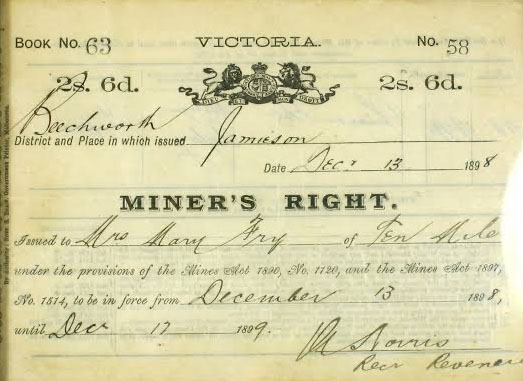
As the number of people digging for gold continues to dwindle, local businessmen realise that unless new discoveries of gold are made in the district, the future and growth of the town could be doomed. So on this day, the Beechworth Prospecting Association is established to promote Beechworth to potential gold seekers and encourage new gold prospectors to come to the district, believing that this will keep Beechworth a viable and profitable township.
1872
A ratepayers’ list of the Woolshed goldfields shows just 130 persons remaining at the diggings, of whom one third are Chinese.
1872 – Mar 30
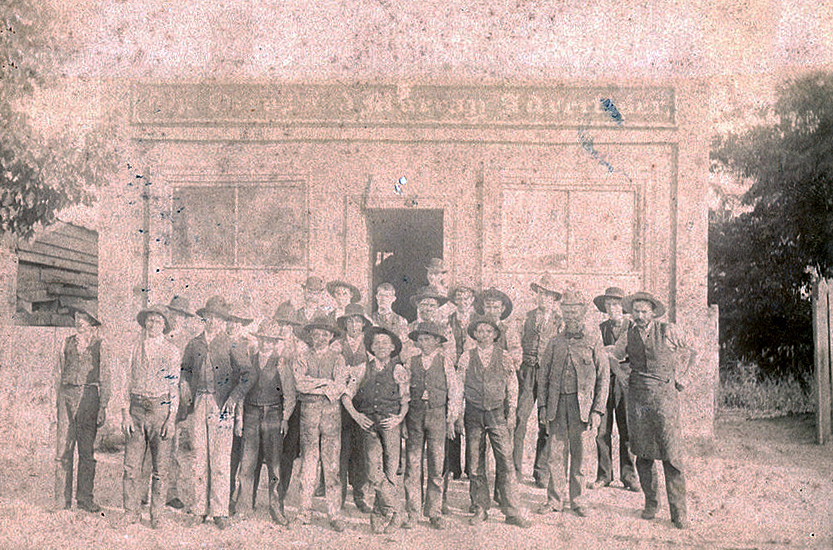
Two years after the Telegraph Station relocated to the new Beechworth Post and Telegraph Office, they announce they are now able to receive news from overseas with the completion of international telegraph lines. This promises communication with Europe within a matter of hours and, with the prospect of more overseas news available quickly, the Ovens & Murray Advertiser responds by converting to a daily newspaper the following week.
| This rapid conversion by the newspaper is a bit premature as the overseas telegraph suffers a range of early problems and will not be fully operational until October 22nd. |
1872 – Apr 8

The first flogging at the Beechworth Gaol takes place when a Chinese man, convicted of indecent exposure, is secured to a large wooden triangle and seventeen lashes are applied to his exposed back by a fellow prisoner. The flogging is considered distasteful by all concerned and when the time comes for a second series of lashes in Beechworth, there are no local volunteers to carry out the task, so the victim is sent to Melbourne where Victoria’s official ‘Hangman’ and ‘Flagellator’ – William Bamford – will take the responsibility.
1872
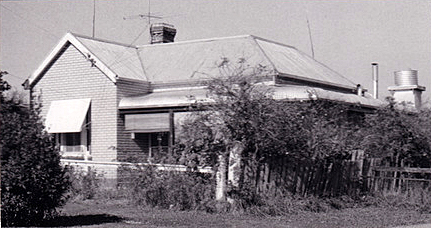
John Clements, who had established his store on High Street in 1866, builds his new home at 10 Mellish Street in Beechworth. It still stands today.
1872 – Jun 1
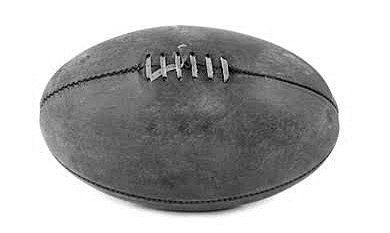
Founded in 1861, the Beechworth Football Club finally plays its first ‘formally recognised’ match. The Saturday afternoon game is between ‘The Natives’ – native-born men – and ‘The World’ – men from anywhere else!

1872 – Jun 3

55-year-old George Billson Snr officially relaunches the Ovens Brewery and Malthouse business as Billson’s Brewery at its new home at 29 Last Street. In the presence of around 100 guest and visitors, Eliza Billson – the new wife of 28-year-old George Billson Jnr – stands back while the new steam engine at the brewery is started, before cracking open the traditional bottle of champagne, officially christening the newly renamed brewery.

| Alfred Arthur ‘Bosher’ Billson, who will take over his father’s brewing business in 1881, will commission a grand new two storey structure for the brewery in 1889 which will be completed by 1895. |
1872 – Jun

Beechworth pioneer 41-year-old George Briscoe Kerferd is appointed Solicitor-General in the newly-elected Victorian Government led by James Goodall Francis.
1872 – Jun 12

The famed English novelist Anthony Trollope pays a visit to Beechworth whilst travelling through the area with his wife and their cook on their way to visit the Trollope’s younger son, Frederick, who is a sheep farmer near Grenfell in NSW. Among the 57-year-olds best-known works are a series of novels collectively known as the “Chronicles of Barsetshire”, which revolve around the imaginary county of Barsetshire. He also writes novels on political, social, and gender issues, and other topical matters. In 1851, Trollope had been employed to investigate and reorganise the entire rural British mail delivery system in south-western England and Wales. The two-year mission took him over much of Great Britain, often on horseback and he described the assignments as “two of the happiest years of my life”. Trollope is also famous for introducing the ubiquitous ‘Pillar Box’, the large red mail box that quickly becomes a fixture in towns all over England, and then throughout Australia, including Beechworth (below).
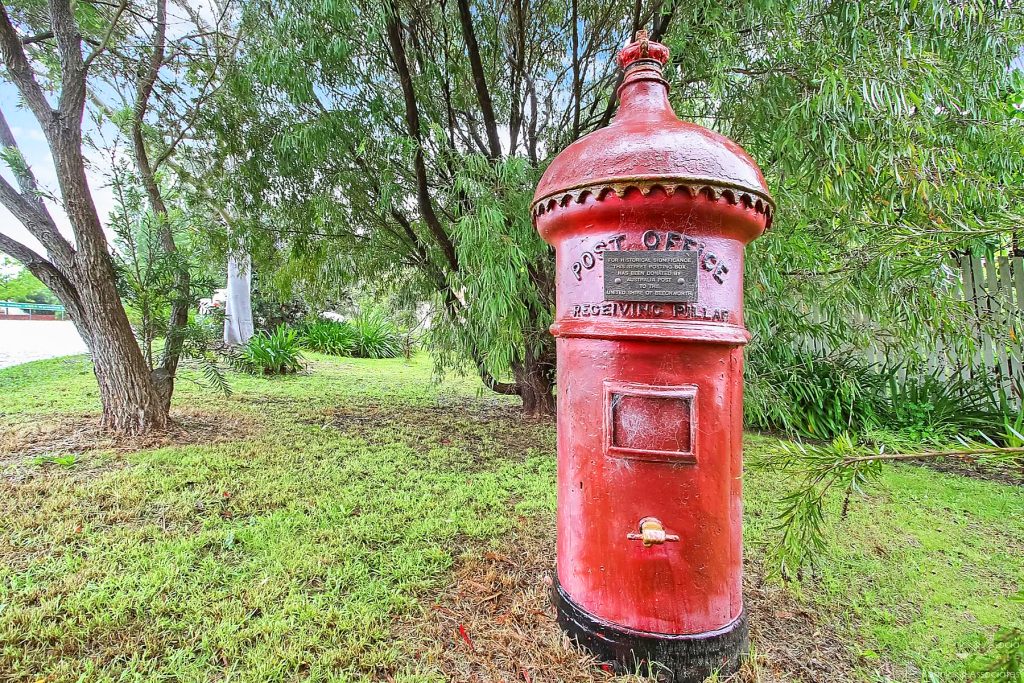
1872 – Aug 6
One of Beechworth’s best known coach drivers, Henry ‘Harry’ Ray, passes away. He had been injured three years earlier in an accident at Tarrawingee – when a coach wheel ran over his head causing brain damage – and he had never fully recovered. As the railways begin spreading out into country areas, the great days of the coach and horses in the North-East are drawing to a close, and many Beechworth residents see the death of ‘Harry’ Ray as the passing of an era, as this follows the recent passing of two of the town’s other best-known drivers in the previous eighteen months – ‘Tommy’ Hoyle and J. Morten Kelly.
1872 – Aug 10

Beechworth records its coldest morning since white settlement, getting down to minus 10 degrees with snow blanketing the town.
1872 – Aug 22
A public meeting of Beechworth residents is held in the Beechworth Town Hall for the purpose of taking steps to organise a ‘Beechworth Exhibition’ to showcase the arts, manufactures, and natural products of the district, and to secure the proper representation of those districts at the Melbourne and London International Exhibitions. A committee is appointed – with Frederick Brown as President – which quickly realises that the Beechworth Town Hall, first intended to hold the exhibition, will be too small for the purpose, and the committee secures the new hall on Loch Street belonging to the Oddfellows’ Society – “one of the most spacious rooms outside the metropolis” – for the purpose, the local branch of the order liberally placing it at their disposal, free of charge..
1872 – Sep 26
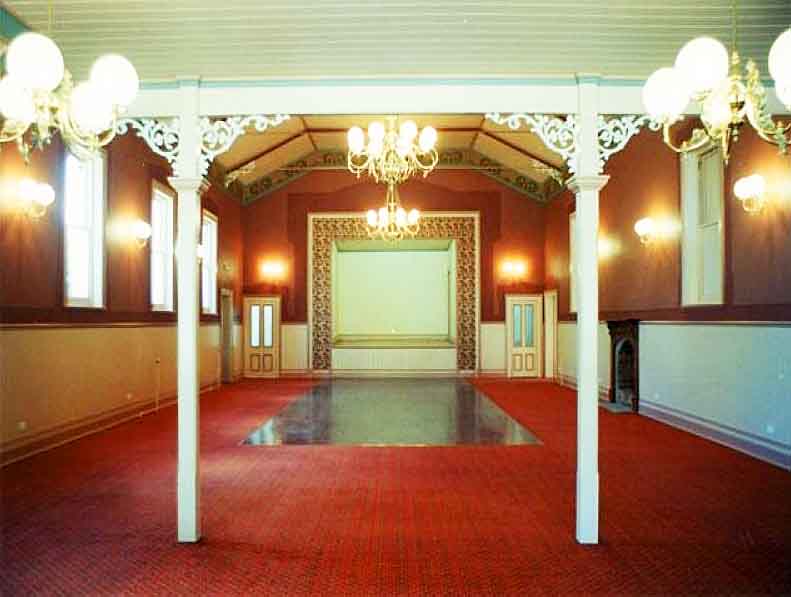
The opening of the six-day ‘Beechworth Exhibition’ at the Oddfellows Hall (above). The first day (a Thursday) is declared a holiday in Beechworth as hundreds turn out to view the locally made articles and exhibits of every description on display. By mid-morning sunny Beechworth is filled with “an unusually gay and festive appearance, owing to the crowds of well-dressed visitors that throng the principal streets with bunting displayed in considerable quantities”.
1872 – Oct 15

9 km from Beechworth, armed bushrangers hold up Mrs Gale at Wooragee Post Office/Store & Bakery, then go to the Wooragee Hotel (above) where they bail up and shoot the landlord, 39-year-old John Watt and a hotel patron, Mr. Kennedy (a pound keeper visiting from Albury). While Kennedy survives, John Watt – with a gaping wound in his side from the shotgun blast – clings to life for the next ten days, before finally succumbing to his severe injuries in hospital on Friday October 25th. He is buried in the Beechworth Cemetery (below).

| Before he dies, Watt identifies one of the bushrangers who shot him, and it is not long before four men are arrested – James Smith, Thomas Brady, William Hauppenstein and John Lewis – and charged with murder. An inquest into his death is held at the ‘Wooragee Hotel’ where the four men arrested will appear – with two of them – James Smith and Thomas Brady later found guilty of the shocking crime. Both men are hanged – side by side – at Beechworth Gaol for the murder on 12 May 1873. Bullet holes from the shooting at ‘Wooragee Hotel’ (above) remain in the front door of the building for the next hundred years! |
1872 – Oct 28

In the nearby town of Yackandandah, 150 children march through the streets carrying banners to celebrate the imminent opening of the new Yackandandah School. The new building, which officially opens on November 1st, consists of three rooms and is designed by architect James E Murphy.
1872

George Billson Snr and George Billson Jnr proudly announce that Billson’s Ovens Brewery’s popular ‘Best Ale’ – brewed with cherries – has been awarded a Silver Medal at a beer competition in New York. They will then enter the same beer – now renamed ‘Prize Ale’ – in the Victorian International Exhibition held in Melbourne from November 6th 1872 to January 16th 1873 where it will win a medal for First Place in the ‘Best Ale’ section of Exhibition (below).

| In 1879, the now 35-year-old George Henry Billson will leave the brewery partnership with his father (George Billson Snr) to pursue his own brewing career in Albury. Another of George Billson Snr’s sons, Walter Joseph Billson, will start his own brewing business at 674 Dean Street, Albury in 1894 and serve as Mayor of Albury from 1899–1900 and again in 1902. |
1872 – Dec 7
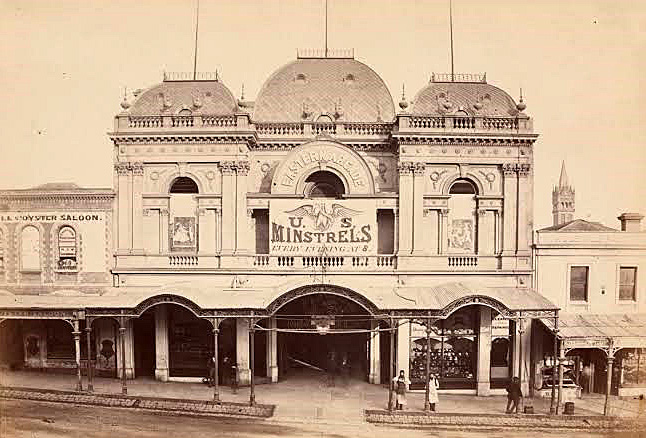
Successful Beechworth stagecoach ‘magnate’ Hiram Allen Crawford becomes the toast of the town when, along with his business partner Mr. S. Packham, he officially opens his mammoth Eastern Arcade in Melbourne. Running from Bourke Street through to Little Collins Street, it has been built on the site of the former Haymarket Theatre (destroyed by a fire in 1871) which is adjacent to the Eastern Market, established in 1847 as one the city’s major fruit and vegetable markets. Designed by architect George Raymond Johnson , the vast enclosed shopping arcade features 65 shops, with walkway areas in the centre which is covered by a roof of glass, with hotels at both the Bourke Street and Little Collins Street ends, as well as the ‘Apollo Hall’ entertainment venue which sits above the main entrance. The roof features three domes, the highest of which has an enclosed viewing area from where people can gain a spectacular view of ‘Marvelous Melbourne’. In 1877 Hiram’s younger brother, 25-year-old Alfred ‘Fred’ Galen Crawford, is appointed manager of the Eastern Arcade, having arrived from America in 1875. By the late 1800s the Eastern Arcade will become the heart of Melbourne’s Saturday nightlife.

| Just hours after Ned Kelly’s execution in Melbourne on 11 November 1880, the bushranger’s brother and sister – 21-year-old James (Jim) Kelly and 17-year-old Kate Kelly – are ‘exhibited’ at the ‘Apollo Hall’ – which seats up to 1,000 people – within the Eastern Arcade. Appearing before an excited, curious and fascinated crowd (who have each paid the one shilling entry fee), Ned’s siblings – along with Ettie Hart, sister of Kelly Gang member Steve Hart – speak about the infamous bushranger’s exploits. There is a story that suggests Hiram Crawford’s daughter Emma (born in 1857) was good friends with Kate Kelly (born in 1863). |
1873

Building of a new Baptist Church is completed and opens at 14 Ford Street, later becoming an ‘Assembles of God’ church as well as serving followers of the ‘Church of Christ’. The interior of the church is renovated around 2001 to become a private home, known as ‘The Old Church House’ (below).
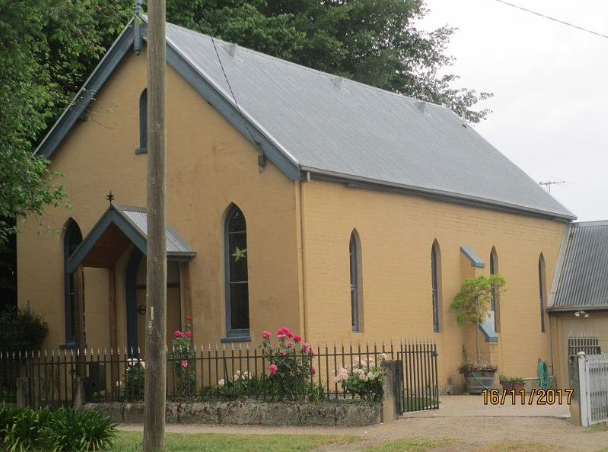
| The town’s first Baptist church services (then known as the ‘Disciples of Christ’) had been held in the tent of Beechworth pioneer James Ingram, and later in the weatherboard home that Ingram built. |
1873
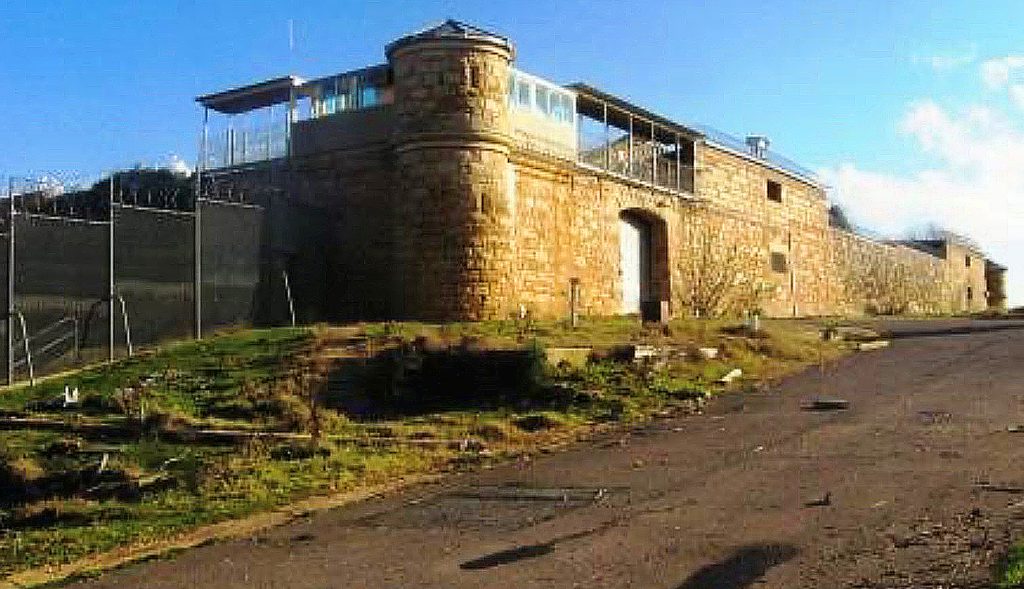
A Watch Tower is added to the perimeter wall of the Beechworth Gaol behind the North-Eastern cell block.
1873

Ned Kelly’s younger brother, 15-year-old James ‘Jim’ Kelly, is sentenced to five years at Beechworth Gaol for cattle duffing. While at the gaol, James meets future Kelly gang member 17 year-old Joe Byrne from the Woolshed who is serving time for assaulting a Chinese man. Byrne’s accomplice in the Chinese man’s beating is Aaron Sherritt whom Byrne will shoot in 1880 as an informer of the Kelly Gang.

| After his release from Beechworth Gaol in 1877, young Jim Kelly heads to Wagga Wagga in NSW where he steals some horses and is sentenced to ten years’ imprisonment. After his release he lives respectably (and crime free) for the remainder of his long life. His ten year sentence in NSW means that Jim is (fortunately) not around to become part of his older brother’s ‘Kelly Gang’ in the 1880s. Jim will pass away in Greta on December 16th, 1946, aged 87. |
1873 – Apr
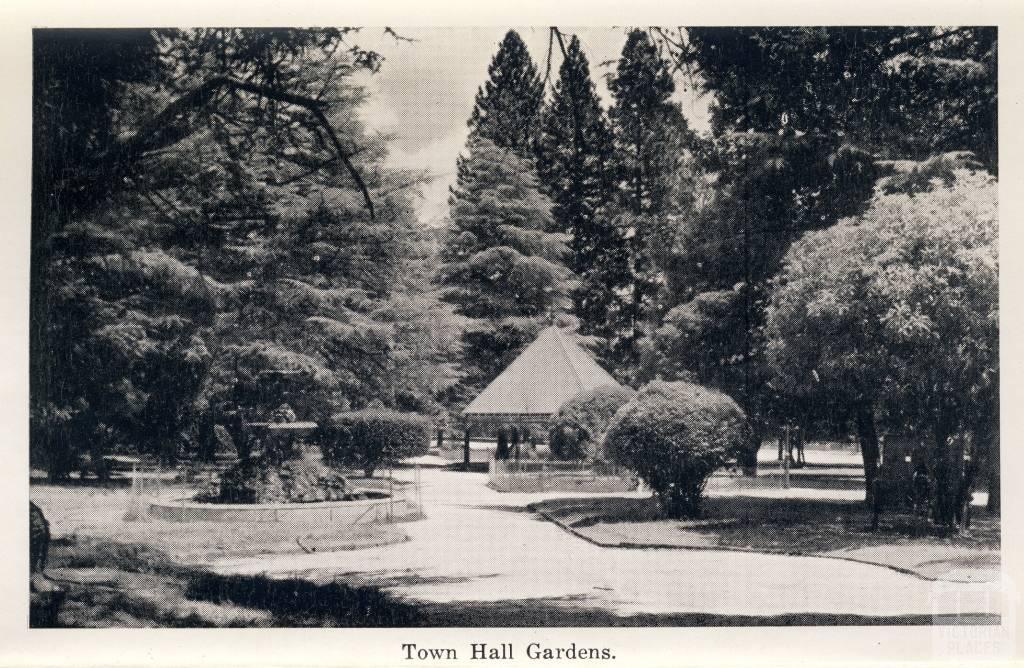
Beechworth Council decide to fence-in and plant a row of trees around the ‘Market Reserve’ next to the Town Hall. When completed, the area will be known as the ‘Town Hall Gardens’.
1873
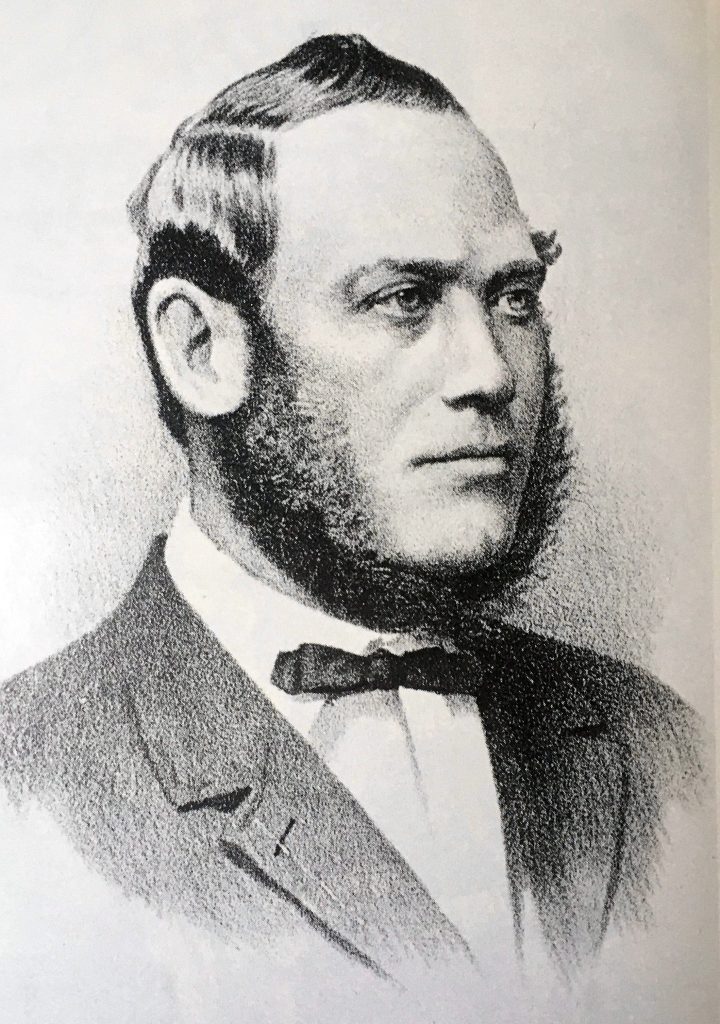
Scottish-born John Alston Wallace, the ‘Mining Colossus of the North-East’, is elected to the Victorian Legislative Council where he will serve until his death in 1901 aged 73. Upon his death, he leaves an estate valued at £121,350.
1873
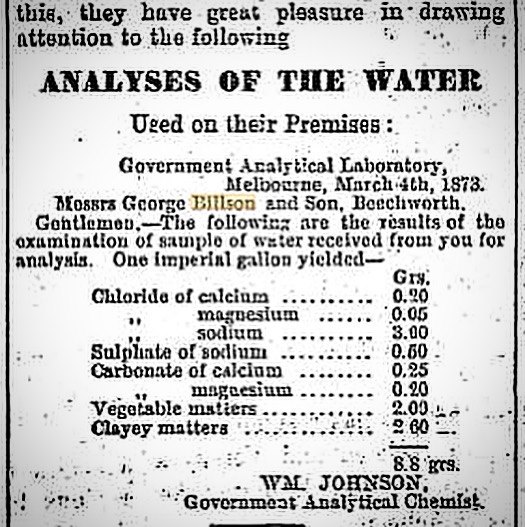
56-year-old George Billson is so proud of the natural spring water he is using at his Beechworth brewery that he commissions a government analysis of the water’s quality and publishes the results.
1873 – Jul 22
John Sitch Clark dies of gout and kidney disease at the age of just 45. Printer, publisher (The Ovens and Murray Advertiser) and publican (Beechworth’s Star Hotel), he invested heavily in property in the area after successful mining speculation. Clark is also a Beechworth Shire Councillor and a member of the local school board. He is buried at Beechworth Cemetery alongside his young wife and their son John Soulby Wells Clark who dies in 1875 aged 15, and their infant son Walter Clark who had died in 1858. John Sitch Clark leaves an estate valued at £5,656.
1873 – Oct 1
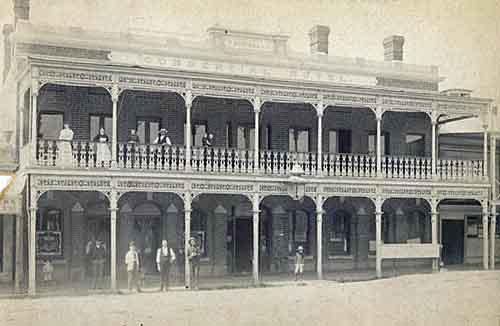
The newly rebuilt Commercial Hotel on Ford Street is officially opened by a proud Thomas Tanswell. The occasion is celebrated with a free lunch and drinks and, as this day is also ‘Cattle Sale Day’ in Beechworth, Tanswell (a former butcher, like his father before him) provides an exclusive lunch for all the butchers in the region in the hotel’s upstairs Ballroom. Tanswell’s rebuilt hotel is quickly compared to the top hotels in Melbourne of the time and is certainly the grandest hotel in Beechworth … so much so that the Governor of Victoria Major-General The Hon. Sir Reginald Arthur James Talbot will stay at the Commercial Hotel during his visit to the region in 1906. (It will not be until April 28, 1908 that the name of the hotel is officially changed to ‘Tanswell’s Commercial Hotel’.) Crawford and Connolly are now occupying the premises at the rear of the hotel. They specialise in coach building and stabling as well as running mail and passengers around the north-east of Victoria, at a time when a trip from Melbourne to Beechworth takes over 24 hours by coach.
| The current stables date from 1892, rebuilt after a fire and renowned as one of the largest outside Melbourne. The Victorian ‘National Trust’ will lease the stables and coach house building between 1969 and 1988, to run their ‘Carriage and Harness Museum‘. |
1873 – Oct 28

Construction is completed on the North-Eastern Rail Line from Melbourne to Wangaratta. The new line incorporates three substantial iron bridges over rivers and floodplains at Seymour, Benalla and Wangaratta and is initially built as a single track only. The railway brings new life to towns along the line, like Benalla, but the small settlements it bypasses, like Greta, decline. The tiny settlement of Glenrowan is basically created by a railway stop being included on the line to Wangaratta. By the end of the year the line will be continued from Wangaratta, through Chiltern and Barnawartha, and on to Wodonga at the end of the line. Because the North-Eastern railway does not extend to Beechworth, the town suffers a decline in its influence in the region.

| From the mid-1850s, the main road between Melbourne and Sydney has always passed through both Wangaratta and Beechworth, before heading to Wodonga and Albury. Stagecoaches run daily from Beechworth to Melbourne, Albury and Yackandandah. |
1873

Contracts are finally signed to cut a water race from Lake Kerferd into Beechworth, as well as contracts for the filter beds and settling dam. By Labour Day 1873, pipes have been laid from Lake Kerferd to the town, with Ford Street, Camp Street and High Street being the first to be connected. This work is completed in 1874.

1873 – Nov 12

‘The Carnival of 1973’ – To celebrate the 32nd birthday of the Prince of Wales, Edward VII, Queen Victoria’s eldest son, the biggest and most extravagant pageant ever seen on any of Australia’s goldfields is held in Beechworth. A huge procession of over 3,000 people begins at midday from the Market Reserve (now the Town Hall Gardens) including gaily dressed people, horses, carriages, and four marching bands. At the head of the parade are members of Beechworth’s Chinese community (see next entry). By the time the procession has reached the Public Recreation Reserve (now Baarmutha Park) over 10,000 people are there to attend a Charity Carnival which features a canvas dance floor, sideshows, food stalls, theatre performances and concluding at nightfall with a spectacular Chinese fireworks display.
| A number of German immigrants in the street parade wear armour that has been specially sent to Beechworth by the Crown Prince of Prussia. |
1873 – Nov 12

Over 250 Chinese lead the ‘Prince of Wales Birthday Carnival Procession’ down Ford Street. Dressed in the finest silks and Chinese decorations, they wave beautifully hand-painted Chinese flags and banners, play musical instruments and carry traditional military weapons. Yung Ah Jack – popular local Chinese interpreter – is the Parade Marshall.

| Born in Canton in 1844, Yung Ah Jack emmigtates to Australia at the height of the goldrush. On April 2nd 1872 he marries Charlotte Laster in at the Christ Church of England in Beechworth. They have four children – Frederick Walter, Alfred Edward, Louise Amy and Sydney Ernest. A fifth child, William, dies not long after being born in 1877. |
1874 – Feb
Four acres of the ‘Botanical Reserve’ are gazetted as a new school site. Described by the Ovens and Murray Advertiser as “a wilderness with a granite out-crop at the back, and a swamp at each side covered with dwarf wattle and ti-tree”, the new school’s headmaster – with the assistance of a gang of prisoners from the gaol – set about draining the swamps and blasting the rock. After raising a small amount of money from a concert, he then plants pines, cypresses, cedars and sequioas. Later, sections of the ‘Botanical Reserve’ to the south-east and north-east of the school are added to the school grounds, giving frontages to High Street and Sydney Road. The school’s sports oval is created in 1951.
1874
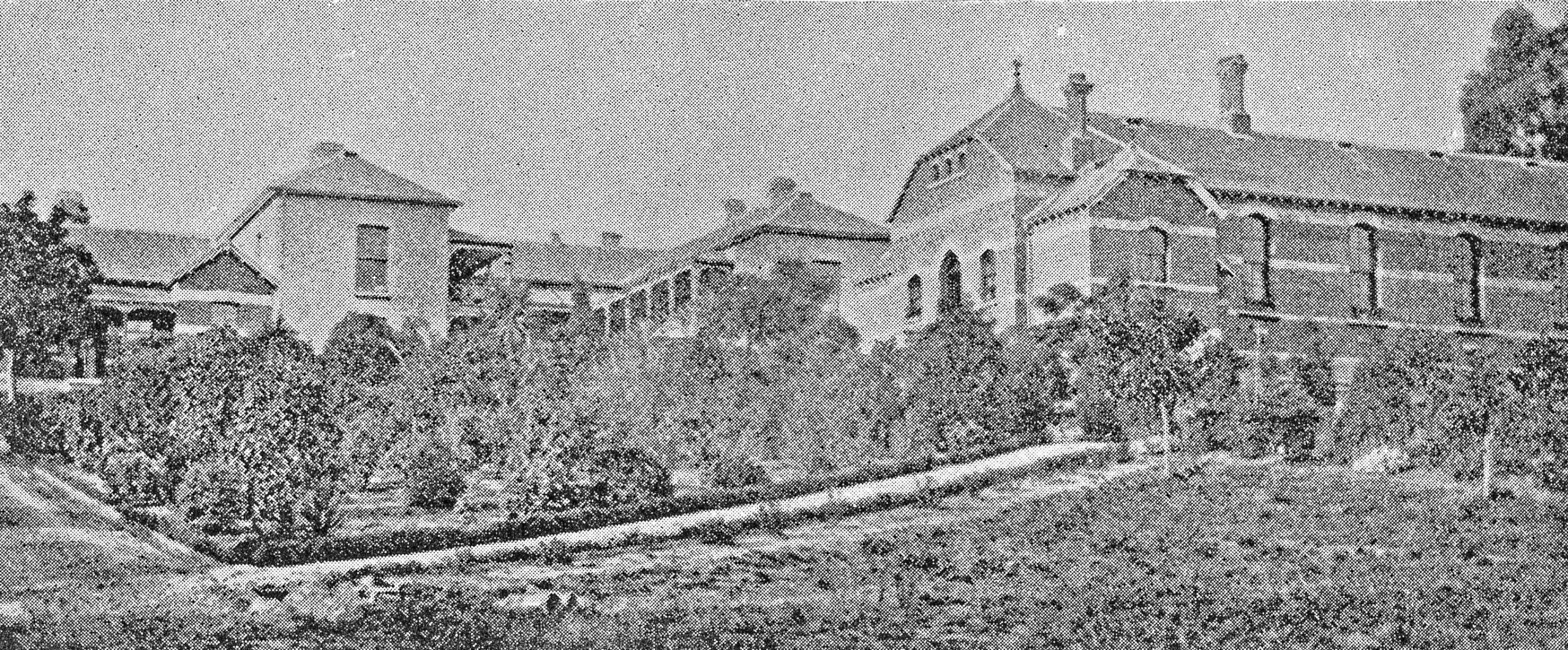
Sweeping ‘Hospital Gardens’ are laid out by Richard H. Jenkyns on the sloping grounds of Beechworth’s Ovens Goldfields Hospital. Planted with over 200 species of trees, including fruit trees, and shrubs, as well as colourful flower beds and orchards and kitchen gardens for food production. Cedars and Bunya pines flourish, which patients can view from the shelter of a new rotunda, with fences added around the large property to complete the beautification process. The following year Jenkyns will be commissioned to lay out the Beechworth Town Hall Gardens (see 1875 entry).
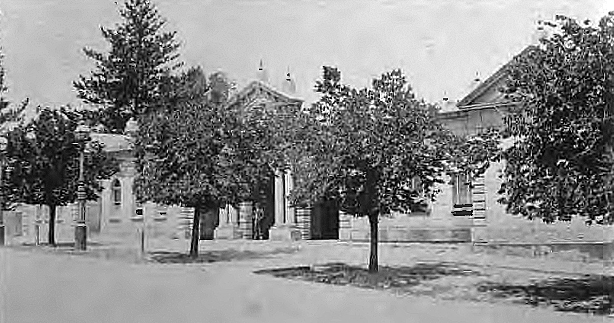
1874
One of Beechworth’s most notable (and notorious) locals at this time is John Phelan. A former Livery Stable owner, he has become the ‘Dog Pound Officer’ and ‘Shire Revenue Officer’. Phelan is a continual litigant, and regularly corresponds and complains to the local newspapers, where his official and officious escapades are often mockingly reported.
1874

Aaron Sherritt has a newly acquired selection near Sheep Station Creek at Sebastopol. Sherritt and his friend, 18-year-old Joseph ‘Joe’ Byrne, mark the boundary of the farm with a combination of post and rail, and wire fencing, and build a rough slab hut where young Joe Byrne will come to spend the majority of his time. Born at the Woolshed in 1856, Joe is the eldest son of Patrick (Paddy) and Margret Byrne (nee White).
| Aaron Sherritt is once engaged to wed Joe Byrne’s sister Katie. However, on the 26th of December 1879, Sherritt will marry another girl, 15-year-old Ellen Barry. |
| In the early 1870s, the teenaged Joe Byrne makes regular trips into Beechworth, becoming a regular visitor to James Ingram’s bookshop and newsagency, spending his time chatting with the Scotsman in the back room of his shop. Appreciating books and good conversation, Ingram finds him to be ‘a nice, well-behaved lad.’ The boy also likes to visit the Burke Museum and Public Library, where he wanders through the arched rooms of taxidermy and array of worldly artifacts, paying particular attention to the newly acquired Chinese items from a recent carnival. |
1874

42-year-old Frederick Allen purchases the Star Hotel on Ford Street in Beechworth from the estate of the late John Sitch Clark for £2,800.
| Born in Kent in England, Frederick Allen travelled by ship to Victoria in 1852 and, after several years of chasing gold at various locations including Bendigo, moves to Allans Flat where he opens a store, followed by taking over Yackandandah’s ‘Southern Cross Hotel’ in the 1860s, before relocating to Beechworth in 1872. He will run the ‘Star Hotel’ until 1890. In 1886 he will become part owner and proprietor of the ‘Spring Creek Brewery’. He is elected to the ‘Beechworth Shire Council’ in 1879 and remains there until 1888. He is married three times. He passes away in Beechworth on August 13, 1906 at the age of 73. |
1874 – Apr 2

Now Victoria’s Solicitor-General, George Briscoe Kerferd returns to Beechworth to officially open the valve and release the water from Lake Kerferd – recently completed in the hills above the town – that will be Beechworth’s new permanent water supply. The huge crowd – who have gathered to watch this momentous occasion – cheer as a hose held by Councillor Frederick Brown shoots water from the town’s new water supply high into the air … “as high as the top of the Post Office tower”! It is said that Councillor Brown also takes the opportunity to spray some water over those in the crowd who had criticised him over his infamous ‘Brown’s Folly’! (see 1857 entry)
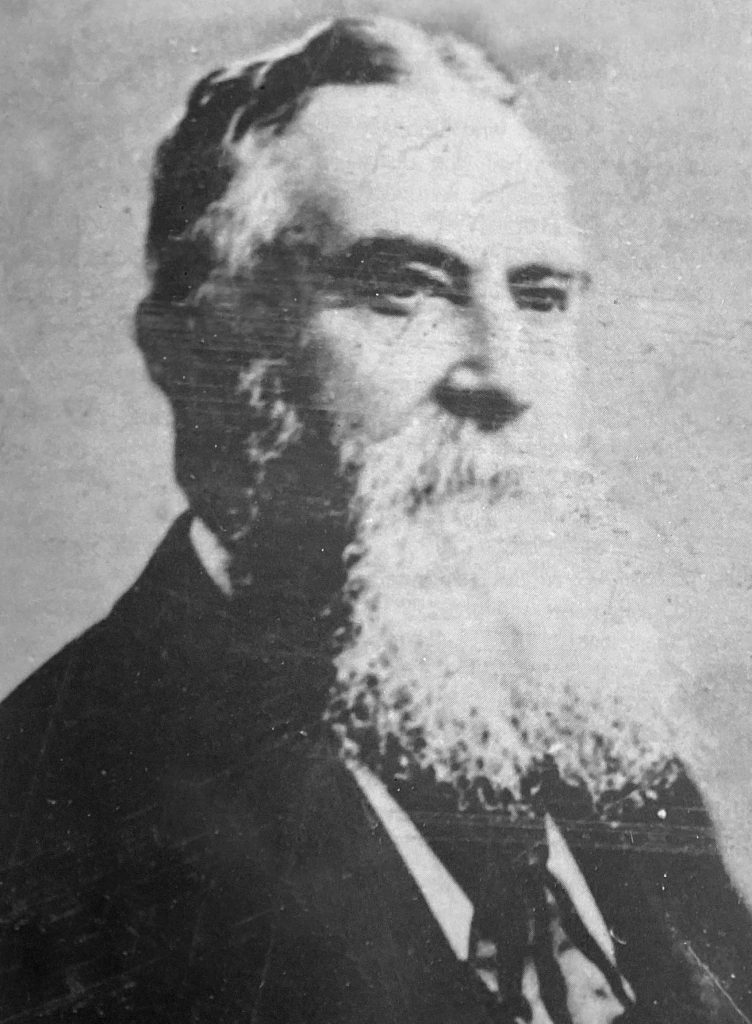
| Over the next two years the water is reticulated to the more remote areas of the town at an additional cost of £5,000. This is a great outcome for Beechworth but by the end of 1876 the Council is in debt by a staggering £30,489! |
1874 – Apr 2
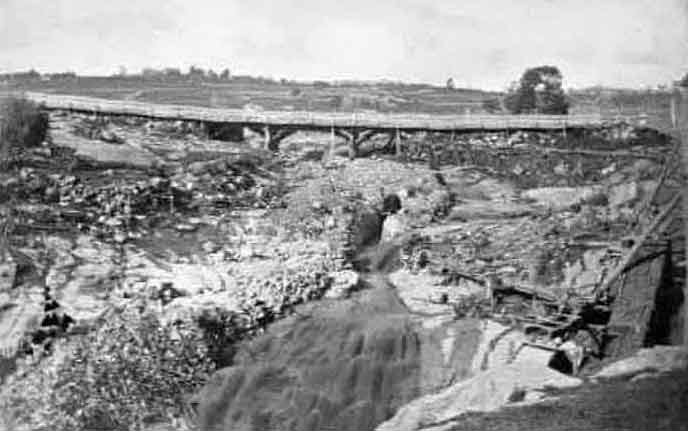
After Beechworth’s water supply is officially turned on in the centre of town, the official party moves down to Newtown Falls where the Foundation Stone for the newly announced granite Newtown Bridge is laid by George Verney Smith MLA (below). The original cost estimate is £3,897, but the government insists Beechworth Council reduce it – leading to construction being held up several times due to disputes over the costs – and it will not be completed until 1875, at a final cost of just £2,450.

1874 – Apr 3

The contract to build the Newtown Bridge is awarded to Beechworth Quarry owners Donald Fiddes and Co (Donald and his brother William) and construction officially commences after the Foundation Stone is laid. The Fiddess brothers quickly hire a number of fellow Scottish stonemasons, including John Morrison, who walks to the construction site at Beechworthevery day up the “Zig Zag Track” from his home in the Basin at Murmungee and then home again – a distance of 16 kms!
| Donald Fiddes and his Scottish stonemasons construct the bridge “like a pyramid” with no mortar used. Instead, they “key” the stones together perfectly, with one large “key stone” in the centre holding the bridge up. “It will be in service for 200 years!” the council proudly states. And yes, it still stands proudly today! |
1874
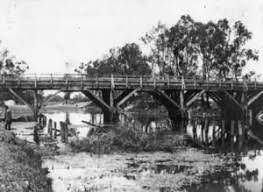
65km from Beechworth, a high level wooden bridge is built over the flood-prone Broken River at Benalla. It features a ‘Toll Gate’ at the western end. The ‘toll’ is abolished in 1878.
1874
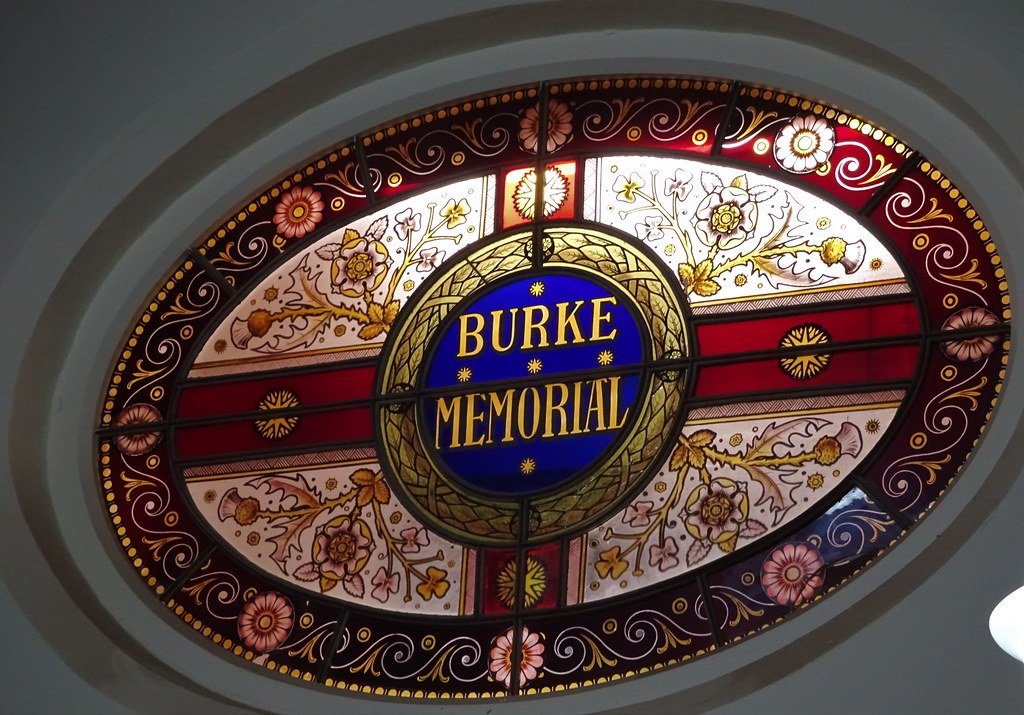
From a design originally submitted ten years earlier by John H. Guzner, the Principal of Beechworth Grammar School, The Burke Museum finally gains a unique stained-glass window. Made to Principal Guzner’s 1864 design by Ferguson and Urie of Melbourne for a reported £30 (roughly $8,000 today), the window features the Colonial Flag of Australia, the red Cross of St George, the White Rose of England, the emblem of New South Wales in gold within the red cross, the Thistle of Scotland, the Shamrock of Ireland and the Southern Cross in gold stars with the wording “Burke Memorial”. It contains a total of 24 stained panels held together with lead.
1874 – Jul 21

Beechworth pioneer George Briscoe Kerferd becomes the 10th Premier of Victoria and will serve in the role until August 1875.
| Kerferd had been elected to the Legislative Assembly for the Ovens in November 1864, and will represent the area continuously until February 1886. He begins studying law in 1864 and becomes Minister of Mines and Vice-President of the Board of Land and Works in the government of James McCulloch 1868, and Solicitor-General from 1872–1874, and Attorney-General in 1874 in the government of James Goodall Francis. When the Francis government is defeated in July 1874, Kerferd succeeds Francis as the head of a new conservative ministry which is elected 31 July 1874. Kerferd will serve as the Premier of Victoria until 7 August 1875 when his government is defeated. Kerferd is again appointed Attorney-General in later conservative governments – from 1875 to 1877, 1880 and again from 1883 to 1886 at which time he quits politics and on 1 January 1886 is appointed to the Supreme Court of Victoria. Kerferd serves as a judge until his death in 1889, aged 58. |
1874

The Poyntz family take over the Wooragee Hotel, a key ‘watering hole’ on the road between Beechworth and Yackandandah and the business soon becomes known simply as the Poyntz Hotel. Henry Poyntz – also known as ‘Shove-along Poyntz’ – and his wife Rebecca had arrived in Wooragee in 1861 with their four children. Henry also runs a local dairy and is famous for his ‘Wooragee Butter’ and grows Algerian oats. The Poyntz family remain licensees of the Wooragee Hotel until 1911 and it is then continued by his daughter Jane Goodger (nee Poyntz).
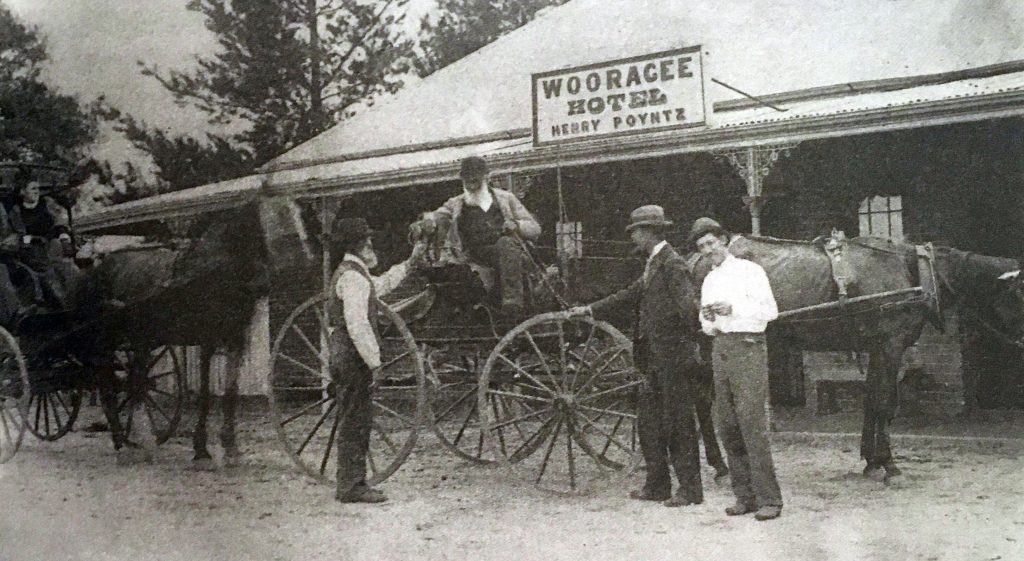
1874
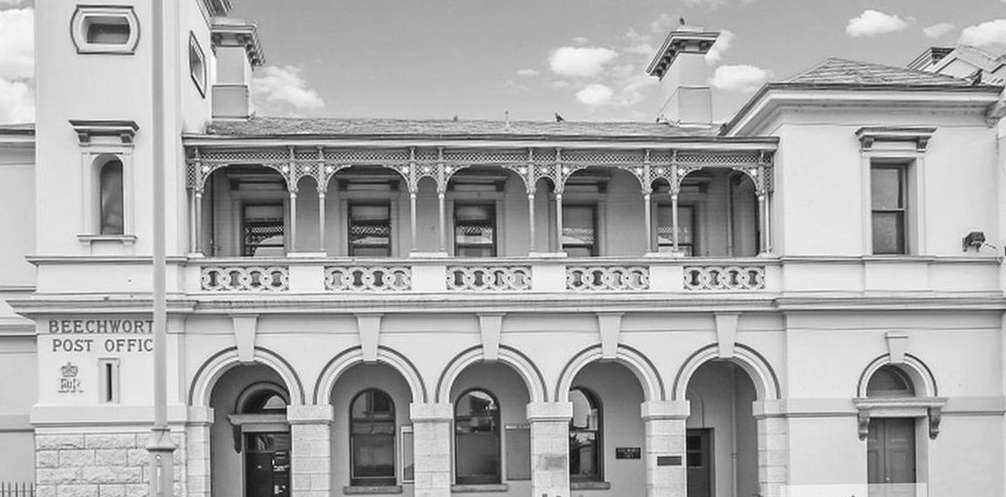
A cast iron verandah is added over the Beechworth Post Office first floor balcony. In 1902 another upstairs room will be added, the roof gabled to match the existing temporary gable, and the exterior is faced with cement.
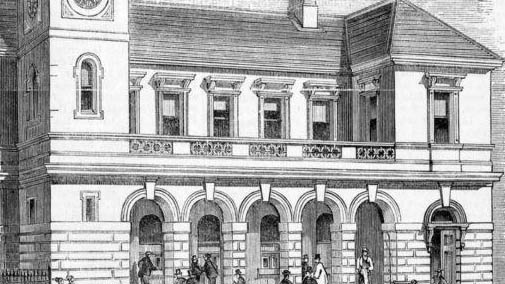
1874

Beechworth’s new and controversial Presbyterian Minister Robert Kirkwood Ewing is accused of living with his new wife even though he knows she’s a bigamist. Having been told by her minister in England that her first husband has died, 28-year-old Frances Sanden had proceeded to marry the 51-year-old Reverend Ewing in Beechworth (just 11 days days after his first wife Letitia Blakemore had died back in Tasmania), before being informed that the minister back in England had made a mistake and that her first husband has not died and is very much alive! According to law – and the standards of the Presbyterian Church – this means that Scottish-born Ewing should ‘spring apart’ from his wife Frances immediately. He refuses and it becomes a big issue, as Ewing is such a popular – although often outspoken – minister, and his many Beechworth parishioners at St. Andrew’s Church don’t want him dismissed. In fact, they say they are prepared to join him in a new church rather than lose him! He retains his position (by the skin of his teeth) but in 1877 he becomes embroiled in yet another controversy, when he’s accused of acting as a mining company manager and speculating in Beechworth mining shares. Although, once again, his congregation supports him, the charges are found to be true, and he is dismissed from the Presbyterian Church of Victoria and forced to leave Beechworth.
| Before arriving in Beechworth, the Reverend Robert Kirkwood Ewing had already been a controversial figure in Tasmania, marked by charges of immorality, frequent unrest and clashes of opinion and being the topic of many scandals, quarrels and public gossip in the small emerging township of Launceston. He had been the minister at St. Andrew’s Church in Launceston as well as being a teacher, lecturer, president of the ‘Launceston Mechanics Institute’, president of the ‘Launceston Philharmonic Society’, the ‘St. Andrew’s Teetotal Society’ and, as a committed Freemason, served as the ‘First Provincial Grand Master of the English Constitution Lodge’ from 1857 to 1859 during which time he is accused of abandoning his wife Letitia Blakemore. After leaving Beechworth and the Presbyterian Church, Ewing joins the Church of England and serves at Inverell for 17 years before being appointed to Lismore in 1895. In 1896 he becomes a canon and rural dean but will die in Lismore 1899 at the age of 76 after contracting influenza. He is survived by his wife, a son and two daughters. |
1874
Andrew Porritt, son of a London bookseller, establishes The Ovens Register newspaper in competition with the other Beechworth paper – Richard Albert Warren’s The Ovens and Murray Advertiser.
| In 1918 the Porritt family will purchase ‘The Ovens and Murray Advertiser’ from the estate of Mary Ann Warren, widow of Richard Albert Warren, and then amalgamate ‘The Ovens Register’ with ‘The Ovens and Murray Advertiser’. |
1874
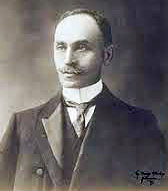
Local teacher Isaac Isaacs starts his legal career by suing the headmaster of the ‘Beechworth Common School’ – at which he has been an assistant teacher since 1873 – for fees that he claims are owed to him for teaching extra subjects. The claim is dismissed.
| After his failure in court, Isaacs quits the Education Department in favour of law. In February 1875, Isaacs secures employment as a clerk in the Prothonotary’s Office of the Crown Law Department in Melbourne. He enrols in the Faculty of Law at the University of Melbourne, combining part-time studies with full-time work, and graduates Bachelor of Laws with first class honours in 1880, followed by a Master of Laws degree in 1883. |
| After a successful legal career, Isaac Isaacs is elected to the Federal House of Representatives as the member for Indi (held in 2023 by Independent, Dr Helen Haines). A champion of Federation, Isaacs is a polymath who speaks six languages including Chinese; is for a time acting Premier of Victoria, a Federal Attorney General, High Court Judge and finally becomes the first Australian-born Governor General in 1931. |
1874 – Aug 7
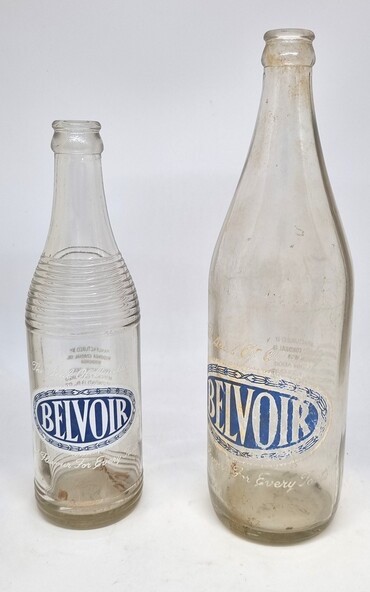
The name of the town of ‘Belvoir’ is officially changed to ‘Wodonga’.
1874 – Aug 8
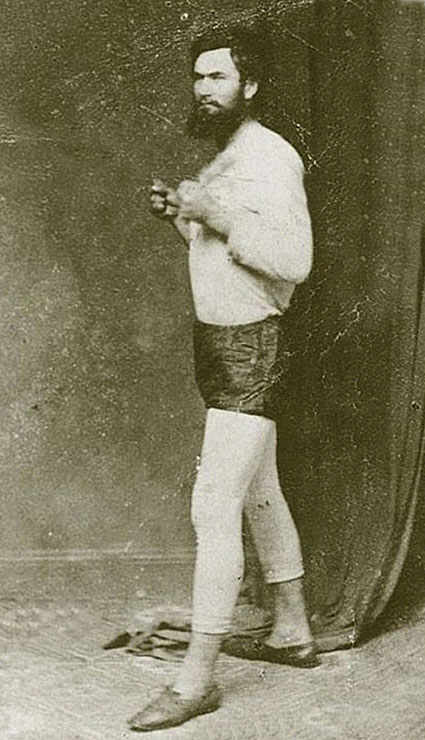
In an infamous bare-knuckle boxing match, Ned Kelly fights Isaiah “Wild” Wright beside Spring Creek at the rear of the ‘Imperial Hotel’. The 19-year-old Ned defeats 25-year-old Wright in the fight which lasts for a brutal 20 rounds and Kelly becomes the unofficial boxing champion of the district.

| The ‘Imperial Hotel’ is demolished in 1966, with just the one-bedroom, one-bathroom ‘Pickett Cottage’ remaining in High Street. It still stands today. |
1874 – Nov 6
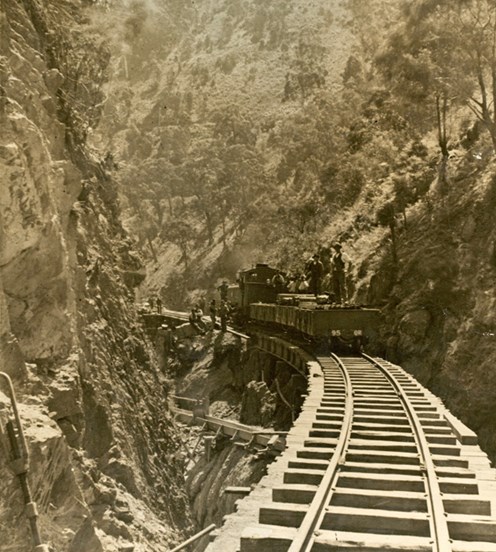
A contract is signed for the construction of a new branch line of the North-Eastern Railway from Wangaratta to Everton, and then on to Beechworth. The contract has been awarded to Messrs A & J Overend for £33,000 and work begins early in 1875 when the North Wangaratta Junction Stop will be created at a spot known as Burkes Waterholes (where natural springs are located) 6km beyond the Wangaratta Railway Station. This junction stop will facilitate the operation of contractor’s trains during the construction of the new branch line. In mid-1875 the North Wangaratta Junction Stop will be renamed Beechworth Junction.
| The branch line from Beechworth Junction to Beechworth will be built in two sections – Wangaratta-Beechworth Junction-Londrigan-Tarrawingee-Everton, then (a year later) Everton-Lee’s Crossing-Beechworth. |
| The Beechworth line will be built using the “Broad Gauge” system (5 ft 3 in / 1,600 mm) as opposed to the “Narrow Gauge” system (2 ft 6 in / 762 mm). A “Narrow Gauge” system will eventually be built on a branch line between Wangaratta and Whitfield in the 1890s. |
1875

The Rocky Mountain Gold Sluicing Company Ltd is created, utilising the previous 1856 Rocky Mountain Claim for the area where present-day Lake Sambell stands. The gold is removed utilising ‘hydraulic sluicing’, a process by which water under high pressure is used to break down large amounts of rock and earth to expose the gold within them. From 1876 until its closure in 1921, the mine produces an astounding 47,926 ozs of gold!
| With ‘hydraulic sluicing’ becoming a popular method of mining gold, an estimated 1,400 km of water races will be built throughout Beechworth. |
1875

At the entrance to Beechworth, the impressive Newtown Bridge is completed over Spring Creek, constructed of local granite by skilled Scottish stonemasons under the supervision of Donald Fiddes at a cost of £2,450. Unlike the earlier timber bridge (which had been built in line with High Street), the new stone bridge lines up with Upper Ford Street (or New Ford Street), which has replaced High Street, after five years, as the main road through Beechworth.
| The completed granite ‘Newtown Bridge’ has a deck 80 feet long by 26 feet, 26 inches wide, including 6 feet of footway. The arch span is 50 feet and the rise 11 feet, while the masonry parapets stand 5 feet high. |

1875
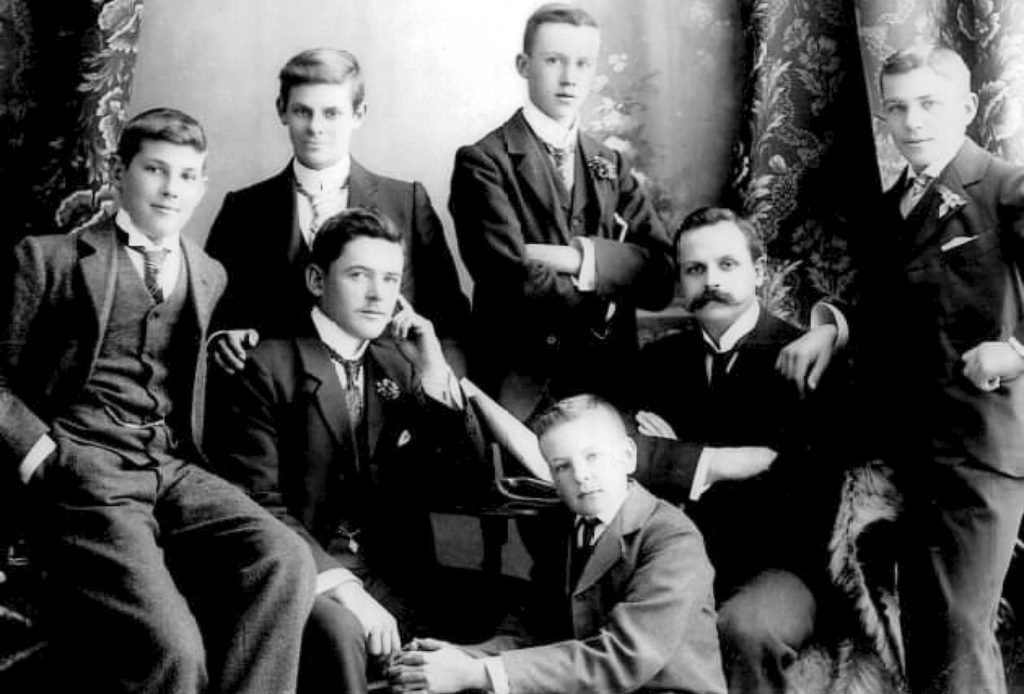
The now vacated 1865-built Common School brick building in Loch Street is taken over by James Goldsworthy’s Beechworth Grammar School, which had been established in 1856 in the hall at 7 Church Street, behind Beechworth’s Christ Church. In 1895 Beechworth Grammar School will be purchased by 21-year-old Andrew Rule Osborn, a former pupil, and in 1897 he will rename it Beechworth College. In 1906 it will be taken over by new principal 27-year-old Parker John Moloney.
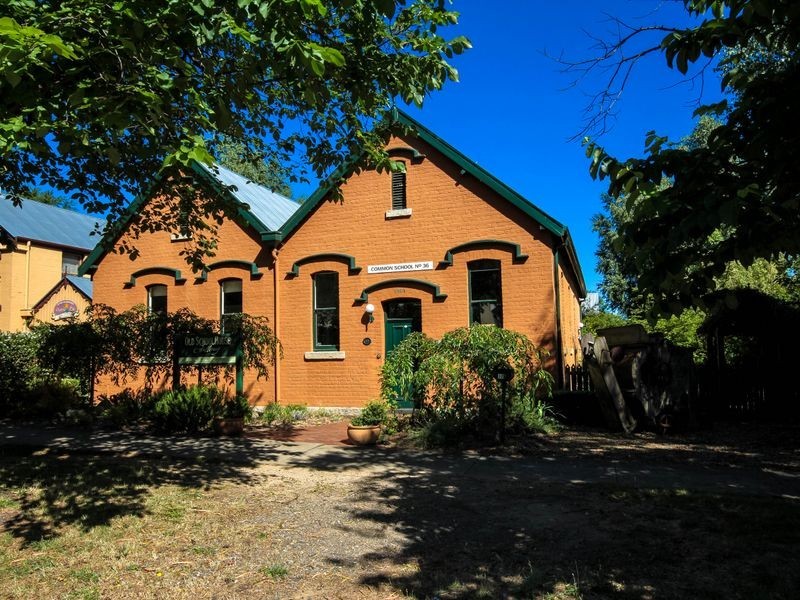
| ‘Beechworth College’ will finally close its doors in 1910 when Parker John Moloney leaves Beechworth to become a federal politician with the Labor Party. |
1875
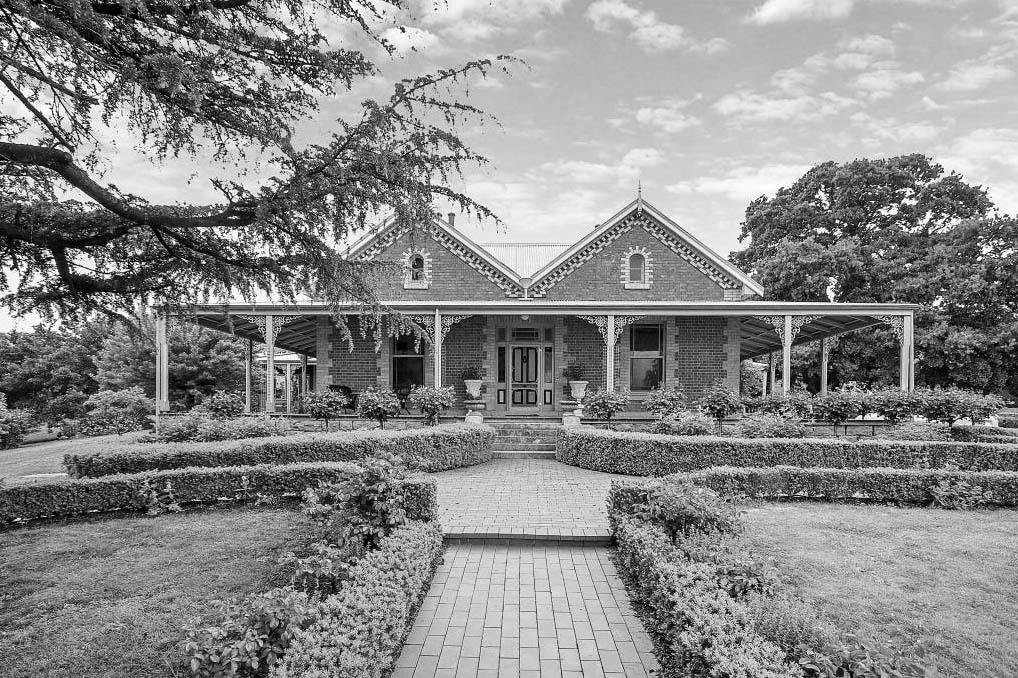
Beechworth’s grandest Victorian-era residence Myrla is built by Donald Fletcher (at what is now) 2 Fletcher Road. Set on a hill (which becomes known as ‘Fletcher’s Hill’) with an elevated aspect over Beechworth, the bi-chrome brick residence features wide timber verandahs and stands in a magnificent Victorian-style garden of just under a hectare, designed by leading German botanist Baron Ferdinand von Mueller, director of the Melbourne Botanical Gardens. The property includes two water features – a classic tiered fountain in the front and a modern reflection pond in the courtyard hemmed by a Beechworth granite retaining wall. There is also a small granite dairy/smoke house in the courtyard and an evergreen oak tree. The entire property is eventually surrounded by massive, manicured box hedges.

| Donald Fletcher, originally from Scotland, arrived in Beechworth in 1855, became a father of 10, and had great success mining gold. ‘Myrla’ will be purchased by the government in 1953 for use as ‘Mayday Hills Mental Asylum’ senior staff accommodation. At that time, they will remove part of the interior upper level. It is now, once again, a magnificent and fully restored private home. |
1875
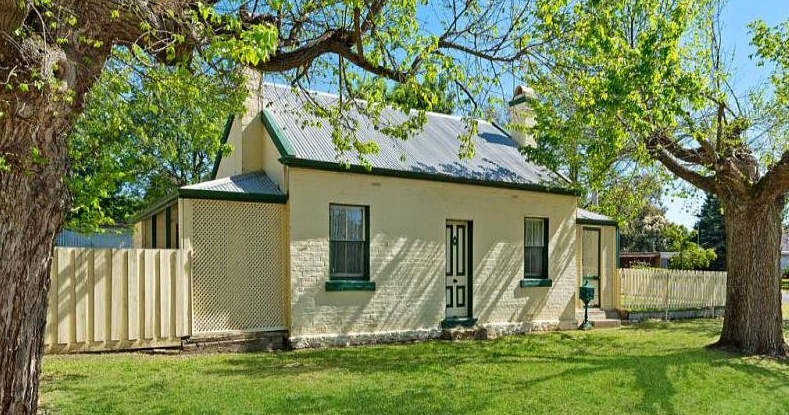
Now that the new Bridge is open, the settlement of ‘New Town’ grows rapidly. A new building is constructed at 24 Bridge Road, that will be a residence but also serve as the New Town Butcher Shop.

1875
New public baths are erected by the Beechworth Bath Company on Loch Street. These will be acquired by the council in 1878.
1875
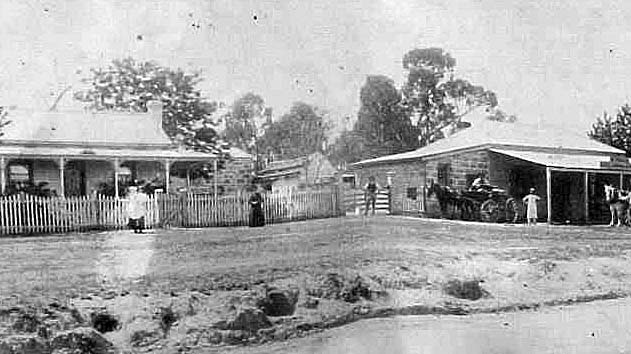
Three miles from Beechworth, on the road to Wangaratta, 18-year-old William James Price opens the Black Springs Bakery on land his father James Price, a market gardener, had selected in 1871. William had come to Beechworth from England with his parents and had entered into the employ of William Trim at his Ovens Bakery on Albert Road before setting up his own bakery at Black Springs. Starting his new business in a tent, he then builds a simple wooden structure in 1877, before enlarging the successful Black Springs Bakery, adding a stone and brick building around it (above right).
| The ‘Black Springs Bakery’ becomes the centrepiece of the small goldrush town of Black Springs, established in the 1850s. At its peak, the township of Black Springs includes a State School, three hotels, a butcher, three blacksmiths, a racecourse, a rifle range, three sawmills, several vineyards and orchards, a collection of dairies, with the ‘Black Springs Bakery’ also becoming the settlement’s official Post Office. Ned Kelly is reputed to have bought bread at the ‘Black Springs Bakery’. Sadly, the Black Springs settlement will be destroyed by a bushfire during the Christmas of 1899 – except for the bakery – which continues supplying bread to the region until 1942 when the Bakery finally closes and becomes the last remnant of a once thriving little community. Gifted to the National Trust in 1968, the old bakery buildings now operate as a guest house. |
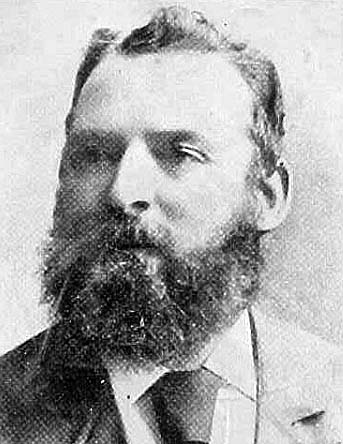
1875 – Jun
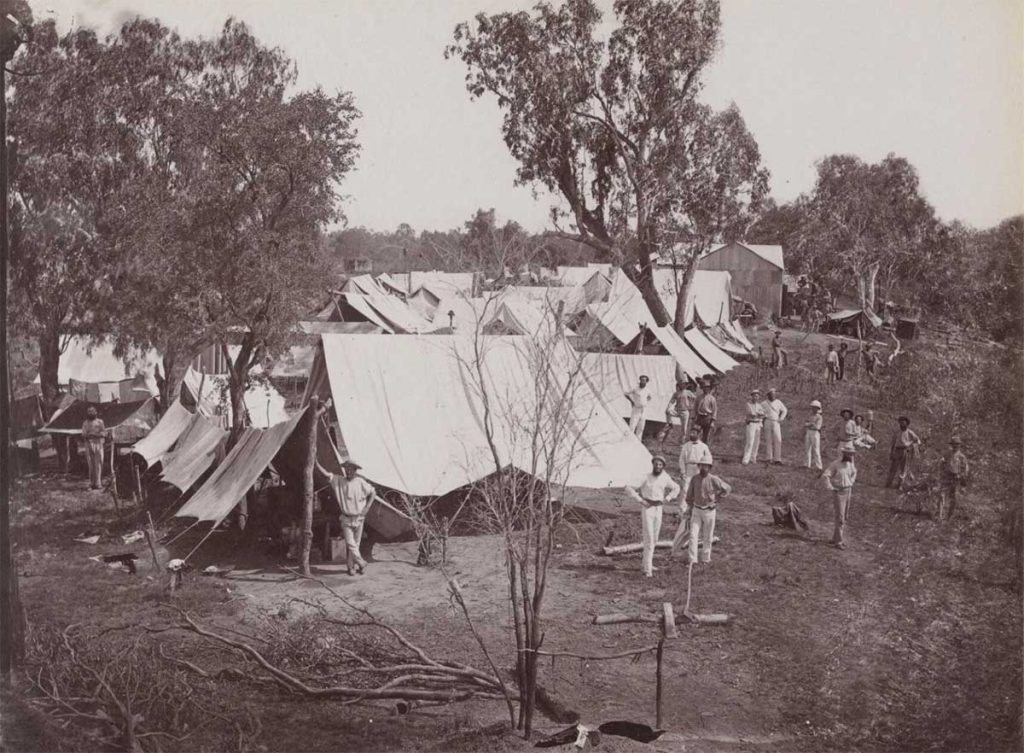
With the first section of the Beechworth branch line completed from North Wangaratta to Everton, the contract to construct the second – and more difficult – section of the railway line from Everton to the twon of Beechworth is awarded to Messers Fishburn & Moreton for £70,018. A small ‘railway town’ will be created at Everton to house the 500 workers needed to construct this ‘up hill’ section of the railway – the steepest broad gauge line in Victoria – complete with stores, hotels, workshops, contractor’s offices and stables while simple canvas and bark dwellings are erected to house the men. The workers use horses, bullocks and mules to manoeuvre the earth scoops and to pull the drays and wagons. Bricks are made in kilns to create 33 bridges and 45 brick culverts.
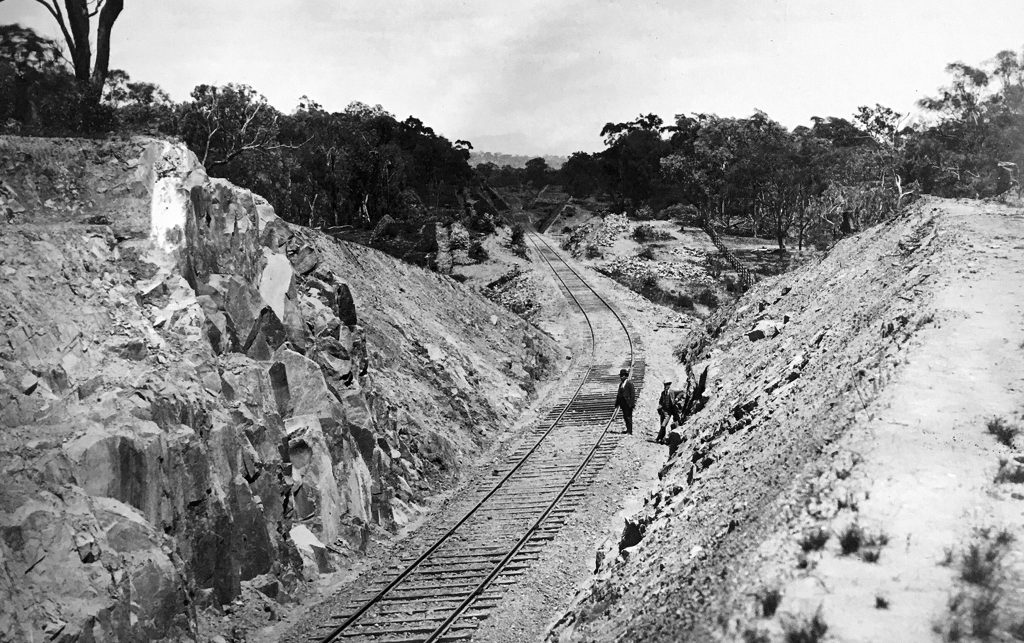
| Work on the second section of the rail line – from Everton to Beechworth – will begin a year later on June 23rd, 1876 and will completed by September 1876. |
1875 – Jul 1
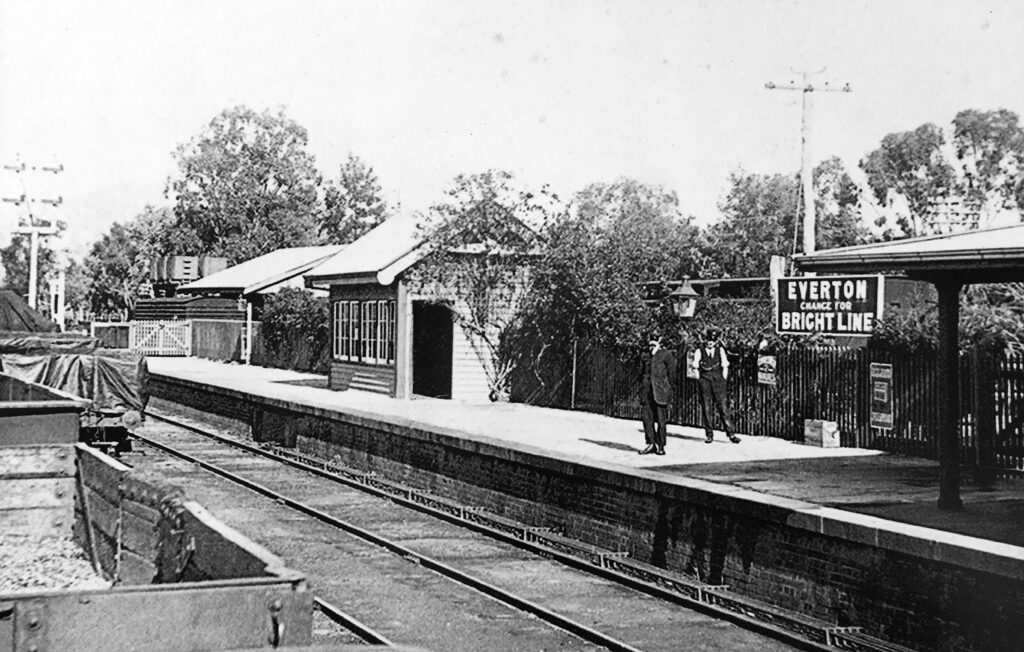
Beechworth pioneer George Briscoe Kerferd, now the Premier of Victoria, is one of the first train passengers as the first section of the rail line – from North Wangaratta to Everton – is completed. Councillor Frederick Brown, President of Beechworth Shire, meets The Honourable Mr Kerferd when he arrives at Everton, halfway between Wangaratta and Beechworth, then they travel by horse-drawn coach to Beechworth to celebrate the completion of the new Beechworth State School (see next entry). The “official opening” of the rail line will be held a week later on July 7th.
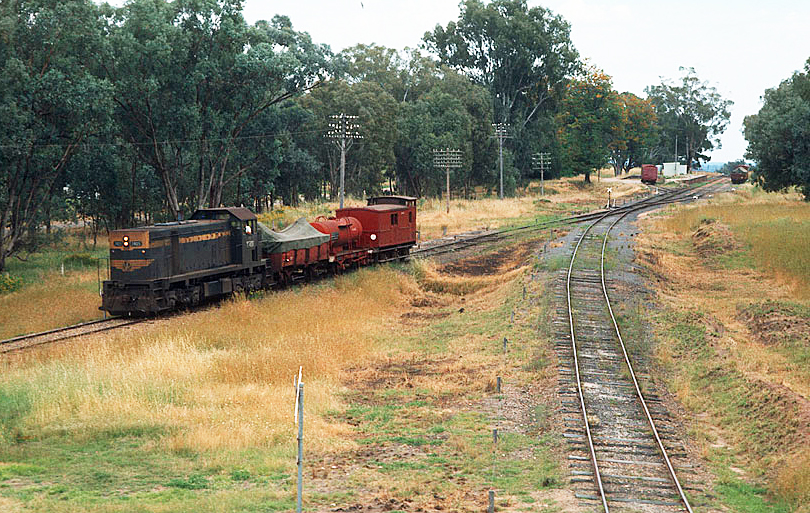
1875 – Jul 2
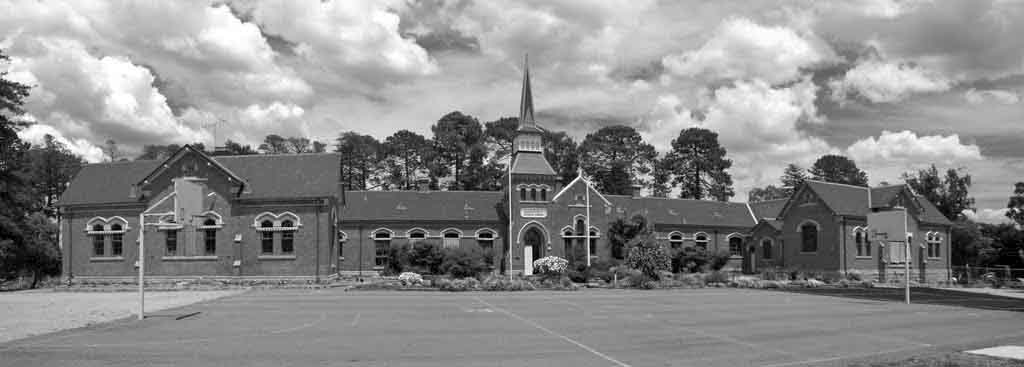
Having travelled to Everton on the new rail line, Victorian Premier George Briscoe Kerferd now makes his way to Beechworth by horse-drawn coach to officially open the magnificent red-brick Gothic-style Beechworth Primary School No. 1560 at the Sydney Road end of the Botanical Reserve. Over 1,000 children march behind a brass band from their old Common School No. 36 in Loch Streetto their new, much bigger school. Also present at the school’s opening ceremony are John Alston Wallace and six members of parliament and a tremendous crowd of local citizens.The new school has an initial enrollment of over 1,000 pupils!
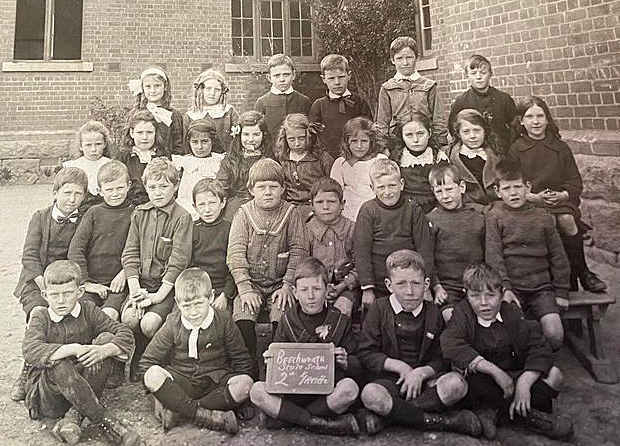
| The architect for the new school is Henry Bastow from ‘Wharton and Vickers’ and his design will be the prototype for five other schools in Victoria. An imposing 20-metre slate-roofed tower dominates the original school building but, after gracing the school for 65 years, some of the slates fall from the tower and it is deemed unsafe and removed. So popular is the famous tower that a replacement tower, albeit more modest, is built in its place. |
1875 – Jul 7

The new siding/stop at North Wangaratta on the North-Eastern Railway line between Wangaratta and Wodonga is officially opened and renamed Beechworth Junction, as it will be from this point that that new branch line Beechworth begins. In 1885 a low grain platform is completed and ready for use and a passenger platform is completed by August 1890 along with a Signal Box. A Booking Office is built in November 1890 and by January 1891 the Beechworth Junction Station opens for passenger traffic with a full passenger platform, booking office, staff accommodation, and shelter sheds all completed, with a siding for heavy loads added in 1901. Beechworth Junction will be re-named Bowser in 1922 after Sir John Bowser, state politician, former Premier of Victoria, and owner and editor of the Wangaratta Chronicle newspaper (established by George Maxwell in 1884).

| The interchange of goods traffic between the main line and the Beechworth branch line is handled at Wangaratta, six kilometres to the south. In 1927, the ‘Bowser Railway Station’ becomes a three-way junction, when a new branch line to Peechelba East is opened. Freight facilities include bulk grain storage, livestock loading ramps, and a fertiliser store. Passenger traffic to the ‘Bowser Railway Station’ ceases on 1 October 1972 and the station closes entirely on 13 April 1987, when the line to Everton (the last section of the Beechworth line) closes. The Peechelba East branch line had closed a year earlier, in 1986. |
1875 – Aug 17
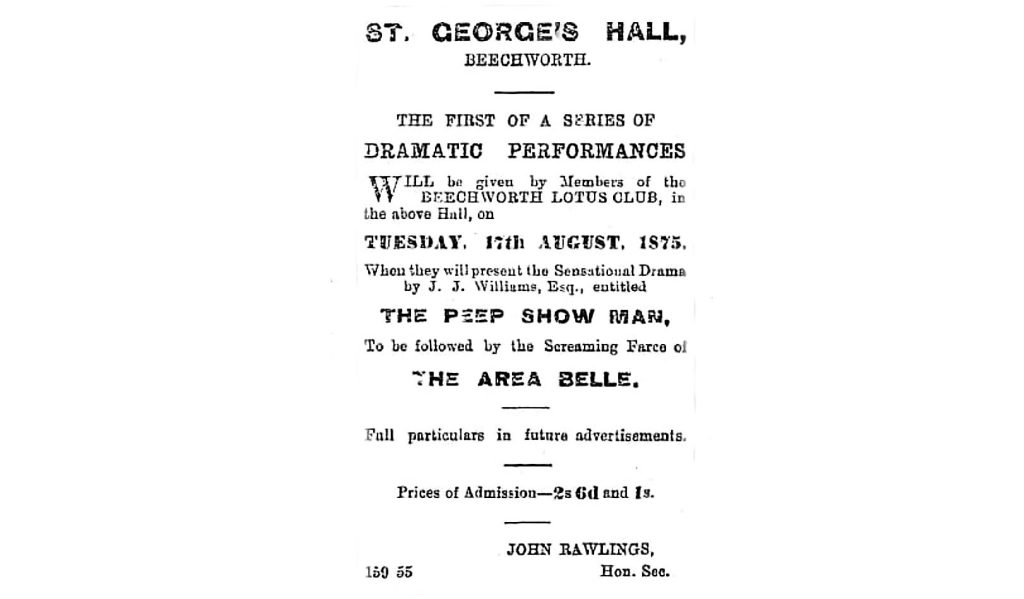
The Beechworth Lotus Club stages a performance at St. George’s Hall on Finch Street. The evening features two pieces – the Thomas John Williams 1868 two-act drama “The Peep Show Man” followed by the one-act 1864 farce “The Area Belle” by William Brough and Andrew Halliday.
1875

Successful Beechworth jeweller William J. Turner builds ‘Elm Tree Lodge’ at the large triangular junction of Loch Street, Kars Street and Sydney Road almost opposite Beechworth Gaol. The original 5 room double brick home is expanded in 1890 to include a large lounge room, master bedroom and an internal bathroom. Sitting on two thirds of an acre, the house has an adjoining carriage shed that is dated pre-1875. It is now luxury holiday accommodation.

1875 – Oct 1
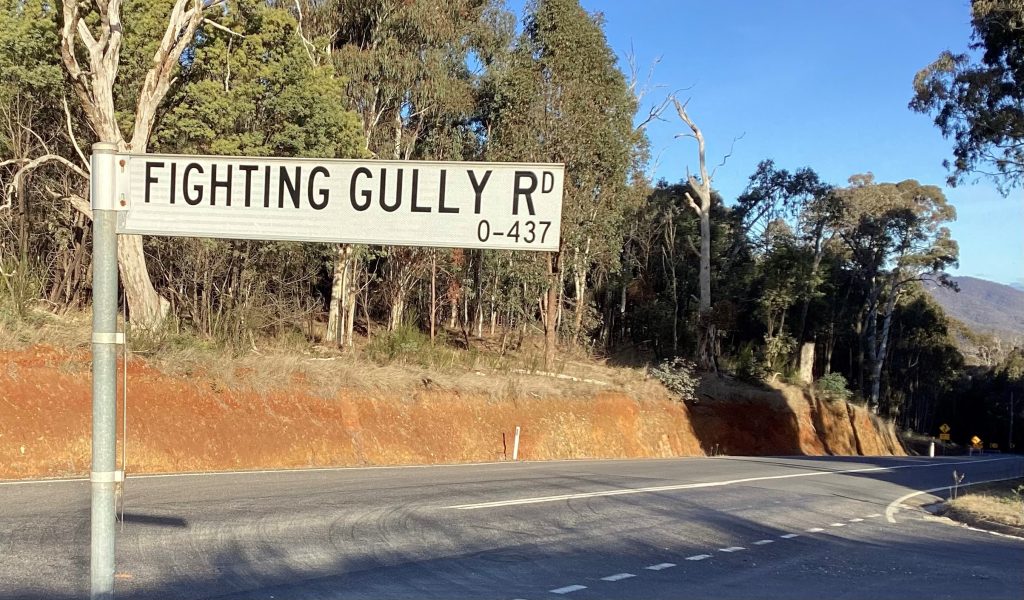
The Baarmutha Post Office opens at Lee’s Crossing on Fighting Gully Road. It will close in 1968.
1875
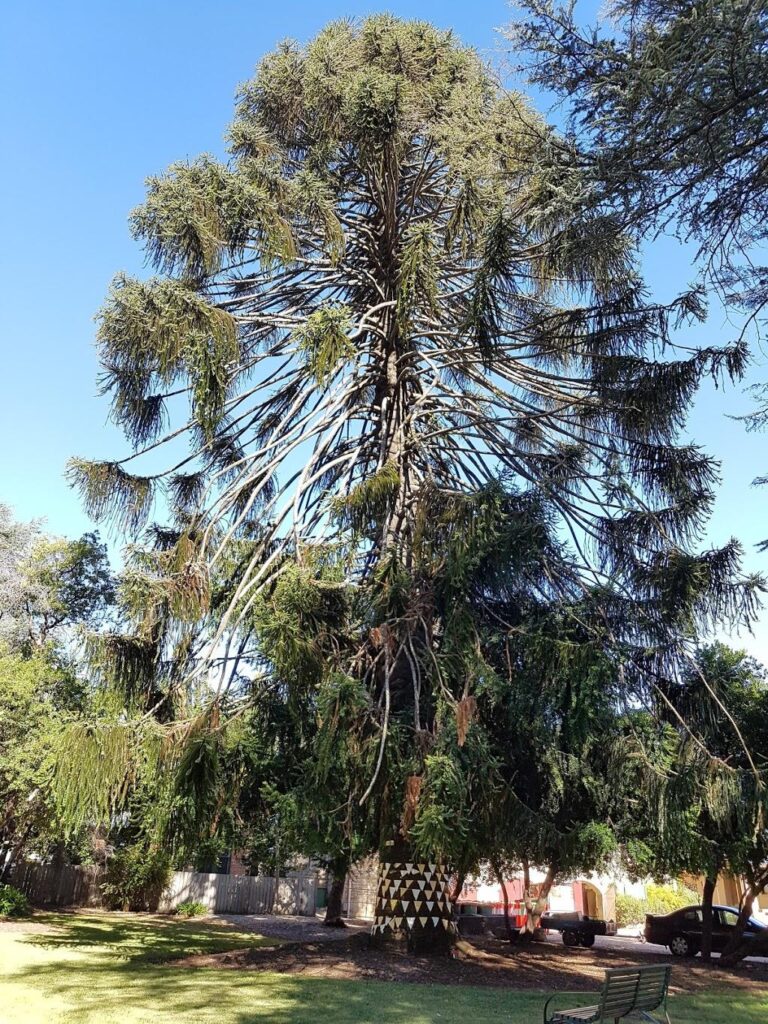
The beautiful Town Hall Gardens are finally opened next to the Beechworth Town Hall. Formerly known as the ‘Market Reserve’ – and in use as a popular public space since 1857 – the new gardens are designed and laid out by Richard H. Jenkyns. He plants a range of exotic species including giant Californian sequoias (above) donated by noted 19th century botanist Baron Ferdinand von Mueller, director of the Royal Botanical Gardens in Melbourne at the time.
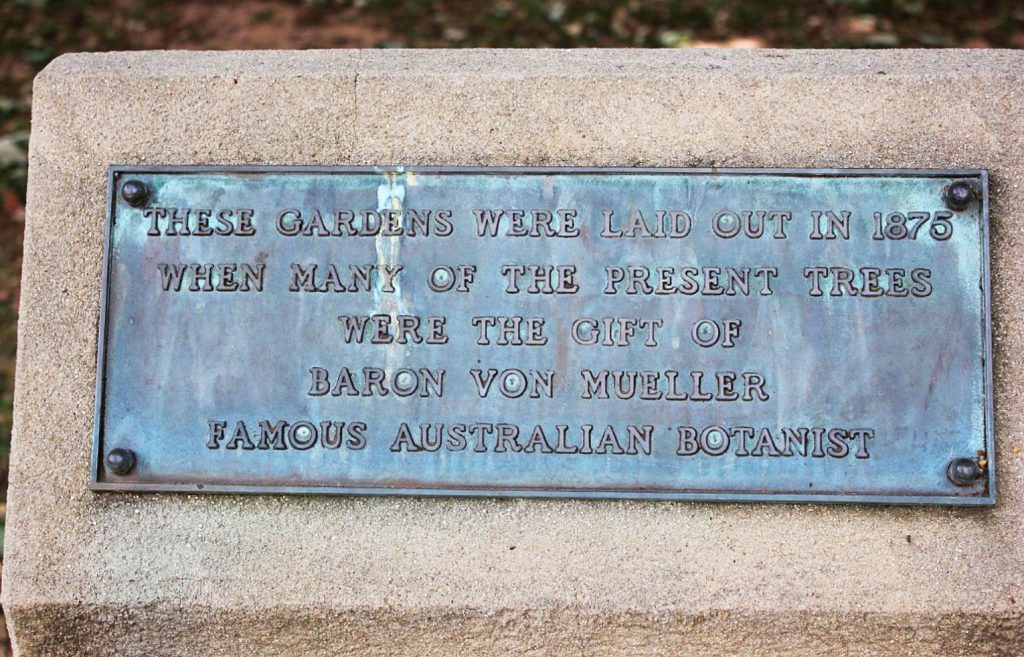

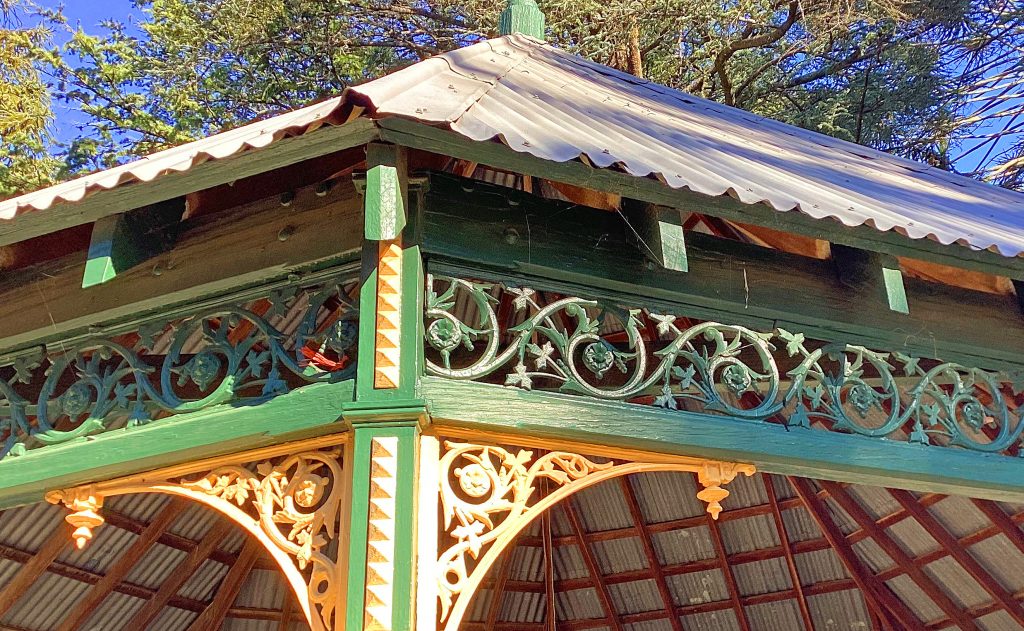
| In May 1876, a cast iron Rotunda is added. All the detailed cast iron work, as well as the pillars, are created and built at the local ‘Straughair and Duncan Foundry’. A fountain and two large urns will be added in 1877. |
1876
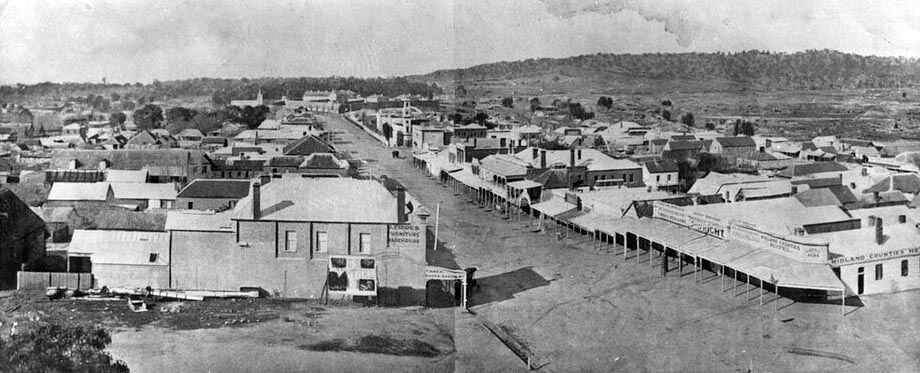
25-year-old photographer Charles Bayliss arrives in Beechworth and takes a series of panoramic ‘plate’ images of the town, including the photograph above, looking north up Ford Street.
| In 1866 16-year-old Bayliss meets the travelling photographer Beaufoy Merlin – who operates the ‘American and Australasian Photographic Company’ (‘A & A Photographic Company’) – and quickly becomes Merlin’s assistant. They travel extensively throughout Victoria and New South Wales. At the goldfields at Hill End in NSW they meet Bernhardt Otto Holtermann, who has become wealthy as the result of successful gold mining. Holtermann employs the ‘A & A Photographic Company’ to produce a series of photographs of the settled areas of Victoria and New South Wales, which are sent abroad to advertise the colony and encourage migrants. Although Beaufoy Merlin passes away, Bayliss continues to work with Holtermann who gifts the young photographer a mammoth ‘Plate Camera’ and the first images taken with it are of Holtermann’s recently purchased ‘Post Office Hotel’ in Sydney followed by an 1875 a panorama of Sydney, taken from the tower attached to Holtermann’s house in North Sydney, now part of ‘Sydney Church of England Grammar School’ (‘Shore School’). In the 1870s Bayliss begins to work alongside another photographer named Henshaw Clarke. Bayliss dies in 1897 (aged just 46) and in 1951 approximately 3,500 glass plate photographic negatives are found in the possession of Bernhardt Holtermann’s descendants. They are subsequently donated to the Mitchell Library (within the NSW State Library) in Sydney and now form the basis of the “Holtermann Collection“, although Bayliss, Clarke and Merlin are the actual photographers. |
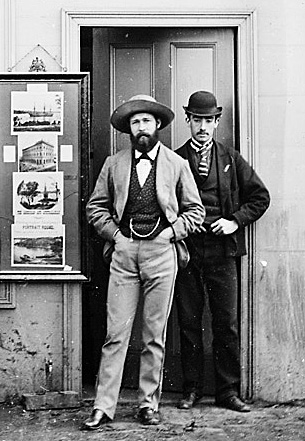
1876

Three cottages are built in Beechworth by the Victorian Railways as permanent homes for the ‘Gang Plate Layers’ and their families – many of whom had previously been living in tents along the railway line to Beechworth as they laid plates for the railway tracks. Only one of the cottages remains today, sitting on Crown Land at 1b Harper Avenue and, in mid-2024, it will be fully restored by the Lions Club of Beechworth for use by the community.

| This ‘Gang Plate Layers’ cottage is believed to be just one of four surviving in Australia. The other three known to be in existence are in Menzies, Western Australia, 131km north of Kalgoorlie, also in the process of being restored. |
1876

The small, original wooden Oriental Bank building is demolished at 97 Ford Street, and a bigger and much more impressive Oriental Bank building is completed on the same site. It is designed in the ‘Renaissance Palazzo’ style by prominent Melbourne architect Leonard Terry, who also designs Beechworth’s Anglican Christ Church, along with Melbourne University’s Trinity Chapel, The Melbourne Club on Collins Street, and the Blight’s bluestone warehouse (now known as Lazars) on King Street. The Oriental Bank – a British Imperial bank founded in India in 1842 – is favoured by Beechworth’s substantial Chinese gold-mining population.
1876 – May
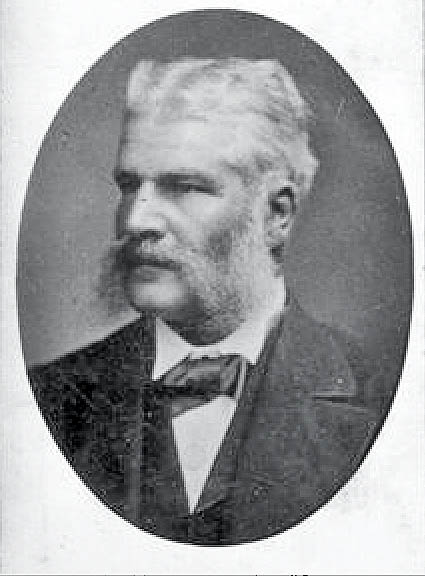
Work on the Rocky Mountain Gold Sluicing Company site continues, using the ‘hydraulic sluicing’ process. Unfortunately, this process leaves a great deal of water and sludge at the base of the mine, so the Rocky Mountain Extended Mining Company is formed – with Beechworth businessman William Telford (above) as Chairman – to cut a tunnel under the town of Beechworth from the lake to the nearby gorge to drain this waste away. William Telford and the company employ A.L Martin to survey the best area for a tunnel underneath the township and out into the Spring Creek Gorge.
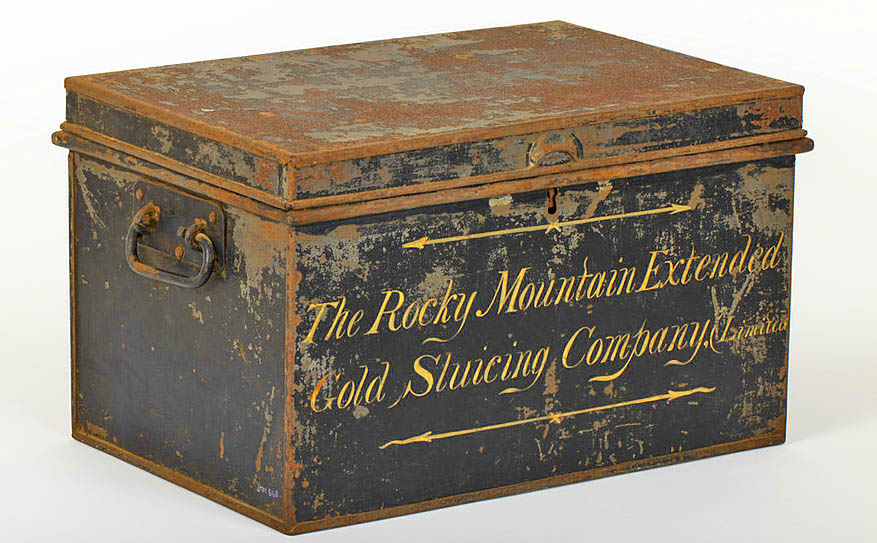
| For almost 25 years Archibald Macnaught Morrison serves as the legal manager of the ‘Rocky Mountain Extended Gold Sluicing Company’, a position he is forced to relinquish at the age of 77 in 1907 on account of his failing eyesight. Upon his forced retirement, Morrison is presented with a purse of sovereigns by the ‘Rocky Mountain Extended Gold Sluicing Company’ shareholders in recognition of his long and faithful service with the company. |
1876

A ‘Manse’ is built at 22 Ford Street for the pastor of the Wesleyan Church.
1876
George Judah Lyon adds a dwelling, stables and fowl house to his Spring Creek Brewery. His business interests extend to the Rocky Mountain Gold Sluicing Company Ltd, and he is one of the promoters of the Gas Company which results in the streets of Beechworth being lit with gas in 1881.
1876
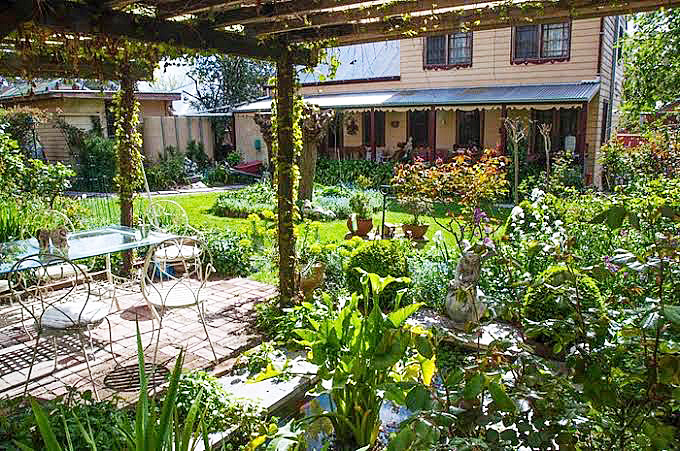
The beautiful Rose Cottage is completed at 42 Camp Street, next door to Beechworth’s 1869-built Congregational Church.
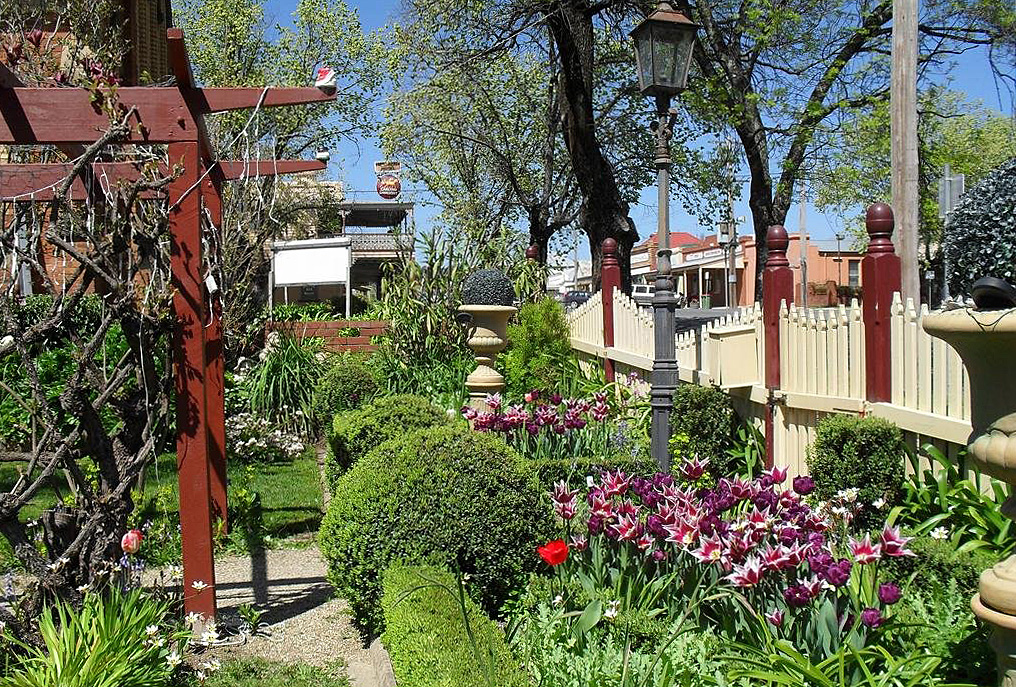
1876 – Jun 9

Crowds travel from around the district and gather at the water’s edge on both side of the Murray River – between Corowa and Wahgunyah – to watch 15-year-old William Henry Freeman walk across the river on a wire. Not only does he cross the water but, to entertain the excited spectators, he also skips across the long piece of fencing wire, walks backwards, lays down on the wire mid-river, sits on a chair balanced on the wire, and even offers to “carry any lad from the crowd upon his back across the wire”. There are no volunteers!
1876 – Jun 10

Under the chairmanship of Beechworth businessman William Telford, The Rocky Mountain Extended Mining Company recommence work on their ambitious 2,600-foot-long tunnel under Beechworth, which will enable mining to continue to a greater depth. Initially using hand drills, in September 1877 more equipment arrives from New Zealand, including the first boring machines in Victoria. The lack of water to operate the air pumps hinders productivity and working hours are reduced to 10 hours a day. Following the call for new tenders, Johnson Stevens wins the new contract at a price of £4 per foot and works resume on February 8th 1877 utilising advances in technology, including the use of compressed air to create pneumatic pressure to drill holes, a steam engine to drive the compressor, and an air extractor – all to cut through the solid granite directly under the town. The tunnel is built at a rate of 40 feet a month and eventually measures 3,600 feet (over 1,000 metres). This is an engineering marvel for the time and is notable as one of the first applications of rock boring machines in Victoria. The massive tunnel – and an associated surface channel at the top end – allows tail water from the deeper wash to be discharged into the Spring Creek Gorge at a point below the discharge of the original 1856 open tailrace.

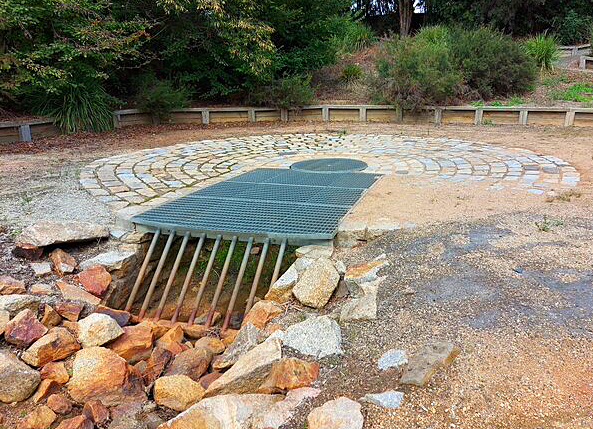
1876 – Jul

36-year-old Alfred William Ladson – younger brother of Thomas Taylor Ladson – takes over the lease of the building on the corner of Camp and High Streets (where the ‘Beechworth Ice Creamery’ operates today) and opens his store A. Ladson General Dealer, specialising in his trademarked Ladson’s Ink, along with blacking, vinegar, baking powder, and horse feed . A year later he will close the store and concentrate on his Ladson’s Ink business. But he will return to running shops in Beechworth five years later.
1876

The 1859-built London Tavern (above) is purchased by Felix O’Connor who, over the next 10 years, will fully refurbish the various brick buildings on the quarter-acre block on Camp Street.
| In January 1902, when the licensee of the ‘London Tavern’ is Ellen Barry, a youth named Archibald Scott appears in court charged with offensive behaviour at the Tavern on Christmas Eve. Although the case is dismissed, Scott is soon re-arrested on a charge of committing perjury. The fascinating case involves an identical twin brother and a missing finger! |
1876 – Jul 13
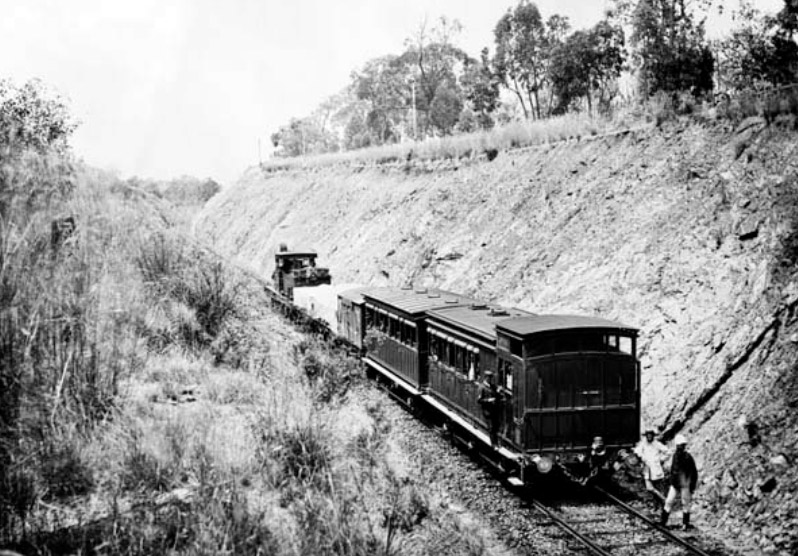
After two years of construction of the Beechworth branch line – at a total cost of £103,018 for the two rail sections – the first train arrives at Beechworth (although the Beechworth Railway Station building won’t be completed until the end of the year). The relatively short branch line from Beechworth Junction (Bowser) to Beechworth is one of the earliest in country Victoria. Between Beechworth Junction and Beechworth, there are four stops – Londrigan, Tarrawingee, Everton and Lee’s Crossing (renamed Baarmutha in 1904).
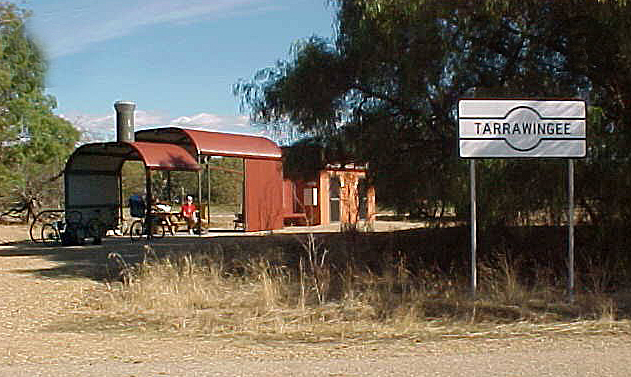
| A further extension of the branch line from Beechworth to Wooragee and Yackandandah will open on 23 July 1891. The line is running at a loss just six months after it opens. Despite this, the Yackandandah extension is in operation until 1954 when a bushfire damages a bridge, resulting in the line closing permanently. |
1876 – Sep 29

After a long and steep haul up the escarpment to Beechworth, 13 carriages hauled by three steam locomotives finally arrive in town for the official opening ceremony of the completed second section of the railway line from Wangaratta (via Beechworth Junction). The branch line represents the faith of the then Premier of Victoria, George Kerford, and the leading citizens of Beechworth in the future of the district. The opening ceremony is the biggest event to take place in the Ovens District since the gold rush of the 1850’s, with celebrations taking place in and around the Goods Shed and a large circus tent erected for the occasion (as the station building is not yet complete). The ceremony is led by the Governor of Victoria, Sir George Bowen (below), along with the Premier, the Mayor and Town Council. Over 6,000 people gather for the event, including a large contingent of the Chinese community, all turned out in their finery.

| The Beechworth Railway Station will officially close on December 30th 1976, one hundred years after it opened. The short branch line between Everton and Bowser (part of the branch line to Myrtleford and Bright) remains open until 1987. In the 1990s the line between Bowser and Beechworth becomes part of the ‘Murray to the Mountains Rail Trail’. |
1876
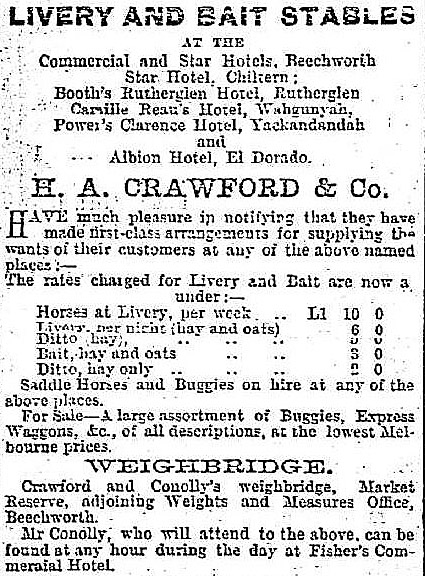
A new booking office for Hiram Crawford’s stagecoach line is opened in Ford Street. Stagecoaches depart for the regular journey to Melbourne from the large ‘Livery & Bait Stables’, still located at the rear of the building. The shopfront is altered in 1861 to the way it looks now. Unable to compete with the expanding railway network, Crawford & Connolly Coaches will close in 1906.
| The stagecoach trip to Melbourne from Beechworth costs £7 per person and takes three days, with overnight stops at Euroa and Seymour. |
1876

41-year-old Matthew Dodd and his brothers – 44-year-old John Dodd and 40-year-old Thomas Dodd – who have successfully run the Ovens Tannery since 1858, now open a leather goods shop – Dodd’s Leather Merchants – in Ford Street to run in conjunction with their Tannery on Malakoff Road.
1876
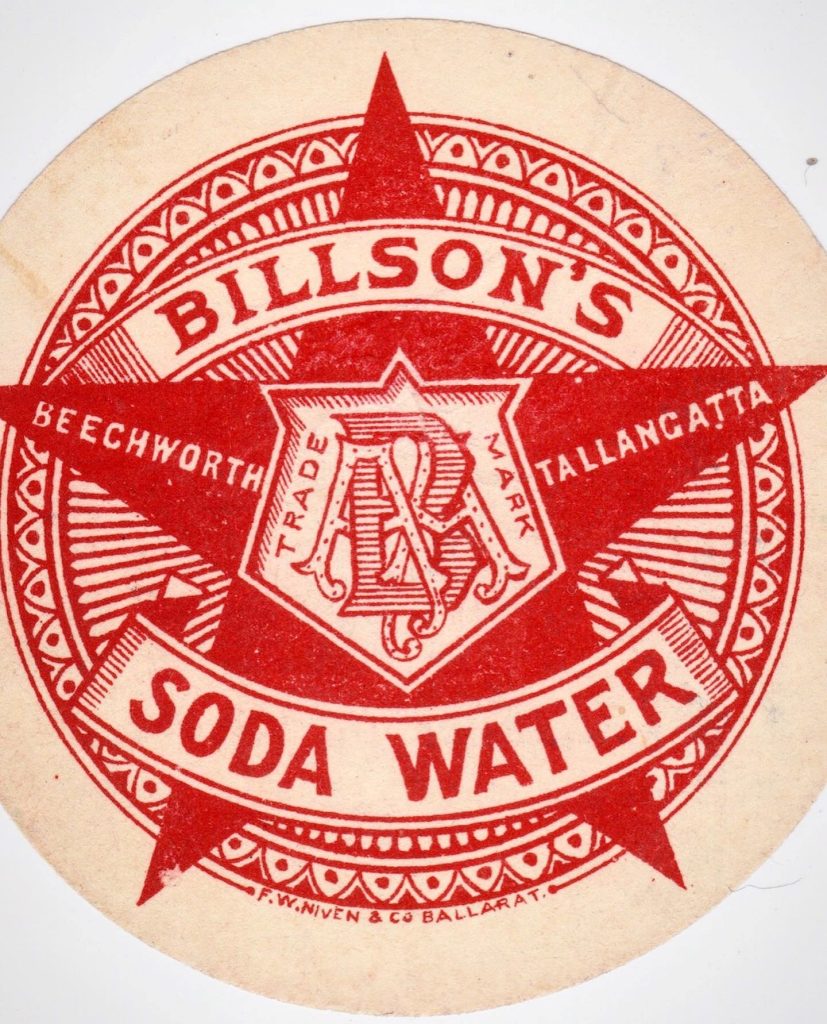
Beechworth Brewers 59-year-old George Billson and his 18-year-old son Alfred Arthur ‘Bosher’ Billson sail to Philadelphia in America to exhibit a range of their beverages at the Centennial International Exhibition, the first official “World’s Fair” (May 10 – November 10, 1876) to celebrate the 100th anniversary of the signing of the Declaration of Independence. Billson’s win first prize for their Soda Water, made from the same pure alpine spring water – drawn from the same red brick well – that Billson’s continue to use in their drinks today.
| The 1876 World’s Fair in Philadelphia includes over 14,000 businesses from 37 countries and attracts almost 10 million visitors. Inventions seen for the very first time include Alexander Graham Bell’s telephone & Thomas Edison’s automatic telegraph system. Some of the new food products being exhibited include popcorn, ketchup & root beer. |
1877
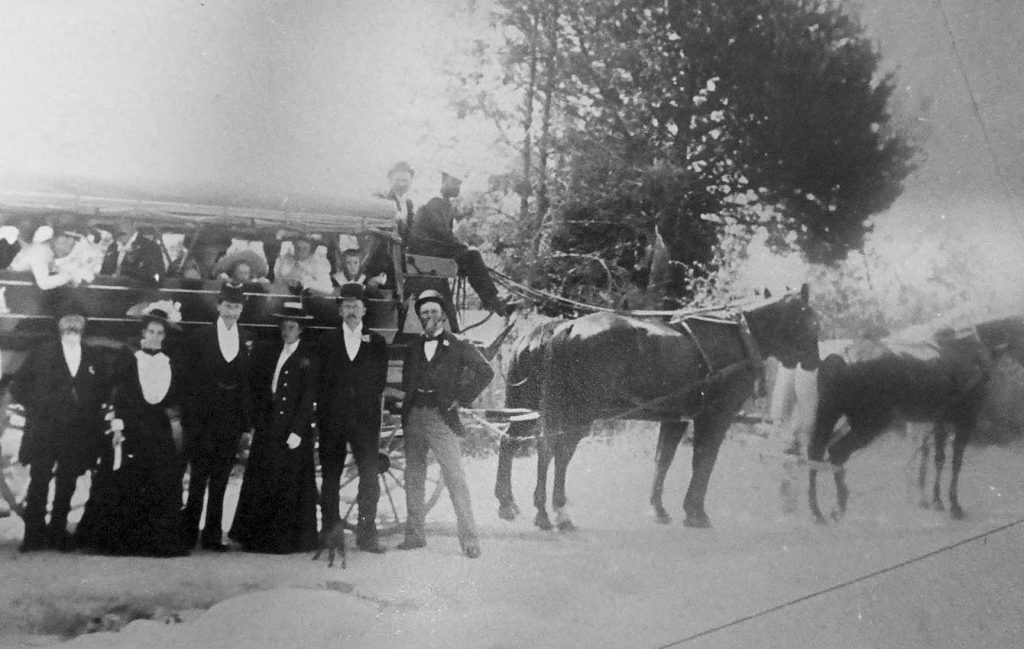
A large coach is built at the Crawford and Connolly factory in Beechworth, for the Wodonga-Albury run. Painted in bright colours, it is built to accommodate 15 passengers and weighs 15.75cwt. This is soon followed by another omnibus, the ‘Ballarat’. Designed to carry 18 passengers inside and 18 outside, it too is built expressly for the run between Wodonga and Albury at a cost of 150 guineas. The coaches run every half hour from 2.30 am as well as at times to suit the arrivals and departures of the trains.

1877

After beginning construction in 1858, work is finally completed on ‘Baird’s Cottage’ – a logging company house – at 26 Mellish Street. The Tudor-style cottage is built for David and Catherine Baird by David’s father George Baird. Standing on a granite foundation, it features 60cm thick granite walls, a river redgum frame, filled in with brick rubble rendered with ‘wattle & daub’ (made with lime, manure and straw) and has a shingle roof and door locks imported from London in 1850. Weatherboards are added in 1880 and a corrugated iron roof later replaces the wooden shingles. It still stands today (on the corner of Mellish and Crawford Streets).

1877
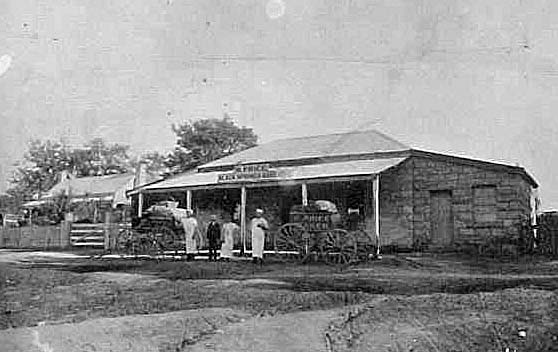
Business is booming at the Black Springs Bakery so William James Price contracts Messrs. Rose and Sherry to create a larger granite building over the top, and around, his original wooden bakery, then remove the wooden frame. (This accounts for the very high ceiling in the present bakery and the fact it is not completely square.) The large granite blocks used in construction are hewn from a quarry about 100 yards away, with some of the blocks measuring 8 feet long, 1 and a half feet thick, and a foot in width. Stables and a barn (for storing grain), along with a men’s hut (built on the western end) and a flour room (on the eastern end) – all constructed from granite – are added in 1890. The stables are removed after a typhoid outbreak caused by drainage into the well sunk at the eastern end of the Bakery.
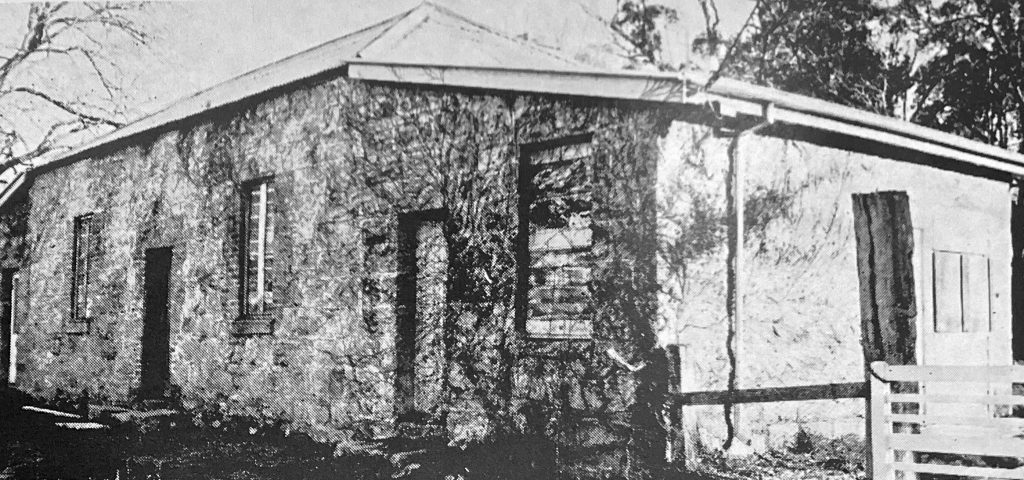
1877

Ned Kelly’s younger brother Dan (aged 16) is sentenced to gaol for three months on a charge of damaging property. Soon after his release, a warrant for his arrest is issued for horse stealing.
1877
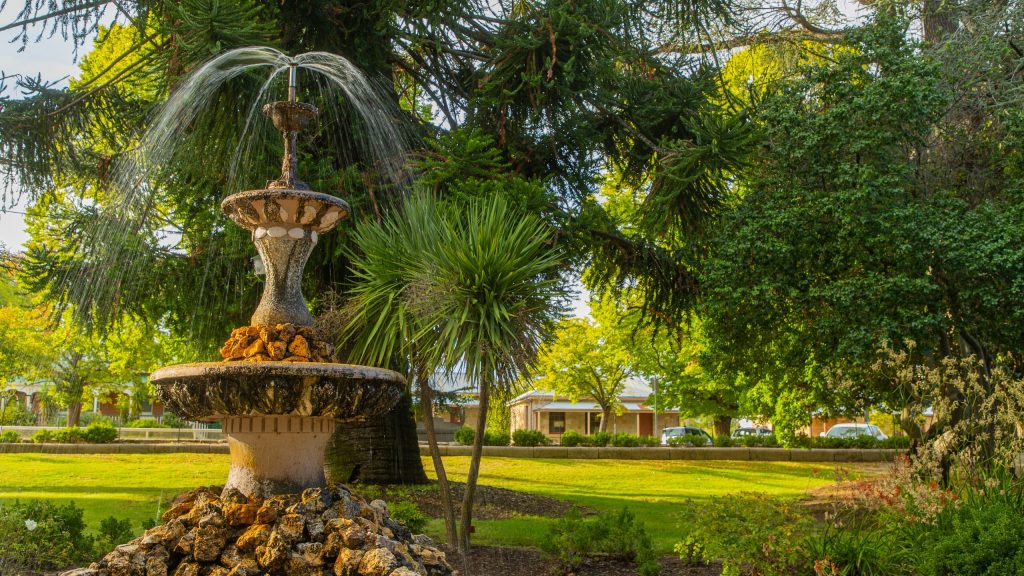
A beautiful fountain is added to the Town Hall Gardens to compliment the 1876 cast iron Rotunda.
1877

Just 10 years after being established, the Beechworth Fire Brigade – through lack of funds – is disbanded.
| However, by 1866 there have been so many fires in the Beechworth district, insurance companies approach the council and offer to contribute to the cost of equipment and the running of a brigade. It is formed and named the ‘Volunteer Fire Brigade Board’. |
1877 – Dec 27
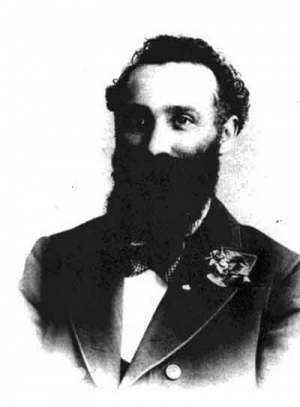
51-year-old Philip Le Couteur, and his second wife 28-year-old Ann Maria Kelly give birth to their first child, Frederick Le Couteur.
| Frederick Le Couteur becomes a Beechworth Councillor in 1935 and is elected Beechworth Shire President in 1940. He will donate (for a ‘nominal sum’) part of his substantial Le Couteur land holdings along Sydney Road for the building of the new Ovens District Hospital at 52 Sydney Road in 1939. Frederick will die at the age of 71 in Beechworth on 18 November 1949 and be buried in the Beechworth Cemetery. |
1878

A delightful brick cottage is built at 53 Last Street, on a large block of land on the corner of Last and Frederick Streets.
1878 – May 20

In the nearby town of Stanley, 23-year-old Beechworth blacksmith Charles Frederick Phillips marries 21-year-old Fanny Florence Hollister. They will begin their married life by moving into a small cottage at 31 Camp Street which had been built in 1861. It will be their home for many years and become known as Fanny Phillips Cottage as Fanny’s fame grows as one of Beechworth’s leading suffragettes – women who fight for the rights of women to vote.
| Charles Phillips is a heavy-set young man and will gain much weight during his life – peaking at 30 stone (approx. 191 kg). His work as a Beechworth blacksmith has to stop once his ever-increasing weight interferes with his movements. Newspapers pose the question “Australia’s Heaviest Man?” when he dies from a heart attack at the age of 57 in 1909. |
1878 – Oct 12

Ned Kelly’s Ellen, her neighbour William Williamson and her son-in-law William Skillion, are found guilty at the Beechworth Courthouse and sentenced for aiding and abetting in the ‘attempted murder’ of Constable Alexander Fitzpatrick (a trooper of dubious character) who visited the Kelly house in April 1878, ostensibly to arrest Dan Kelly. Ellen Kelly is sentenced to three years and the men to six years each, with 46-year-old Ellen entering Beechworth Gaol with her four-day-old daughter, Alice. Subsequently, rewards are posted for the arrest of Dan and Ned, causing them to go into hiding in the Wombat Ranges where they are joined by Byrne and Hart, thus precipitating the formation of the ‘Kelly Gang’ which will lead to the shooting murders of three policemen two weeks later at Stringbark Creek (see entry below).
| Redmond Barry, the presiding judge in Ellen Kelly’s trial, allegedly remarks that if Ned Kelly were present, he would have “received 15 years for his part in the Fitzpatrick affair”. |
1878 – Oct 28
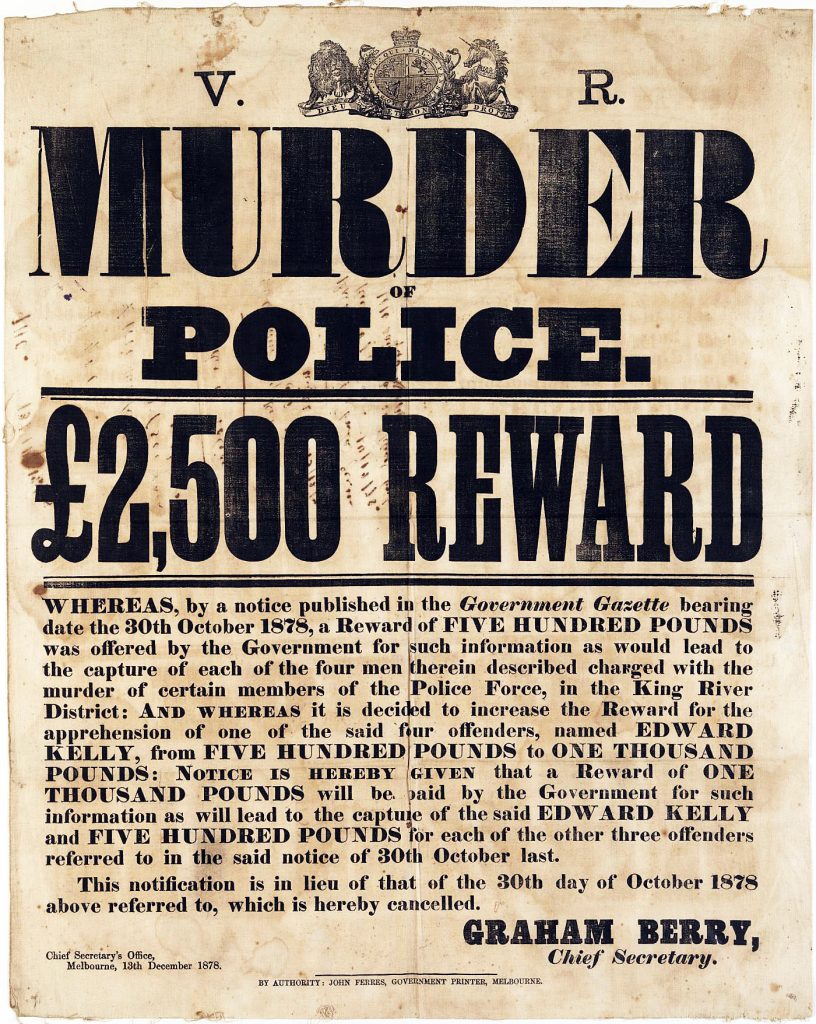
After Ned Kelly and his gang ambush a party of police and murder Sergeant Michael Kennedy and constables Michael Scanlan and Thomas Lonigan at Stringybark Creek on October 25th, news of the murders leads to widespread fear of the “rampage of the bushrangers”. So, on this date, the Victorian Government announce a reward of £800 (£200 per head) for the arrest of Ned Kelly, his brother Dan, Joe Byrne and Steve Hart. This is soon increased to £2,500 (see above). On 31 October 1878, the Victorian Parliament passes the Felons Apprehension Act, which comes into effect on 1 November. Three days later, notices are published throughout the colony giving the bushrangers until 12 November to surrender themselves. By 15 November the four members of the ‘Kelly Gang’ – having not surrendered themselves – are declared “Outlaws”. As a result, members of the gang could be killed without challenge by anyone finding them armed, or who had a reasonable suspicion that they are armed. The act also penalises anyone who gives “any aid, shelter or sustenance” to the outlaws or withholds information, or gives false information, to the authorities. Punishment is “imprisonment with or without hard labour for such period not exceeding fifteen years”.
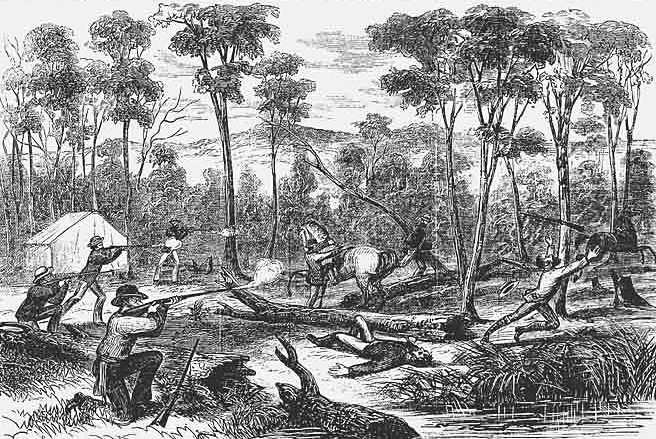
1878 – Nov 6
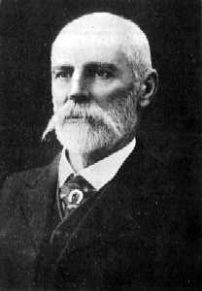
“The Sebastopol Charge”. The outlawed Kelly Gang are being hunted in North-East Victoria and, after meeting two parties of police at Taylor’s Gap who inform them of a sighting of the Kelly Gang at Sheep Station Creek at nearby Sebastopol, Superintendent John Sadleir and Senior Constable Frank James arrive in Beechworth at 10.30pm to find a search party being organised by Constables Keating and Keen and the town “overrun with armed men” – citizens armed with guns and weapons of various sorts ready to take on Ned Kelly and his gang. Sadleir sends an urgent despatch about the situation to Captain Frederick Charles Standish and Assistant Commissioner Charles Hope Nicolson in nearby Benalla. Standish immediately orders a special train, and proceeds to Beechworth with Nicolson, nine mounted constables, one black tracker, and two or three gentlemen of the Melbourne press, arriving in Beechworth just after 3 am. Before sunrise, they are joined by Sergeant Arthur Steele leading another 13 police officers and the “Charge of Sebastopol” begins!
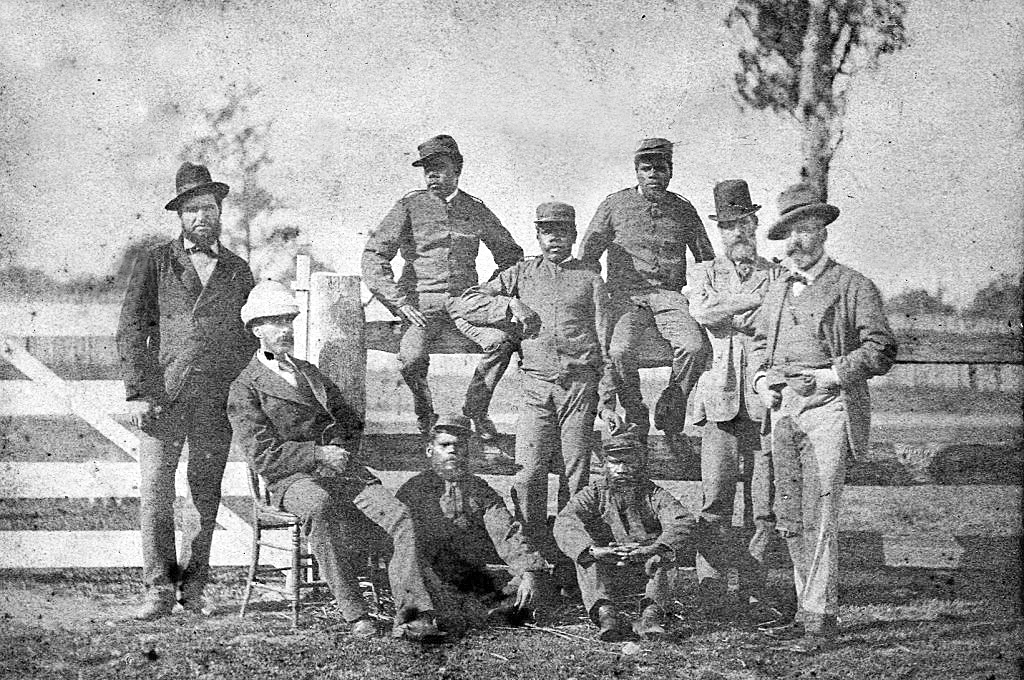
1878 – Nov 7
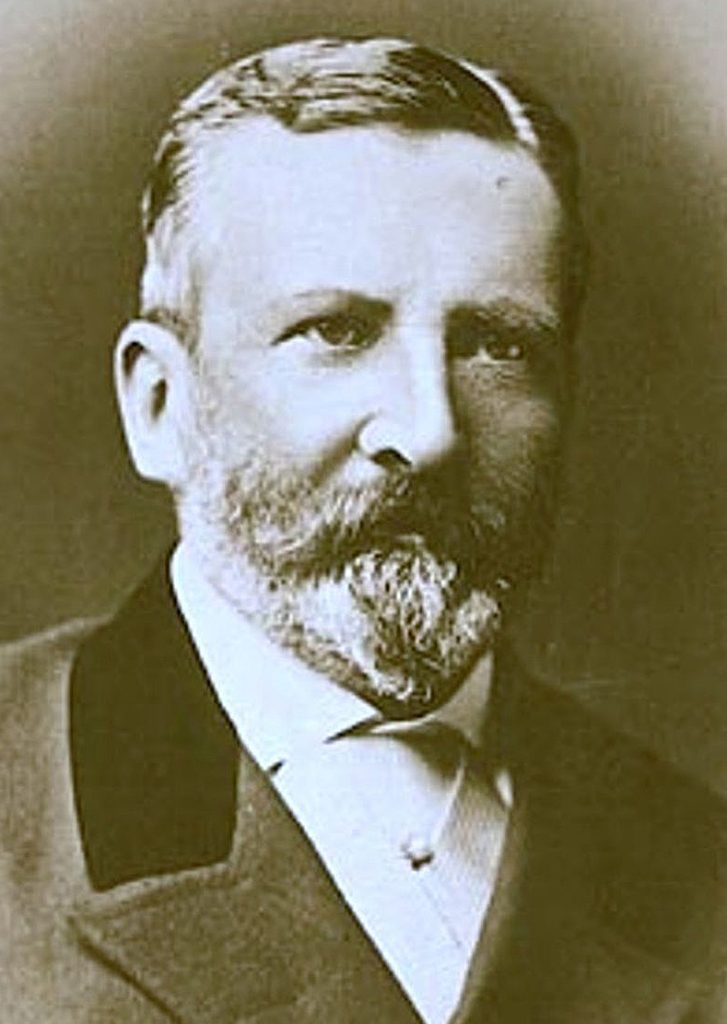
Having selected a large number of men, 45-year-old Superintendent John Sadleir departs Beechworth, leading up to 30 mounted police and other armed civilians, before being joined by Captain Standish and Assistant Commissioner Nicolson and their men at a spot about 3 miles out of town at “The Springs’. Then the noisy “Sebastopol Charge” heads off along the track to the Sebastopol area to hunt for the ‘Kelly Gang’. They visit Aaron Sherritt at his house and then Joe Byrne’s mother at the Byrne family home but have no luck in finding the ‘Kelly Gang’. The police later drop into the popular Reidford Hotel at Sebastopol for refreshments, at which point Aaron Sherritt does “a bargain deal” with Captain Standish – in return for information about the ‘Kelly Gang’, Standish agrees to save Joe Byrne and guarantee his life. This “bargain deal” – and others that Sherritt negotiates – will lead to 25-year-old Sherritt being murdered by Joe Byrne on June 26th 1880.
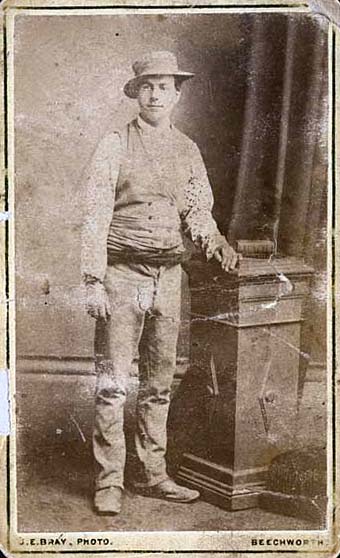
| “Utter Fiasco!” A Royal Commission will later find that “One of the earliest combined movements of the police in pursuit of the outlaws was not calculated to favourably impress the mind of the public as regards the capacity of the officers. The “Sebastopol Charge” as it has been designated, proved an utter fiasco, calculated simply to excite ridicule, and for this, Superintendent Sadleir must be held directly responsible”, with an observer adding that “the rumbling noise that the cavalcade of men and horses made was just like thunder, and any people being searched for could hear the cavalcade a mile off!”. |
1879 – Mar 1
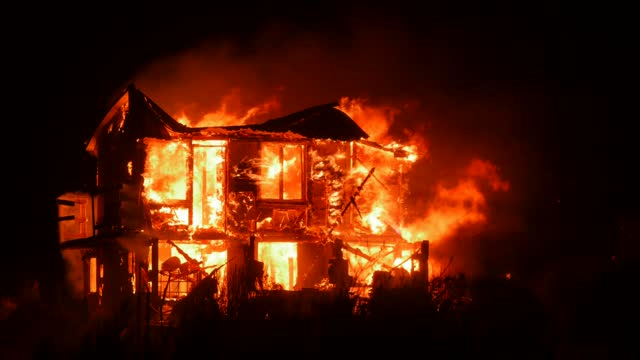
Another fire in Camp Street! A fire breaks out at Mr Bain’s mattress-making shop in Camp Street and spreads to Hille’s Butcher Shop next door (both built of wood) and then the flames leap to the brick-built Empire Hotel before being extinguished by the local fire brigade. The hotel’s lodgers lose all of their possessions, and the hotel is badly damaged, but the licensee Robert Bolan is able to save some furniture, stock and accounting books.
| This fire occurs almost 12 years to the day that fire destroyed the previous ‘Empire Hotel’ which had then moved to this new site. The newspaper reports a local wag as saying that “Beechworth has seen the downfall of two Empires!”. |
1879
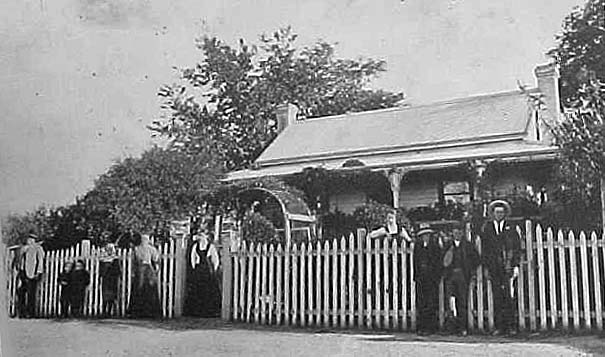
At the Black Springs Bakery, William James Price marries Elizabeth Stollard from Beechworth and together Mr and Mrs Price build a four-roomed cottage next door to the popular bakery. Elizabeth christens their new home “Buffalo View”. The Price’s will have 11 children (two of their sons will go on become bakers) but tragically lose their youngest son Albert ‘Bertie’ Edward Price on March 16th 1894 when he is just 16 months old. Elizabeth plants a vine which gradually spreads over the granite bakery building, covering it with a glorious mantle of green. Even in the depths of winter, “sprays are coaxed into exuberance by the warmth exuding from the bakery’s oven”.

| In 1894 the original deep well (built on the land in 1871 by William’s uncle James Price) is covered by stonemason Thomas Fluke by a slab of granite, which has the initials “WP”, “TF” and the year “1894” carved into it. It can still be seen today. |
1879 – Jun 5

A meeting is held in Beechworth of the lapsed Beechworth Philharmonic Orchestra and the orchestra is reformed. The chief originator and conductor is James Cunningham Snr and the society will soon comprise forty-five ladies and gentlemen – thirty-two of whom are singing members. They will begin giving concerts in Beechworth quarterly and occasionally entertain patients at the Beechworth Benevolent Asylum. The self-dependant Beechworth Philharmonic Society is now under the experienced management of Richard Finch, the honorary secretary. Organist, James Cunningham Jnr, plays the harmonium with the orchestra, but is keen to upgrade to a proper organ. (see entry in Dec 20, 1886)
1879 – Jun 9
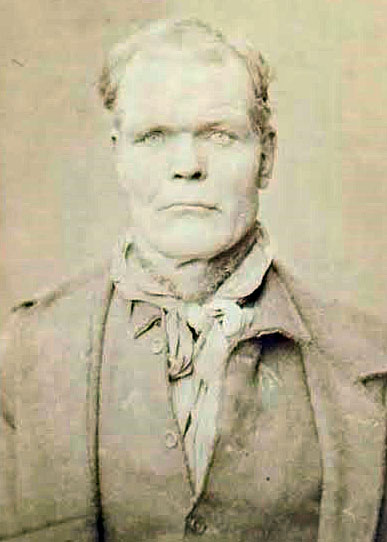
At 9.00am at the Beechworth Gaol, 34-year-old Irish-born Thomas Hogan is hanged for the murder of his brother the previous year. On his final morning, Hogan is attended by Catholic priest Father Michael O’Connor. After being walked to the gallows Hogan is asked if he has anything to say. His reply is a simple “No”. The execution is carried out by Michael Gately – Victoria’s ‘official hangman’ from 1875 to 1879 – who has been brought by train from Melbourne for the execution. A small crowd gathers at Beechworth Railway Station to catch a glimpse of the notorious hangman when he arrives.
| On February 15th 1878, after Thomas and his brother James had argued after overseeing a raffle the previous evening, they meet in Bundalong (at the junction of the Ovens and Murray Rivers) where Thomas, still seething from the night before, shoots and kills his brother. Thomas is said have been standing so close to James that the fatal shot causes his clothes to catch alight and James’s body is badly charred. |
1879

Beechworth’s water supply is further augmented when Council purchases Trahair’s Race.

| In 1900 the open race into Beechworth is replaced with iron pipes at a cost of £3,500. This is followed by the construction of the ‘Europa Gully Tunnel’ in 1908, at a cost of £1,030. Following a drought in 1917, Council purchases Lorimer’s race at a cost of £1,030. |
1879

Renowned clairvoyant, mesmerist and phrenologist Madame Marie Sibley performs in Beechworth, causing both offence and consternation, and excitement and sensation! Memorably, she has publicity portraits taken at James Edward Bray’s photographic studio on Camp Street.
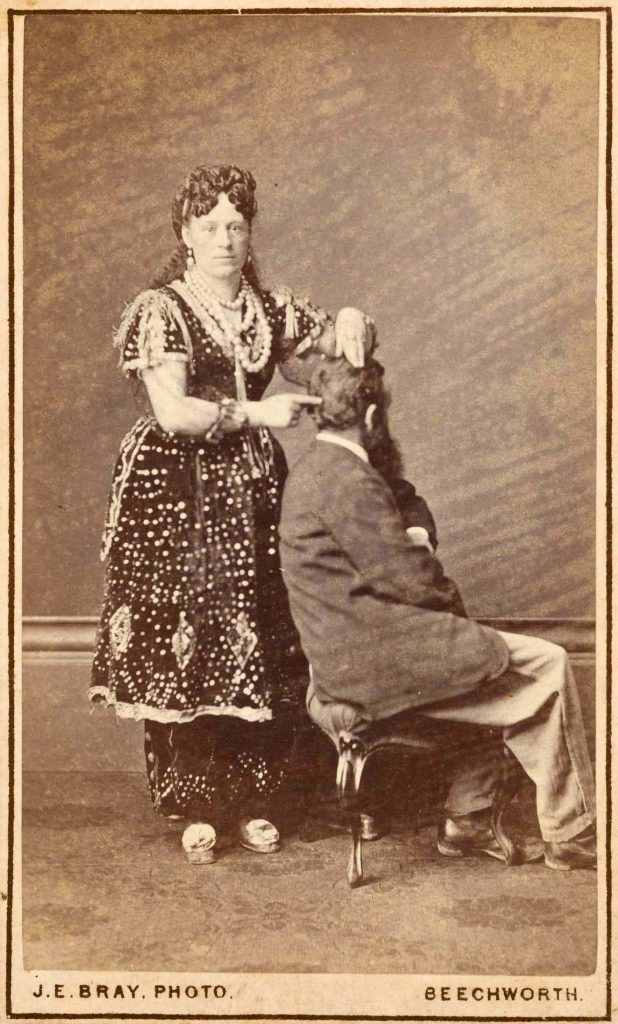
| Purportedly French-born, Silbey arrives in Sydney around 1867 and works as a clairvoyant, making her first stage appearances in 1868. By 1871 she is in Melbourne ‘manipulating heads’ for packed houses at Weston’s Opera House on Bourke Street. She tours throughout Australia where her shows incorporate séances, phrenological readings, hypnotism. Later she adds ‘baby exhibitions’ to her repertoire, in which prizes are awarded to the specimens with the best mental and physical capacity. By the mid-1880s she is performing with her daughter, ‘Zel the Magnetic Lady’, and advertising her range of remedies for conditions such as gout, rheumatism, and neuralgia. Having ‘retired from the platform’ she runs a store at Drake, near Tenterfield, where she dies in April 1894. |
1879

After Ellen Kelly’s three-year sentence of imprisonment with hard labour – for the attempted murder of Fitzpatrick – her friends and supporters gather outside the gates of Beechworth Gaol and, in violent protest, set fire to the gaol’s large timber front gates. They will be replaced with the iron gates still in use today (above). Upon her eventual release from Beechworth Gaol, 49-year-old Ellen returns to her home in Greta, celebrated with the (colourised) photograph below, taken at ‘The Kelly homestead’ in 1881.


35-year-old George Henry Billson leaves the brewery partnership with his 62-year-old father, George Billson Snr in Beechworth and moves to Albury, where he has purchased the former Colonial Porter Brewery near the Union Bridge from Richard O’Keeffe & Co. George Billson Jnr immediately spends more than £3,000 on improvements.

| The ‘G.H. Billson Albury Brewery’ will merge with the ‘Hume Brewery’ in 1888 to become the ‘Albury Brewing and Malting Company’ with George Billson Jnr chairman of directors. It will close in 1920. |
1879
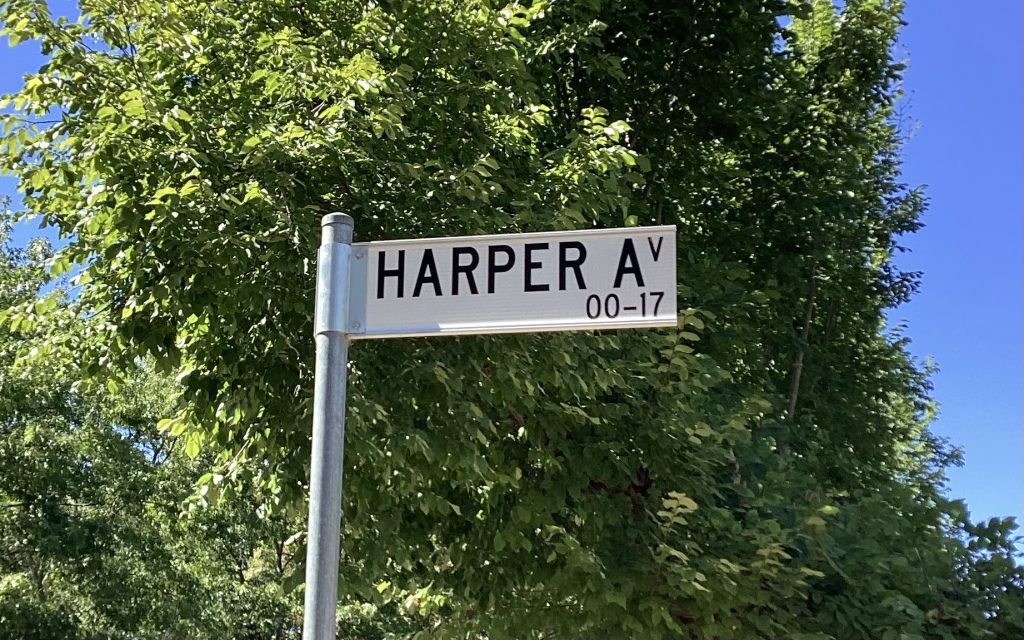
The Beechworth Gas Works are established on the corner of Albert Road and (what is now) Harper Avenue. It will provide citizens of the town with lighting, heating, cooking and other purposes for the next 70 years.
| Harper Avenue is named for Joseph Pearce Harper, Beechworth Councillor from 1914 to 1923 and again from 1929 to 1945. During this time he is twice Shire President. Born in Cornwall in 1861, Harper arrives in Beechworth in 1877 at the age of 16 where he is apprenticed to bootmaker William Darson. By 1905 he has established his own successful bootmaking business in town. Living for a number of years with his wife Johanna in Mellish Street – where they become well known for breeding poultry and winning numerous prizes at shows in the district as well as the Royal Melbourne Show – he will pass away on April 25th 1945 aged 83. |
1879
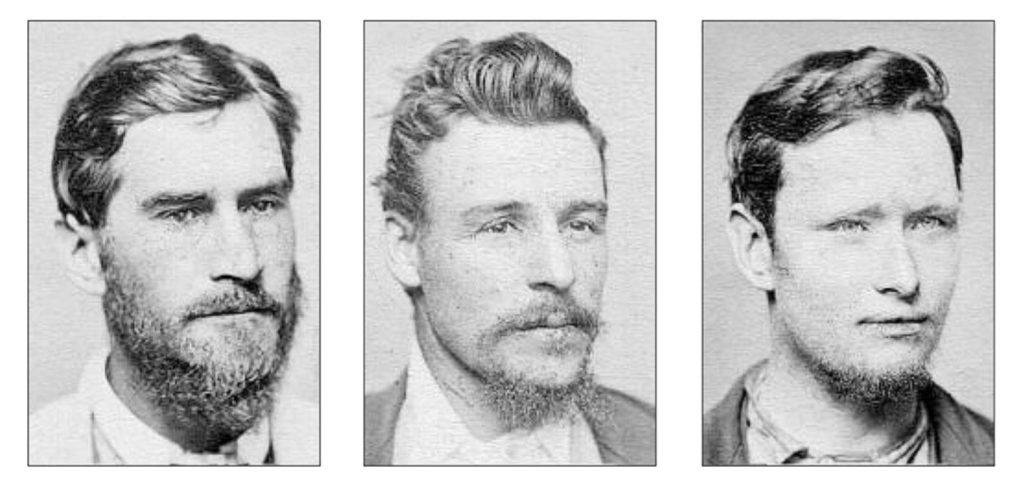
In an attempt to limit the support for Ned Kelly and his gang, twenty-three suspected ‘Kelly sympathisers’ are rounded up and held in the Beechworth Gaol – without trial or evidence – for over three months. This tactic by the Victorian Government and their authorities will alienate many law-abiding citizens of North-Eastern Victoria. Three of the men held in Beechworth Gaol are John Quinn, John Stewart, and Joseph Ryan (above).
1879 – Dec 26

A Fire Brigade ‘Hose and Reel’ competition between Beechworth and Chiltern is held on Ford Street in Beechworth with a large crowd lining the street to watch the two teams battle it out. The winner is unknown
1880
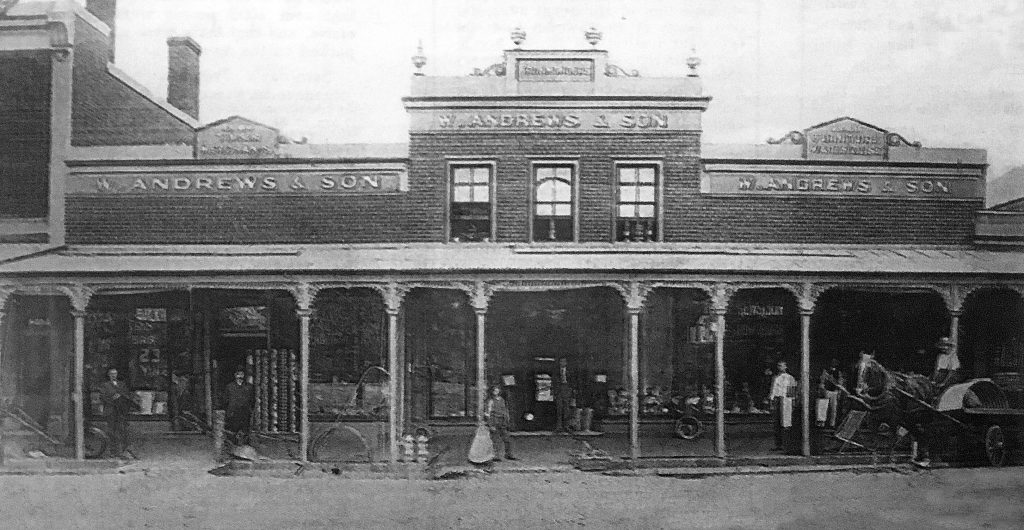
49-year-old William Frederick Andrews takes over the furnishing business of Forman and Co. (established in Beechworth in 1856) and rapidly grows the business – with his 22-year-old son William Andrews Jnr – as W. Andrews & Son on Ford Street. Supplying the districts of Beechworth, Rutherglen, Yackandandah, Bright, Harrietville, and even as far as Omeo, their travelling salesmen are always out, and their teams may be seen daily leaving their yards with goods for all parts of the North-eastern district.
| After arriving in Queensland in 1855 from Suffolk in England, qualified pharmacist 24-year-old William Frederick Andrews subsequently moves to Victoria and goes into business in Geelong as a chemist and druggist. He then obtains the position of warder at the ‘Beechworth Gaol’ and, while there, his teenage son William Jnr is apprenticed to the long-established Beechworth firm of ‘Forman & Co. Ironmongers’. Leaving his position at the ‘Beechworth Gaol’, William Andrews Snr will purchase the business from the Forman brothers and grow the company – which expands greatly during the dredging boom – in partnership with his son. William Andrews Snr, who dies in 1905 at the age of 75, is an esteemed member of the Beechworth lodge of the ’Oddfellows’. William Andrews Jnr will become a foundation member of both the ‘Beechworth Bowling Club’ and the ‘Beechworth Golf Club’ and will be a regular judge at the ‘Beechworth Racing Club” before passing away at the age of 66 in December 1924. |
1880 – Jun 3

One of the world’s greatest engineering feats in completed in Beechworth! At exactly 3.00pm, the directors of The Rocky Mountain Extended Gold Sluicing Company gather at one end of their newly completed tunnel and then commence the 25-minute walk through the engineering marvel, inspecting the sluice boxes which have been assembled along the entire length, emerging at the Albert Road end of the tunnel in time for the official “turning on of the water” at at 3.30pm. The half-mile long (800-metre tunnel) – which is big enough for a man to stand up in – extends under the township, to run water and sludge from the open-cut mining site into Reid’s Creek in the Gorge. The Rocky Mountain Tunnel has taken three years to complete, with 98,280 drills and 18 miles of fuse to fire the 32,760 dynamite blasts to bore holes. A total of 8,628 tons of stone are removed, no mean feat, as un-weathered granite is a very hard and difficult to mine. The tunnel ends up costing £14,600 and succeeds in draining the centre of Beechworth, which enables mining to continue. The tunnel is regarded as one of the greatest engineering feats in Australia and is reputed to have established world records for tunnelling in hard rock. It is claimed that mining would not have continued at Beechworth if it had not been for construction of the tunnel. (The tunnel is later used by Zwar Brothers Tannery.) Today the tunnel provides drainage for Lake Sambell and for the town.

| The construction of the tunnel also proves to be a rich source of gold itself, with some 6,500 ounces (184 kilograms) unearthed between 1876 and 1880. This can be compared to other contemporary gold mines yielding between 3,000 – 5,000 ounces (85 – 142 kilograms). By the late 1800s, one ounce of gold was worth the equivalent of a week’s wages! |
1880
It is estimated that nine hundred miles of water races have now been cut through soil and rock in the Beechworth district. Large water quantities are required for hydraulic sluicing, and the long water races and deep tailraces that are constructed are considered great engineering feats. This method of mining is extremely effective but causes significant environmental damage and impacts to waterways and agricultural operations. The extensive networks of races and dams in Beechworth are on a scale far greater than elsewhere in Victoria. Beechworth’s water barons continue to hold more than half of all the water right licences on issue and undertake sluicing operations on a massive scale.
1880 – Jun
Mrs Williamson announces in the press that she will be carrying on the business of her late husband William Williamson at the Star Lane Shoeing Forge in Beechworth, under the supervision of blacksmith Charles ‘Big Charlie’ Phillips.
1880 – Jun

Highbrow entertainment! At the Oddfellows’ Hall on Finch Street, the Beechworth Literary and Debating Association present 60-year-old ‘Professor’ John Pepper who fascinates Beechworth locals with his lectures on series of subjects including “Light and Optics” and the “Wonders of the Oxy-Hydrogen Microscope”. This is followed a few weeks later by Henry W. Mitchell’s lecture on Napoleon III, presenting “a graphic and faithful portrait of Napoleon III, tracing the romantic adventures of the ex-Emperor from his insane attempt at Strasburg to his death at Chislehurst. To be portrayed in vivid colours and delivered in a pleasing and graceful manner”.
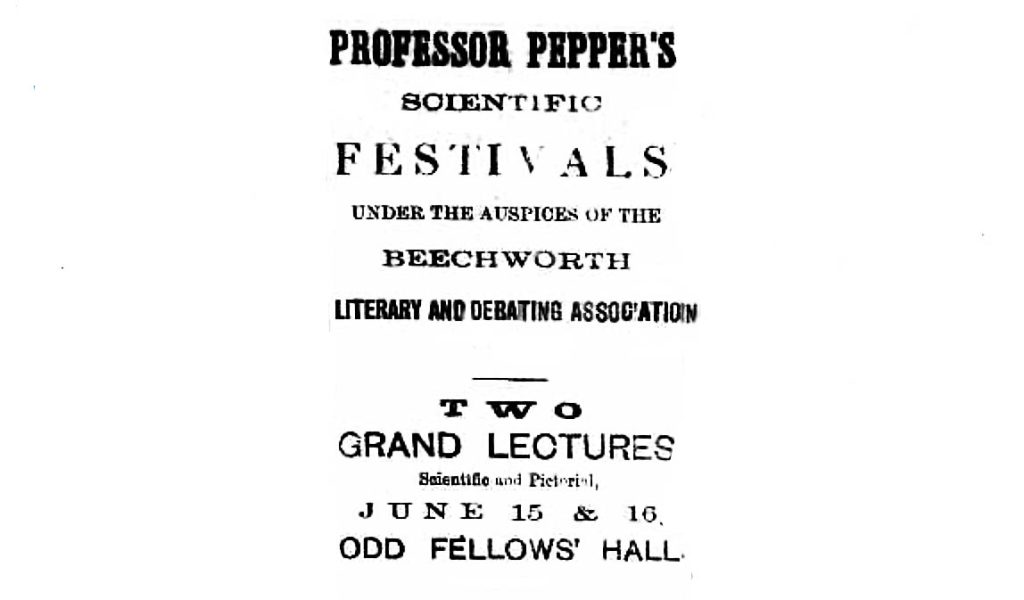
| John Henry “Professor” Pepper is a British scientist and inventor who tours the English-speaking world with his scientific demonstrations. He entertains the public, royalty, and fellow scientists with a wide range of technological innovations. He is primarily remembered for developing the projection technique known as ‘Pepper’s Ghost’, building a large-scale version of the concept by Henry Dircks. He also writes eleven important science education books, one of which is regarded as a significant step towards the understanding of continental drift. In Australia, Pepper also tries his hand as a playwright, producer and actor, staging a romantic drama called “Hermes and the Alchymist”. |
1880 – Jun 26
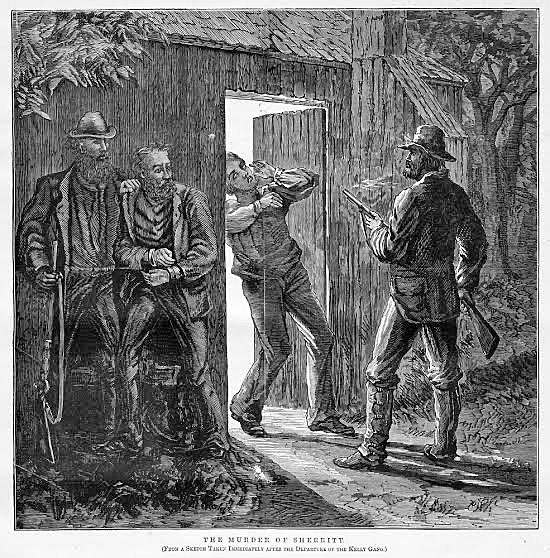
Aaron Sherritt is at home in the Woolshed Valley near Beechworth with his pregnant wife Ellen (better known as Belle), mother-in-law and four policemen (Constables Robert Alexander, Henry Armstrong, Thomas Dowling and William Duross) when he is shot dead by Joe Byrne.
| Sherritt’s pregnant wife Belle will miscarry her baby and all four constables will later be dishonourably discharged from the police force for cowardice. |
1880 – Jun 27

Ned Kelly and his gang bail up the town of Glenrowan.
1880 – Jun 28
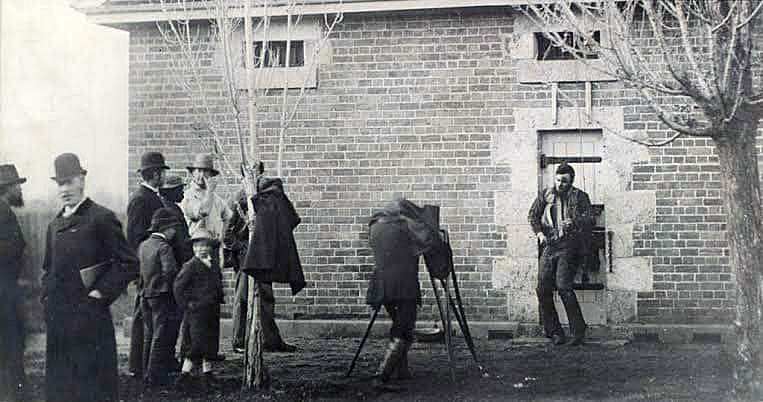
(Photo by J.W. Lindt)
A hastily arranged police train arrives at Glenrowan and a shoot out takes place. Dan Kelly, Joe Byrne and Steve Hart are killed, and Ned Kelly is captured – injured but alive.
1880
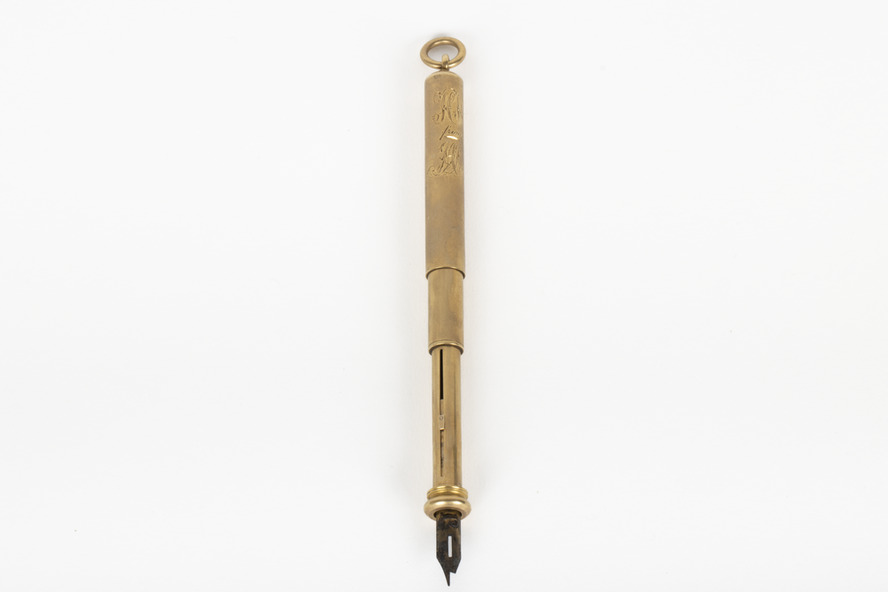
After graduating from Melbourne University with a Bachelor of Laws (with first class honours), 25-year-old Isaac Isaacs gifts a beautiful pen to his friend 34-year-old Henry Vandenberg, who will become a member of the United Shire of Beechworth Council from 1897-1923 and President from 1912-13. The hotel-owner-turned-dentist will create the popular Beechworth Brass Band in 1887, he also acts a justice of the peace, and receives the dubious honour of being voted the winner of the ‘Ugly Man Competition’ at the ‘Back to Beechworth’ celebrations in 1922! In his later years, Henry lives in the de-licensed Vine Hotel which had been run by his parents Jacob and Christina for many years.
1880
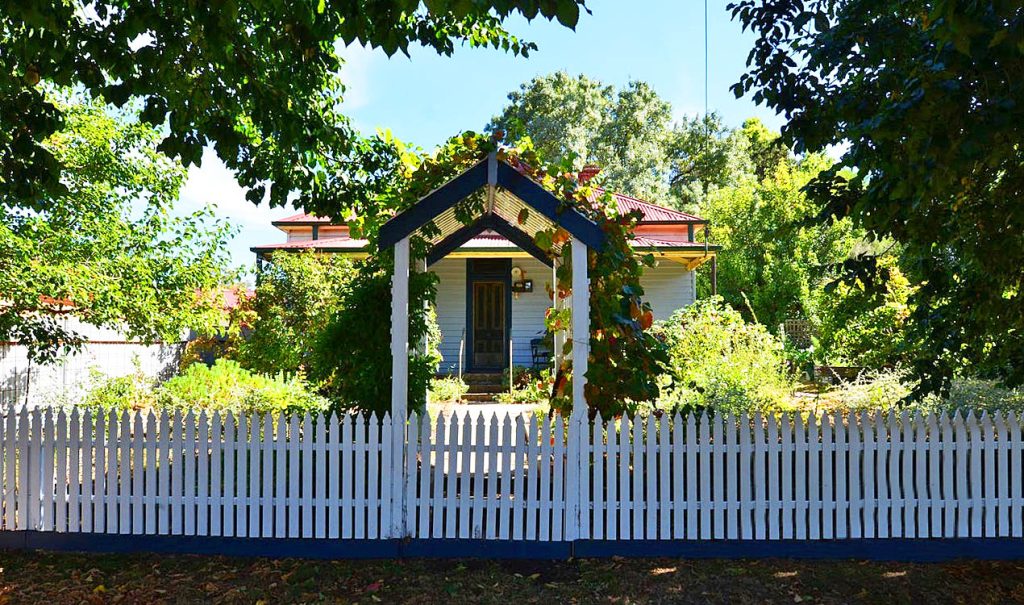
A small cottage is built at 16 Bridge Road in Newtown next door to the two-storey home Richmond House built in 1869 for Mark Straughair and John Laidley Duncan, the blacksmiths and farriers and owners of the Beechworth Foundry directly across the road.
1880

A Health Inspector finds the Beechworth Hospital for the Insane “much in want of extensive repairs” finding the sculleries and bathrooms in a “deplorable state” rendering them unusable. But he praises the Matron, Mrs Sharpe and her nurses for giving the female patients “an air of comfort by introducing curtains and antimacassars” (protective coverings for the backs of chairs and sofas) and finds the extensive 27-acre grounds in excellent order, full of well cultivated fruit trees and vegetable gardens.

1880 – Aug 6
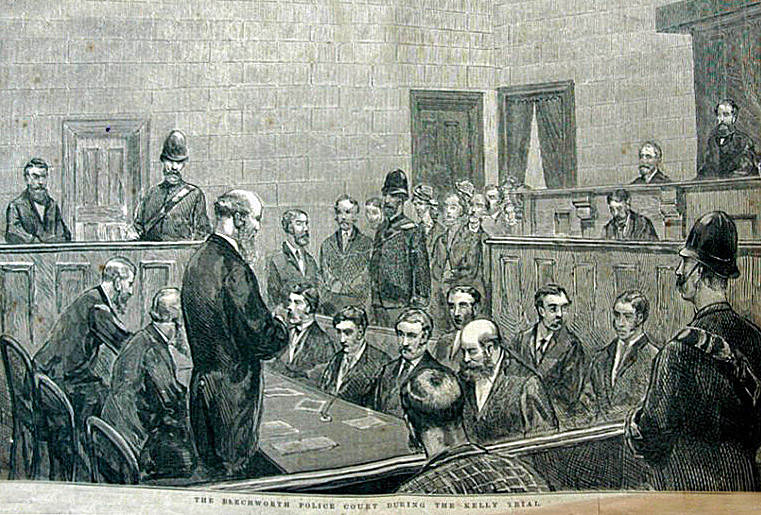
Ned Kelly is taken from the Beechworth Gaol, where he is being held, to the packed Beechworth Courthouse for the first day of his committal hearing, to determine what specific charges he should be committed to stand trial for. Appearing before Beechworth-born Judge William Henry Foster, Ned is represented by lawyer David Gauson. Ladies are given seats in the gallery to watch the proceedings while others pack into every corner of the public area of the Courthouse with members of the police in attendance to make sure that ‘nothing goes awry’. Also in court offering their support are Ned’s sister Maggie, along with Tom Lloyd, Dick Hart and other friends and supporters. Ned is charged by Constable McIntyre – the lone survivor of the Stringy Bark Creek shootings – with the “wilful murder of Thomas Lonigan at Stringybark Creek in the Northern Bailiwick of the Colony of Victoria on the 26th day of October 1878.” As the Victorian Government fears “a likelihood of intimidation of Beechworth jurors” before a murder trial (and, if found guilty, for reprisals), on September 14th the Crown applies for an order to transfer Ned Kelly’s murder trial from the Beechworth Circuit Court to the Central Criminal Court in Melbourne. The application is successful and Ned is transferred to the Melbourne Gaol to stand trial for murder.

| During his committal, Ned Kelly dictates a letter to his lawyer David Gausim in which he says (in part): ‘I do not pretend that I have led a blameless life or that one fault justifies another; but the public, judging a case like mine, should remember that the darkest life may have a bright side, and after the worst has been said against a man, he may, if he is beard, tell a story in his own rough way that will lead them to soften the harshness of their thoughts against him and find as many excuses for him as he would plead for himself.’ |
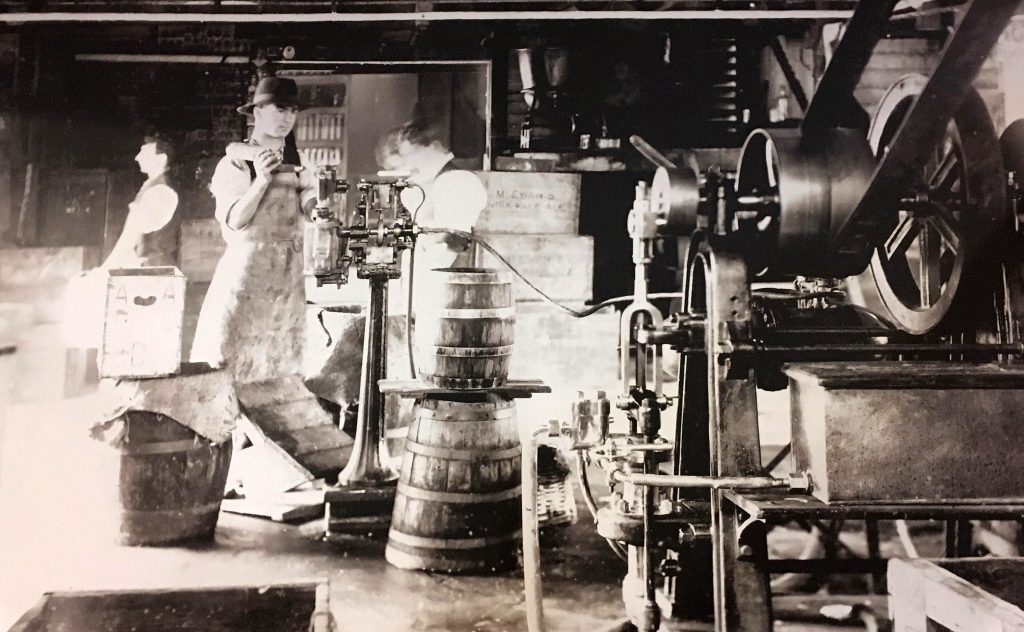
Billson’s Brewery add a range of wines and spirits to their expanding business.
1880
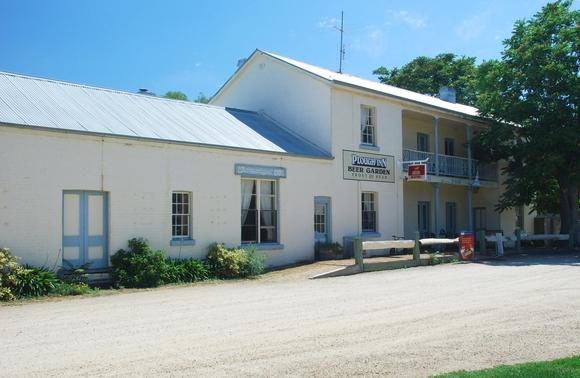
Hopton Nolan, owner of ‘The Plough Inn’ at Tarrawingee, adds a single-storey building adjoining the two-storey hotel to trade as a General Store.
1880

Hopton Nolan purchases ThomasTaylor Ladson’s grand two-storey brick residence across the laneway from The Plough Inn renaming the building Hopton Nolan Hall. It will, for a time, serve as Tarrawingee’s Town Hall. He will later reame the grand home Carinya (above left). All the buildings still stand today.
1880
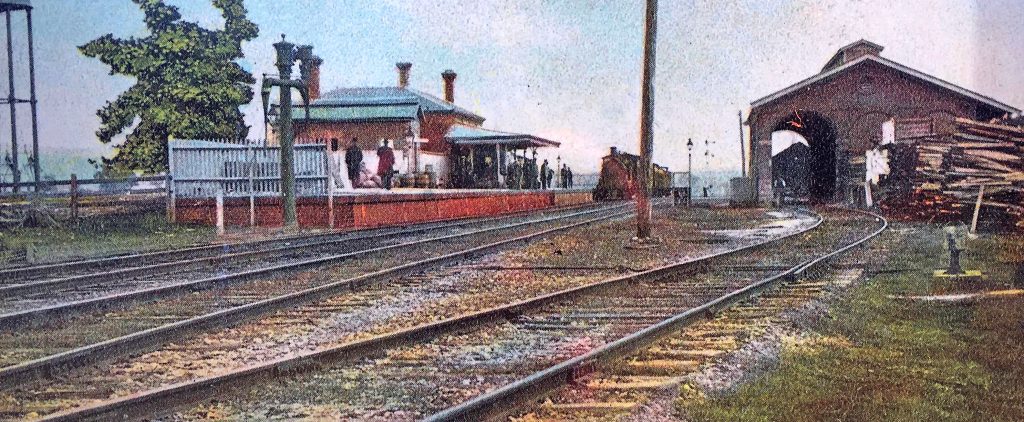
Railway traffic – both passenger and freight – between Melbourne and Wodonga continues to thrive. Just 25 km from Beechworth, the railway station at Chiltern, built in the early 1870s, is a popular stop.
1880

A red brick home is built at 40 Mellish Street. A big red Post Box stands outside the property today (below).

1880s

Despite the decline of the gold industry, Beechworth is sustained by the presence of the two main government institutions founded in the 1850s and 1860s – the Asylum and the Gaol. And as tourism slowly begins, the town’s new reputation as a health resort and picturesque beauty spot grows.
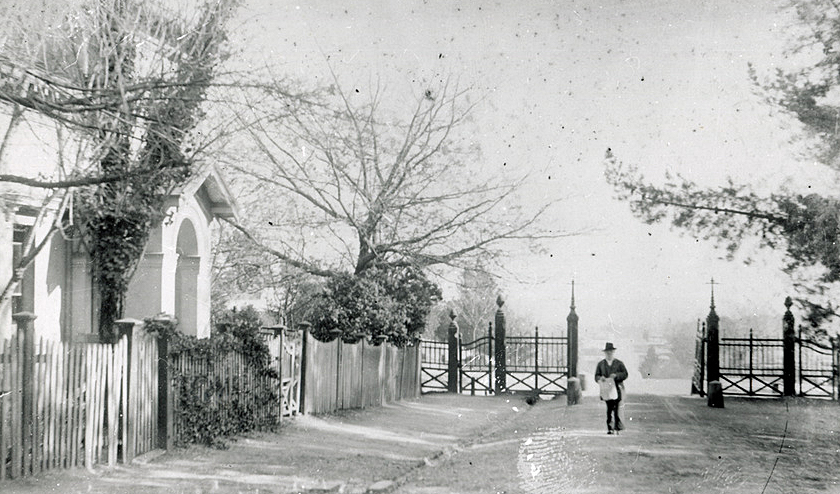
| The declining prosperity of the town has an upside – the post-World War II development that leads to the destruction of so much of Victoria’s nineteenth century fabric during the 1950s-70s is avoided. |
1880 – Nov 11
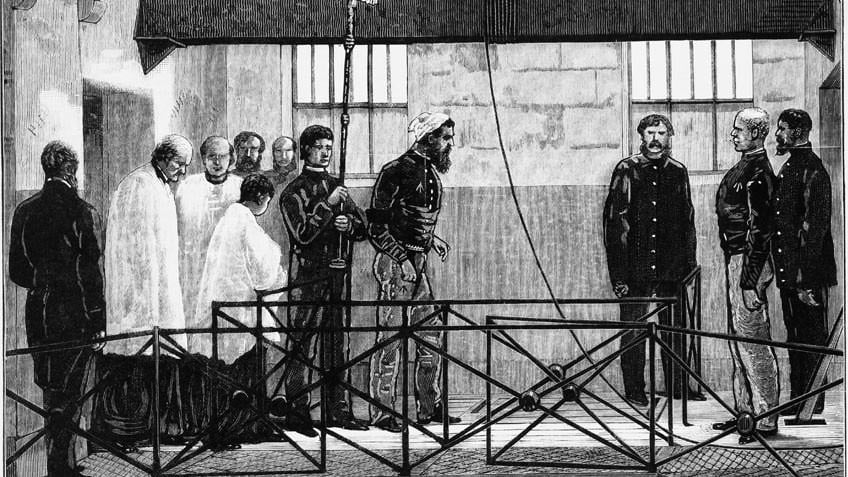
Just 13 days after being found guilty of (one charge of) murder in Melbourne (on October 29th) and sentenced to death by Judge Redmond Barry, 25-year-old Ned Kelly is hanged at the Old Melbourne Gaol in Russell Street. Overseeing the execution is Gaol Governor John Buckley Castieau, formerly the Governor of Beechworth Gaol (from March 1856 to December 1868). The sentencing judge, Redmond Barry (below), will die just 12 days later, on November 23rd, at the age of 67.

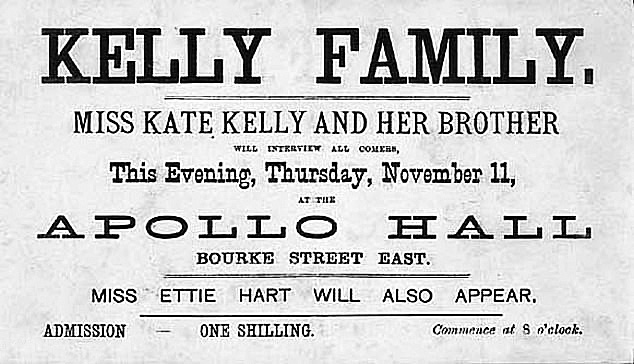
| Just hours after Ned Kelly’s execution, the bushranger’s brother and sister – 21-year-old James (Jim) Kelly and 17-year-old Kate Kelly – are ‘exhibited’ at Hiram Allen Crawford’s ‘Apollo Hall’ – which seats up to 1,000 people – within the Eastern Arcade in Melbourne. Appearing before an excited, curious and fascinated crowd (who have each paid the one shilling entry fee), Ned’s siblings – along with Ettie Hart, sister of Kelly Gang member Steve Hart – speak about the infamous bushranger’s exploits. There is a story that suggests Hiram Crawford’s daughter Emma (born in 1857) was good friends with Kate Kelly (born in 1863). |
1880 – Dec 26
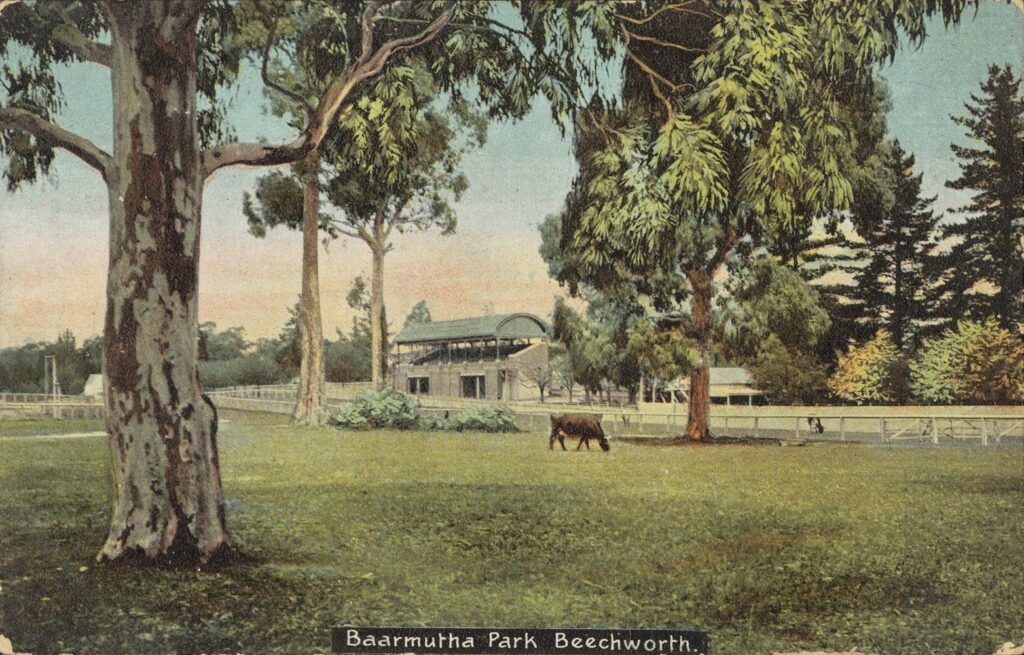
The Public Recreation Reserve is officially named Baarmutha Park and impressive cast iron entrance gates are installed. Baarmutha is the local aboriginal name for the area – “land of many creeks”.
| When official names are being discussed ahead of the 1880 Boxing Day Sports Carnival, the Editor of the ‘Ovens and Murray Advertiser’ writes, ‘What better, prettier or more appropriate title could it have than that of ‘Baarmutha Park’? The area had been noted as a popular place for Aboriginal corrobborees in the early years of Beechworth’s white settlement. It had a creek running nearby (no longer there, although large rocks and boulders and a small ravine remain) with a pretty spot nicknamed the “Emerald Cascades”. |
1881 – Dec
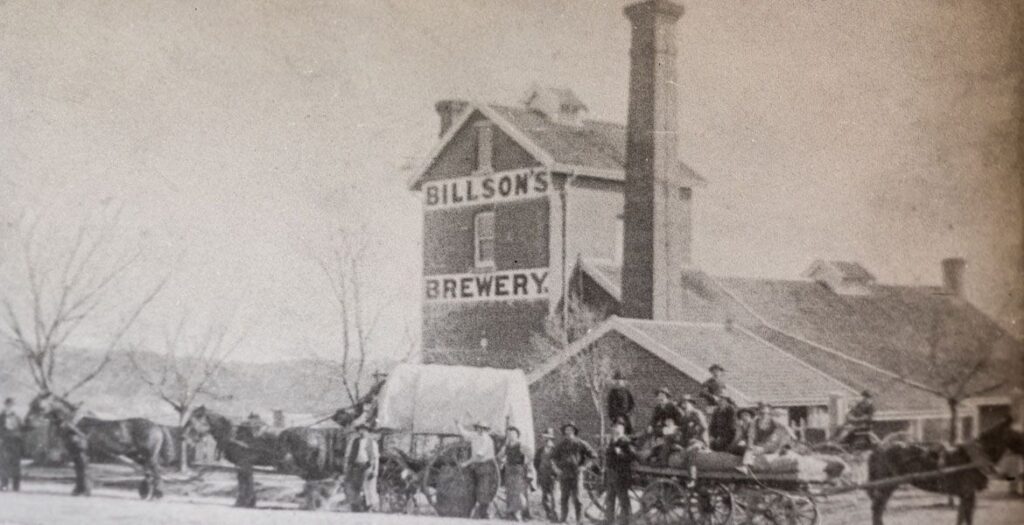
64-year-old George Billson Snr retires from Billson’s Brewery and appoints his 23-year-old son Alfred Arthur ‘Bosher’ Billson as his successor. Once he has taken over the popular Beechworth brewery – established by his father in 1865 – he steadily improves it under the new name of A. A. Billson & Co., and also trades as a wine and spirit merchant. The Billson soft-drinks and cordial factory also prospers and will open a branch at Tallangatta in 1885. In 1888, ‘Bosher’ will introduce his new specialty – Anglo-Australian Ale, which sells well throughout Victoria and New South Wales.
| The socially and politically oriented Alfred Arthur ‘Bosher’ Billson is educated at the ‘Beechworth Grammar School’ and then at ‘Scotch College’ in Melbourne. Alfred’s father, George Billson Snr will die of heart failure in Beechworth at the age of 69 on February 9th, 1886. He is survived by three sons – George Jnr, Walter and Alfred, and two daughters Clara and Emily. |
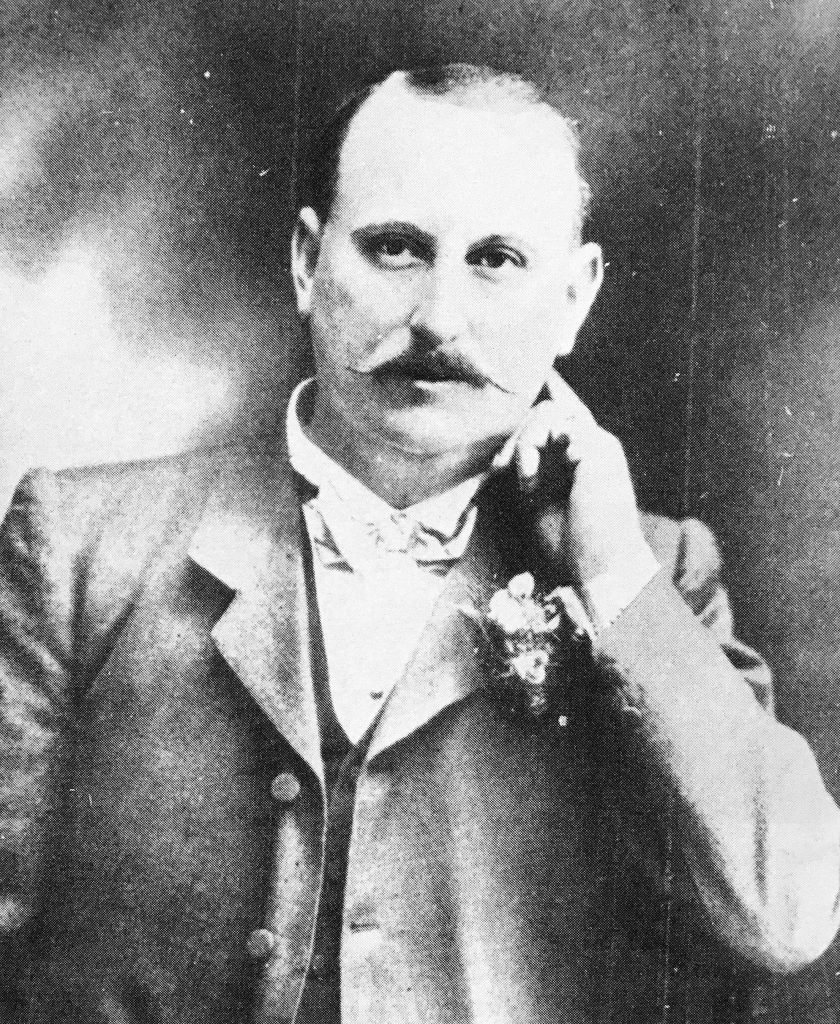
| Young Alfred ‘Bosher’ Billson takes advantage of the high quality of its water to produce aerated mineral waters, including soda water, potass water, and ‘Lithia Water’ which is laced with lithium salts. Billson’s ‘Lithia Water’ as advertised as “the most healthful mineral water produced in Australia.” Lithium is later demonstrated to have clinical efficacy in treating mood disorders in trials run by D John Cade, former superintendent of Beechworth’s May Day Hills Asylum. Billson also creates a distinctive and popular ‘herbal beer’ which he names ‘Ecks’. |
1881 – Dec
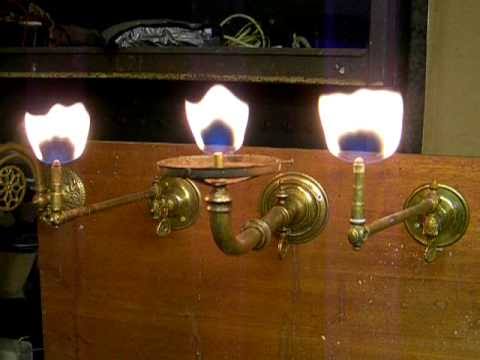
With much excitement, gaslight is officially trialled in Beechworth. The Christmas Eve ‘test run’ sees 150 burners lit with spectacular results, including a large ‘crown’ of gas lights decorating the front balcony of the Empire Hotel. More decorative lights are added over the next two days so that on Boxing Day night the town takes on a carnival atmosphere, with some of the other hotels decorated with gaslit ‘Maltese’ and ‘Brunswick’ crosses. Festive Christmas crowds gather to enjoy these displays which have been provided by the gas company to garner the interest of the local community. Gas meters will be turned on by New Years Eve, with the use of gas lighting now being charged. Beechworth’s first ‘gas plant’ is unusual in that it burns oil instead of (the more common) coal to create gas.
1882 – Jan

Gas lighting is turned on at the Beechworth Post and Telegraph Offices with the installation carried out by Mr J. S. Riddell of Melbourne. When the sixteen jets – cleverly placed in chandeliers and other fixtures – are lit, the effect is a fine one and the new illumination, owing to its brilliancy and convenience, has the effect of facilitating the work of the officers engaged in the building. A couple of handsome gas pendant lamps are also suspended in the portico in front of the Post Office, which “present a good appearance and will prove a benefit to persons having occasion to post letters at night”. In connection with the office, “we would urge the desirability of the extension of the existing accommodation, which is found to be inadequate to requirements in the transaction of public business, by the addition of a new wing facing Ford-street, provision for the erection of which was made in the original specifications, as is evidenced by the unfinished appearance presented by the building in that street”.
1882 – Feb 1
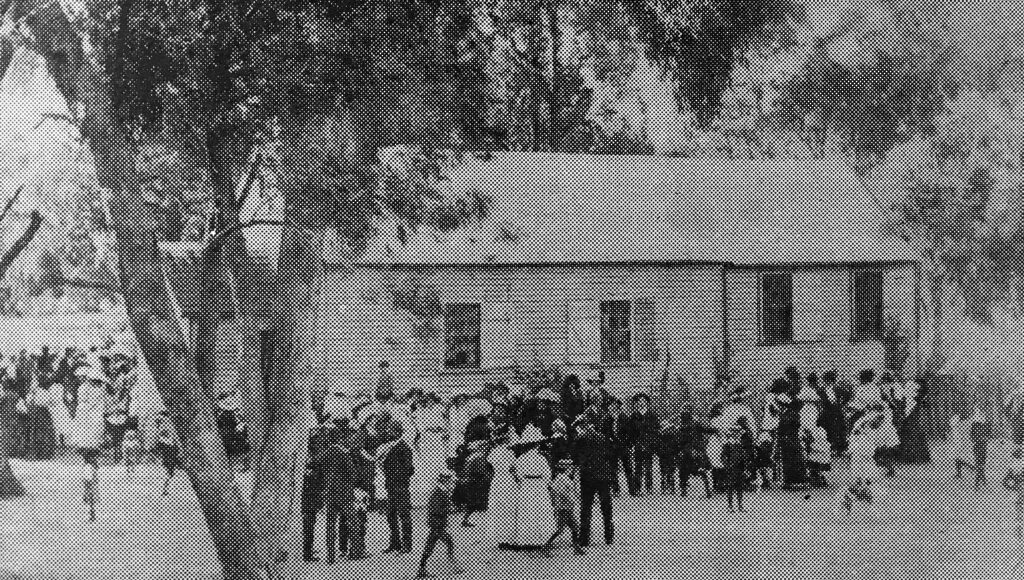
3km east of Beechworth on the road to Stanley, the Silver Creek School No. 2438 opens near the tiny Silver Creek Post Office.

1882 – Mar

The Beechworth Pottery Company is a formed with James Plumridge appointed the pottery’s working Manager. Based at Hurdle Flat, the first full kiln is fired in December 1882, and the teapots, flowerpots, ornamental vases, milk pans, jugs and drainpipes, all turn out satisfactorily. However, when the second firing in February 1883 results in the larger items breaking and cracking in the process, Plumridge blames the problem on moisture in the kiln walls and leaves the company in June 1883, moving to the Albury Pottery Works. The Beechworth Pottery Company ceases operation in December 1883 but is re-established in 1886 by John Hambleton, George Lindop and Benjamin Eastwood. Lindop and Eastwood are experienced Staffordshire Potters. The revived H.L. & E. Pottery Beechworth Company is successful and demand for their wares increases but, limited resources, staff and capital prevents any expansion. In 1888 Beechworth businessmen Alfred ‘Alf’ William Foster and Joseph Wilson buy out H.L. & E. Pottery Beechworth and rename it the Ovens Pottery Company Ltd.

| Backgound information – After a large source of clay is discovered during the gold rush at Hurdle Flat south-east of Beechworth, it is found to be suitable for earthenware and stoneware pottery so in 1876 several samples of clay are sent to James Plumridge of the ‘Pioneer Pottery Works’ in Ballarat. Plumridge completes a course of trials and is satisfied it could produce quality pottery. In January 1877 Plumridge travels to Beechworth to present lectures about ‘Ancient & Modern Pottery’ in Beechworth and Stanley, bringing examples of completed pottery from the Hurdle Flat samples he’d been sent. |
1882

Now aged 50, Hiram Allen Crawford relinquishes the active management of his highly successful Beechworth coaching business and purchases a 200-acre property on the Ovens River, near Everton, that he names ‘Brookfield’. In this new sphere, his predominant characteristics assert themselves, as he soon becomes one of the largest growers of hops in the Victoria and will eventually possess the largest lemon orchard in Australia! After holding ‘Brookfield’ for 20 years, 70-year-old Crawford sells out to Mr. D. J Whitteker, J.P, and retires to Elsternwick, near Melbourne. The majority of men, who had attained the allotted span of life, would be content to pass the remainder of their existence in leisured ease, but Hiram Crawford is not one of them … he purchases a growing number of large properties in and around Elsternwick and, in their enthusiastic management and development, finds an outlet for his activities. Hiram Allen Crawford will pass away in 1916 aged 84 and, in accordance with his wishes, his remains are brought to Beechworth for interment where a large number of townspeople attend the funeral as a last tribute of respect to one who had done so much for Beechworth. Four employees of ‘Crawford and Co’. will act as pallbearers.
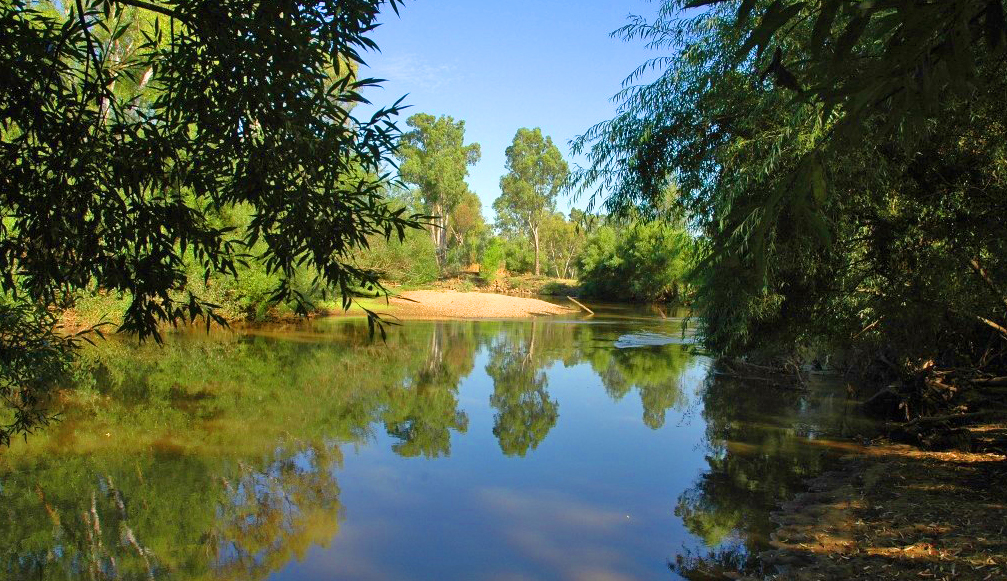
| On several occasions Hiram Crawford fills the Mayoral and Presidential chairs of Beechworth, is a member of the ‘Beechworth Municipal Council’ soon after its formation, twice Mayor Chiltern, Superintendent of the ‘Beechworth Fire Brigade’, a member of the ‘Country Fire Brigades’ Board’ since its inception, and a prominent member of the ‘Masonic Order’. He is appointed a Justice of the Peace in the 1860s by the Bindon Government; is a director of the ‘Sons of Freedom’ mine in Chiltern (the first limited company in the district); and is, for 20 years, both Chairman and Director of the ‘Beechworth Gas Company’. He is also a member of the committee of the ‘Ovens District Hospital’. Crawford returns home to the United States several times and, using his acquired wealth, will visit many other countries. |
1882 – May

42-year-old Alfred William Ladson opens his new purpose-built grocery store at 30 High Street, right opposite the beautiful Ladson family home ‘Magnolia’. Ladson’s Cash Grocery Store will become quite a landmark on High Street where the locals call the shop simply ‘Ladsons’. It will later become known as ‘Ennals’.
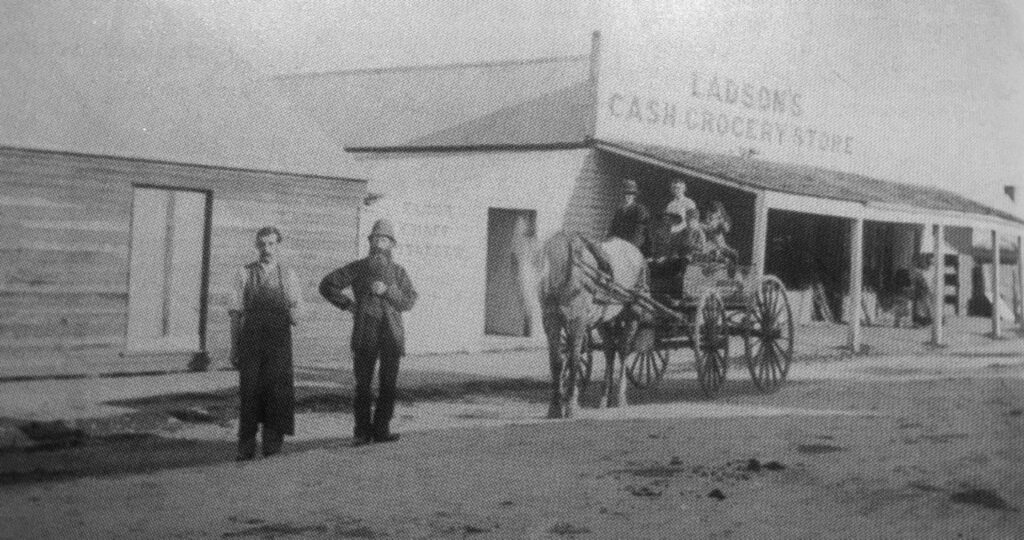
| ‘Ladson’s Grocery Store’ will remain in the family for over 100 years. Alfred’s son Arthur Ladson takes over, then Beatrice Ennals (mother-in-law of Dick Galbraith, Alfred’s grandson), then Dick Galbraith after his mother-in-law relinquishes the business before Dick passes it to his son Bob Galbraith. It is finally sold and becomes the ‘Beechworth Machinery’ store, which still operates today. |
1883

Norman Lawrence (above) – the manager of the Beechworth branch of the Oriental Bank at 97 Ford Street – marries Emma Blanche Debby (below). Lawrence will remain as the Beechworth branch manager until the worldwide collapse of the Oriental Bank in 1884 and the Beechworth branch closes.

1883 – Mar 21
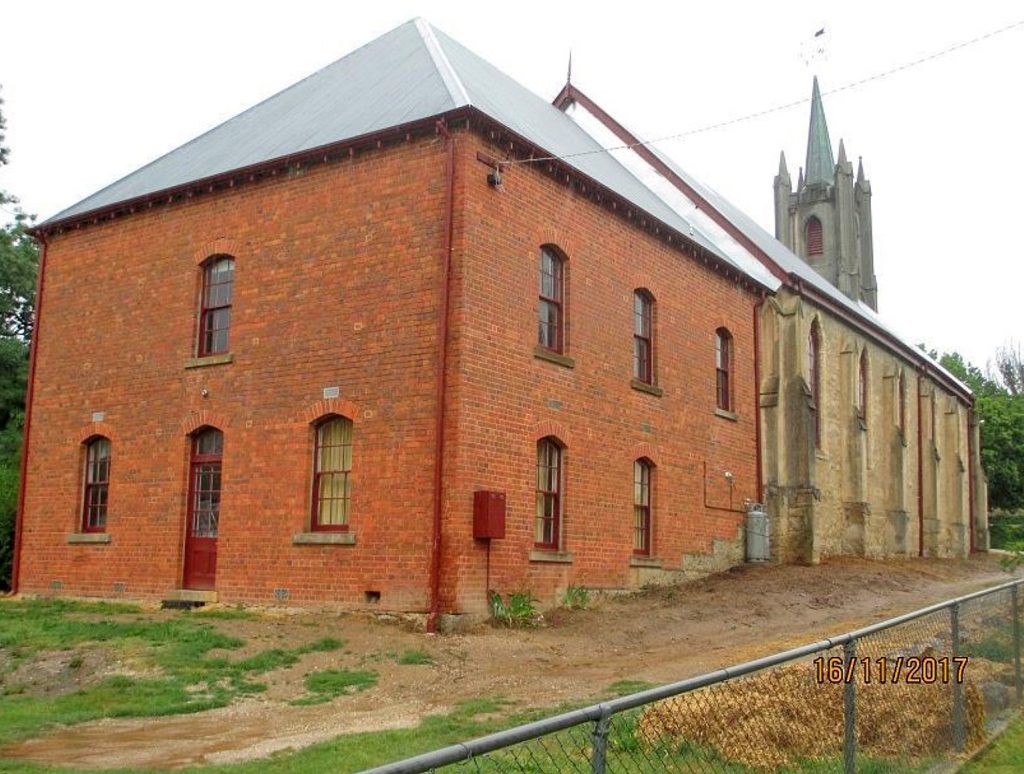
The Reverend John Gordon Mackie (below) lays the Foundation Stone for a new ‘Sabbath School’, to be constructed of exposed brick at the rear of the 1857-built St. Andrews Presbyterian Church on the corner of Ford and William Streets. The two-storey addition to the church will be completed by July 17th the same year.

| A regular Sunday School has been held inside at St. Andrews Church since it opened at the start of 1858, with 177 children enrolled by 1869. As the numbers continue to grow, it motivates the need for the new two-storey building. The ‘Beechworth Toy Library’ now occupies most of the downstairs part of the building while the upstarirs section is now used as the church’s hall. |
1883

A ‘Chinese Ward’ is added to the Ovens Goldfields Hospital on Church Street. The local Chinese community made generous donations to the original appeal to build the hospital in 1856 and, since opening in 1857, the hospital has treated many of Beechworth’s Chinese population and, in return, continue ro recieve numerous donations and gifts from them.
| The ‘Beechworth Carnival Committee’ gifts five banners to Beechworth’s Chinese community in recognition of their support of the ‘Oven Goldfields Hospital’ and the ‘Benevolent Asylum’. The banners have been purchased in China by a social envoy from Beechworth, then presented to the Chinese community during the ‘Beechworth Fine Arts Exhibition’ in May 1875 by Donald Fiddes, President of the ‘Ovens Goldfields Hospital’. |
1883
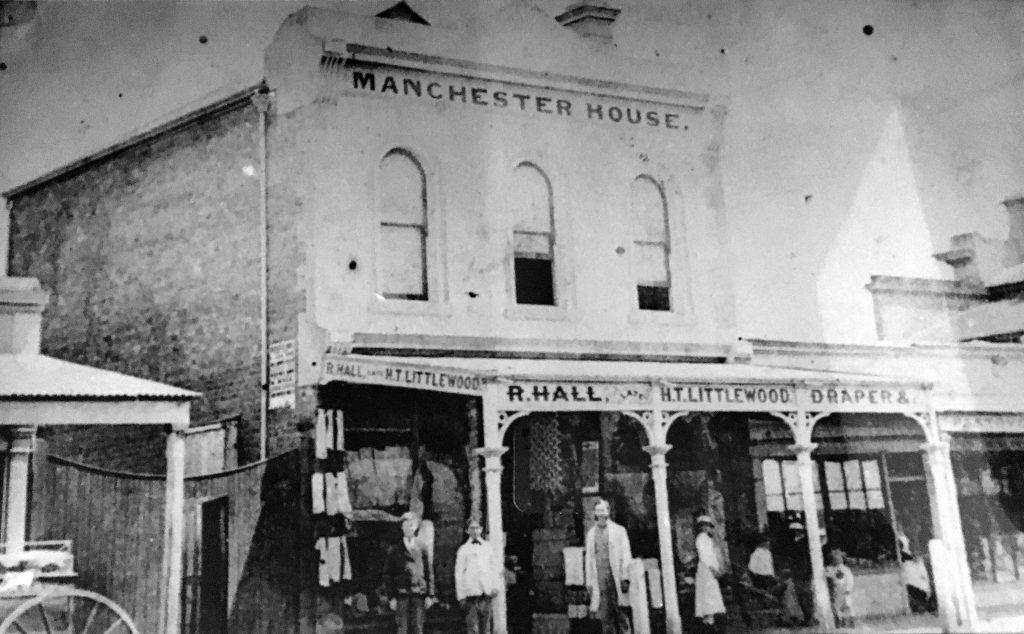
Manchester House is now trading from a new building on Camp Street with R. Hall joining Henry Thomas Littlewood in running the successful drapery business. A popular pastry shop operates next door.
| The building stills stands on Camp Street today (below left), now one of the buildings of the popular ‘Beechworth Bakery’. |

1883
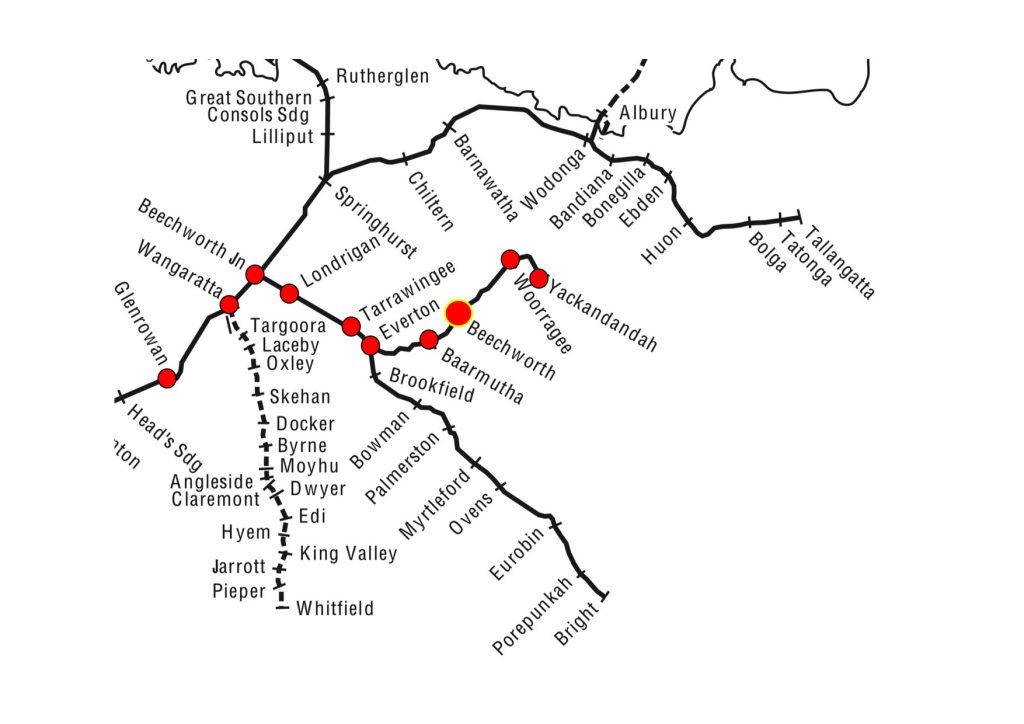
A railway line is completed which finally links Wodonga to Albury, meaning that rail passengers can now travel between Melbourne and Sydney.
1883 – Dec 17

Victorian Railways completes a new branch line from Everton to Myrtleford. Travelling through the Ovens Valley, it will be extended to Bright in 1890 with the Bright Railway Station opening on October 17th. This line becomes popular with tourists visiting Mount Buffalo where Victorian Railways operate the Mount Buffalo Chalet.
| The branch line between Myrtleford and Bright closes on 30 November 1983 and back to the junction with the North-East Railway Line at Bowser on 13 April 1987. In the 1990s the line becomes part of the ‘Murray to Mountain Rail Trail’ and Bright Railway Station is maintained as a railway museum. |
1883 – Dec 31
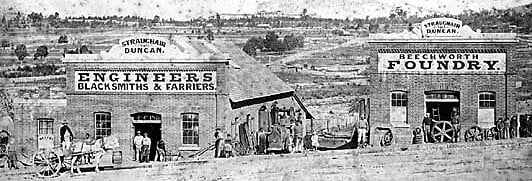
A fire breaks out at the Beechworth Foundry on Main Street, Newtown. Owners John Laidley Duncan and Mark Straughair will suffer £1,000 damage.
1884
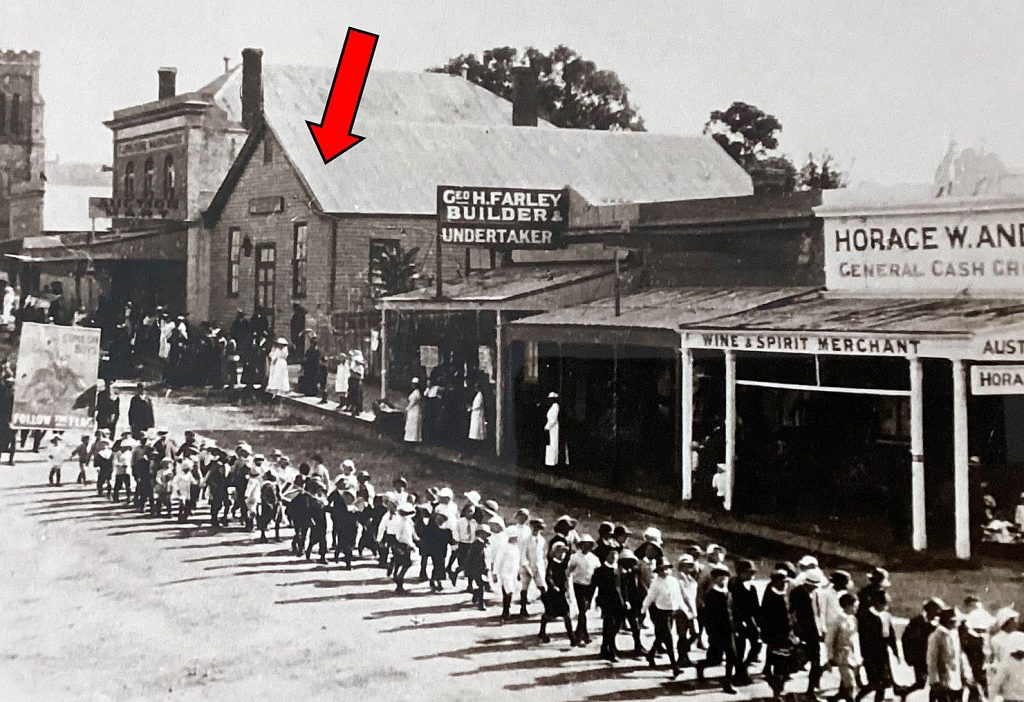
Just four years after the officially recognised start of the Salvation Army in Australia, the Salvation Army holds its first open-air meetings in Beechworth led by Captain Phillips and Captain John Dean with hundreds gathering to hear the Captain’s preach. The first Salvation Army Hall (a solid brick ‘Citadel’) opens on the present site at 35 Ford Street on September 28th 1885 with separate barracks built the following year. Officers in 1885 are Captain Reuben Edwards and Captain Samuel Fraser, before Captain Twyford takes over in 1886.
| The Salvation Army’s “exuberance” in the late 1880s is curbed after receiving complaints from nearby residents and the shire council bans marches Sundays and after 9pm on weeknights! |
| After the original ‘Salvation Army’ brick ‘Citadel’ is destroyed by fire, the current Citadel is erected in 1920. |
1884 – Apr 24

Eleanor Griggs Hollaway, licensee of the recently opened The Gap Hotel, transfers the licence to Frederick Hahn. The hotel sits at the top of the Buckland Gap – the road between Beechworth and Myrtleford – almost opposite Fighting Gully Road and services the nearby goldminers of the Three Mile District which had included Eleanor’s recently deceased husband, the popular ‘Three Mile’ goldminer John Hollaway.
| In December 1886 Frederick Hahn will rename ‘The Gap Hotel’ to ‘The Royal Oak Hotel’ and the name and hotel remain until it is destroyed by fire in 1958. |
1884 – May
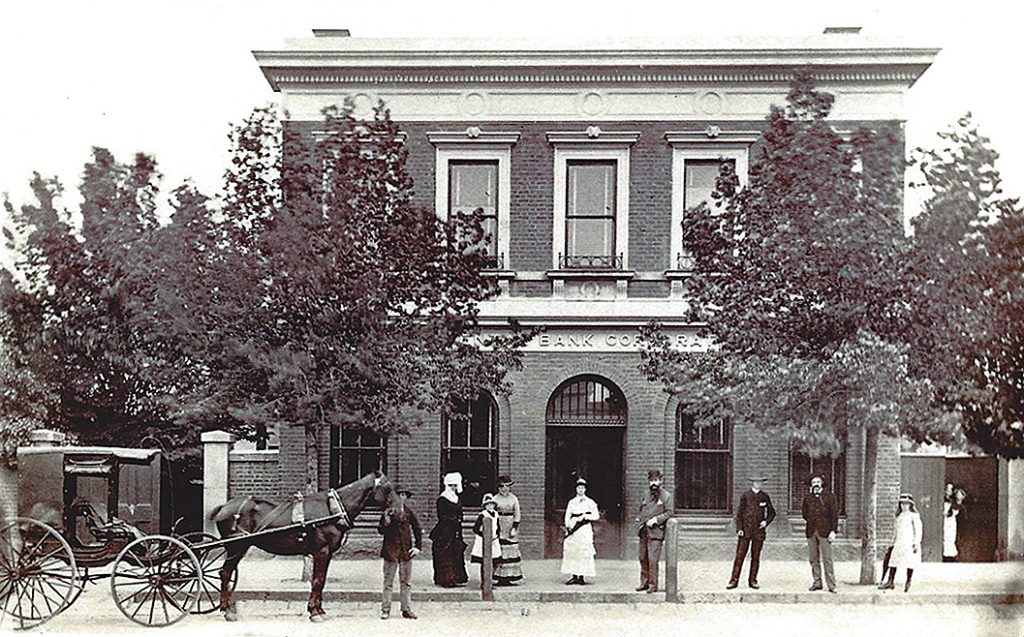
The once lucrative Oriental Bank – which opened its Beechworth branch in 1857 – closes on Ford Street after the entire London-based bank faces a financial collapse worldwide.
| Originally established in Bombay, India in 1842 as the ‘Bank of Western India’, it moves its headquarters to London in 1845. After opening branches in Colombo, Calcutta, Shanghai, Canton, Singapore and Hong Kong, it acquires the failing ‘Bank of Ceylon’ in 1850 and obtains a Royal Charter for the merged institution under the name ‘Oriental Bank Corporation’. By the 1860s it has opened branches in Australia and holds a dominant position, particularly in India and China and is considered the “most powerful, oldest, and most prestigious Eastern exchange bank” and “the doyen of Eastern exchange banking.” However, from the 1870s, the bank’s finances suffer from bad loans to coffee plantations in Ceylon (now Sri Lanka) and to sugar plantations in Mauritius, and on May 4th 1884 the ‘Oriental Bank’ – including the branch in Beechworth – suspends all payments and is subsequently liquidated. |
1884 – Jul 15

57-year-old Sir Henry Brougham Loch arrives in Melbourne with his wife Elizabeth to take up his appointment as the new Governor of Victoria. He will quickly become one of Victoria’s most popular and respected governors and will visit Beechworth for a holiday in March 1885 (see entry below). Loch had been to Victoria before – for a few months between 1852 and 1853 – when he was a decorated army captain, and Loch Street in Beechworth had been named in his honour at the time.
| Loch has a long and distinguished career in the British military, serving in the Crimean War and in China. In 1863, after marrying the well-connected Elizabeth Villiers, he is appointed Lieutenant-Governor of the Isle of Man, a self-governing British Crown Dependency in the Irish Sea, between Great Britain and Ireland. He will hold this position for the next 19 years, before being appointed Governor of Victoria. |
1884
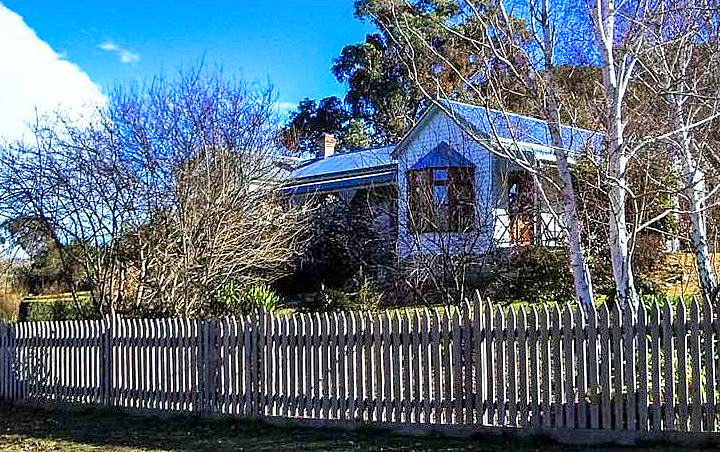
Successful Beechworth butcher 60-year-old George Newton purchases the property known as ‘Beaumaris’ at 11 Weir Lane from American miner and blacksmith Partrick Ring. In 1890 Newton will add a bullnose verandah and timber fretwork to the cottage and will go on to live at the house until his death, aged almost 80, in 1903.
| Patrick’s brother James Ring had died as result of being burned in a fire at the house at Christmas 1867. |
1884
John Clements Snr dies, and his 29-year-old Beechworth-born son John Nichols Clements takes over his father’s popular store on High Street, having previously been running the Newtown Hotel. John Nichols Clements, who builds a large family home on the corner of Loch and Kars Streets, continues running (and enlarging and improving) the Clements Store until his death in 1907, aged just 51.
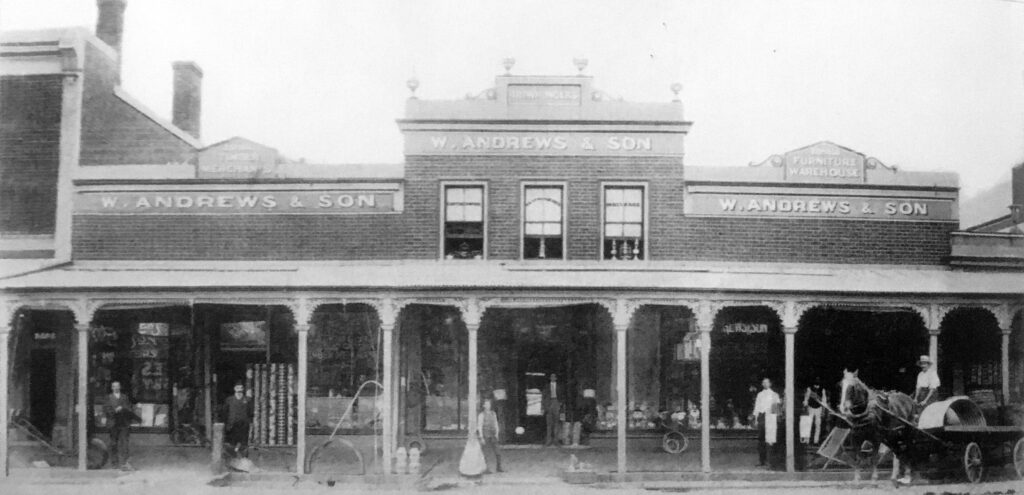
| In the early 1900s, John Nichols Clements eldest son, 30-year-old John James Alfred Arthur Clements Jnr, establishes his own ‘Cash Grocery’ store on Ford Street. Upon his father’s death in 1907 he merges the ‘Cash Grocery’ business with his late father’s High Street ‘Clements Store’. In his early teens, John James Alfred Arthur Clements (known as J.A. Clements) had worked at ‘W. Andrews and Son Merchants’ on Ford Street and will eventually purchase the large ‘Andrew and Son’ store (above) and move all the ‘Clements Store’ business there and run the store (below) until his death in 1943. |
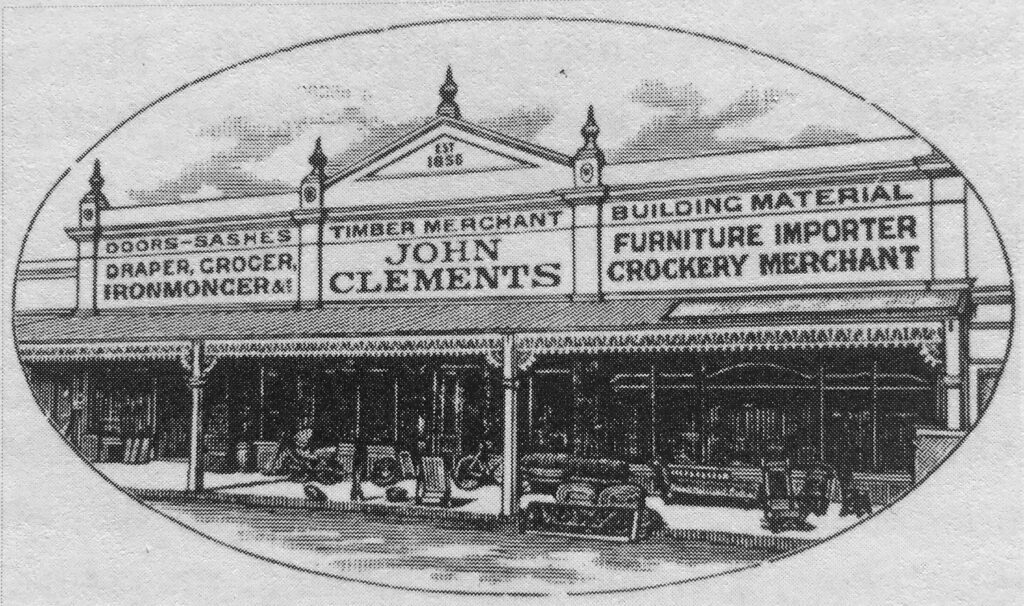
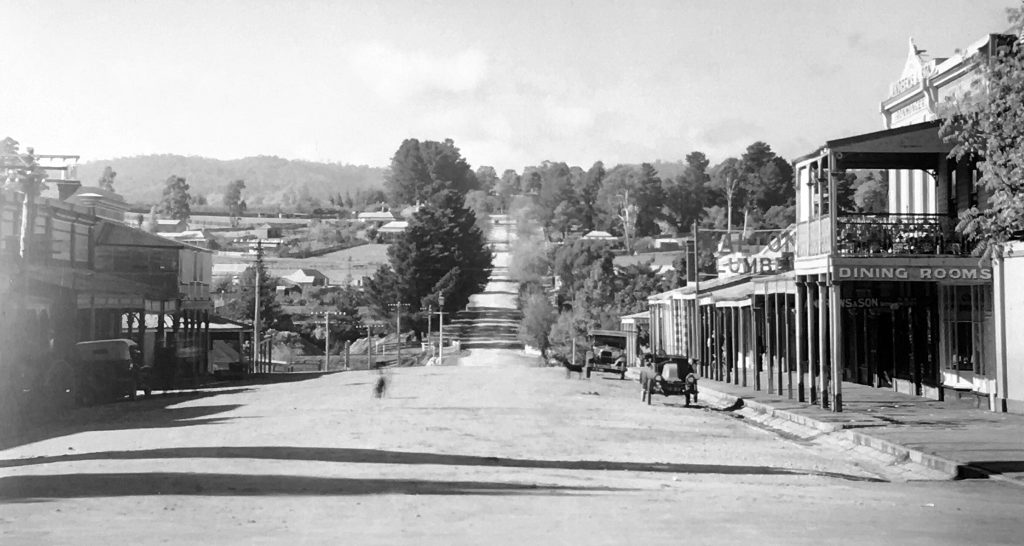
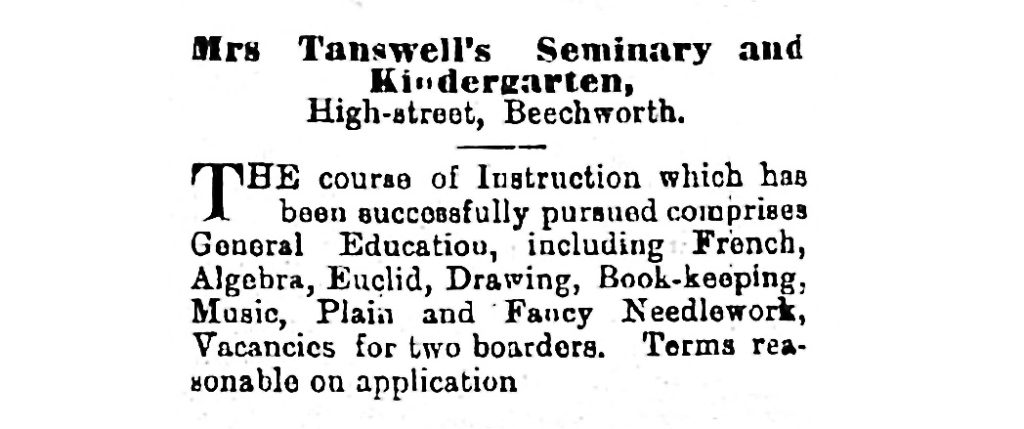
32-year-old Thomas Tanswell Jnr and his new 20-year-old wife Margaret Ann (McGowan) Tanswell establish a new school in Beechworth, operating from the former Freemasons’ Arms Hotel building on High Street (which had been purchased by Thomas Tanswell Snr in 1870). It operates successfully in Beechworth for almost twenty years as ‘Mrs Tanswell’s Seminary and Kindergarten’. But tragedy lies ahead (see below).
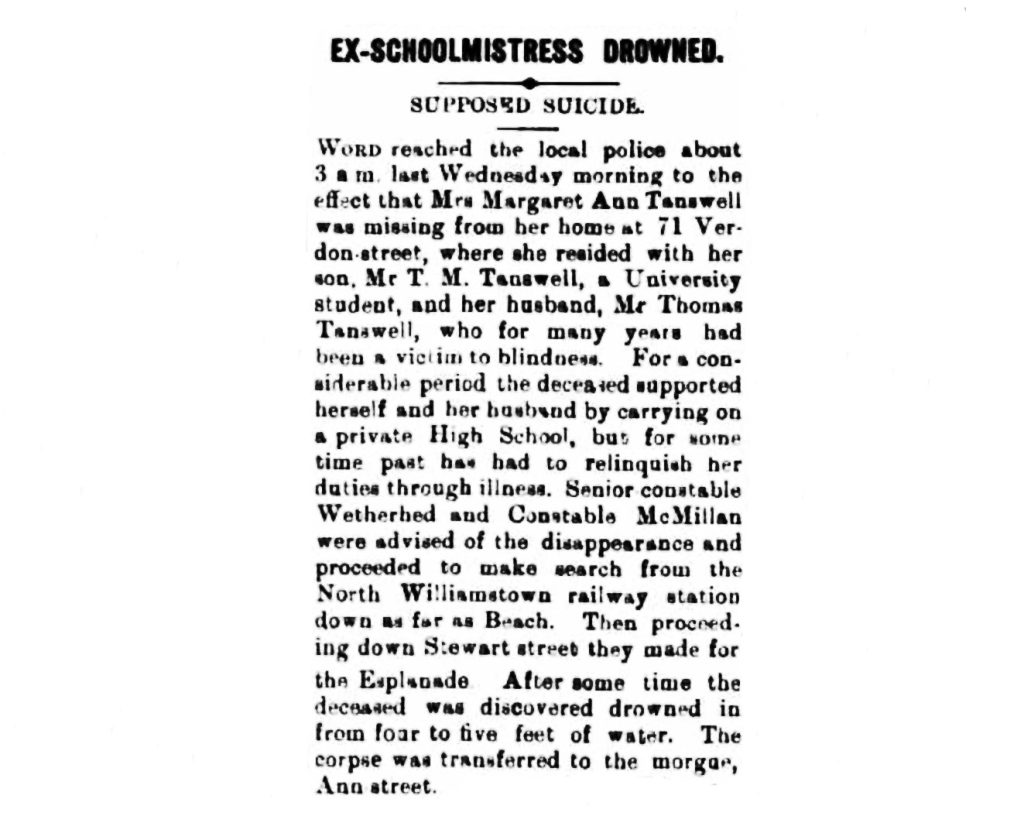
| At the turn of the century, with his eyesight failing badly, Thomas Jnr will move to Williamstown near Melbourne with Margaret and their surviving son Thomas Morrin Tanswell. Margaret will establish a Private High School for Girls in Williamstown but then her mental health starts to deteriorate. In September 2010, Margaret unaccountably disappears from the Tanswell home and, due to her mental condition, fears are entertained for her safety. The police will find her body while searching the waters at Williamstown’s Back Beach. She has taken her own life at the age of 45, leaving her now almost completely blind husband and her son Thomas Morrin Tanswell who has just started studying at university. |
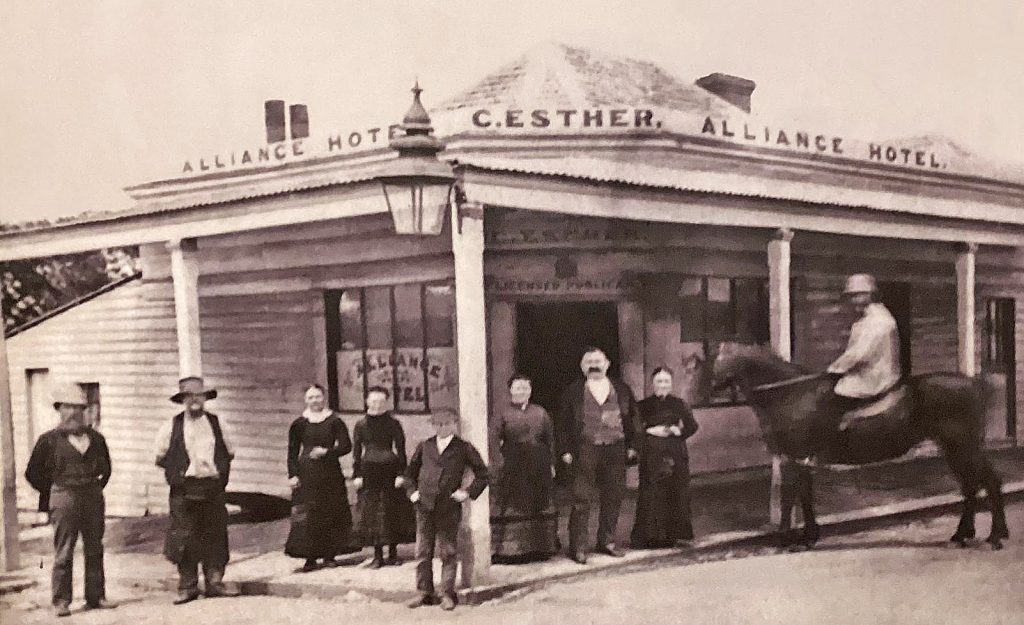
Billson’s Brewery employee (and American Civil War veteran) 37-year-old Jacob Hoffmann marries 23-year-old Sophie Esther at the Alliance Hotel, which is run by Sophie’s father, 53-year-old German-born Carl Esther. Jacob and Esther will go on to have seven children, including Carl, Friedrich (killed in WW1), Anna, Hilda, Cyril and Alfred Francis Hoffmann, who will be one of the founders of the Beechworth RSL in 1921. Sophie Hoffmann dies in 1902, and Jacob Hoffmann (who had been born in Bavaria before moving to America as a small child) passes away on October 12, 1920. Both are buried at the Beechworth Cemetery.
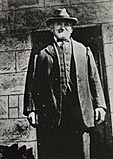
| Just a year after Sophie Esther’s wedding to Jacob Hoffmann, her father Carl Esther will die suddenly at the ‘Alliance Hotel’ (in September 1886 aged just 54). The hotel’s licence is taken up by Miss Elizabth Williams, its first female licensee. She will soon marry Edward Ryan and on March 7, 1887 she’ll transfer the hotel’s licence to him and successfully apply to have the name of the hotel changed to the ‘Railway Hotel’ as it is the closest hotel to the ‘Beechworth Railway Station’ since trains first arrived in town on July 13, 1876. |
1885
The Reverend George Frederick Cross is appointed Beechworth’s Church of England vicar. He will stay in the role until 1893. His wife is writer Ada Cross although, because of her position as a vicar’s wife, she is forced to keep her literary activities a secret, having her works published under her maiden name of Ada Cambridge.
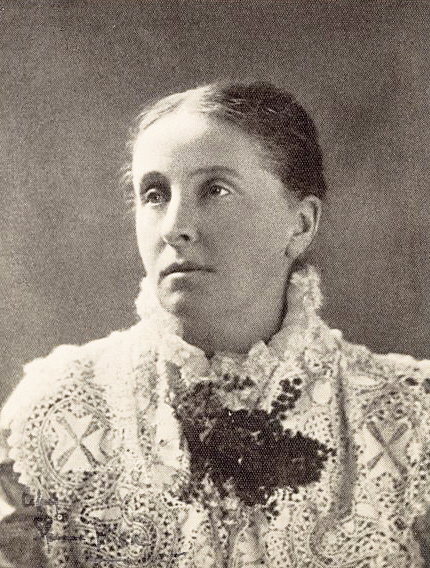
| Ada Cambridge will write more than twenty-five fictional works (many of them serialised in newspapers), three volumes of poetry, and two volumes of her autobiography – “Thirty Years in Australia” and “The Retrospect”. She experiences her share of tragedy, including a near-fatal miscarriage and a serious carriage accident, as well as the loss of children to whooping cough and scarlet fever. |
1885 – Mar 4

His Excellency Sir Henry Brougham Loch becomes the first Governor of Victoria to honour Beechworth with a purely personal visit to “take in the renowned mountain air”. The 58-year-old Governor is accompanied on his trip by Beechworth stalwarts – 54-year-old George Briscoe Kerferd, 68-year-old George Billson and 57-year-old John Alston Wallace – all now members of Victorian parliament. Although past Governors have made ‘official’ or ‘State Visits”, Lord Loch arrives – by train – for an ‘unofficial holiday’ with his wife Elizabeth but agrees, during his stay, to attend the Beechworth Show, organised by the Beechworth and North-Eastern Agricultural and Horticultural Society. Loch also travels from Beechworth to Stanley in a six-horse drag owned by Crawford & Co, driven by Mick Dougherty. Stanley’s young Agnes Mathieson is chosen to present Lady Elizabeth Loch with a basket of White Heart Cherries from James Muter’s garden. There is speculation that Beechworth might be the place chosen for the Governor’s Summer Residence, and a site is offered to him, free of charge, to build a summer home. However, not long after Loch’s Beechworth visit, a site at Mount Macedon is selected for the official Governor’s Summer Residence.
| At the time Beechworth’s streets are laid out and named by George Douglas Smythe in July 1853, he chooses to name one of them Loch Street. Captain Loch, then a hero of the British army, is in Victoria at the time and is feted around Melbourne by Charles La Trobe and William Lonsdale, brother-in-law of Government Surveyor George Smythe who is clearly impressed by Captain Loch and his achievements. |
1885
Alex McLean, Ford Street coachbuilder, becomes the manager of D.M. O’Connor’s American Coach Factory in Church Street, with McLean’s former coachbuilding business taken over by Alex McLean Jnr and W.H. Thompson.
1885
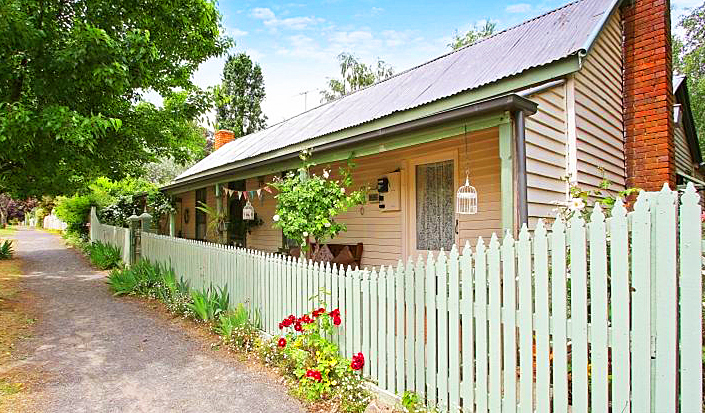
A new cottage is built at 72 High Street directly opposite Beechworth’s Police Paddocks. The gardens behind the house are planted with numerous Silver Birch trees giving the property its name – Birch Cottage – with Spring Creek running directly behind the garden.
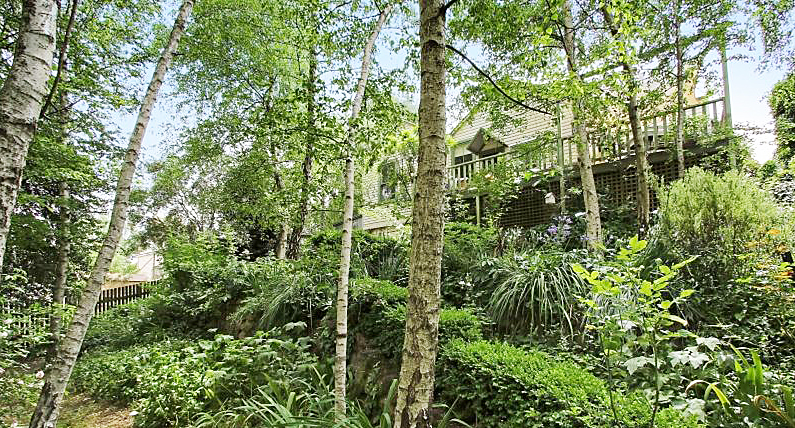
1885
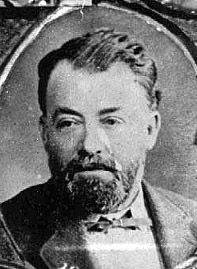
American George Judah Lyon sells his Spring Creek Brewery and aerated water business to Hurst & Co and retires to Windsor in Melbourne.
| In 1890, George Lyon and his wife Wilhelmina establish a boarding house, ‘Idthorpe’ in Marlton Crescent, St. Kilda close to the popular St. Kilda Pier. George passes away aged 57, from an apoplectic fit, to which he is prone. |
1885
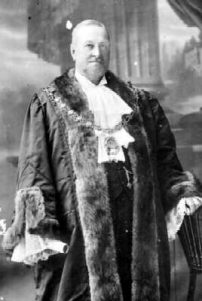
Having served as an alderman with the Albury Council since 1881, 41-year-old George Henry Billson is elected the Mayor of Albury (1885-1886) and will be elected to the position again in 1893. Billson will relocate to Melbourne in 1896, setting up a cordial and aerated water factory in Elsternwick. He will be elected to the St Kilda City Council (1901-1911) and serve as St Kilda Mayor in 1909.
1886

Richard Finch – who runs his successful men’s outfitter shop at 68 Ford Street (above) – wins the tender to create special heavy jackets and thick protective clothing items for the Beechworth Fire Brigade.
1886 – Apr 1
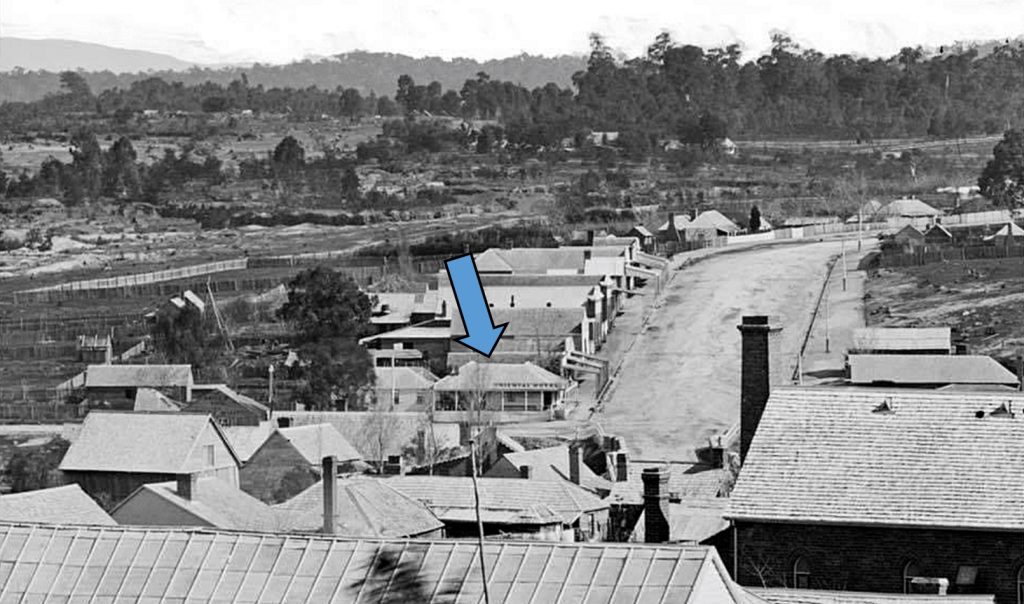
A fire breaks out at the 1857-built Oriental Hotel on the corner of Bridge Road and Mellish Street. Although the Beechworth Fire Brigade rushes to scene, the old wooden building cannot be saved, with the firemen turning their attention to preventing the fire from spreading to nearby premises. The owner of the hotel, William Andrews, his wife and children all manage to escape but sadly lose all their possessions in the fire.
| In 1863, the ‘Oriental Hotel’ is described as having “a Capacious Bar, Bagatelle Room, Large Ball Room, Two Parlours, Eight Bedrooms, a Detached Kitchen, a Six Stall Stable and a Hay Loft”. |
1886
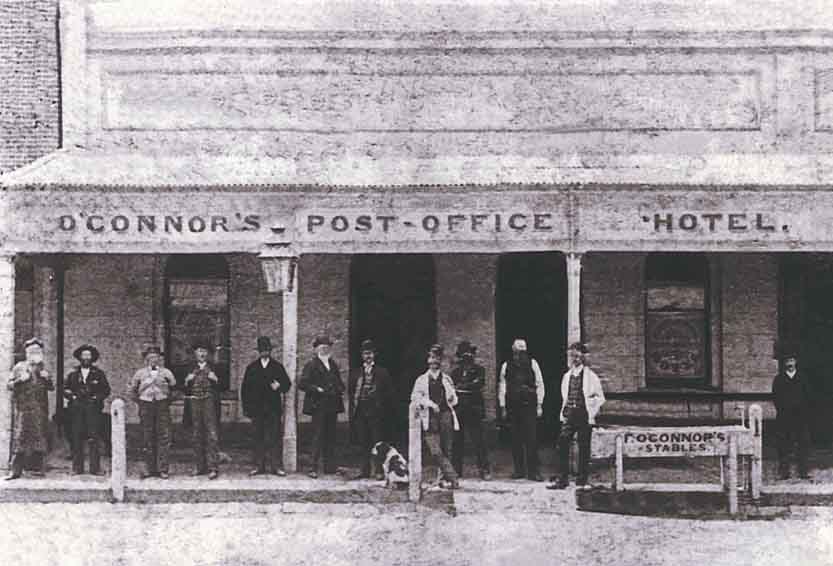
Former Beechworth police officer, Irish-born Felix O’Connor, takes over the licence for the Post Office Hotel. In 1869 he had taken over the Dublin Hotel on Camp Street – opposite the London Tavern – before taking over the London Tavern itself in 1876. In 1892, Felix becomes the licensee of the Railway Hotel (formerly the Alliance Hotel), by which time he is the oldest hotel-keeper in Beechworth. While still running the Railway Hotel, he dies of heart disease in 1898 at the age of 66.
1886
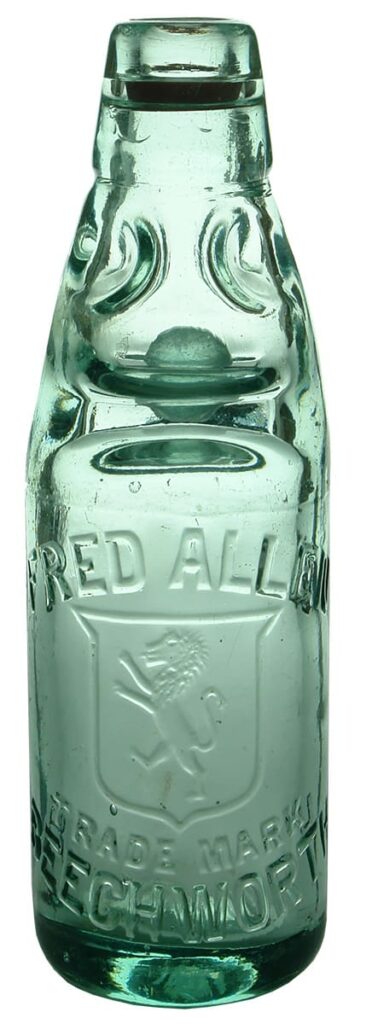
After less than a year of ownership, Hurst & Co sell the Spring Creek Brewery to Frederick Allen, owner of the Star Hotel. ‘Fred Allen’ beer bottles, with a distinctive ‘Lion’ trademark, are valuable collectors’ items today.
| Allen Street in Beechworth is named after Frederick Allen who will sit on the Beechworth Council between 1874 and 1901 and be Shire President on three occasions. |
1886

Alfred William Foster Jnr is born in Beechworth. His father, Alfred ‘Alf’ William Foster Snr and his wife Sarah run a Beechworth tobacconist and newsagency on Ford Street (which they had taken over from George Judah Lyon in 1871). As a youth he becomes interested in spiritualism and rejects Christian beliefs, claiming they reveal no scientific evidence. Educated at Beechworth College and Melbourne University, Foster will go on to be appointed a judge of the Victorian County Court at the age of 41 – the youngest judge ever appointed in Victoria.
| In 1944, Foster is appointed to the Australian Arbitration Court Bench, and in 1947 he will deliver the Arbitration Court judgement granting a 40-hour working week. In 1950 he will be responsible for granting an additional £1 per week to the basic wage, at a time when the wage was just £7. |
1886 – Nov

The beautiful but now empty Oriental Bank is purchased for £1,000 by Reverend Dean Tierney of St Joseph’s Church for use as a convent and school by the Brigidine nuns who are soon to arrive. The four nuns from Abbeyleix in Ireland arrive in Beechworth by train on Saturday November 27, 1886, to a very enthusiastic public welcome, although Reverend Mother, Mary Vincent Cummins, quickly realises she is expected to repay £1,000 pounds. The nuns convert the bank into a convent and school, improvising an altar out of a luggage case. By January 1887 the bank chamber (the front lower part of the building facing Ford Street) is fitted with desks and benches, while three of the upstairs rooms are furnished as dormitories and by February the boarding and day school for girls is opened.
1886

Because there have been so many fires in the Beechworth area, insurance companies approach the council and offer to contribute towards the cost of equipment and running of a new fire brigade. The council agrees and it is re-formed, now called the Volunteer Fire Brigade Board.
1886 – Dec 20
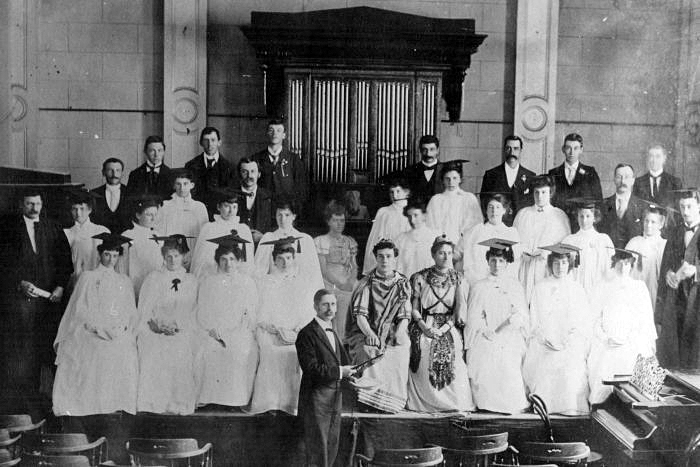
Ordered by conductor James Cunningham Snr and his son, organist James Cunningham Jnr, and the members of the Beechworth Philharmonic Society, a beautiful mid-19th century single-manual chamber organ is finally installed in the Beechworth Town Hall and is played for the first time – at a special ‘welcome concert’ – on this day. The organ is made of pine and leather, and has 256 leaden tin pipes, 66 keys and five stops.
| Originally built in London in 1852 by ‘William Hill & Son’ for a stately English private home, the second-hand organ is installed in the Town Hall by William Anderson, who will return to Beechworth a few weeks later to install another organ – this time at the Christ Church. The Beechworth Town Hall organ remains in place until June 1907 when it is bought back by William Anderson for £20. The organ is finally sold back – again – to the Beechworth Organ Society for $6,000 in 2018 and returned to its place in the Beechworth Town Hall. It is one of the four oldest organs in Victoria. |

| ‘William Hill & Son’ also build organs for Westminter Abbey in London in 1848, King’s College Chapel, Cambridge (1834), St. Andrews Cathedral, Sydney (1866), Adelaide Town Hall (1877), Melbourne Town Hall (1872 – destroyed by fire in 1925) and the Sydney Town Hall Grand Organ (1886), the largest organ in the world at the time of its construction, with an outer case designed by Arthur George Hill, grandson of the late William Hill (who had died in 1870). |
1887 – Jan

Another organ for Beechworth! The Reverend George Cross, rector of Beechworth’s Christ Church, oversees the installation of a fine (but already used) pipe organ in the church. It had been built by colonial organ builder William Anderson of Little Flinders Street in Melbourne for St George’s Catholic Church in Carlton in 1882.
| Restoration of the Christ Church organ in 2008 reveals some of the pipework to be of early European origin. |
1887 – Jan 17
Having been staffed by lay teachers since it opened in a wooden building built in 1857, the four Sisters who have arrived from the Brigidine Convent at Abbeyleix in Ireland take over permanent charge of St Joseph’s Primary School on Church Street.
1887

A decision is made by the Beechworth Council to demolish the original Council Chambers (built in 1858-59 – above) to be replaced with a new, larger two-storey building, while still retaining the beautiful Formal Hall at the rear (below). A state-wide competition is held for a new design which is won by Melbourne architect George Jobbins and construction commences under local builder Thomas Sandham. It will be completed by July 1888.

1887 – Mar 8
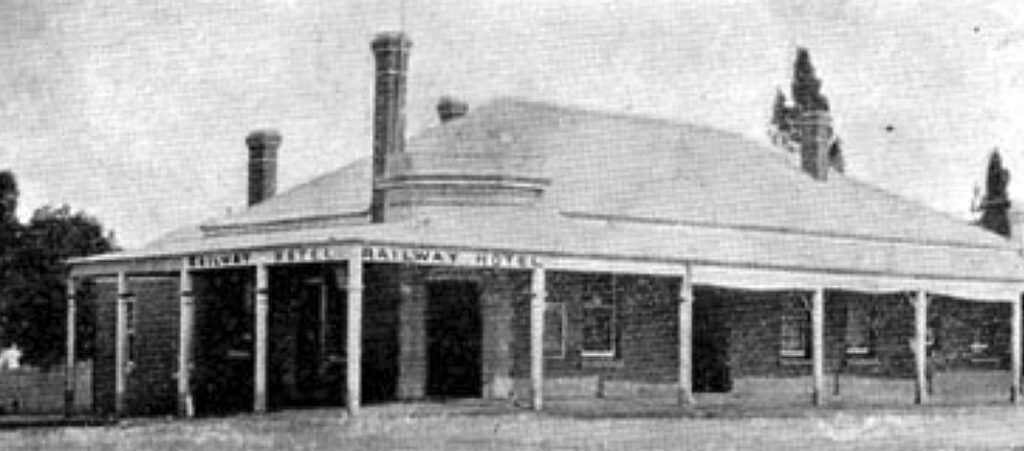
The 1858-built Alliance Hotel – on the corner of Camp and High Streets – is renamed the ‘Railway Hotel’ by it’s new licencsee’s Edward and Elizabeth Ryan as it is the nearest hotel to Beechworth Railway Station.
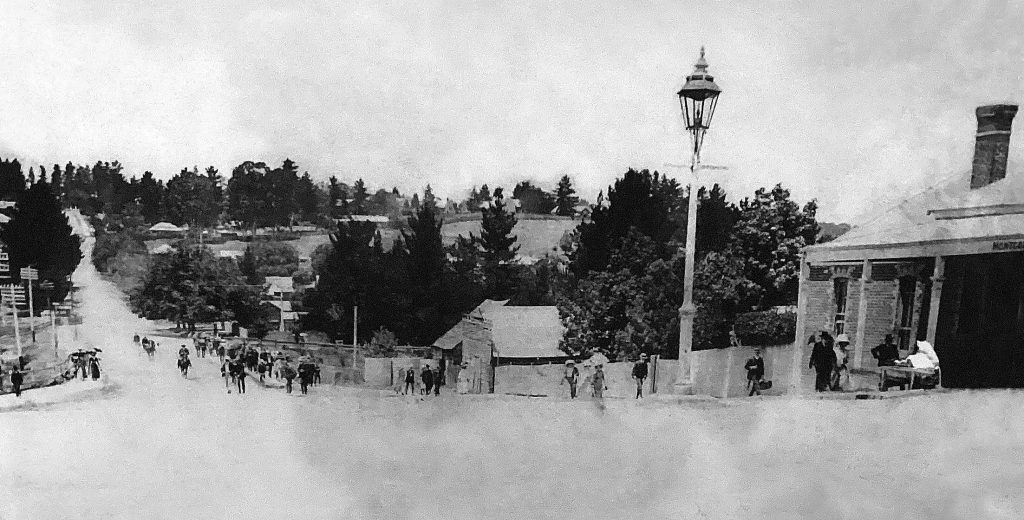
1887

A small cottage, now known as Waterfall Cottage, is erected above the Beechworth Gorge, next to Newtown Bridge, at 1 Ford Street. The house features solid granite foundations and opens out onto a south facing front verandah, and a north facing rear verandah with spectacular views of the Gorge.

1887

Henry Vandenberg establishes the Beechworth Brass Band. Also known as Vandenberg’s Brass Band, it quickly becomes popular and is in constant demand for local dances and official events.
| Henry Vandenberg is one of Beechworth’s most well-known characters. The son of Dutch-born Jacob and Christinas Vandenberg (or Van Den Berg) who run the popular ‘Vine Hotel’ for many years, he leaves Beechworth as a youngster and walks all the way to Melbourne with just 3/6 in his pocket! Henry finds employment in the city as a gardener, before becoming a fully-fledged landscape gardener. Returning to Beechworth with his new bride, Mary Syme, he carries on the business of a general Beechworth dealer with much success, and when the Wangaratta to Beechworth railway is being constructed, he sees an opportunity and opens the ‘Victoria Hotel’ and entertainment hall near the newly built Everton Railway Station. |
1887
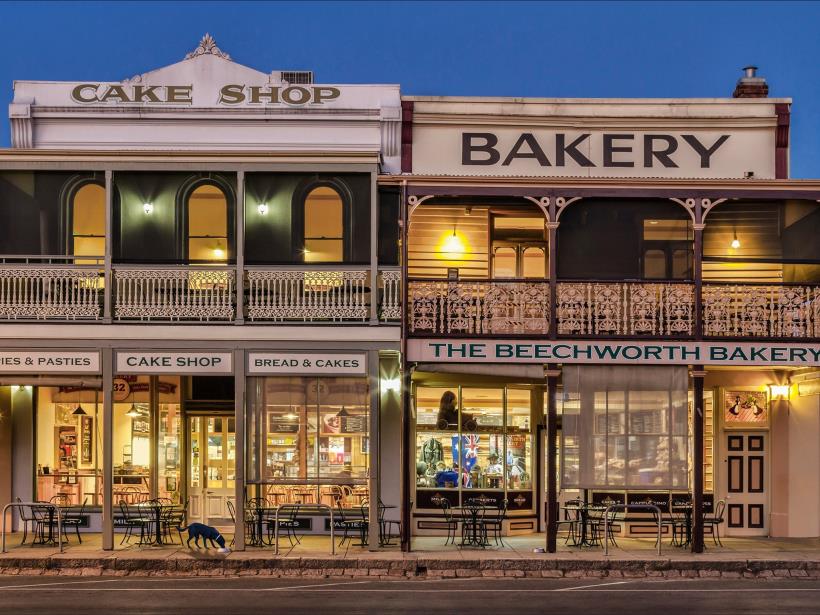
After the death of his brother-in-law David Dunlop, 52-year-old baker James McMaster takes over Dunlop’s thriving Scotch Pie Shop on Camp Street. It stands next door to Manchester House and opposite the Beechworth Post Office in one of the three buildings now occupied by the Beechworth Bakery (above and below).
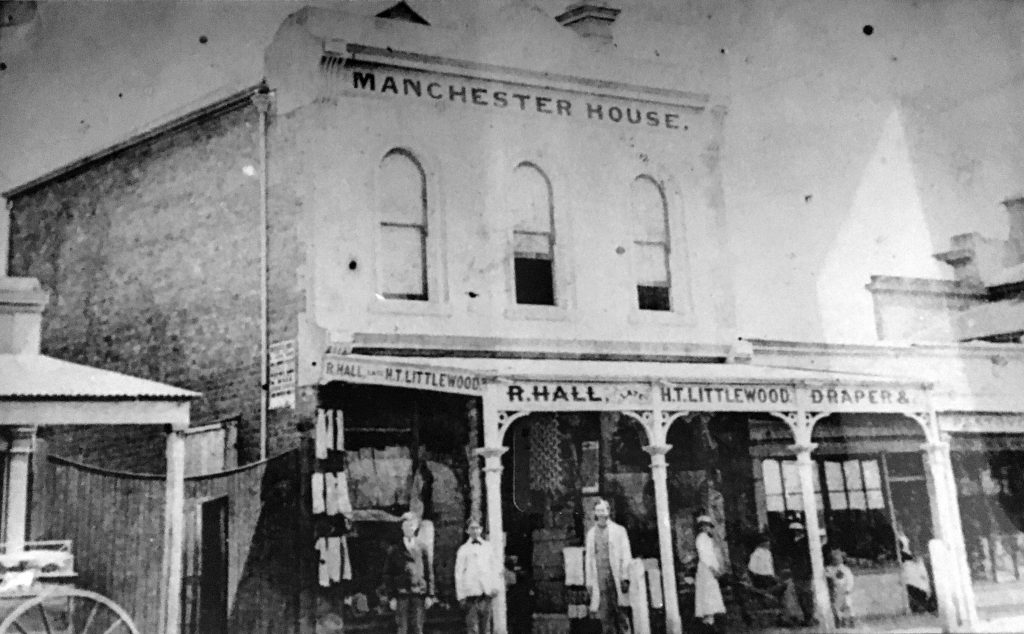
1887

After quickly outgrowing space at the old Oriental Bank building, the Mother Superior and the nuns from the Brigidine Convent & Boarding School successfully appeal for funds from Beechworth’s Catholic parishioners, allowing them to move, taking charge of St. Joseph’s School in Church Street as well as purchasing 10 acres of land adjacent to the school. They eventually construct a grand building to serve as both a convent and secondary school. Building continues and expands until it is fully completed in 1904. The Brigidine Convent of Mt St Joseph becomes known as ‘The Priory’.
| The last surviving member of the four original founding nuns who arrived from Ireland in 1886, will pass away in Beechworth in 1952. |
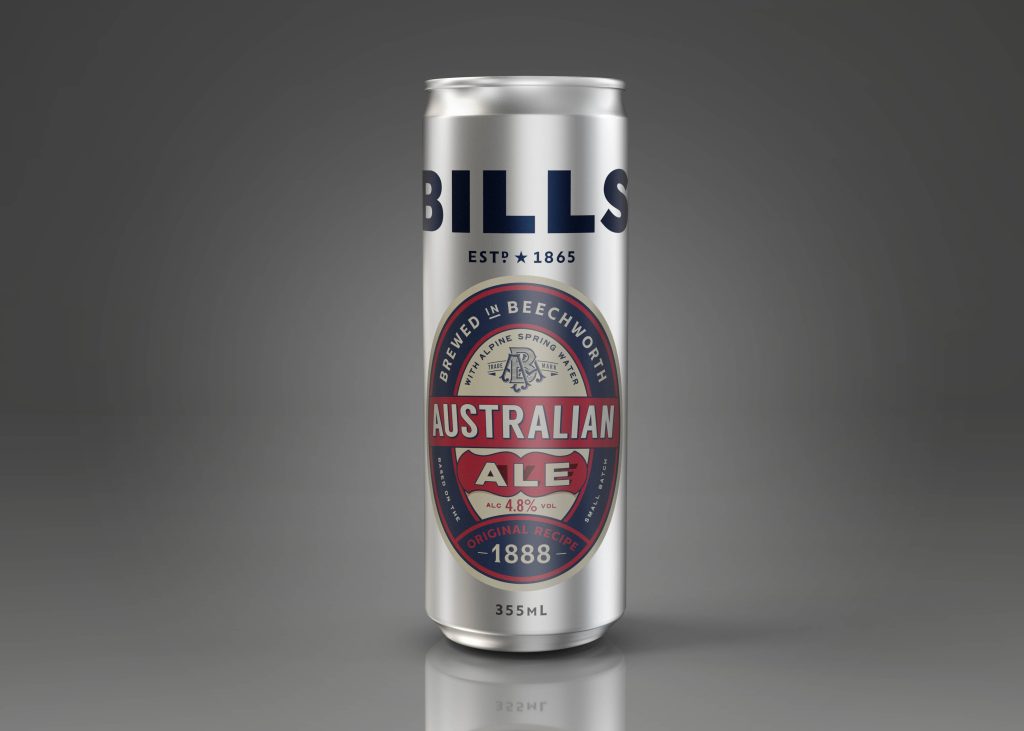
Billson’s Brewery introduce their Australian Ale, a beer that quickly becomes popular.
1888 – Jul

The G.H. Billson Brewery in Albury combines with the Hume Brewery (run by Mr Headly and Mr Langhammer) to form the Albury Brewing and Malting Co Ltd (below). 44-year-old George Henry Billson becomes chairman, with Headley as general manager.
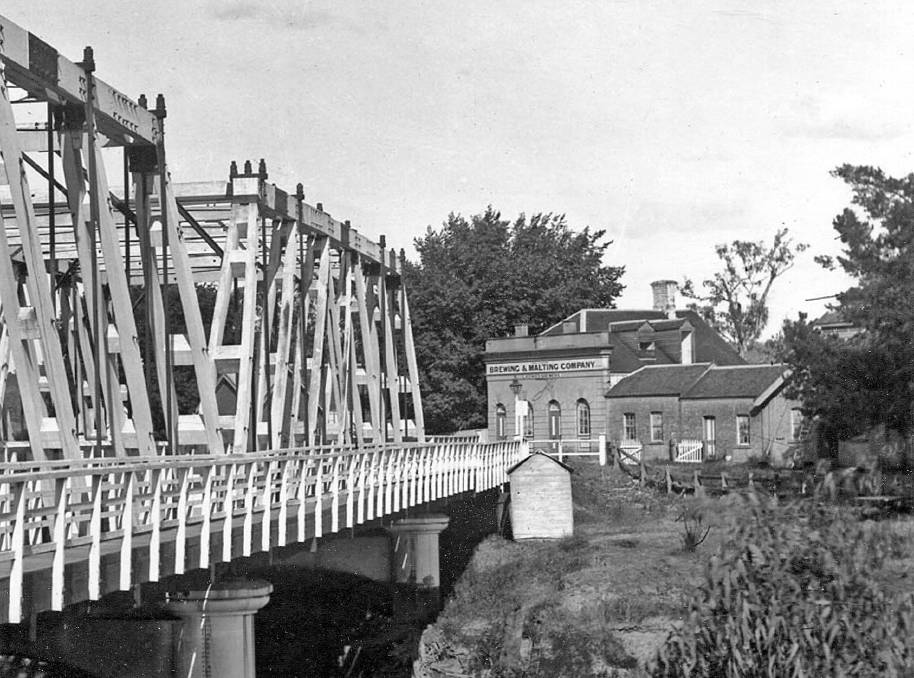
1888 – Jul

The impressive new two-storey Beechworth Council Chambers at 103 Ford Street are officially opened, with a ‘Grand Ball’ held in the 1859-built Town Hall which stands behind the Council Chambers. Designed by Melbourne architect George Jobbins in a classical style, the front of the new Council Chambers features five bays intersected by pilasters.
1888 – Jul

Beechworth now boasts two roller-skating rinks, as the new “fad” becomes increasingly popular. The first is at the Oddfellows Hall after Mr Young of Melbourne negotiates a lease of the building from the trustees. He engages 62-year-old Scotsman James Kyle to lay down a new smooth floor of the best Kauri pine (above) and the venture is known as The Columbia Elite Rink. Mr Bailey and Mr Chalk are proprietors of the second rink – the Beechworth Skating Rink – operating from a “commodious brick building” on the corner of Camp and Last Streets. It opens with a performance from Henry Vandenberg’s Beechworth Brass Band, established a year earlier.
| The opening night of ‘The Columbia Elite Rink’ is hosted by Beechworth’s Honourable Frederick Brown, M.L.C. who, after declaring the rink officially open, introduces popular Melbourne roller skater Mr Stevens. Stevens then treats the 150 invited guests to some remarkably clever fancy ‘rinking’, showing that he is thoroughly ‘at home’ on the skates, making the admiring spectators envious of his cool self-possession which is accomplished without accident or mistake. The highlight is Mr Stevens taking a ‘running jump’ over four chairs placed together in the middle of the hall! |
1888 – Sep 1
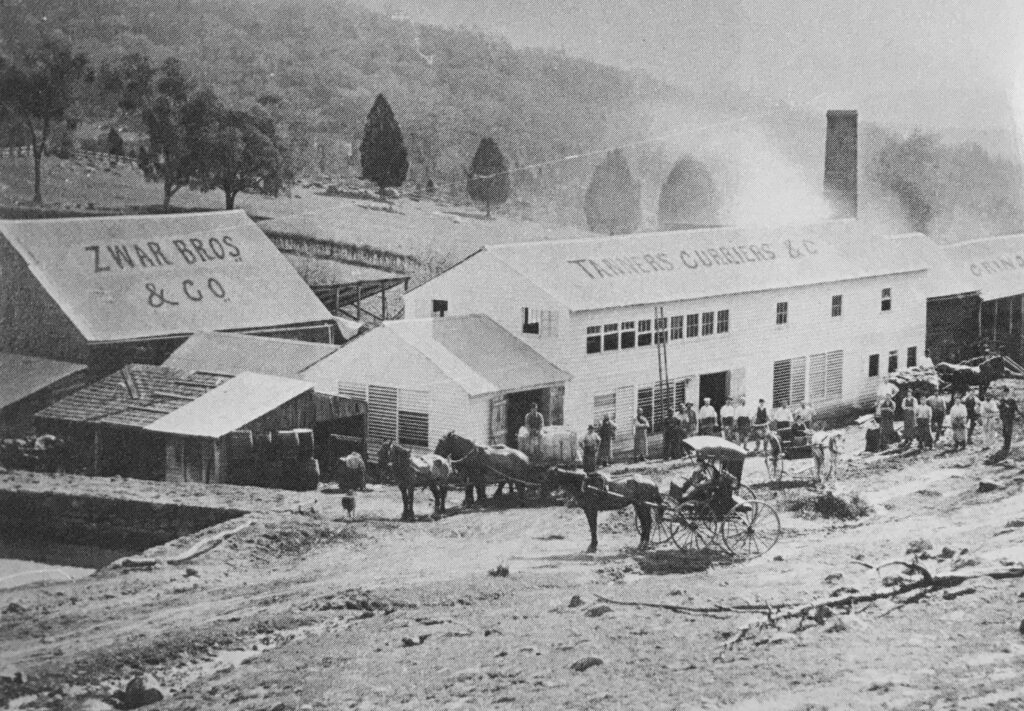
After being run by the Dodd brothers since 1858, the Ovens Tannery business and freehold is purchased by 27-year-old William Zwar (who has the production expertise), his brother 25-year-old Albert Michael Zwar (who is the ‘figures man’), and friend Leonard Lloyd (the ‘money man’) for £500 and their partnership is registered as Zwar Bros and Co. (Matthew Dodd passes away in Beechworth in 1904, aged 67.) At the time of the purchase, the business employs 15 men and processes 30 hides a week. Younger brother, 16-year-old Henry Zwar joins a year later as an apprentice, with the tannery eventually becoming known as the Zwar Bros Beechworth Tannery. The following year they also take over the Dodds Leather Merchants store in Ford Street. The Zwars continue to expand the business and by 1896 are employing 30 men, with the weekly output of hides at the tannery increasing to 210, becoming well known for their sole leather. 200 tons of wattle bark, sourced from Euroa, is required annually for the tanning process.
| By 1896 the ‘Zwar Bros Beechworth Tannery’ is thriving, exporting 9 tons of products per month to England, China, Japan and India. Production is mainly in saddlery and sole leathers, with the company also trading in calf, goat, horse, kangaroo, wallaby, possum, rabbit and even kangaroo and wallaby skins! Leonard Lloyd dissolves his partnership with the Zwar brothers in 1914 for £9,000. |
| Albert Michael Zwar is the driving force behind the success of the tannery and eventually becomes its sole controller. While he is considered autocratic and forceful with an astute business mind, he also has a strong sense of community. |
1888
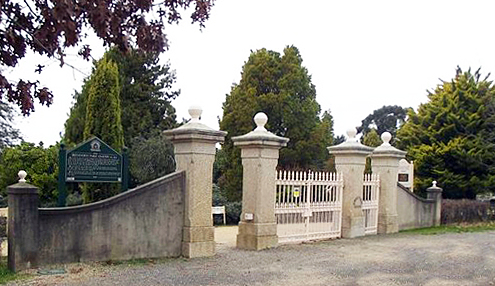
Fiddes & Co (who built Beechworth’s granite Newtown Bridge) now oversee the addition of impressive granite entrance pillars and iron gates to the front of the Beechworth Cemetery.
| The cemetery’s rotunda and headstones, as well as its distinctive and unusual features such as a Turkish fountain and the rare twin Chinese ‘Burning Towers’ and Shrine make it one of the finest examples of a historical garden cemetery in Victoria, and of botanical significance for its large collection of landscaped plantings. |
1888 – Dec
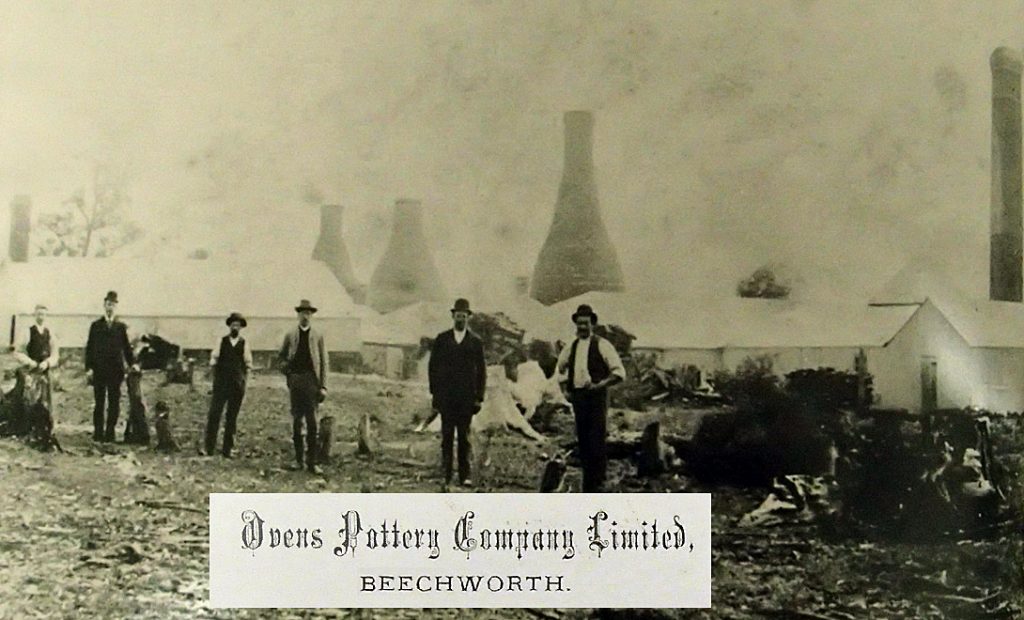
Having taken over H.L. & E. Pottery Beechworth at Hurdle Flat, Beechworth businessmen Alfred Foster and Joseph Wilson rename the business the Ovens Pottery Company Ltd. They will manufacture a range of pottery products including stoneware, garden urns, vases, cheese dishes, ginger beer bottles, butter coolers, water filters, wine and spirit barrels, bread plates, jugs, teapots, storage jars, pots, tiles, flower pots, spittoons, basins, bowls, demijohns, lidded crocks, pipes and bricks. Ovens Pottery will struggle financially until John Alston Wallace injects £10,000 into the business and it carries on, until finally going into liquidation in 1892.
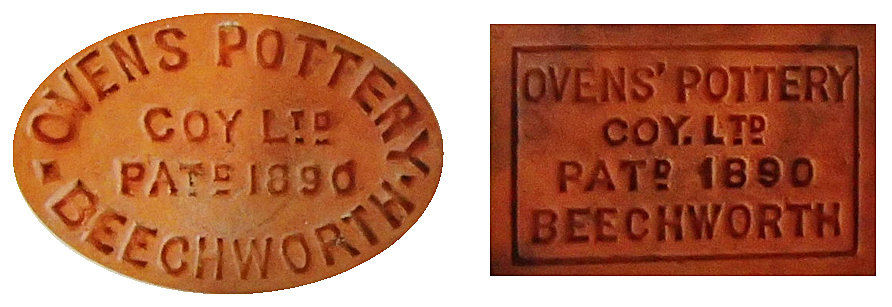
1889 – Jan
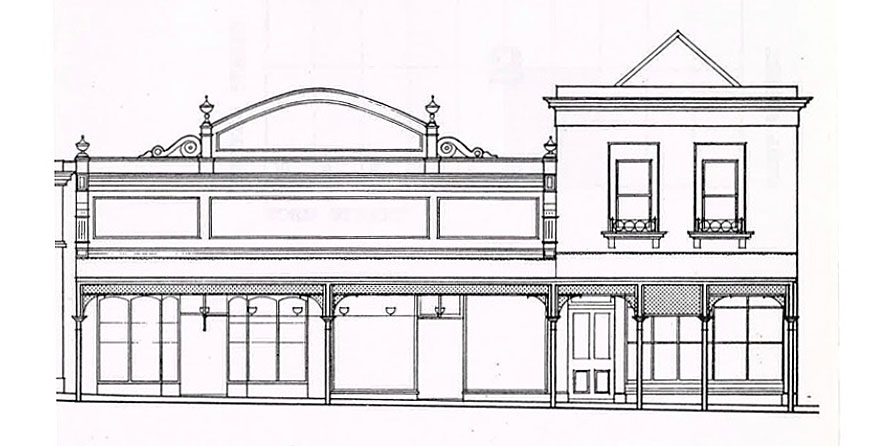
A new building is erected at 51-53 Ford Street, next door to Gammon’s Medical Hall. James and Robert Cunningham’s Hardware & Ironmongery Store and John Armstrong’s drapery store Cheapside House will be the first businesses to occupy the building’s two shops, with Cheapside House eventually taking over both shops.

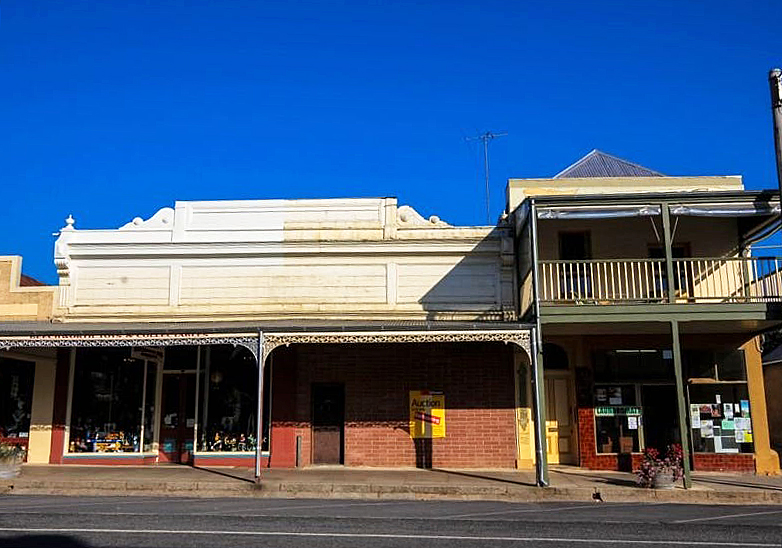
1889 – Apr

Typhoid fever is still taking lives in Beechworth and Robert Pyle and three of his adult children of the Three Mile will all die of the water-borne disease within 18 days of each other. On February 20 his eldest son, Robert Jnr, dies, followed on March 25 and April 7 by Emma and Annie – the second and third eldest daughters – who succumb to the same disease, from polluted water in the family tank. Finally, 55-year-old Robert Pyle Snr passes away in late April after a fortnight’s illness. (Two more children – Alfred and Charles Pyle – will die of the same disease three months later). The death of the respected and esteemed patriarch of the Pyle family results in shutters being put up in all the businesses in Beechworth as a large number of mourners come from various parts of the district for his funeral. The cortege comprises thirty vehicles and twenty horsemen. He is buried alongside the three fresh mounds of earth which mark the resting places of his recently buried children.
| Arriving in the Beechworth in the 1850s, Robert Pyle Snr works for some time on a farm belonging to Melmoth Hall (receiver and paymaster at Beechworth) on the Three Mile Creek before entering into partnership with Bernard Holloway as dairymen and gardeners on the allotment of land where his house stood. Pyle and Holloway will subsequently purchase the dairying business of Marshall and Ward at Black Springs, as well as the market gardens of the Hall Brothers. In 1866 Pyle marries Catherine, the eldest daughter of Richard Rowe of Bowman’s Forest and they will have a total of 14 children. Through perseverance, industry and thrift, Robert Pyle Snr acquires considerable property and eventually becomes a respected butcher in the district. Sadly, not long before his death, his family home and other buildings are destroyed by fire. The loss, including the building’s valuable contents, is estimated at £1,000 over and above the amount of the Pyle’s £1,100 insurance policy. |
1889

With ever-increasing patient numbers, work begins on the construction of 8 new ‘cottage wards’ within the grounds of the Beechworth Insane Asylum, behind the main, existing buildings. They will be completed by 1890. Four are built on the ‘male side’ and four of the ‘female side’, with each cottage housing 20 patients. Initially named ‘Female 6-9’ and ‘Male 7-10’, the cottages are given names in the 1980s, including ‘Kiama’, ‘Carinya’, ‘Myrtle’ and ‘Grevillia’ (female side) and ‘Olivene’ and ‘Kurrajong’ (male side).

1889
To improve water supply at the Zwar Bros Tannery, William Zwar builds a dam and then, in 1916, connects a 3” pipe to Beechworth’s water supply, but by the 1920s, this water supply is still not enough for the growing business.
1889 – Dec

John Armstrong’s new Cheapside House drapery store at 53 Ford Street quickly proves popular and he will soon take over the Cunningham brother’s hardware and ironmongery store next door. Today Beechworth Toys and Collectables (number 51) and Rebus (number 53) operate from the restored building (see photo below).
| Born in England, Armstrong moves with his family to Australia where his father settles them in Wooragee, 9km from Beechworth, becoming a farmer and orchardist, assisted by his sons. Young John serves an apprenticeship at the drapery store of Sidney Henry Rundle of ‘London House’ in Beechworth before establishing his drapery business – ‘Cheapside House’ – at 53 Ford Street. He will go on to build up the business that becomes known far and wide simply as “Armstrong’s”. He becomes a Justice of the Peace and a member of the ‘Ovens District Hospital’ Board of Management, ‘School Board of Advice’, and a member of ‘Beechworth Boxing Day Sports’. He is the president of the ‘Beechworth Progress Association’ and Treasurer of the ‘Beechworth Racing Club’. Residing for many years with his wife Margaret at their home ‘Wongrabel’ on Finch Street, John Armstrong will pass away aged 63 on March 22, 1920. |
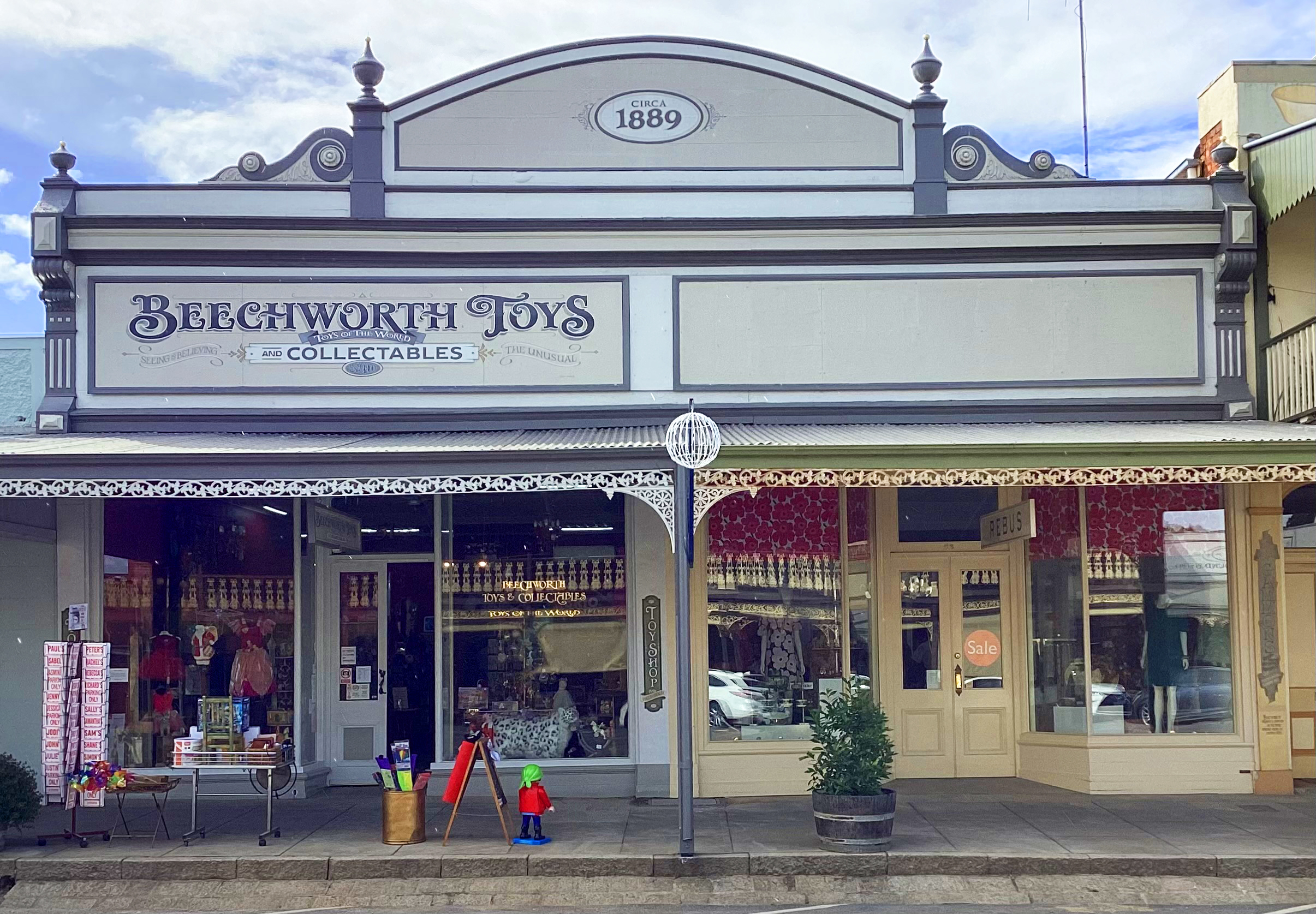
1889 – Dec 31
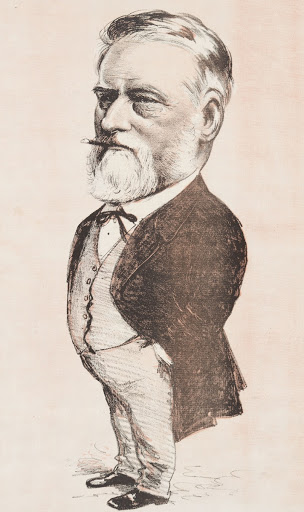
New Year’s Eve ‘Salute to the Beechworth Pioneers’. Scottish-born Beechworth pioneer John Alston Wallace invites 150 of the town’s greatest pioneers to a special celebration, timed to coincide with ‘Hogmanay’ – the last day of the year and Scotland’s most important holiday. Starting in the afternoon with a range of spectacular Highland Games – which attract a crowd of 3,000 – a banquet begins in the early evening inside a huge marquee set up in the grounds of the Vandenburg’s Vine Hotel. The invited ‘greats’ of Beechworth relive past triumphs and tragedies at the event and, as midnight approaches, fireworks light up the sky, and the bells of Beechworth blend with the sound of bagpipes to farewell the old year and welcome the new.

| The one important Beechworth pioneer – invited but missing – at Wallace’s New Year’s Eve banquet is 58-year-old George Briscoe Kerferd, former Mayor of Beechworth, ex-Premier of Victoria and Supreme Court judge. He died while on a holiday at Sorrento on the Mornington Peninsula on the very morning of the ‘Salute to the Beechworth Pioneers’. |
1890 – Jan 1
The celebrations continue the following day with the ‘Wallace Festival’ being held to celebrate John Alston Wallace’s outstanding contribution to Beechworth.
1890 – Jan 1

The Foundation Stone for a new wing of the Ovens Benevolent Asylum at 12 Warner Road is laid by Elizabeth Keogh, sister-in-law of John Alston Wallace, in honour of Alston’s wife Theresa Ellen Wallace who had recently died in childbirth. It will be named the Wallace Memorial Ward.
| Just before the Foundation Stone is lowered into place, George Fiddes, the new building’s architect, places a bottle containing ‘Jubilee Coins’ and copies of local newspapers in the cavity below the stone. |
1890 – Jan 1
After 12 years as his assistant, Pharmacist George Gammon makes George B. Taylor his equal partner in the business, renaming it Gammon & Taylor’s Medical Hall.
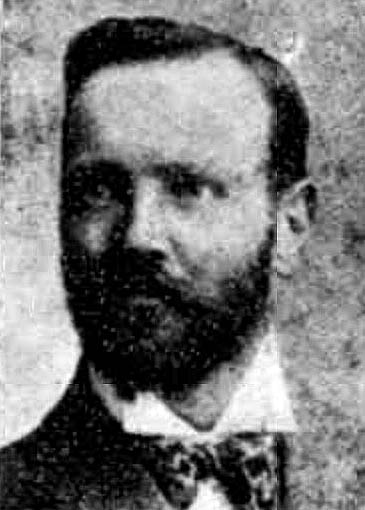
| ‘Gammon & Taylor’ continues until 1896 when the ‘Medical Hall’ is sold to William Johnston Bowen, the son of well-known Melbourne pharmacist William Bowen. After the sale of his business, George Gammon retires to the Melbourne suburb of Kew. William Johnston Bowen had been the dispenser at the ‘Ovens Hospital’ in Beechworth so is already well known in the district and he successfully runs the business until his retirement in 1916. |
1890

Enrolments at Beechworth State School (number 1560) have dropped to 304. At its height, the school had over 1,000 children gaining their education at the school.
1890
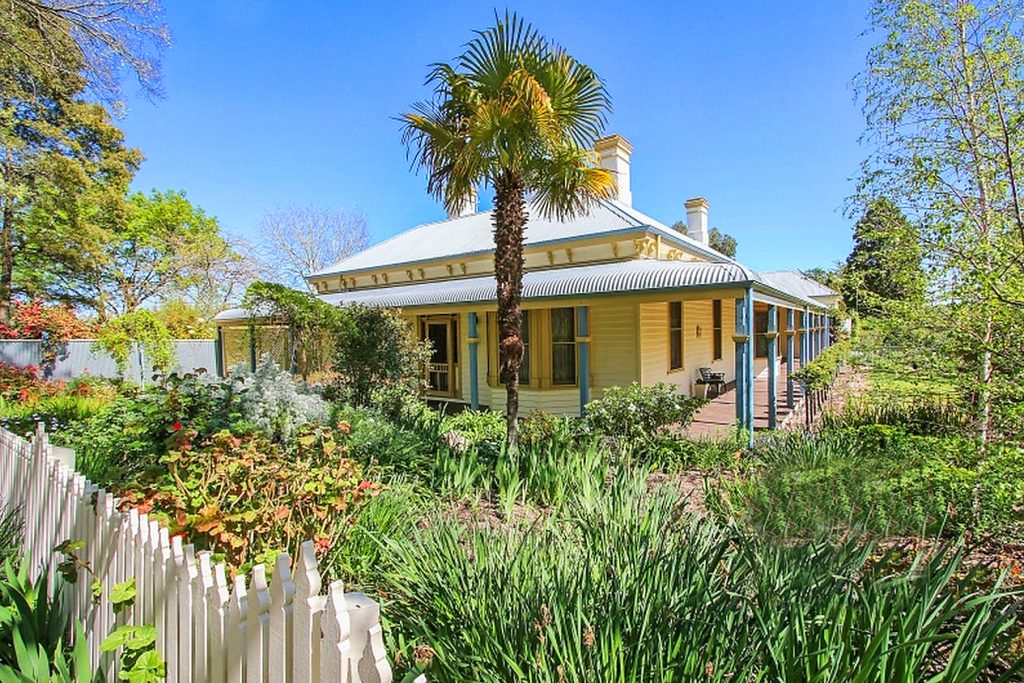
A fine new Victorian home with a wide verandah is completed at 39 Loch Street. Located on 2 blocks of land totalling 2,024 square metres, it still stands today as a 4 bedroom, three bathroom home and is sold in September 2018 for $1,270,000.

1890
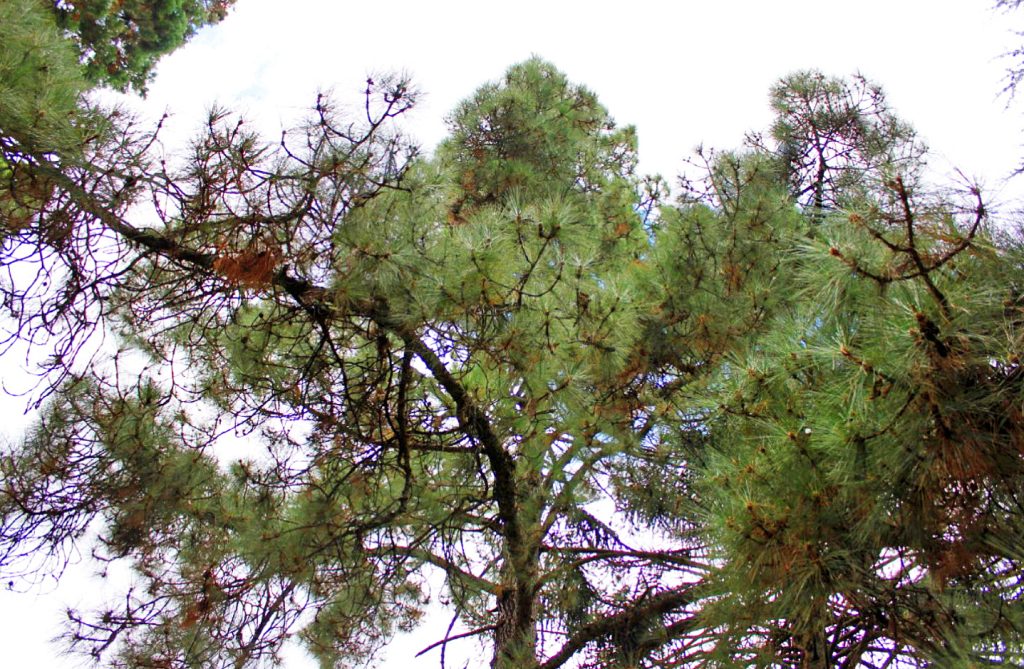
An ‘Isolation Ward’ – designed in the Gothic style by Donald Fiddes – is completed at the Ovens Goldfields Hospital. Constructed to the west of the main building, the contractors are Beechworth builder 64-year-old James Kyle and his 23-year-old son Alfred Kyle. Costing £2,000, the new ward will become known as ‘Little Canada’ after the Canadian miner who likened the pine-clad slopes of the adjacent Beechworth Gorge to his native country so much that he builds a log cabin close to where the ‘Isolation Ward’ is constructed..
| Scottish-born builder James Kyle is President of the Board of Management of the ‘Ovens Goldfields Hospital’. When Sir William Clarke travels to Beechworth to lay the foundation stone for the new ‘Isolation Ward’, another procession is held in Beechworth, complete with band, lodges and the Chinese miners displaying their famous dragon. |
1890

A beautiful cottage is built at 49 Last Street between Kars and Frederick Streets. The Beechworth property – which features rich Jarrah floors and high ceilings with a bullnose veranda – is sold in October 2024 for $935,000.

1890
The Star Hotel on Ford Street is sold to William Carroll for £3,000. Irish-born Carroll has been a wards-man at the Ovens District Hospital since 1867. His wife Mary Ann Carroll will manage the accommodation and meals at the hotel. Carroll will run the Star Hotel until his death in February 1903, at the age of 63, at which time his brother John Carroll takes over the hotel, and then ownership is taken by John Carroll’s widow Margaret Carroll following his death.
1890
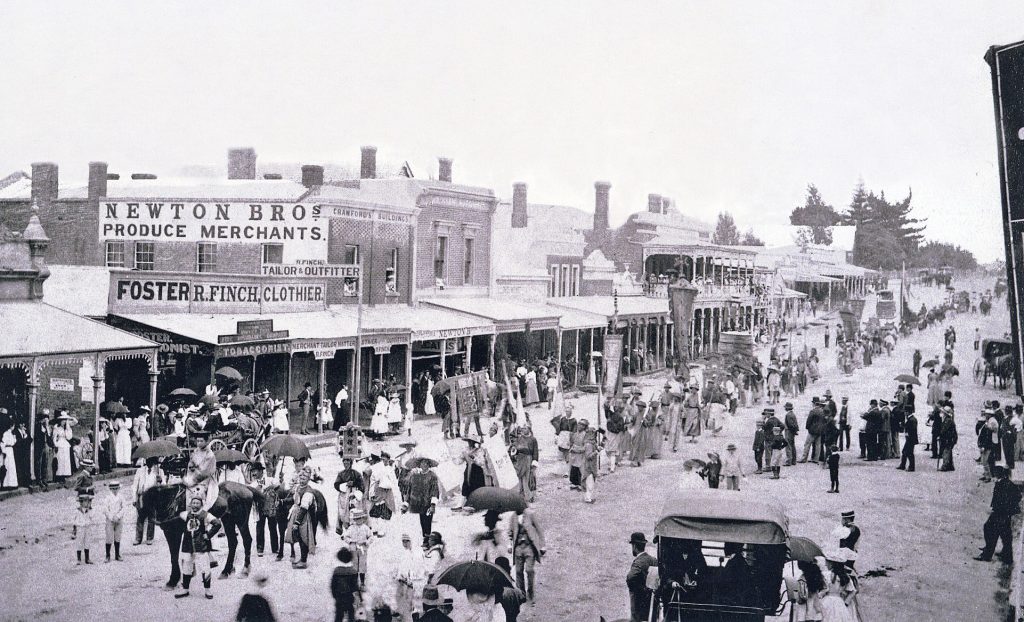
1890

On land that had been the home of Melrose’s Ovens Bedding Factory (destroyed by fire in April 1871) the unassuming weatherboard Charnwood Cottage is built at 11 Loch Street. Set on over quarter of an acre of land, it features 12 foot high ceilings, 4 fireplaces, hardwood floors and sash windows, and stands two doors from the Oddfellows Hall (built in mid-1871). Named after the historic ‘Charnwood Forest’ which covers approximately 67 square miles (170 km2) in Leicestershire in England, Charnwood Cottage will be sold for $400,000 in January 2020 and then fully renovated and updated, with work completed in July 2023.
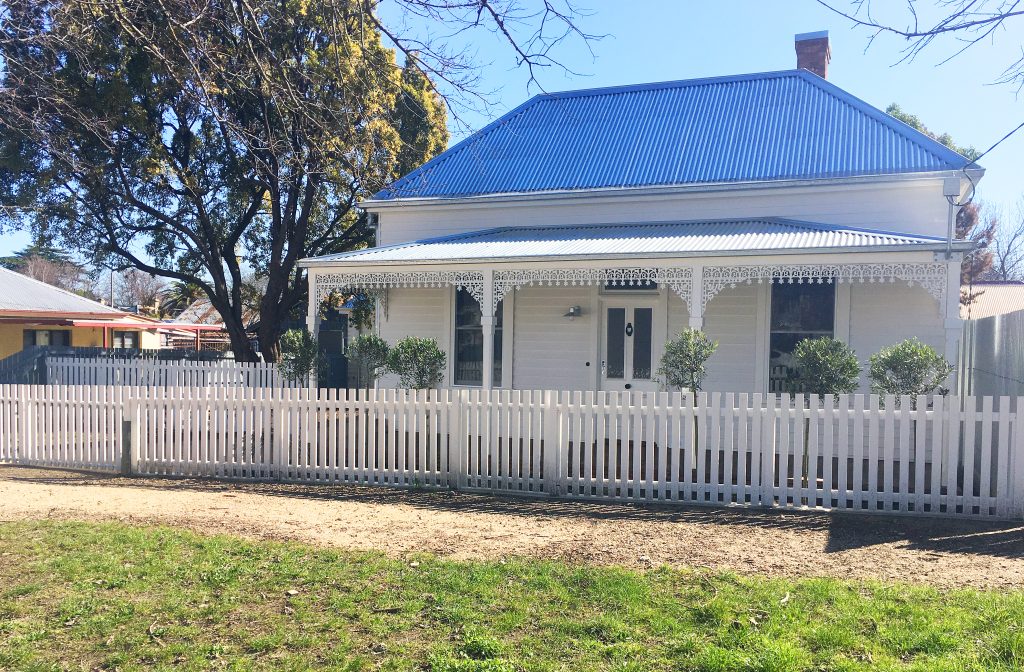
1890

Beechworth-born Alexander Cribbes draws big crowds as he tours North-East Victoria with his steam-driven “Riding Gallery” and other amusements. The “splendid steam riding gallery” is a boiler-powered ‘Merry-Go-Round’ featuring concentric rings of horses and carriages. The centre of the rings features a space where a band performs, entertaining the ‘riders’ with music as an engineer feeds fuel into the boiler and pulls a range of levers through the escaping steam to operate the popular ride. Cribbes always returns to his home in Beechworth during the winter months where his numerous workers are employed in improving his various properties, before he sets out on tour for the next season, regularly offering free tickets and rides for the benefit of local charities.
| Two of Alexander Cribbes’ sons – Robert and Alec – play in the band in the centre of the ‘Merry-Go-Round’. The Cribbes family are involved in the Beechworth music scene and take part in many local concerts and performances. Alec (pictured below) will live to the age of 74, dying in Ringwood in 1957, while his older brother Robert (1876-1897 – who dies aged just 21) and his father Alexander Cribbes (1836-1915) are both buried in the Beechworth Cemetery. |

1890 – Oct 15

After 10 months of construction, the extension of the Ovens Benevolent Asylum, the 12-bed Wallace Memorial Ward, opens at 19 Warner Road, the first ward built solely for female residents, mainly destitute miner’s wives. Designed by Beechworth architect Donald Fiddes, it is constructed by Thomas Sandham and John Lyell at a cost of £1,176. It is financed almost entirely by a donation of £1,100 from local mining entrepreneur and parliamentarian John Altson Wallace as a memorial to his wife who had died in childbirth some years before.
| The ‘Wallace Memorial Ward’ will used as a female-only ward until 1973 when it is converted for use as a ‘Day Hospital’. After a new, modern ‘Day Hospital’ in constructed in the mid-1980s, the ‘Wallace Memorial Ward’ will be refurbished for use as the administration building. It has since been fully renovated and is now a private home. |
1891 – Mar 10

When the promotors of the ‘Cyclorama of the Battle of Waterloo’ in Melbourne discover that a patient at the Beechworth Benevolent Home was a soldier in the historic battle in June 1815, they send for him. 98-year-old Jeremiah Brown is transported to Melbourne where an old uniform is found and he is given a place of honour in the show where he proceeds to recount his adventures as a 22-year-old at Waterloo to fascinated, wide-eyed members of the Melbourne public!
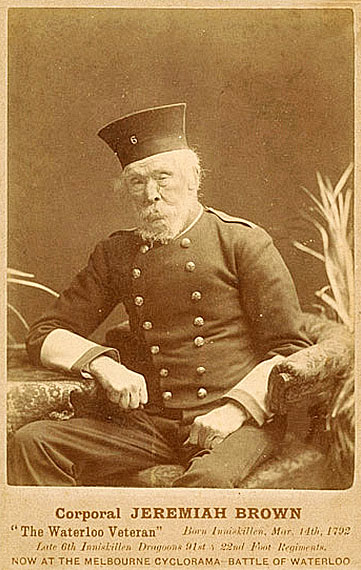
| Introduced to Australia by American promoters Howard H. Gross and Isaac Newton Reed, the Melbourne ‘Cyclorama’ – a large hexagonal building designed by George Johnson – is situated on Victoria Parade at Eastern Hill (Fitzroy). Before silent movies were shown to the public, the 19th century ‘Cyclorama’ hosts viewings of massive 360-degrees paintings of the battle that wrap around the circumference of the building’s interior. Sounds of the battle including cannons, thanks the recently introduced gramophone record, are played, and artificial smoke waft through the building for added effect. On hand are people – like Jeremiah Brown – who are either historians or were there at Waterloo to tell the story. The ‘Cyclorama’ is quite a phenomenon in its heyday but, with the advent of ‘moving picture shows’, it will close in the early 1990s with the building repurposed as an athletics and boxing pavilion, before being demolished in the 1920s to make way for extensions to St. Vincent’s Hospital. |
1891 – Jun 4
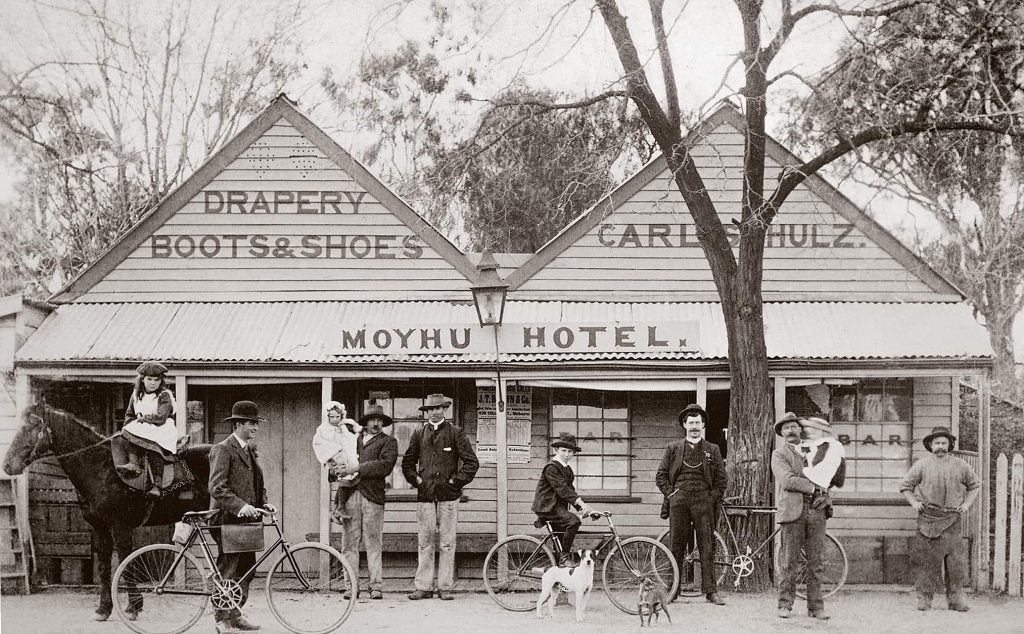
Bushranger Harry Power (born in Ireland as Henry Johnson) reappears in the small town of Moyhu, 31 miles (51km) from Beechworth, to search for a small pot of gold he had alledgedly buried there some years before. In the intervening years Harry has been a prisoner at Pentridge Prison in Melbourne before being released due to ill health at the age of 70. He then gets a job on the 1840-built ship ‘Success’ moored in Sydney Harbour, refitted to show what life was like in prison hulks. Power is employed to be the “official greeter” of guests and is billed as a “real life bushranger”. 71-year-old Power will leave Moyhu (with or without his ‘buried gold’ – nobody knows!) and decamp to Swan Hill where tragically, a few months later, his body will be found in the Murray River after apparently drowning while fishing on October 11th 1891.
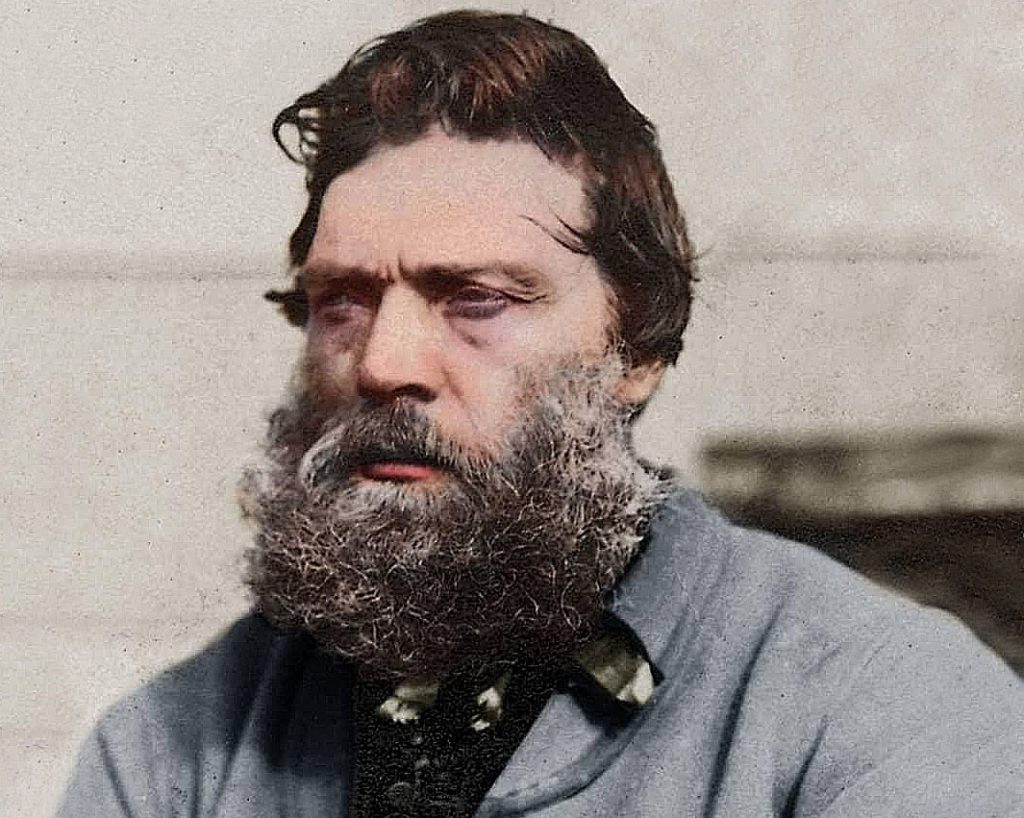
1891 – Jul 23
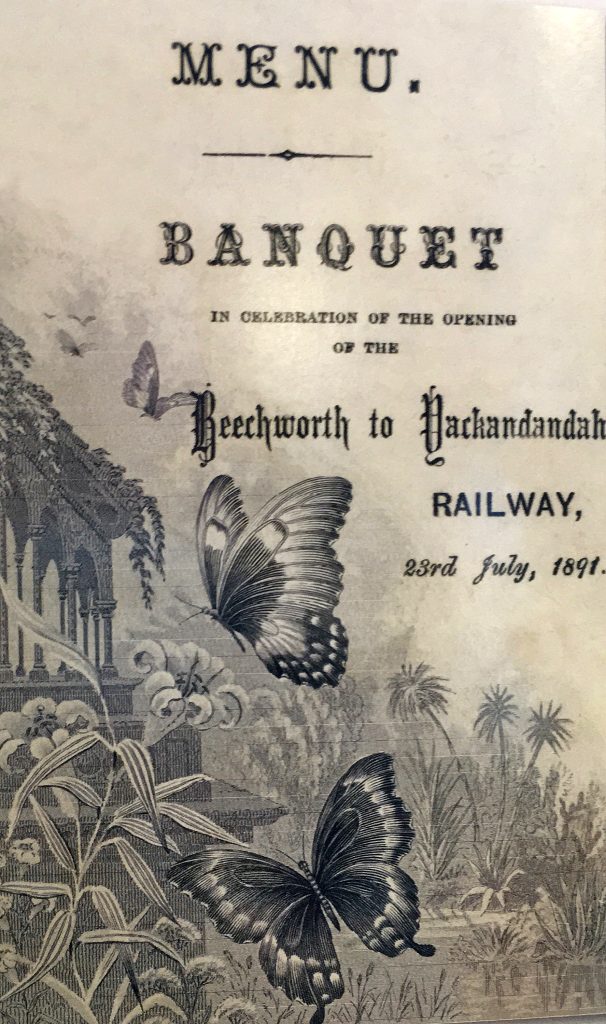
The railway line from Beechworth to Yackandandah is completed. It is one of the earliest ‘branch lines’ ever constructed in Victoria. To mark the occasion, a special train sets out from Beechworth to celebrate the opening of the newly built Yackandandah Railway Station (below). The menu includes Ox Tongue, Roast Duck, Saddles of Lamb, York Hams and Pigeon Pie.

1891

Andrew Porritt moves his Ovens Register newspaper printing press into a new purpose-built printery at 37 Camp Street.
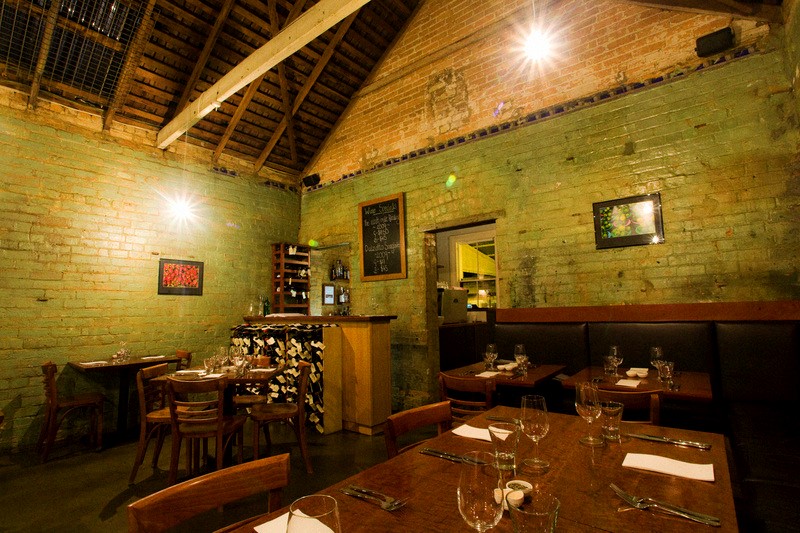

C.E. Kipling becomes a business partner of long-time Beechworth jeweller and watchmaker William J. Turner in his business at 52 Ford Street. Considered the ‘Tiffanys’ of Beechworth, Turner and Kipling carries one of the largest stocks of jewellery, gems and watches in the North-Eastern district, and all kinds of repairs are done on the premises.
| Originally arriving in Beechworth as a goldfields official, William J. Turner will quickly become a Commissioner on the goldfields before establishing his first gem, gold and jewellery business in Beechworth in 1856. At the same time, he also acts as a resident warden, at times performing magisterial duties and chairing the Local Court. He is awarded a medal for the precious stones he sends to the ‘London Exhibition of 1862’. With Beechworth’s other notable watchmaker and jeweller, Charles Frederick Falck, Turner prepares a dazzling display of gems and jewellery from Beechworth for the ‘Royal Society’s Exhibition’ in Melbourne in 1865. William J. Turner will die in 1896. |

Beechworth Councilor 33-year-old Alfred Arthur ‘Bosher’ Billson organizes a group of volunteers to further develop and beautify the ‘Botanical Reserve’ on Sydney Road. A majestic stand of European trees is planted, and two cannons are mounted on top of the large rockface in the reserve, known locally as the ‘Giant’s Grave’.
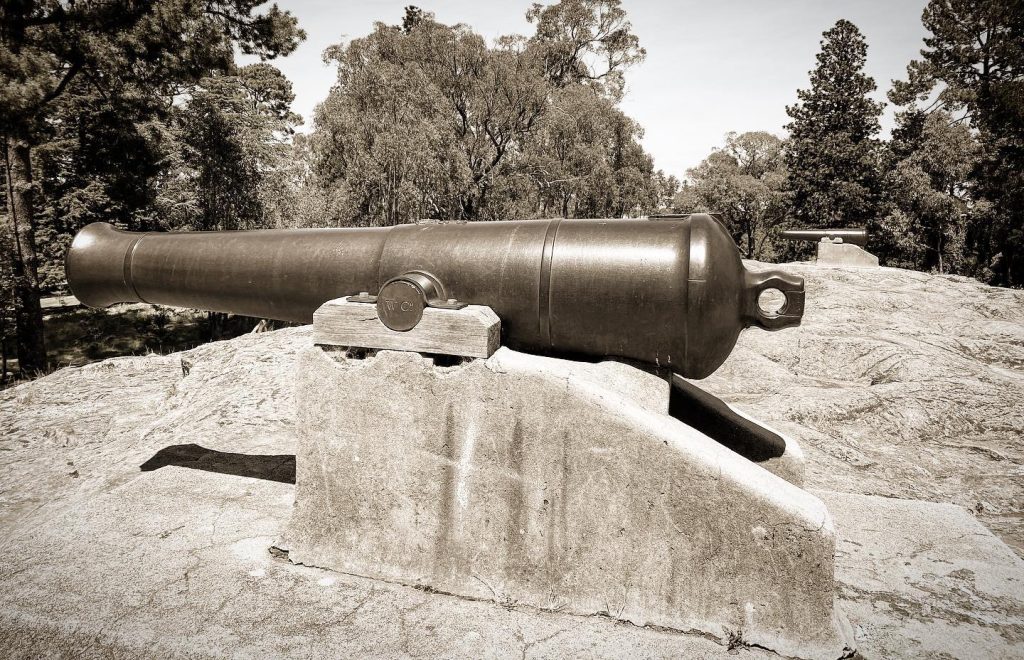
1891 – Oct

Renowned and respected Beechworth photographer James Edward Bray dies after suffering a bout of influenza. He is 59 years old. After establishing his popular studio in Camp Street in 1868, he has just opened another branch of his photographic business at Yarrawonga which is where he passes away. His funeral is held in Beechworth and his widow, Elizabeth, will continue operating the Camp Street photographic studio with the help of their son, until she dies on 20 November 1895.
| When he is 48-years old, James Edward Bray is one of four men who photograph the Kelly gang after the siege of Glenrowan in 1880. In the early 1880s Bray starts specialising in printing varnished photographs on tin. |
1892 – Jan
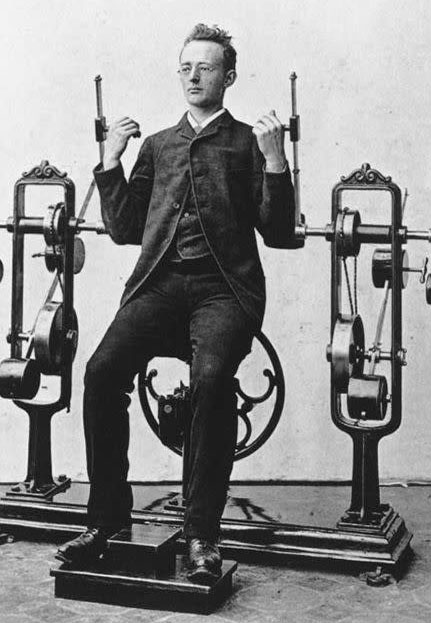
The Beechworth Gymnasium and Athletic Club is formed and opens rooms on the corner of Church and Finch Streets.
1892 – Feb 12

Thomas Tanswell Snr dies in Beechworth at the age of 62. He has successfully run Beechworth’s Commercial Hotel since 1871 and built a beautiful home in Newtown called ‘Loughborough Villa’ – named after the town of Loughborough in Leicestershire, England where he had been born. For a few months before his death he had been suffering from heart disease, and had been cautioned by Beechworth’s Dr. Skinner to avoid undue excitement. The day before his death he had been at his Commercial Hotel in Beechworth transacting business as usual, conversing freely with those whom he meets, before returning to ‘Loughborough Villa’ in Newtown shortly after 10pm. But at around 3am, a ‘gurgling noise’ is heard from him and, upon assistance being summoned by his wife Ann Tanswell, it is apparent that his end is at hand … and within a few minutes Thomas Tanswell has expired. Upon his death becoming known, most of the leading places of business in Beechworth will close as a mark of respect.
| 19-year-old Tanswell left England in 1849, traveling to Yass in New South Wales with twelve members of his family to join his father John, who had been sent to Australia as a convict in 1833. At the end of 1852 he left his father’s butcher shop in Yass and excitedly trekked overland in the first goldrush to Beechworth, first settling at Reid’s Creek and digging for gold – with a degree of success – before moving to Spring Creek where he opens a butcher shop. At the end of 1853 he joins the new goldrush to the Buckland and quickly becomes involved in business in the district – Morse’s Creek (now Bright), Myrtle Creek and elsewhere, working as a butcher and taking an active interest in mining and in local public matters before building the ‘Empire Hotel‘ in Bright. Married – and with 13 children in tow and financially successful – he returned to Beechworth in 1869 and purchased and completely rebuilt the ‘Commercial Hotel’. |
1892 – Feb 13

On the day of Thomas Tanswell’s burial, the vast funeral cortege leaves the Tanswell home ‘Loughborough Villa’ at Newtown and makes its way into the centre of town, passing the Tanswell’s Commercial Hotel on Ford Street, then Thomas Tanswell’s beloved Masonic Lodge on Loch Street, before arriving at the Beechworth Cemetery. One of Thomas and Ann’s sons, George Tanswell – who has been suffering from tuberculosis for a number of years – manages to rise from his sick bed as the procession passes the Commercial Hotel to stand on the hotel’s balcony for a final farewell to his father. The effect of doing this and “the chill experienced by sudden exposure to the air” quickly exacerbates his condition and he dies the next day at the age of just 31, leaving a widow Georgina and a son, Reginald Tanswell. Edward Tanswell, the second eldest son of Thomas Tanswell, takes over the Commercial Hotel. Edward – who had married Jane McGowan in 1881 – will run the hotel succesfully, until 1895 – three years after his father and brother had died – when Edward too passes away at the age of 38, leaving his widow Jane to run the hotel for the next nine years, until financial difficulties force her to transfer the hotel’s licence to their daughter, 22-year-old Ethel Jane Tanswell in 1905. On April 28, 1908, Jane and Ethel will successfully apply to have the name of the hotel officially changed from the Commercial Hotel to Tanswell’s Commercial Hotel, the name that remains to this day.

1892

The Beechworth Shire Council reserves a large area of disused mining wasteland near the railway station (along Spring Creek to Mellish Street) for future development.
1892

Billson’s Brewery introduce another new beer – Billson’s Matured Stout. It is still brewed today.
1892

A pretty cottage is built at 39 High Street – between Camp Street and Church Street – and it still stands proudly today.
1892
Reid’s Creek school closes. The Woolshed’s last hotel closes in the 1900s and the Woolshed school closes in 1922, although gold mining is revived by bucket dredging of the creek and continues until 1922.
1892 – Apr
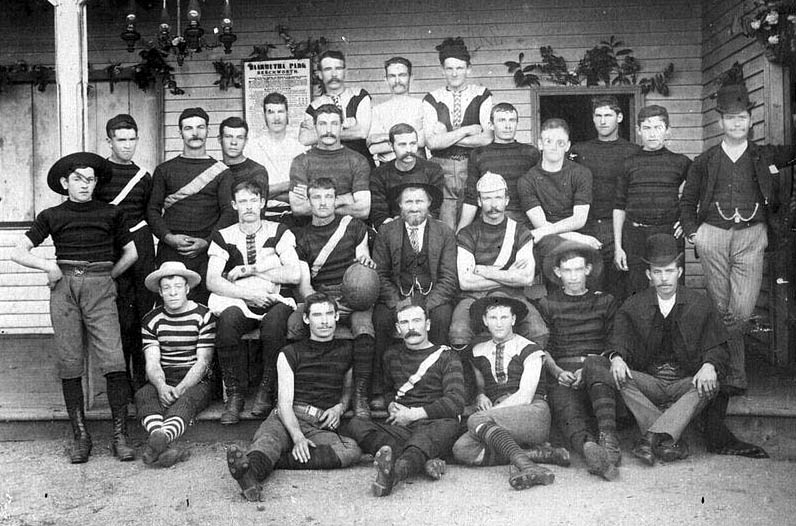
Following a meeting between officials of the two Beechworth football clubs – the Beechworth Football Club and the Wanderers Football Club – they agree to merge under the new name, the “Beechworth District Wanderers Football Club” adopting a red and black striped guernsey (and nicknamed ‘The Bombers’) before becoming an inaugural member of the Ovens and Murray Football Association (OMFA) in 1893.
| The merged club is initially quite powerful, claiming the OMFA’s first two premierships, and adding a third in 1897. The 1897 flag is won by means of a play-off after Rutherglen and Beechworth (who have now dropped the ‘District Wanderers’ part of their name) finish level at the head of the premiership ladder. There are no finals series, as such, in 1897, so to all intents and purposes this play-off will be the fledgling association’s first ever OMFA Grand Final, with Beechworth edging home by 9 points, 3.4 (22) to 1.7 (13). |
1892
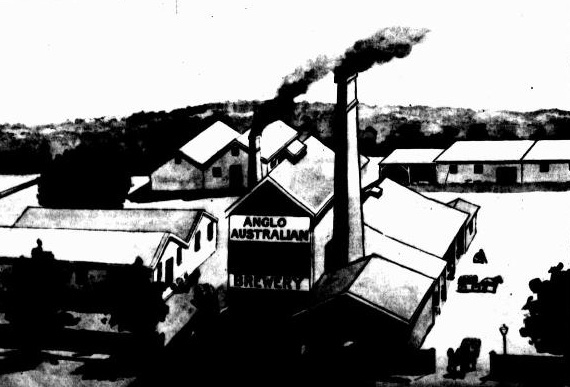
Billson’s begin trading under the new name of A. A. Billson’s Anglo-Australian Brewery Company (the name it will keep until 1911). By 1895, its cellars are capable of holding 7,000 dozen bottles and, at its manufacturing peak in the early 20th century, the brewery can treat 20 hogsheads of liquor (about 5000 litres) per day.
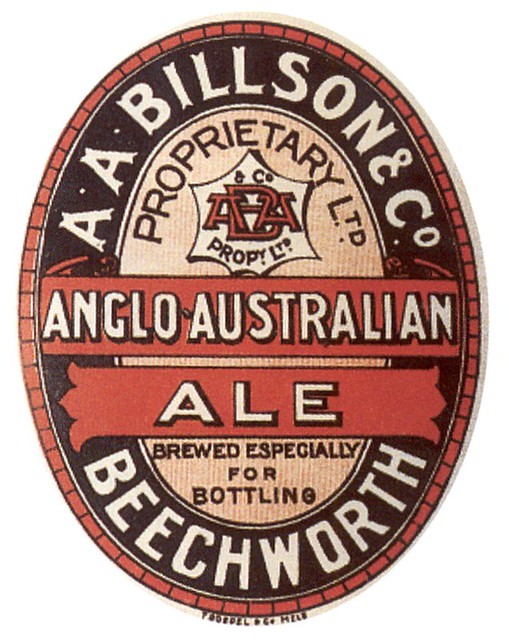
1892 – May

The Report of the Secretary of Agriculture lists 32 separate winegrowers and vineyards in the Beechworth district with 124 acres under vine. With gold discoveries in the region all but coming to an end, the local wine industry is at its peak … but it will not last.
| By 1901 the region’s plantings have shown a contraction to 103 acres and wine production is at 10,416 gallons. By 1910 this has been reduced to just 33 acres. In 1916 the region records just 6 acres of vines and production of just 30 gallons. The probable invasion of phylloxera – first discovered in Rutherglen in 1899 and spread through the north-east of the state probably had some effect – although Beechworth’s area under grape cultivation has been in decline since 1893. The outbreak of ‘The Great War’ all but finishes it off, the region’s once promising enterprise as a wine region is at an end … but it will return! |
1892
Small syndicates of miners continue to work old or abandoned quartz reefs, often without the assistance of heavy machinery to remove the large amounts of rock, in order to obtain yields at ever greater depths. Roger Williams & Sons revive operations at the old Williams Good Luck Mine on the Mopoke Reef (also called Morepork Gully) in the Dingle Ranges, three miles from Beechworth. They will continue to work the mine for more than two decades, digging an 800-foot long tunnel, digging down as far down as 200 feet to connect and provide better working access to the mass of reefs and veins in the vicinity. Progress is hampered by poor air quality charged with fumes from dynamite. Vast quantities of rock have to be crushed to obtain payable yields.
| An emigrant from Cornwall with experience in the tin mining industry, 19-year-old Roger Williams Snr sails to New Zealand in 1840, then to Australia where he spends time on the Bendigo Gold Fields before settling in Beechworth in the early 1860s. He works on various mining activities in the district, including the ‘Rocky Mountain Tunnel’ project. |
1892
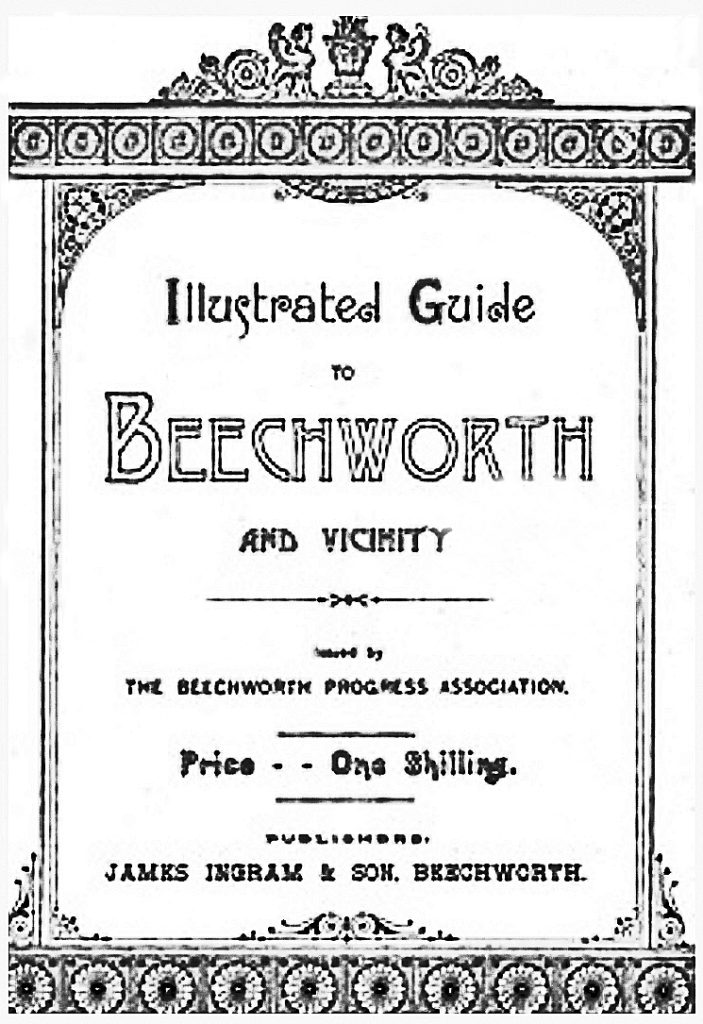
With the decline of gold mining as Beechworth’s main drawcard, the Beechworth Progress Association sees the growing interest in tourism as a way to bring people to the town and issues ‘The Illustrated Guide to Beechworth and Vicinity’. Published by popular Beechworth newsagentJames Ingram, the book comprises 54 pages of text and advertising, and 12 photo-printed plates. It describes the attractions, landscapes and peacefulness of Beechworth – and the railway that comes right into town – pointing out that “a busy Melbourne merchant could depart the city on the 4.55 p.m. train to arrive in Wangaratta at 9.16 p.m. take the connecting train to Beechworth and be in bed by midnight”! In the book, Beechworth’s potential as a sanitorium is praised by the highly regarded novelist Ada Cambridge (below) – who happens to be the wife of Beechworth’s Anglican Dean, Reverend George Frederick Cross.
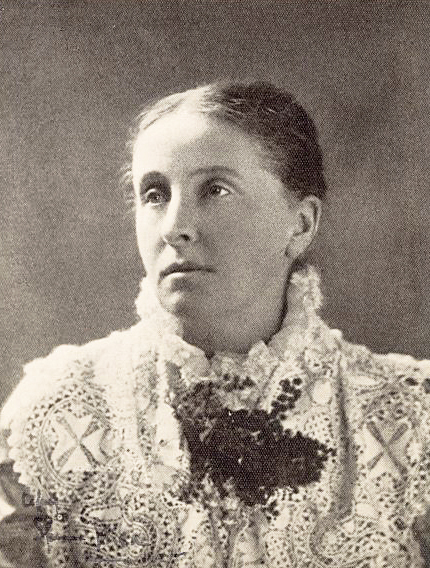
1892 – Nov

An athletic carnival, followed by a large ball, is held in Beechworth to celebrate the 51st birthday of the Prince of Wales, the future King of the British Empire. He will serve as King from 1901 until his death in 1910.
1892

37-year-old Dr David Skinner builds a new home and medical practice – ‘Balgownie’ – on the corner of Camp Street and Loch Street, the same site used by many local doctors since 1856. It still stands (as a private home) today.
| Born in Inverurie, Scotland, on April 28th 1855, David Skinner is educated in Aberdeen and obtains both ‘Master of Arts’ and ‘Master of Surgery’ degrees. After arriving in Melbourne, Skinner becomes the resident medical officer at the ‘Alfred Hospital’ before moving to Beechworth in 1882 to take up the same position at the ‘Ovens District Hospital’. He goes on to establish his own private medical practice – on land that will become the ‘Brigidine Convent’ property – before purchasing the old doctor’s house at 41 Camp Street (corner of Camp and Loch Streets) where he builds his new house and surgery. He continues to practice medicine at 41 Camp Street until his death from influenza in Beechworth in August 1918, aged 63. |
1893
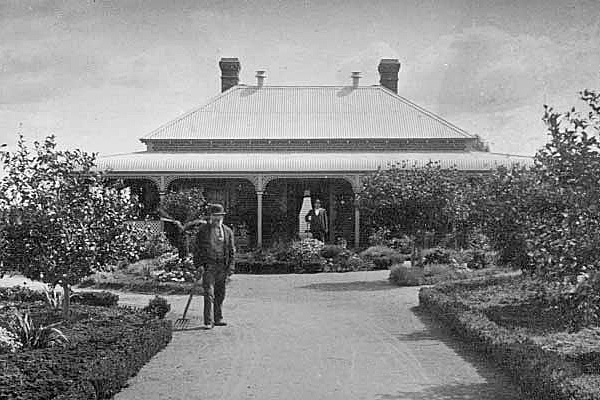
German businessman Frederic Haumann purchases Alexander Pritchard’s 9-acre vineyard at 59 Havelock Road and builds a fine brick residence on the site. He names the house ‘Haldon’, describing it as a ‘Gentlemen’s Retirement Home’. The house still stands today and is now part of the Haldon Wine Estate (below).

1893 – Jul

Three hundred invited guests attend a special theatrical evening at the Bijou Theatre within the Beechworth Lunatic Asylum. The night’s entertainment features two pieces – the 1880 one-act play “In Honour Bound” by Sydney Grundy (based on the French play “Un Chaine” by Eugène Scribe) – followed, after interval by the farce “The Steeplechase”. During interval the audience is entertained by Louis Dyring on the piano, performing popular pieces including “Home, Sweet Home” and “The Bells of the Monastery”. The Bijou Theatre – which is also used as the Asylum patient’s Assembly Room – is full on the night, with the “larger portion of the sitting accommodation filled to capacity” and the gallery also well patronised, while at the rear of the theatre, a number of ‘carefully selected asylum patients’ have been allowed to attend the show. The patients “displayed eager signs of expectation for the amusement so considerately provided for them by the genial Superintendent and his amiable wife”.
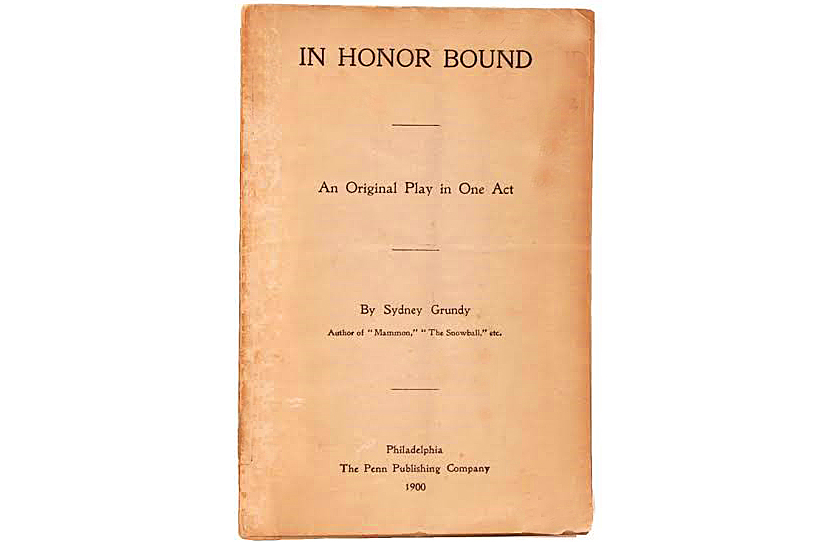
1893 – Jul 27
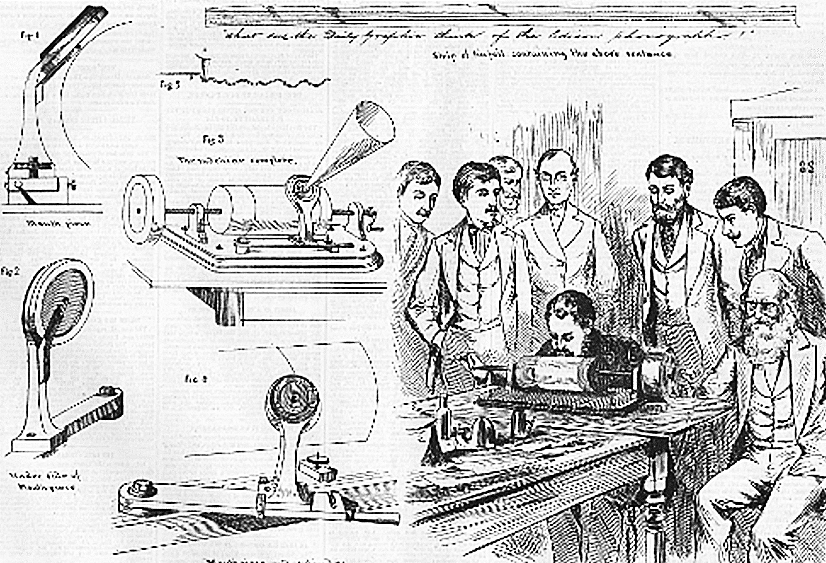
A three-day season with the new mechanical contrivance called Edison’s Loud Speaking Phonograph begins in Beechworth. A thrilled and amazed public are given a practical demonstration of the contraption by Dr D.W. Lane Ph.D. from New York, who also gives a lecture on “The Life and Work of Thomas Edison”. The astounding machine can record sound and play it back and had been patented by Edison in New York in February 1878.
1893

Having been successful in business and made good investments, 45-year-old Henry James Jarvis retires from his blacksmith and wheelwright business opposite the Shaw Brothers Store on Albert Road and acquires William Turner’s 1870’s-built house ‘Nithsdale’ in Newtown from Andrew Love Galbraith, the home’s most recent owner. Henry James Jarvis has invested in many other properties and land in the area and is, at one time, the largest individual ratepayer in all of Beechworth! He has served as president of the Beechworth Building Society, holds a large interest in the Rocky Mountain Gold Sluicing Co., of which he is also a director, is a prominent member of the Beechworth Congregational Church, a member of the Loyal Beechworth Lodge of Oddfellows and, for over 40 years, a member of the Independent Order of Rechabites as well as becoming a respected Justice of the Peace. In his retirement, Jarvis serves as a Beechworth Councillor between 1909 and 1917 and is named Beechworth’s Shire President 1916 but dies, still in office, the following year at the age of 70. He leaves a widow, a daughter and three sons, including popular Beechworth storekeeper Frank Jarvis.

| ‘Nithsdale’ had been built by William Turner in the 1870s. William Turner (not to be confused with Beechworth’s celebrated jeweller and watchmaker William J. Turner) had, for a time, been Beechworth’s Post-Master and names his newly built Beechworth home ‘Nithsdale’ after his birthplace in Scotland. Turner and his family eventually move to Melbourne where Turner joins the ‘Commercial Bank of Australia’ and builds another grand house – at 316 St. Kilda Street in Brighton – that he also names ‘Nithsdale‘. This house still stands today (above). |
1893
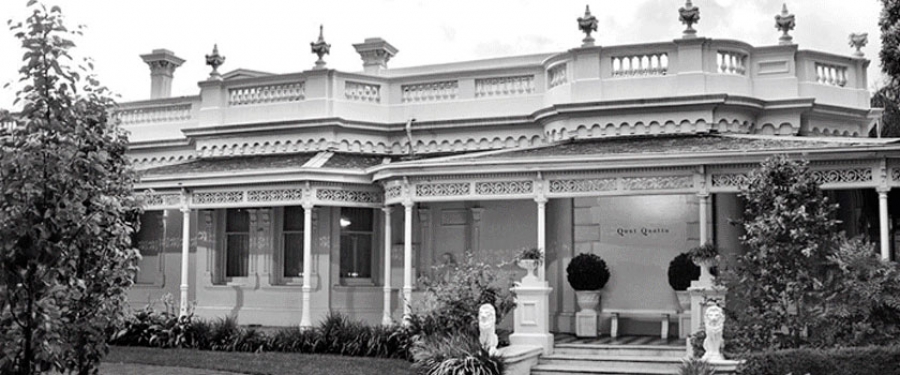
Beechworth pioneer John Alston Wallace moves with his children to Melbourne and builds a gracious mansion in Ripponlea that he names ‘Quat Quatta’ and two years later, 67-year-old Wallace marries his third wife, 25-year-old Ada Rona Reid. ‘Quat Quatta’ still stands today.
1894 – Mar 14
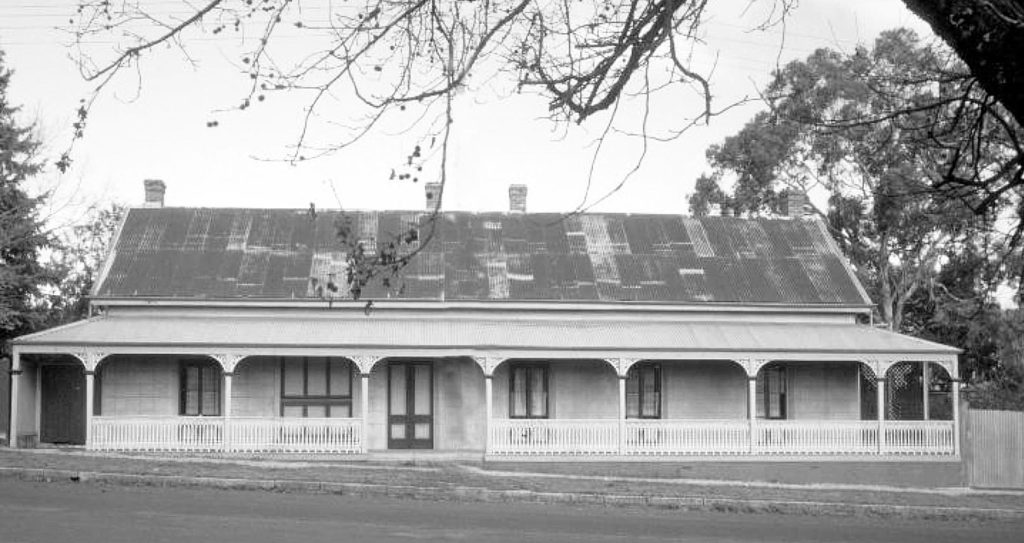
At the London Tavern in Camp Street, Alfred Arthur Billson and a visiting conductor, Mr. H. Fielder hold the inaugural ‘Beechworth Liedertafel’. A ‘Liedertafel’ is a German tradition – a friendly society of men united by an enthusiasm for singing.
1894 – Jul 16

Snow blankets Beechworth and surrounds as a mass of cold air descends on the area.
1895

The ‘new’ Billson’s is completed. In response to the need for more cellar space and to expand his operations, in 1889 Alfred Arthur ‘Bosher’ Billson had commissioned a new, bigger two-storey brick building at his brewery site at 29 Last Street. To allow for this expansion, the chimney tower is moved, brick by brick, from one side of the old building to the other side of the new building. The new cellar allows for the storage of a up to 84,000 bottles.
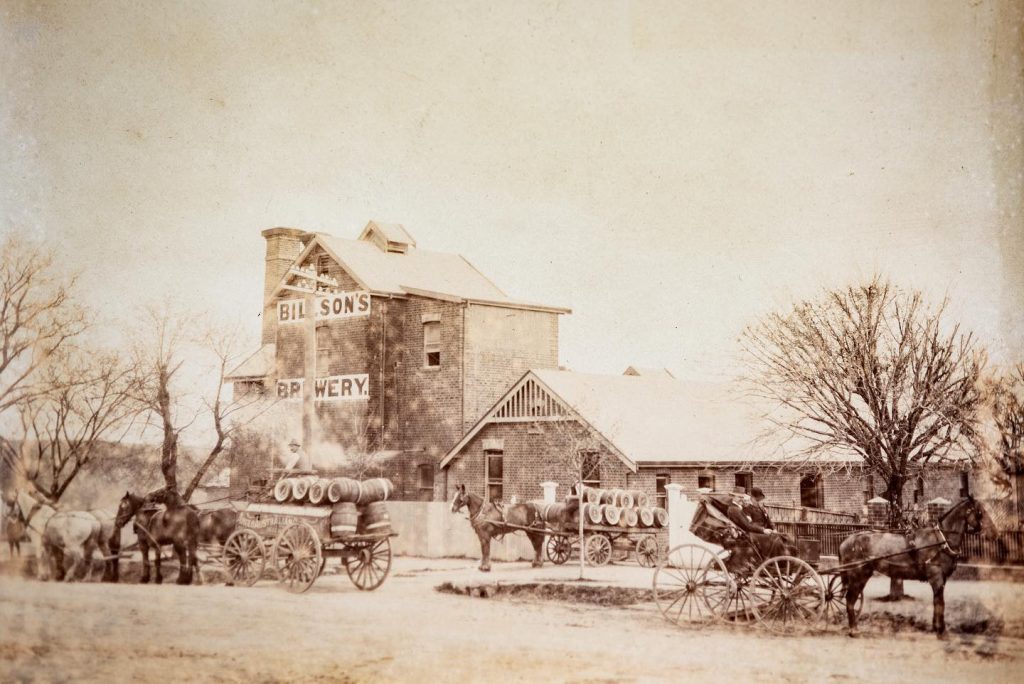
1895
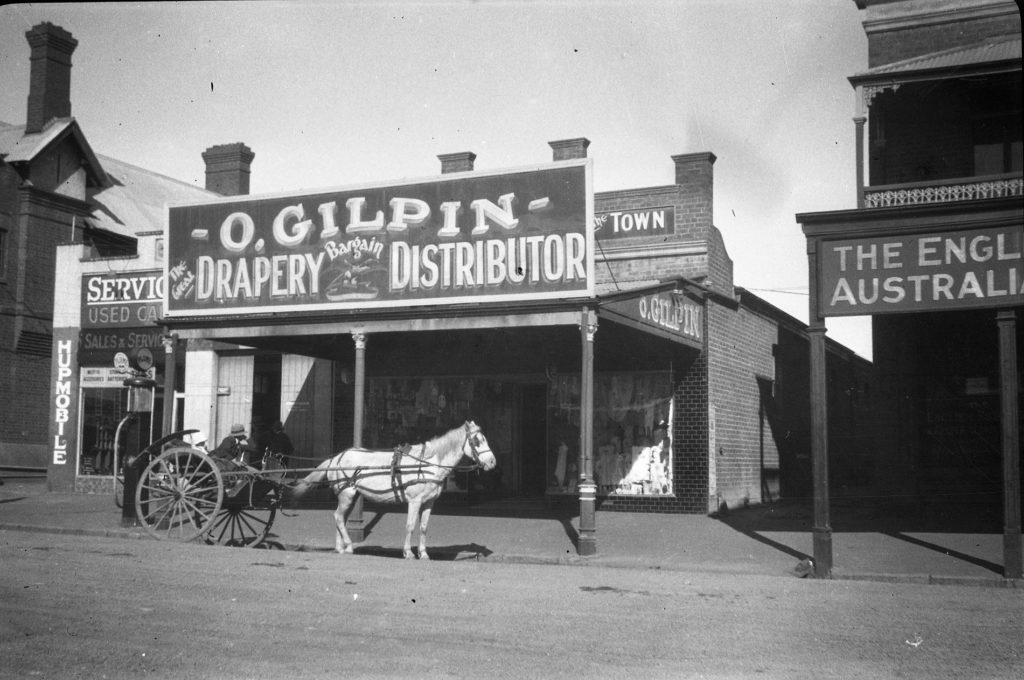
Oliver Gilpin, born at Seven Creeks near Euroa, uses an inheritance to open his first drapery store in Korumburra, followed by a second store in Rutherglen in 1899. Many more stores follow, including Wagga Wagga in 1915 (above). He will go on to run a vast chain of stores throughout Australia, including a long running O. Gilpin Store on Ford Street in Beechworth. He is often credited as creating the first major drapery chain store business in Australia. Although known to be somewhat bigoted and eccentric, Gilpin is undoubtedly successful and has some modern ideas including the employment of women, an employee incentive scheme, mail order business, and recycling.
| In 1910 the wealthy and successful Mr Gilpin will build a magnificent home – ‘Kia Ora’ – in Finch Street, East Malvern. The spacious grounds include a tennis court, artificial lake, fernery, summer houses and a croquet and bowling green. By the 1930s Gilpin’s chain of Drapery stores has grown to 94 branches and Gilpin is living extravagantly, including the purchase of two Rolls-Royce cars. He builds a new two-storey luxury mansion – ‘Idylwylde’- in Balwyn, with plans to extend it to eight storeys! The house features a huge ballroom and luxury indoor pool and spa and the 20-acre garden which includes an artificial lake, vast aviaries and a zoo of Australian animals. Oliver Gilpin dies in 1942 and his Beechworth store will be purchased in 1945 by Frank Jarvis and incorporated into his existing shop next door. The remaining chain of ‘O. Gilpin’ stores will be purchased by ‘G J Coles & Co’ in 1951 for £1,250,000. |
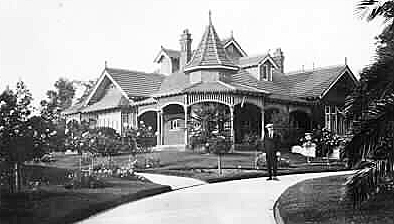
1895 – May 22
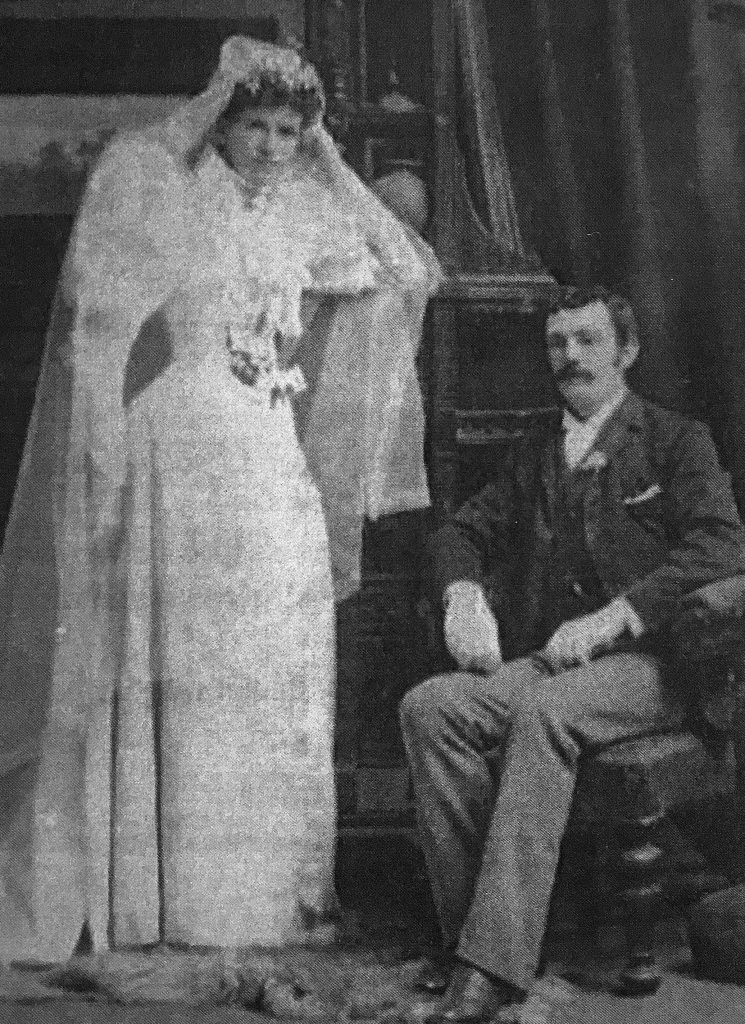
Walter Carleton Crawford – son of Hiram and Martha Crawford, the successful and wealthy owners of Crawford and Connolly coaches – marries Wooragee-born Jessie Haeffner in a beautiful ceremony conducted by Church of England pastor Reverend Thomas W. Sarjeant, followed by a lavish reception at the Star Hotel presided by the groom’s father Hiram Allen Crawford.
1895 – Jul 20
Mining distaster. At 3.45am, six of the eighteen men working underground at the McEvoy Gold Mine at Eldorado – 30km from Beechworth – are killed when a huge in-rush of mud and sludge enters the main workings. The mine will remain open, although the bottom workings are closed. After further problems – as well as the loss of another life – the McEvoy Gold Mine closes permanently in 1901 due to poor returns. In the lead up, there had been a strike which failed to be resolved by management and workers. The demise of the McEvoy will signal the end of deep mining at Eldorado.
| Five of the victims will later be buried together in the Eldorado Cemetery. The grave is marked by a special memorial, unveiled on 4 November 1961. |
1895 – Dec 26

A Boxing Day street parade down Ford Street in Beechworth.
1896 – Dec 17
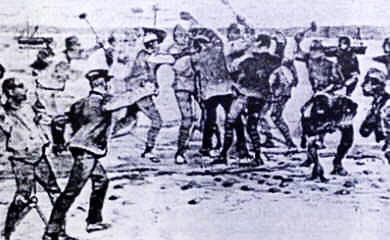
Joseph Brock, a patient at the Beechworth Asylum, passes away. Brock is rumoured to be one of the gang of convicts who had participated in the infamous murder of John Giles Price – the hated ex-commandant of Norfolk Island – at Williamstown on March 25th 1852. A number of the ringleaders of the violent death will be hanged for the crime, with Brock apparently escaping, later ending up at the Asylum in Beechworth.
| Fifteen convicts are committed for trial for Price’s murder with seven of the men sentenced to death and hanged in 1857. Later, it is suggested that some of the executed men had been wrongly convicted. |
1896 – Dec 19
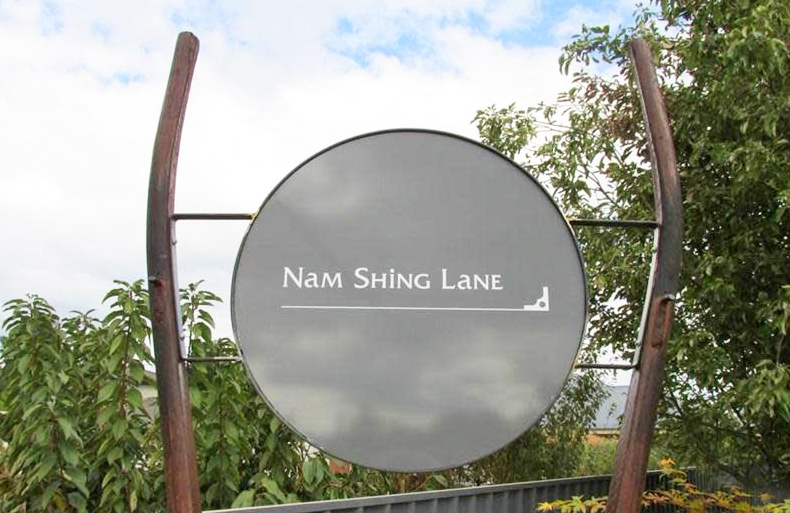
‘William’ Nam Shing, one of Beechworth’s longest serving and most respected Chinese businessmen, dies of blood poisoning following a severe foot infection, at the age of 63 and later buried in the ‘Church of England’ section of the Beechworth Cemetery.Born in Hong Kong, Shing has been a Beechworth merchant for over 40 years – running his Sun Quong Goon General Store – after arriving at the diggings along Spring Creek as an 18-year-old. The wealth that Shing accumulates over the years is devoted to the advancement of the district, with his quiet generosity becoming well known, both to the Chinese community and Europeans alike. A big supporter of local charities, Shing sits on the Committee of Management of the Ovens District Hospital and will later be appointed a Life Governor of the Oven’s Benelovent Asylum. He is also prominent in the introduction of the tobacco industry to the area. He and his wife Annie Cohen have two sons – Percy and Frederick, and three daughters – Ada, Amanada and Annie Jnr (who dies not long after being born). Today, Nam Shing Lane near Lake Sambell is named after him (see above).
1897
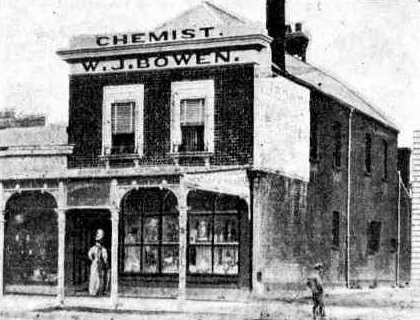
After the death of his business partner George B. Taylor in 1896, George Gammon retires, and sells his popular ‘Gammon & Taylor Medical Hall’ pharmacy at 55 Ford Street to William Johnston Bowen, the son of well-known Melbourne pharmacist William Bowen of Collins Street. As William Johnston Bowen has been the secretary and dispenser of the Ovens District Hospital for a number of years, he is already well known in the district, and he successfully runs the W.J. Bowen Chemist shop until his retirement in 1916. The building still stands today (below) with the famous Gammon’s name re-written on the top of the old chemist shop.
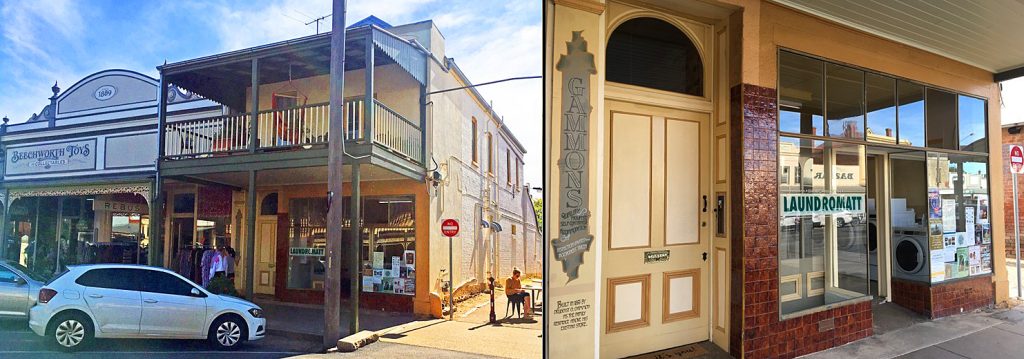
Beechworth Coin Laundromatt, with seperate accomodation on the first floor. The first floor balconey is added in 2005 by the building’s owner Peter Rue.
1897 – Jun 22
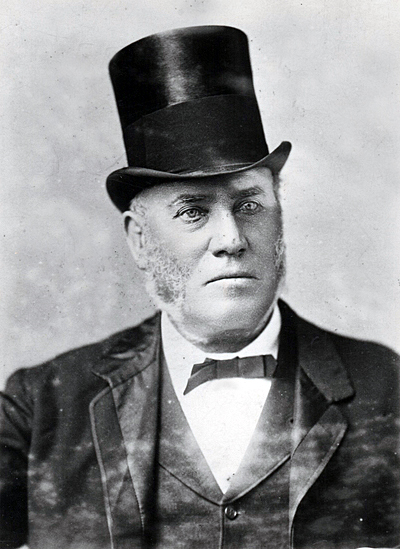
To celebrate Queen Victoria’s 1897 Diamond Jubilee, the large area of disused wasteland near the railway station the council acquired in 1892 is cleared, levelled and improved to create Wallace Park. On opening day, a procession of several thousand citizens march down Ford Street to the new park where the local member of Parliament plants the first tree. A picnic, sports events and fireworks display follow. Wallace Park will be officially dedicated in 1907, six years after Wallace’s death in 1901.
| Named after flamboyant Scottish entrepreneur and wealthy miner John Alston Wallace, it is now known as the ‘Wallace Park Reserve’ which today includes the ‘Beechworth Bowling Club’ (moved there from Queen Victoria Park in 1921), a running track constructed by the Beechworth Fire Brigade in 1953 and the ‘Beechworth Public Swimming Pool’ constructed in 1978. |
1898 – Jan
John Fletcher purchases James Ingrams’s newsagency and bookseller business in Camp Street from James Ingram Jnr (who had taken over the 1885-established business from his father in 1882). In 1870 Fletcher had resigned from his position as the secretary of the Beechworth Hospital to start business as a ‘Mudie Librarian’ and bookseller and newsagent. A popular and energetic citizen, he has acted as agent for “The Leader” and “The Age” during the whole of his business career in Beechworth.
| ‘Mudie Librarian’ – Between 1842 and 1852 English publisher Charles Edward Mudie develops his ‘Mudie’s Lending Library’ and ‘Mudie’s Subscription Library’ concept in London. Mudie’s efficient distribution system and vast supply of texts revolutionized the circulating library movement and it spreads to Australia. |
1898
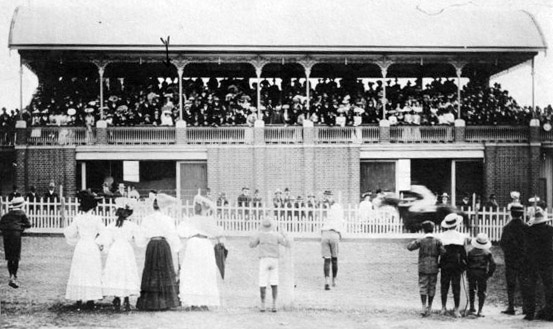
At Baarmutha Park, the shire council demolishes the wooden grandstand, replacing it with a new two-storey brick grandstand with a curved metal roof and a light ornamental railing at cost of £800, and new stone gate pillars are added. Both still stand today.
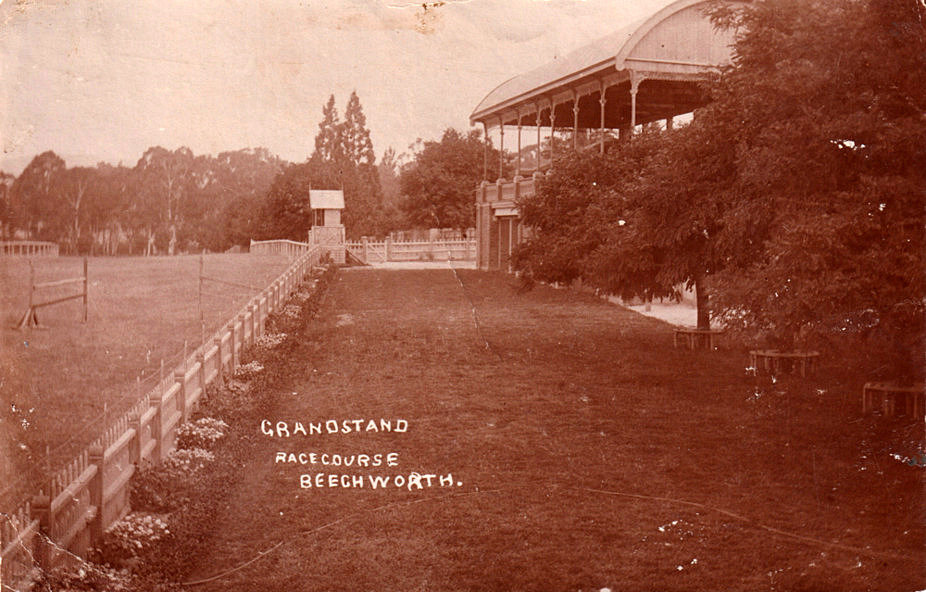
1898
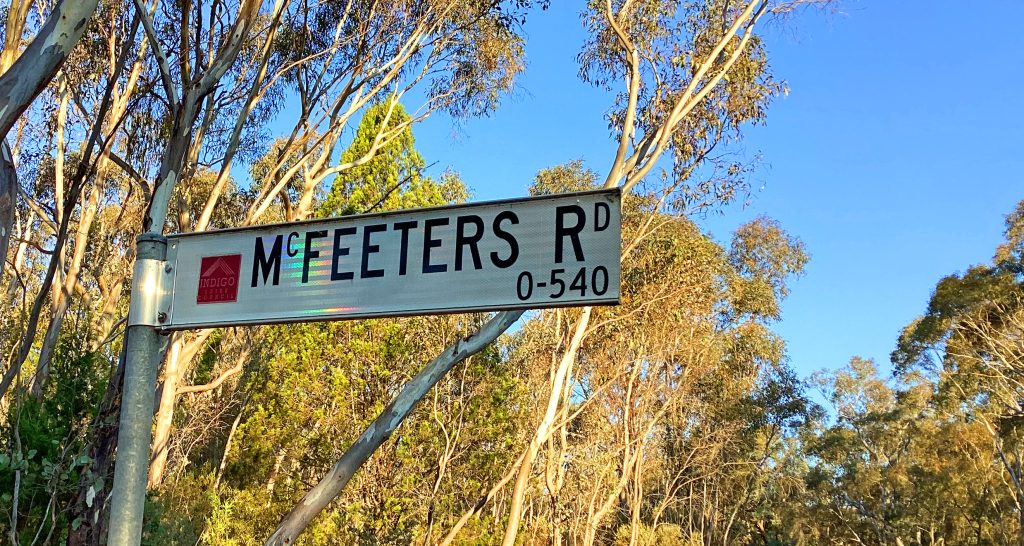
William James McFeeters marries Anastasia Brown. Their son David McFeeters will become the postmaster at Reid’s Creek and their daughter Beatrice May McFeeters will live to the ripe old age of 101! McFeeters Road is named in honour of the family.
| The council also commemorate other pioneers through new street names in the area – Billson, Tanswell, Crawford, Allen and Ferguson Streets, and Fletcher Lane. |
1898 – Aug 12
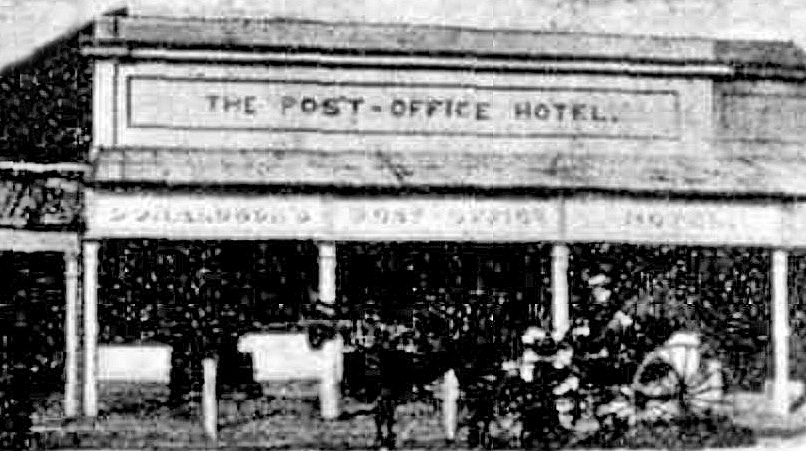
66-year-old Thomas Robert Donaldson takes over Beechworth’s popular 1870-built Post Office Hotel at 24 Camp Street from William Henry Rendall. Donaldson will hold the hotel’s licence until his death on Christmas Eve 1902 at the age of 70. Well known in the district, Donaldson had been in business running Miller’s General Store at Corryong on the Upper Murray for many years. Donaldson Street in Corryong is named in his honour.


| After being run by a number of further owners and licensees, ‘The Post Office Hotel’ will finally close its doors for good on May 31, 1941. The single-storey building will later become the home of the ‘Beechworth Hardware Store’ for many years before being transformed into ‘The Beechworth Emporium’ in September 1991 and still trades from the same 1870s building today. |

58-year-old Alfred William Ladson opens his third store in Beechworth, this time at 19 Camp Street called Ladson’s Branch Stores. It is managed by his son Charlie Ladson and stands next door to Frederick O’Brien’s drapery store.

| 19 Camp Street will be the home of numerous businesses over the ensuing years, including a car yard, a pinball parlour in the 1970s and is now the site of the WAW Bank. |
1898

40-year-old Alfred Arthur ‘Bosher’ Billson (above) takes over as chair of the Beechworth branch of the Australian Natives’ Association. He takes an indefatigable interest in town affairs and foresees tourism as a means of stemming Beechworth’s decline. He is a Beechworth United Shire councillor for 24 years and serves four terms as president. At various times he is also president of the local Progress Association, hospital board, Liedertafel, choral society, and sporting clubs.
1898 – Nov

Prominent Chinese citizen 69-year-old Bartholomew Wong Poo – a missionary to the Chinese population – gives a well-received address about the dangers of opium, explaining that young Chinese males are often as much addicted to opium as European youths are to alcohol. One of the catechists involved in the baptism of Chinese into Beechworth’s Presbyterian Church, Bartholomew Wong Poo and his family are much admired and respected around town. He had married Emma Jane Richards on December 2, 1877, in Echuca. They have six children together – Elizabeth May, Arthur Bartholomew, James Albert, Emma Jocelyn, Richard Wesley and William Thomas. The ‘Poo’ is dropped from their surnames and reduced to ‘Wong’ and the children attend Beechworth State School. Although Bartholomew’s English is not strong, and Emma is of English descent, the children’s upbringing proudly centres the Chinese community.
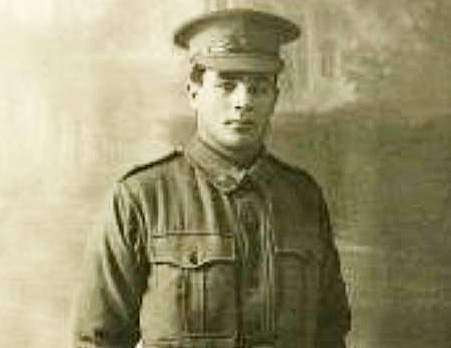
1899 – Apr 1
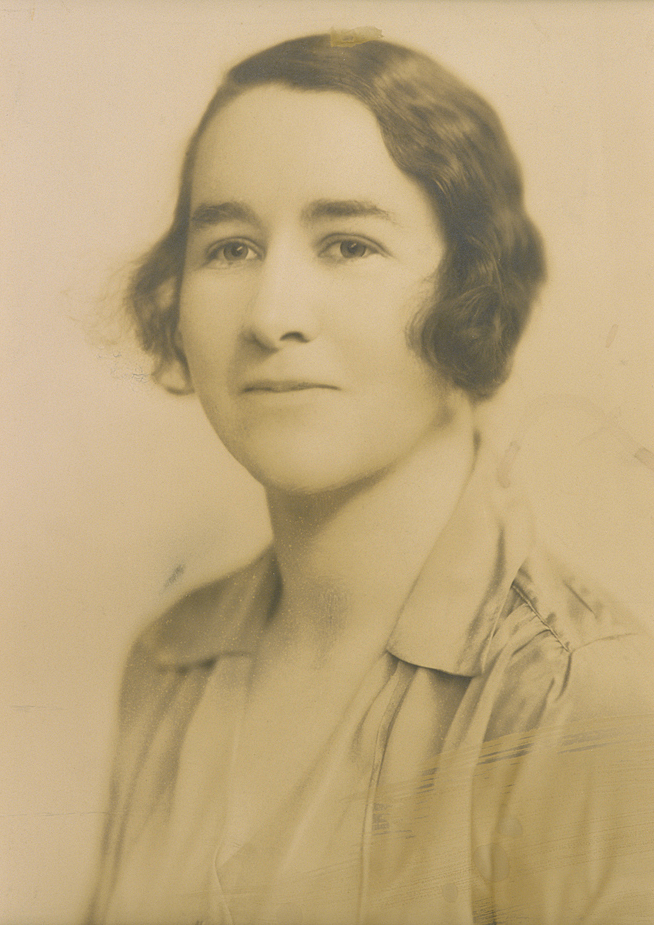
Jean Macnamara is born at 62 Last Street in Beechworth. She will go on to become a doctor and scientist, known for her contributions to children’s health and welfare. She becomes a pioneer in the treatment of polio and an advocate of myxomatosis for the control of Australia’s huge rabbit population. In 1935 she is honoured as Dame Commander of the Order of the British Empire. Passing away in in 1968, Dame Jean is buried in the Beechworth Cemetery.
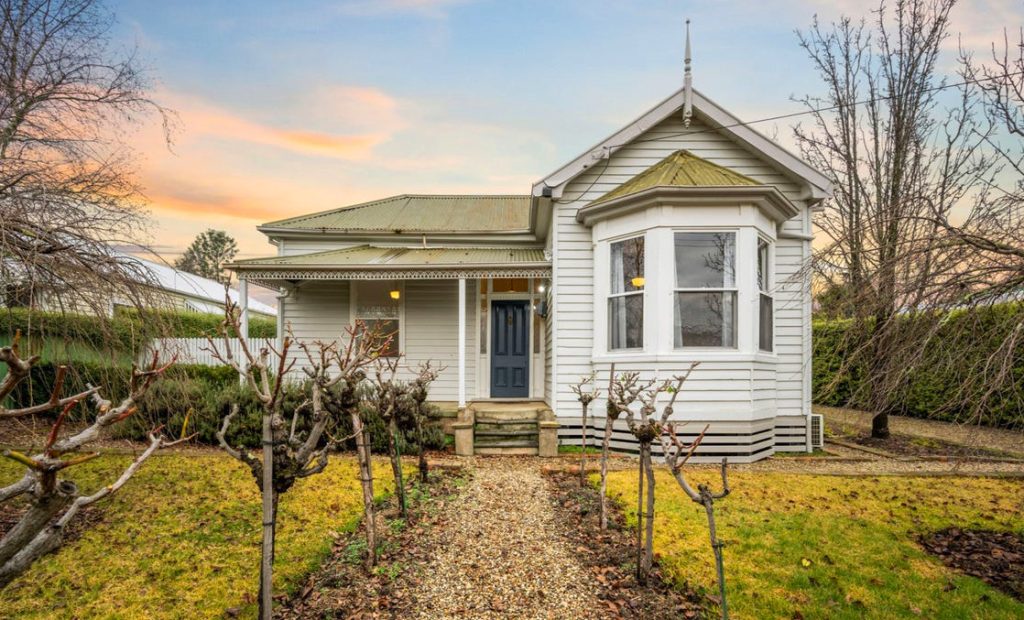
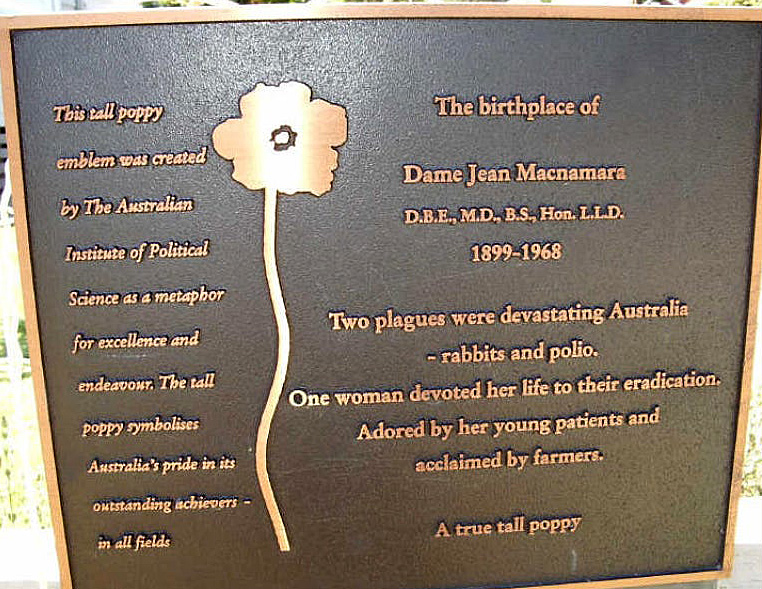
| In August 1999 a plaque in her honour is unveiled outside Macnamara’s former family home at 62 Last Street by Dr. Jack Best of the ‘Tall Poppy Society’ and the ‘Institute of Australian Political Science’. |
1899
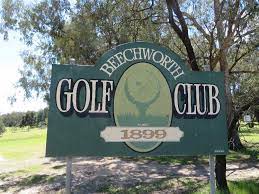
The Beechworth Golf Club is established when the club’s secretary seeks permission from the Beechworth Shire Council to form golf links at Baarmutha Park. However, it is not until 1914 that the links are formerly opened. The racecourse grandstand serves as the clubhouse until immediately prior to WW11 when the Le Couteur family donate land where various clubhouses are built. The land, opposite the 6th green, is sold in 2014.
1899 – Dec 22

Under heatwave conditions and gale force winds, a series of bushfires start around Beechworth just before Christmas. The first begins at Everton and, after burning its way through the hills to Sebastopol, it crosses the Woolshed Range and then sweeps up and over the hill behind Zwar’s Tannery, finally reaching the Gorge right opposite the Ovens District Hospital. Most of the houses near the tannery and opposite the hospital are destroyed. A man named White, living near Zwar’s Tannery, is seriously burned while endeavouring to rescue his deeds and other property. Just below Zwar’s Tannery on Malakoff Road an elderly couple are burnt to death.
1899 – Dec 22
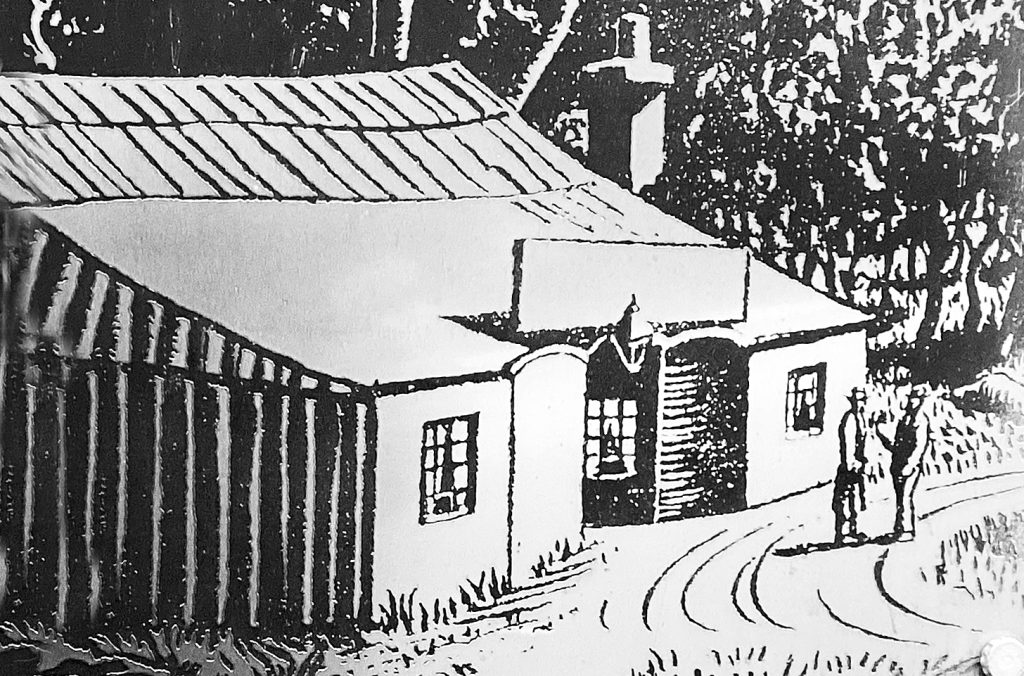
As the bushfire roars across the Woolshed Range to Sheep Station Creek, the Reidford Hotel succumbs to the flames. Located at ‘Wick’s Crossing’ near Sebastopol, the Reidford Hotel – operated by Jim and Jack Chappell – had been the last remaining hotel of the eight hotels that once operated in the 1870s in the rugged Woolshed Valley. It became a popular drinking spot and famous for its ‘public swimming baths’ in the nearby Reedy Creek, the remains of which can still be seen today.
1899 – Dec 22

The ferocious north wind continues to blow, and another arm of the same bushfire reaches the Melbourne Road at the settlement of Black Springs wreaking terrible damage – eight houses are destroyed, along with the Black Springs School and a Mr Thompson is severely burned. William Robinson’s property on Sheep Station Creek Road at Black Springs – where he makes honey- is also wiped out. The north wind continues unabated and the fire begins to spread to the outskirts of Newtown and right towards the Beechworth township.
1899 – Dec 22

As Beechworth is enveloped in thick, choking smoke – and red hot embers, burning leaves and other debris fall over the centre of town – all business is suspended, and citizens rush out to help fight the flames. The fire sweeps through the slaughter-yard of John Blackwell, destroying all his buildings and stores of hides and tallow. The Ramadens, a couple employed as workers by Blackwell and living in one of the outbuildings at the yard, are consumed by the fire and the dead bodies of both are found in the afternoon not far from the hut and burned almost beyond recognition. John Blackwell will pass away eight months later at the age of 49, leaving his widow Henrietta with their 9 children.
1899 – Dec 22

Another bushfire breaks out near the Chiltern Road and crosses to Wooragee where four farmhouses are rapidly consumed, and 15-year-old William Elliot perishes in the maelstrom after running to a paddock near his Wooragee home to let cattle out, and nothing further is seen of him until Sunday morning (Christmas Eve) when his charred body is found alongside the burnt remains of a bullock. The fire races up both sides of the Wooragee Road, quickly reaching, and destroying Worragee’s Rising Sun Hotel. All the land between the Wooragee Road and the Yackandandah Railway Line is burnt out, along with a number of dwellings that had been occupied Chinese miners. Two homestead leases, those of John Brewer and David Murray, are also destroyed, with a massive loss of grass, cattle and sheep. In the afternoon, the gale veers around to the West, bringing with it flames from the direction of Everton, and travelling at the rate of 15 miles an hour. Eventually, this branch of the fire is stopped on the outskirts of the Beechworth Racecourse.
1899 – Dec 23

After burning through the night, the threat continues as another branch of the bushfire crosses Spring Creek, then Holmes Creek at the Gorge, near Beechworth’s Powder Magazine, and destroys the home of John ‘Jack’ Skidmore at the bottom of Camp Street. The fire then sweeps towards One Tree Hill, endangering all the houses on the hill above Barnard Street and some are damaged before the fire is stopped – by a wind change from the west and firefighters – at the Old Chiltern Road.
| At its height – when the wind is at hurricane force – Beechworth is ringed by fires from the Lower Three Mile to the Yackandandah Railway Line beyond Red Hill. ‘Billson’s Brewery’ even catches fire, but prompt action by the brewery employees prevents any serious damage. A company of men from the Navy (who have arrived to take part in Beechworth’s Boxing Day Sports) also help in putting out the fires. But the biggest help comes in the form of a cool change, and a change of wind direction, on Christmas Eve which halts the further spread of fire. During the three days of the fire emergency, there are six deaths, and 26 homes are destroyed along with outhouses, sheds, huts and hundreds of animals and stock … and there are scarcely any fences left standing between Wooragee and Beechworth. |
THE STORY CONTINUES IN THE 1900-1929 TIMELINE